Allison Collection Photos
February, 1944
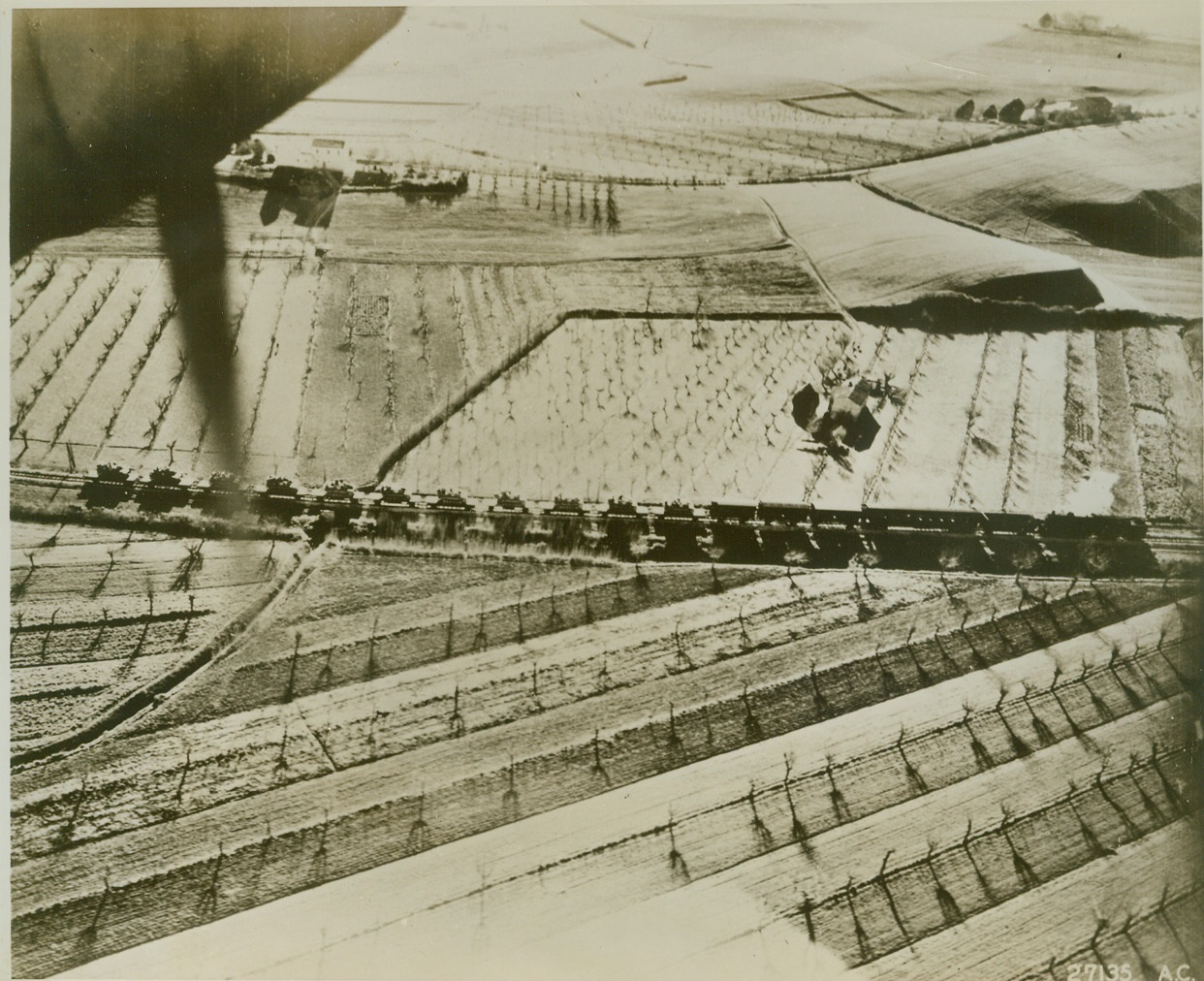
Nazi Tanks Travel, 2/4/1944. A trainload of Nazi tanks moves east of the town of Macerata, near the Adriatic coast of Italy, in this photo, made by a reconnaissance pilot of the U.S.A.A.F. The tanks are Mark IIIs, mounted with assault guns. They were being hauled to reinforce the German units facing the British Eighth Army. Credit (U.S. Army Air Force photo from AMCE);
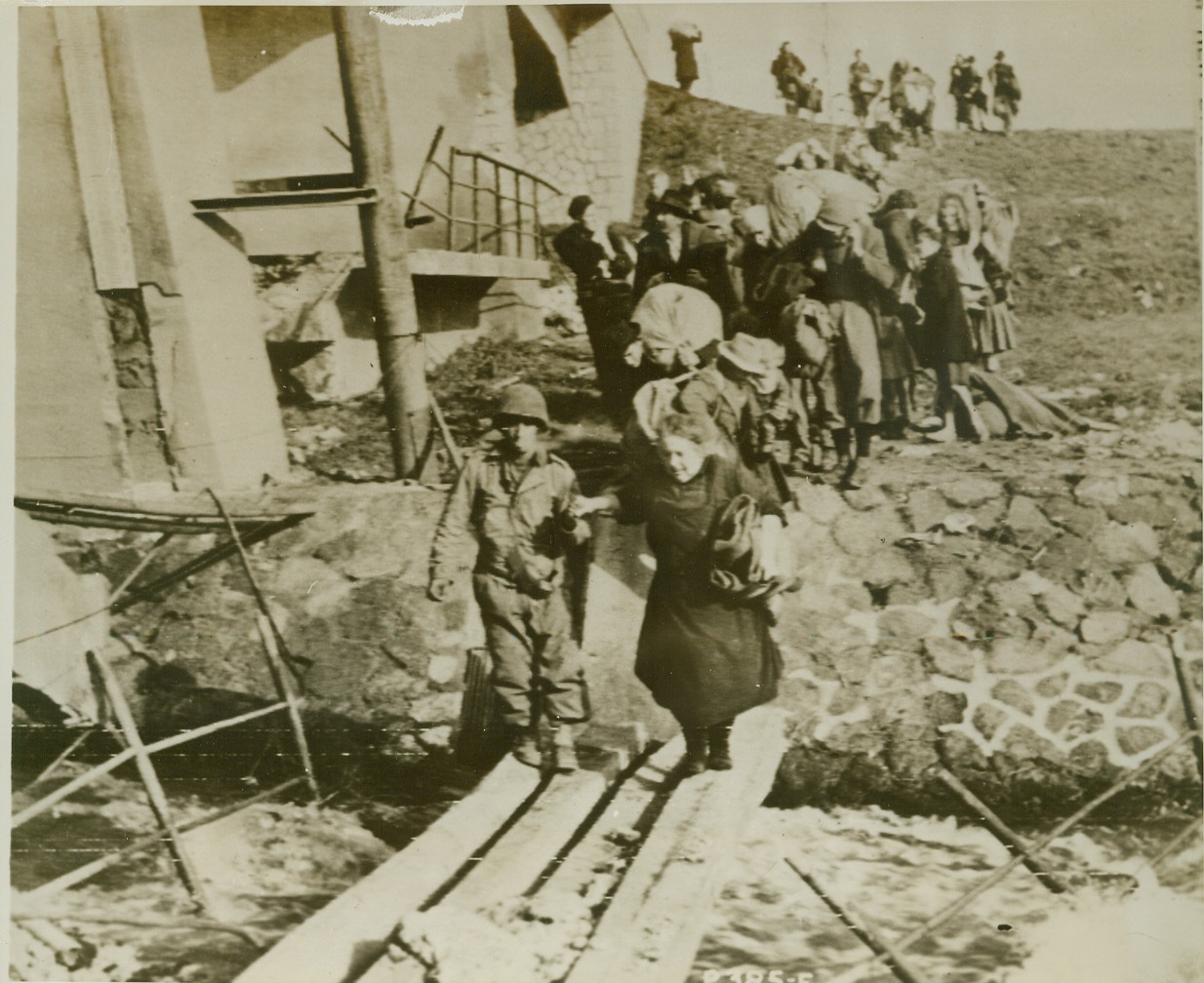
Yanks Lend a Hand, 2/4/1944. Italy – Pfc Manuel Martins of New Jersey lends a helping hand to an aged Italian woman crossing a makeshift bridge in the Mussolini Canal Sector of Italy. Behind them are other refugees, making their way back to their homes in territory now occupied by the Yanks. Credit: (ACME photo by Charles Seawood for the War Picture Pool, transmitted via U.S. Army Signal Corps Radiotelephoto);

Navy Sinks Nazi Blockade Runner, 2/4/1944. U.S. Navy Forces operating in the South Atlantic early last month sank three German blockade runners heavily laden with vital war materials for the Reich. Our men picked up hundreds of tons of baled rubber found floating amid the wreckage of the sunken ships, and took many prisoners. Here Comdr. William C. Hughes, Jr., USN, commanding officer of the USS Somers, which caught the blockade runners, supervises the transportation of the German prisoners from the port to which the captives were brought. Credit: (Official U.S. Navy photo from ACME);
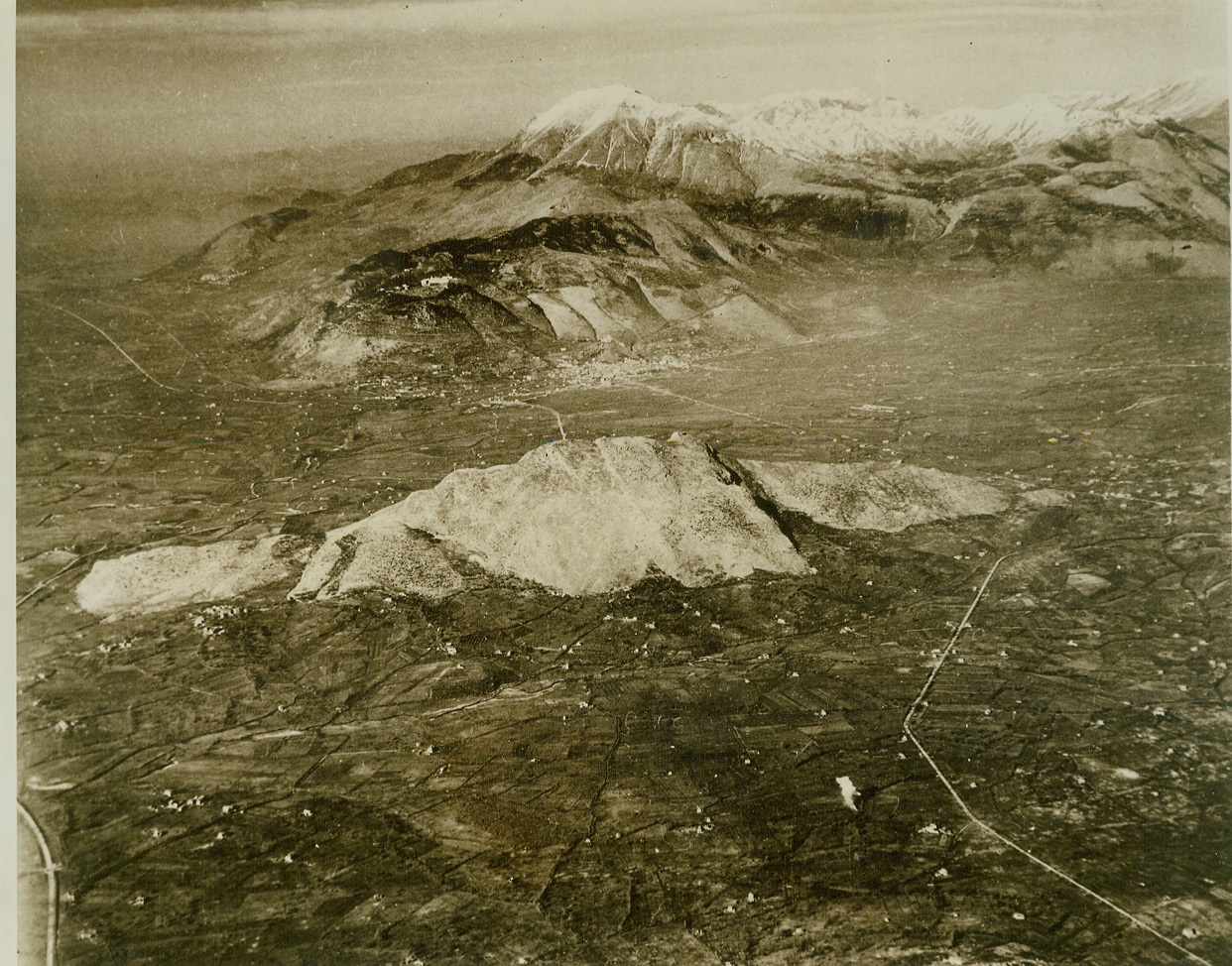
War-Torn Valley on Road to Rome, 2/6/1944. Italy – A photo from an Allied observation plane, looking north over the Cassino Battlefield, gives a bird’s-eye view of the embattled valley on the road to Rome. The burst of smoke in the right foreground reveals an American gun position firing on Nazi installations in Cassino, the shell-torn town huddled at the foot of the mountain ridge in the background. With the capture of Mt. Trocchio (center) and Mt. Cairo, high peak in the background, Fifth Army fighters have three-quarters circled the enemy, the Abbey of Monte Cassino, perched in the mountain above Cassino (left of town), bristles with Nazi guns trying to thwart our drive to Rome. The Rapido River is at top right. Credit: (ACME);
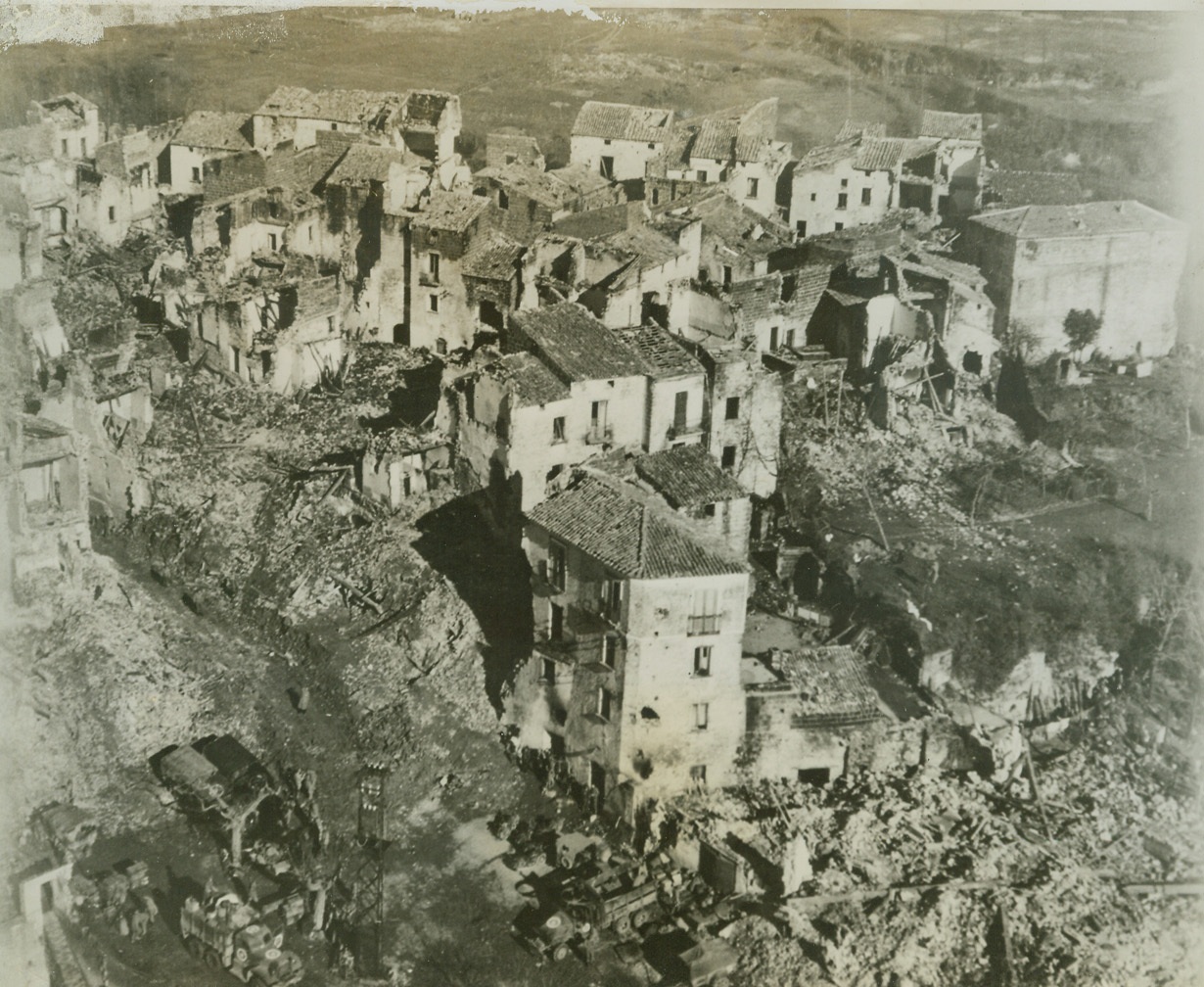
In the Wake of War, 2/7/1944. Italy – Crippled by war, Mignano sags in the wake of the Allied charge on Messino. Fifth Army troops use the ghost town as an ambulance collecting point (foreground). Credit: (ACME);
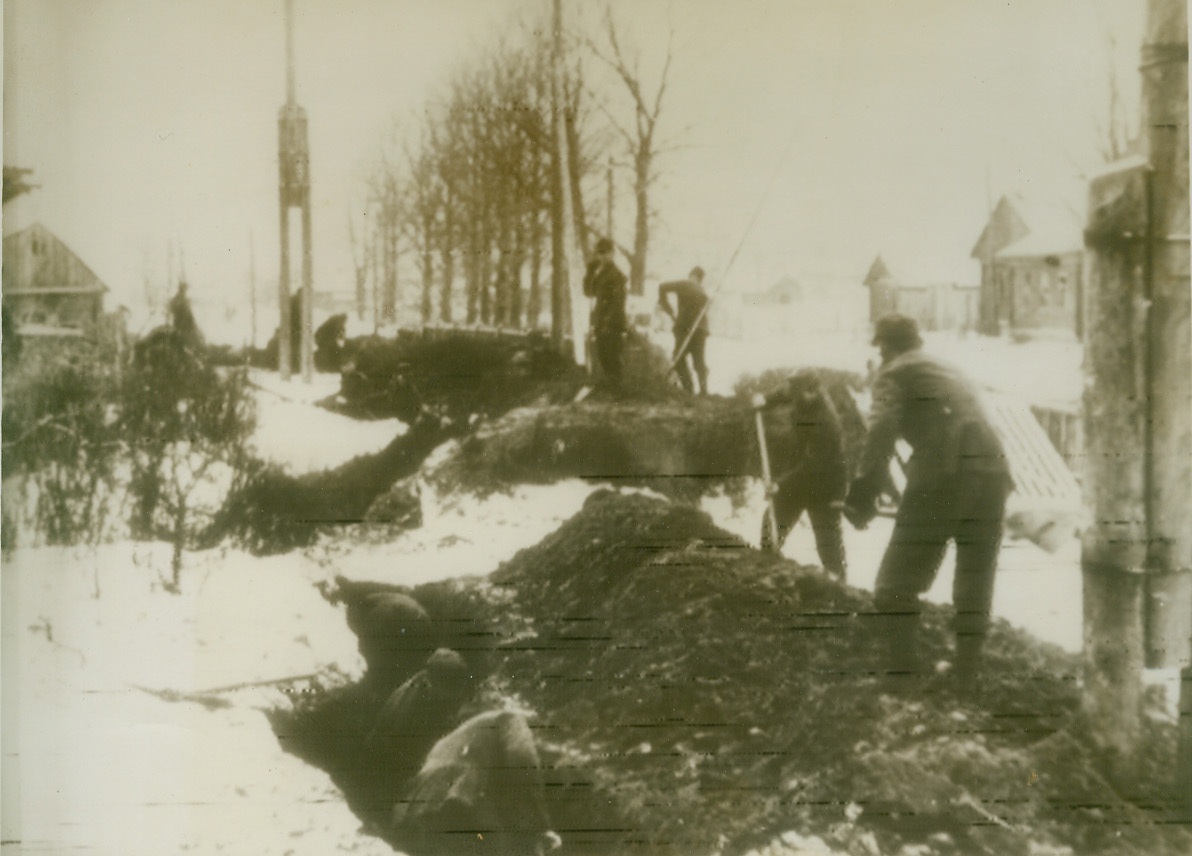
Nazis Dig in on North Russia Front, 2/8/1944. Russia – German soldiers hastily construct trenches on the northern Russian front in an area named in the German caption as “south of Nevel.” This is the sector where the Reds have renewed their offensive and taken more than 80 localities in attacks which may form the southern prong of a great pincers, the northern arm sweeping through the Leningrad territory. (Photo flashed from Stockholm to N.Y. today) Credit: (ACME Radiophoto);
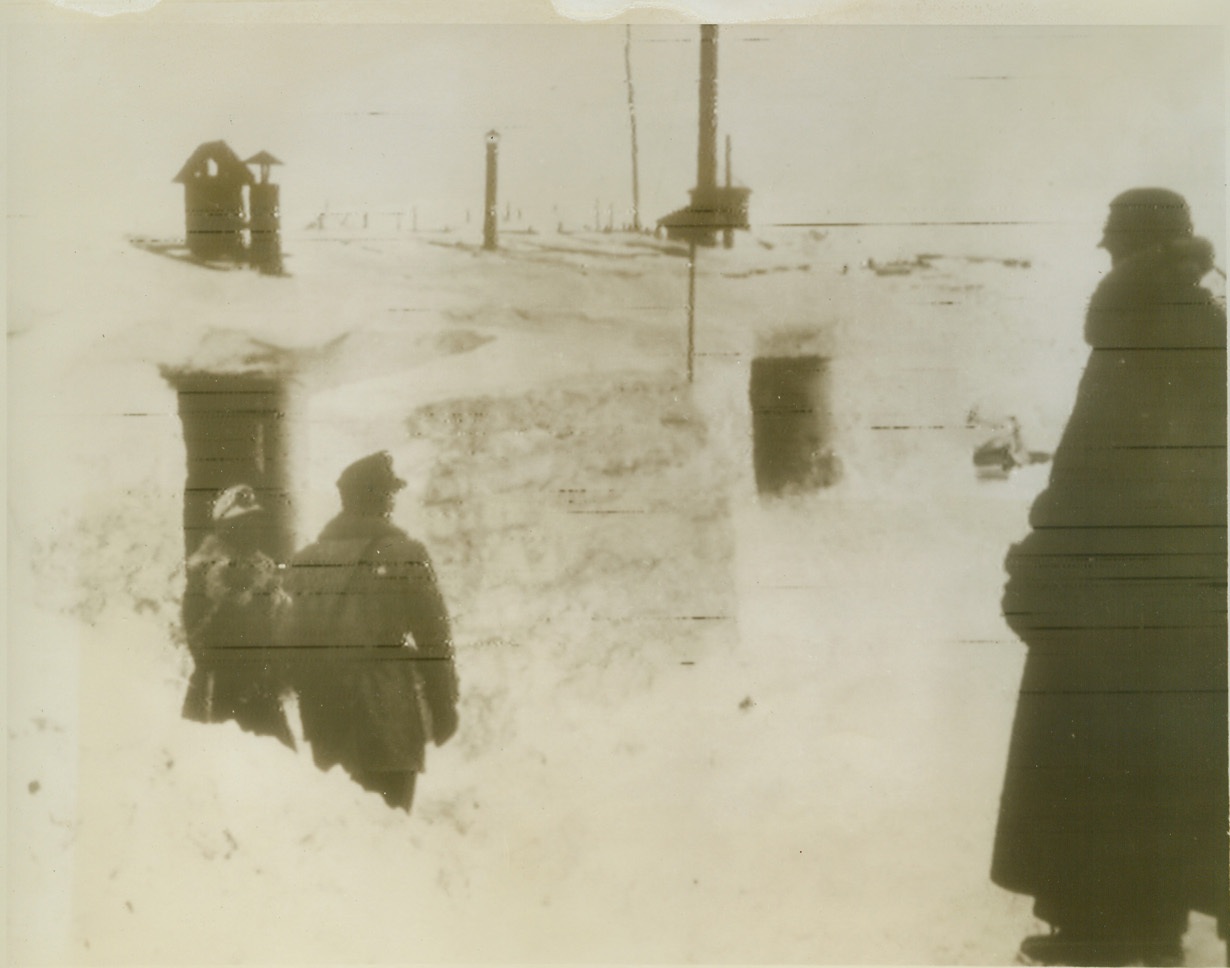
Ready for Hot Time on a Cold Front, 2/8/1944. Finland – Nazi soldiers under command of General Dietl, German chief of the Finnish front, use ice walls and snow roofs to “insulate” their wooden barracks from the piercing cold. As Russia promises heavier blows at Finland, the snowbound Nazi fighters may soon see grim action. (Photo flashed from Stockholm to New York) Credit (ACME Radiophoto);
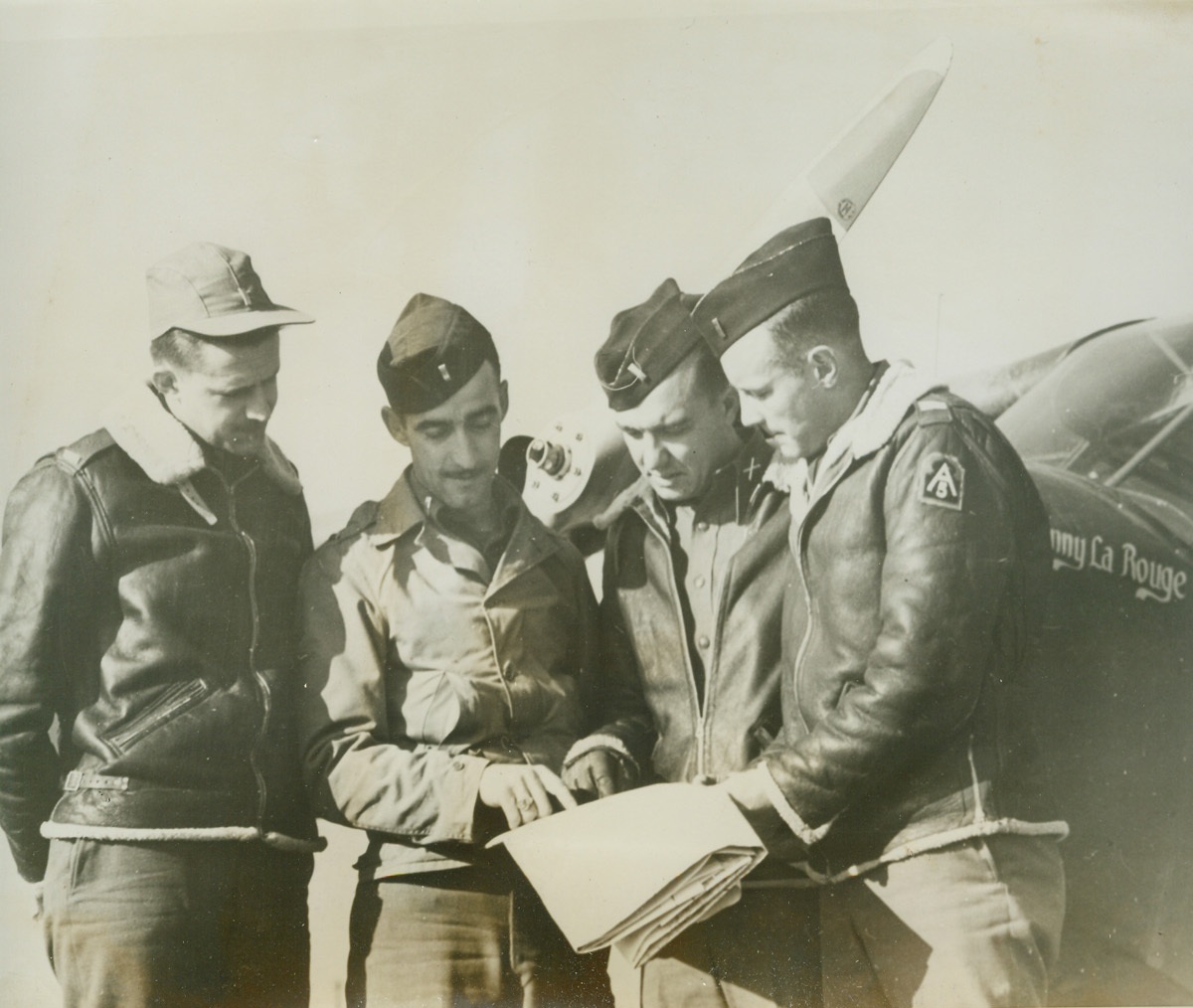
Ready for the Next Leap, 2/7/1944. Italy – Yank pilots flying Cubs in Italy trace their next mission. (left to right) 2nd Lt. W. Holden, Jr., of Baltimore, Mad.; 2nd Lt. Dick Cummings, of Ames, Ia., D.F.C.; 2nd Lt. Oved S. Essary, Dallas, Texas, and 1st Lt. Richard W. Blake, of La Salle, Colo. Credit: (ACME);
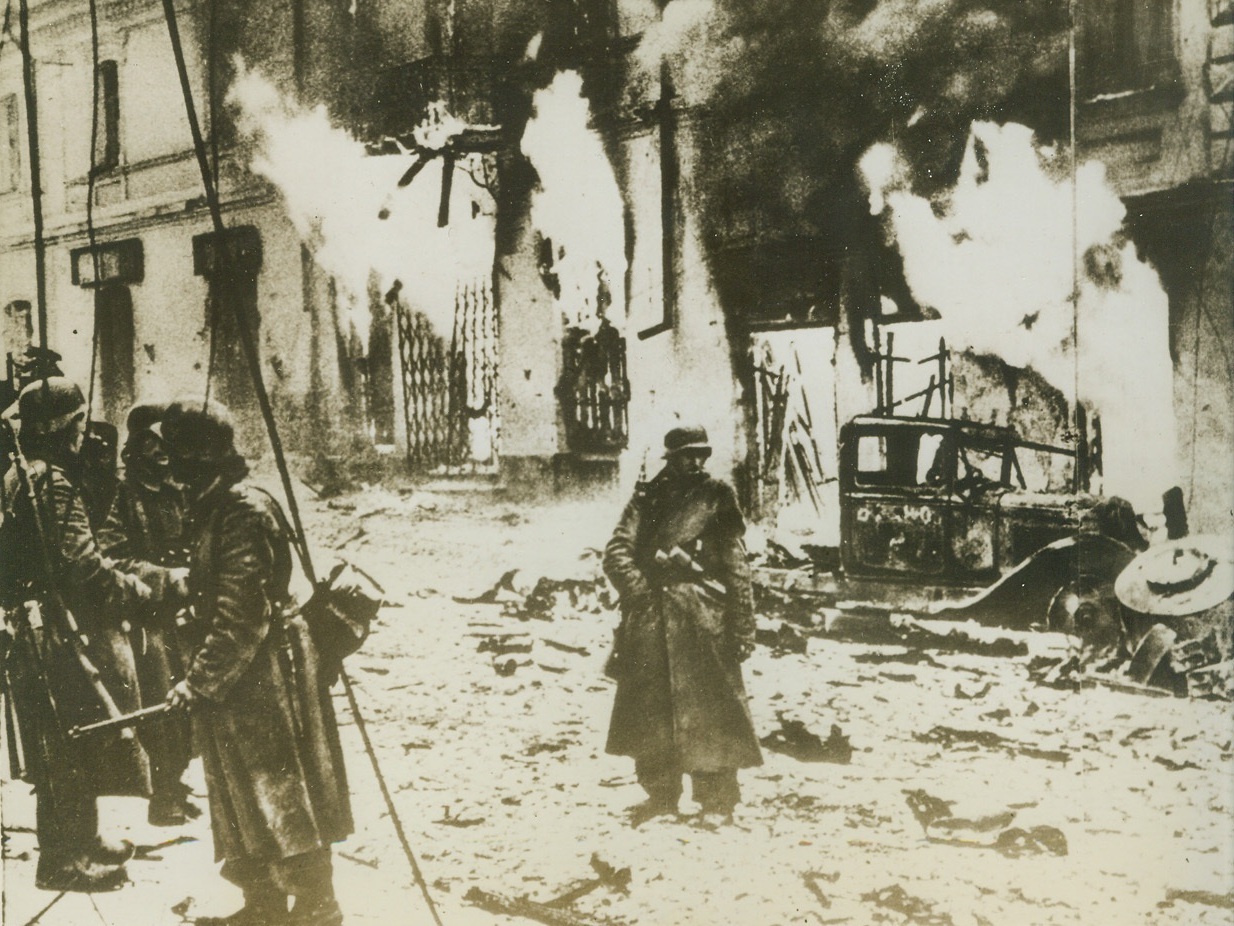
Embattled Zhitomer, 2/11/1944. Zhitomer, U.S.S.R. – Four times a battlefield, the important industrial town of Zhitomer in the Kiev sector of the Ukraine lay in ruins when the Red Army finally drove the Nazis from the stronghold. Here a German demolition squad stands by to watch its handiwork near completion as a row of buildings burn to the ground. Photo obtained through a neutral source. Credit: (ACME);

Nettuno Waterfront Under Attack, 2/26/1944. Nettuno, Italy – Most of them obscured by heavy shell smoke, the beautiful homes lining the waterfront at Nettuno are targets for the Nazis. Pounding the Allied holdings from their positions along the Italian coastline north of Anzio, the Germans keep up a relentless barrage. Credit-WP-(ACME Photo by Bert Brandt for the War Picture Pool);
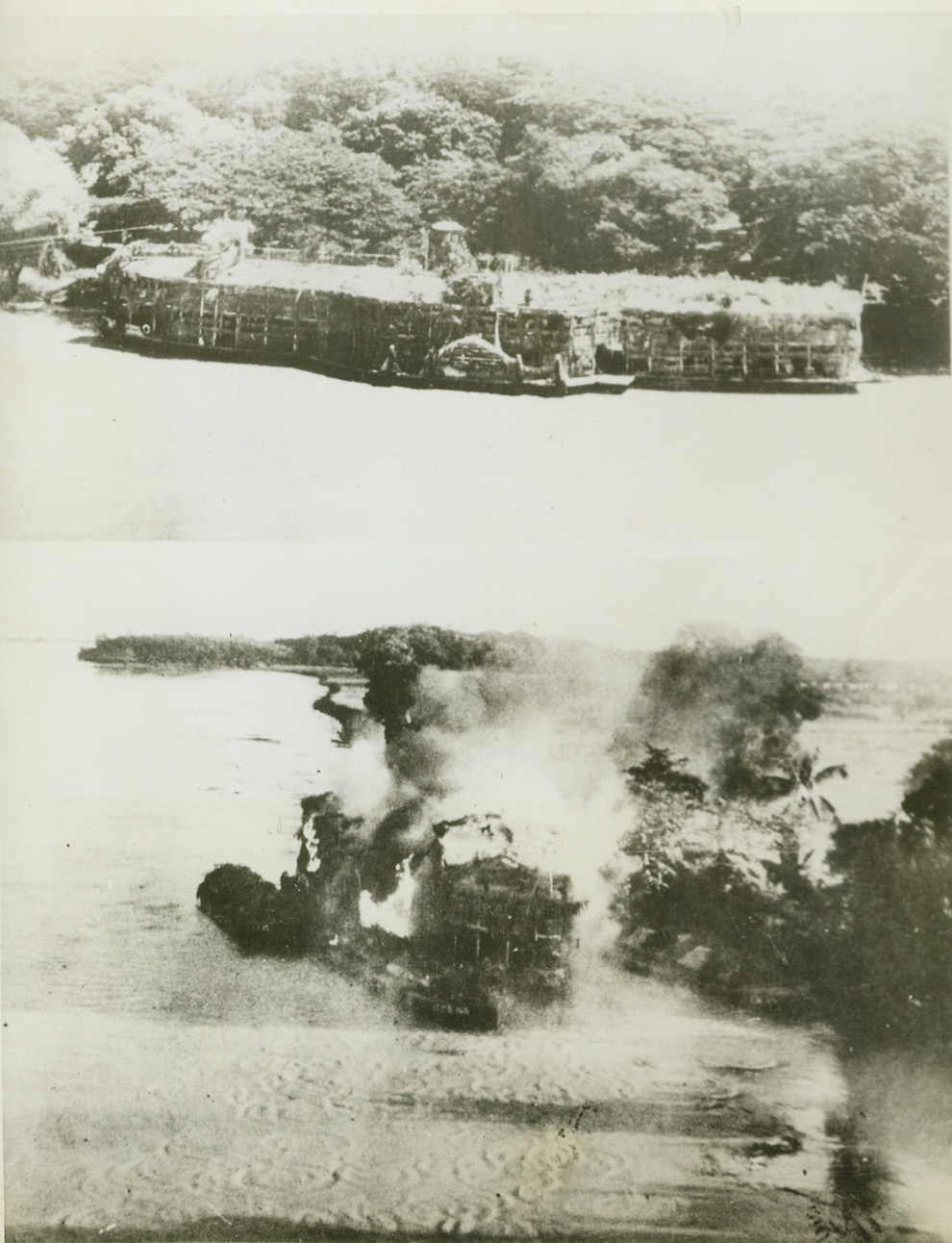
JAPS USE HOUSEBOATS AS BURMA HEADQUARTERS, 2/16/1944. SOMEWHERE IN BURMA – Japanese commanders use well camouflaged houseboats as headquarters on Burma rivers, thus hoping to escape air attack. Top photo shows how houseboat blends into jungle growth as background. Bottom: Proof that the camouflaged headquarters did not fool crew members of the R.A.F. Beaufighter which set the boat afire with cannon shells and bombs. Credit: ACME;
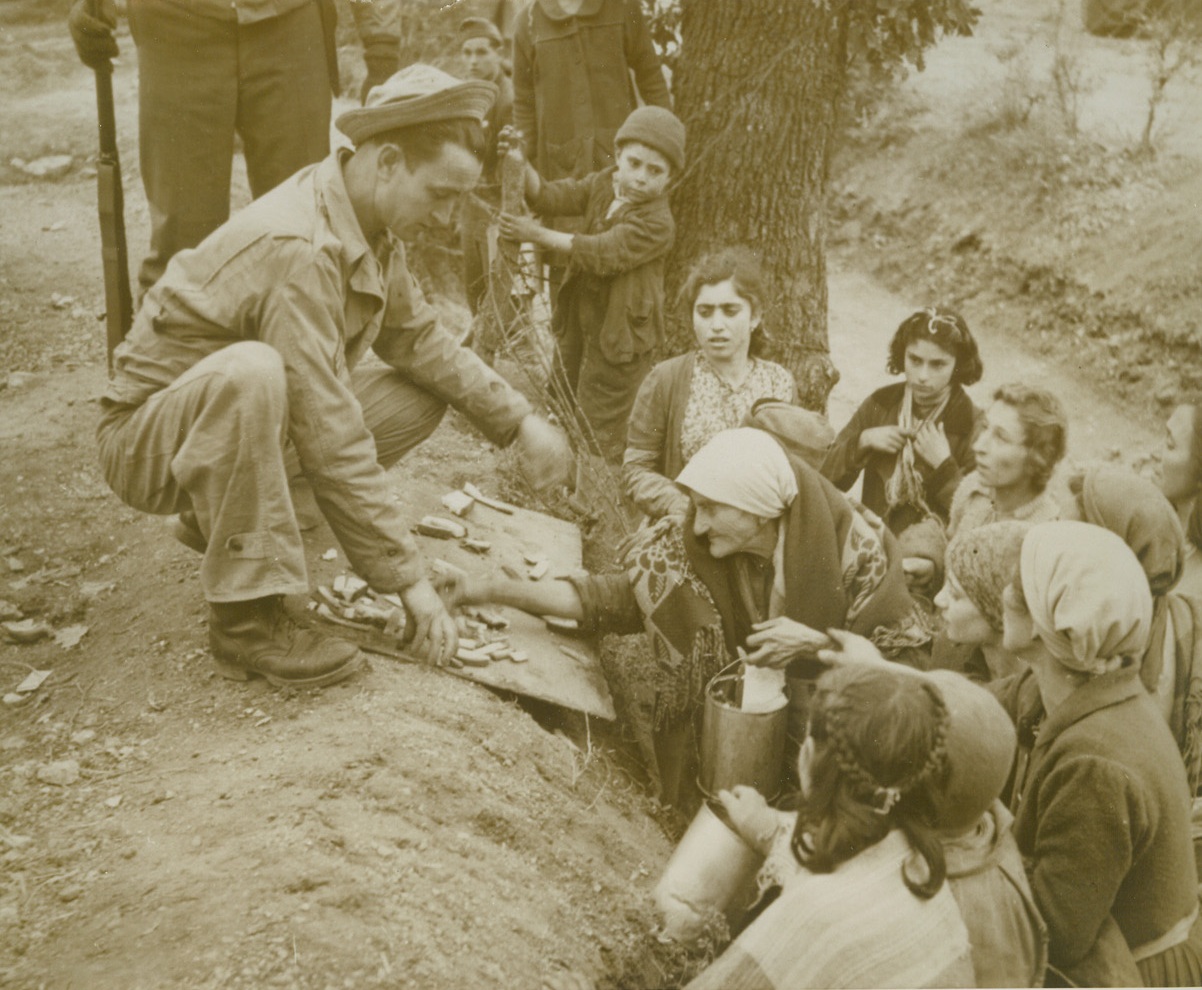
To Them It Means Nourishment, 2/2/1944. ITALY--Some of the starving destitute Italians who cluster around virtually every U.S. Army food dump in Italy scramble for their share of far over the barbed wire barrier scraping for her share, while others crowd close, their pails ready for leftovers, near the Cassino Front.Credit: WP;
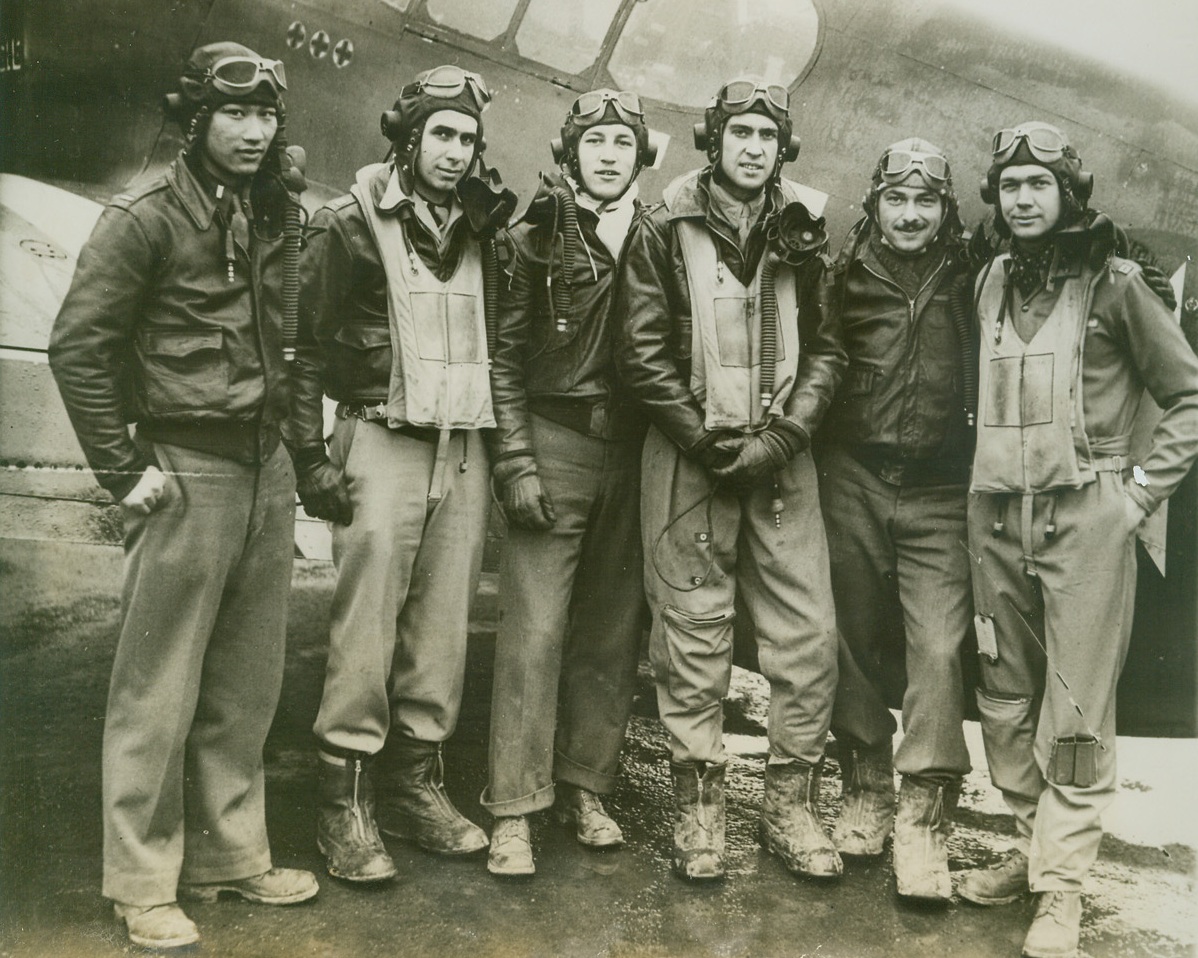
Mustang Pilots, 2/10/1944. SOMEWHERE IN ENGLAND—Mustang Pilots all, these Yank airmen are hitting the Nazis from their British base. Left to right are: Lt. Wau Kau Kang of Honolulu; Capt. Wallace s. emmer, St. Lewis, Mo.; Capt. Don M. Beerbower, of Hill City, Minn.; Capt. Jack T. Bradley, Brownwood Tex.; Lt. James J. Parsons, Seattle Wash.; and Capt. James Cannon, Vallejo Calif. Credit: ACME;

Watch Dogs Of The Ghetto, 2/1/1944. OCCUPIED EUROPE – Jewish police, operating in a ghetto market place, wear Star of David armbands and carry rubber truncheons. This photo, just received from a neutral source, is one of the first to show typical day-to-day scenes in a ghetto in German-occupied Europe where the Jews, separated from the rest of the population, carry on an entirely separate existence. Outside their walls, they are guarded by Gestapo police.Credit Line (ACME);
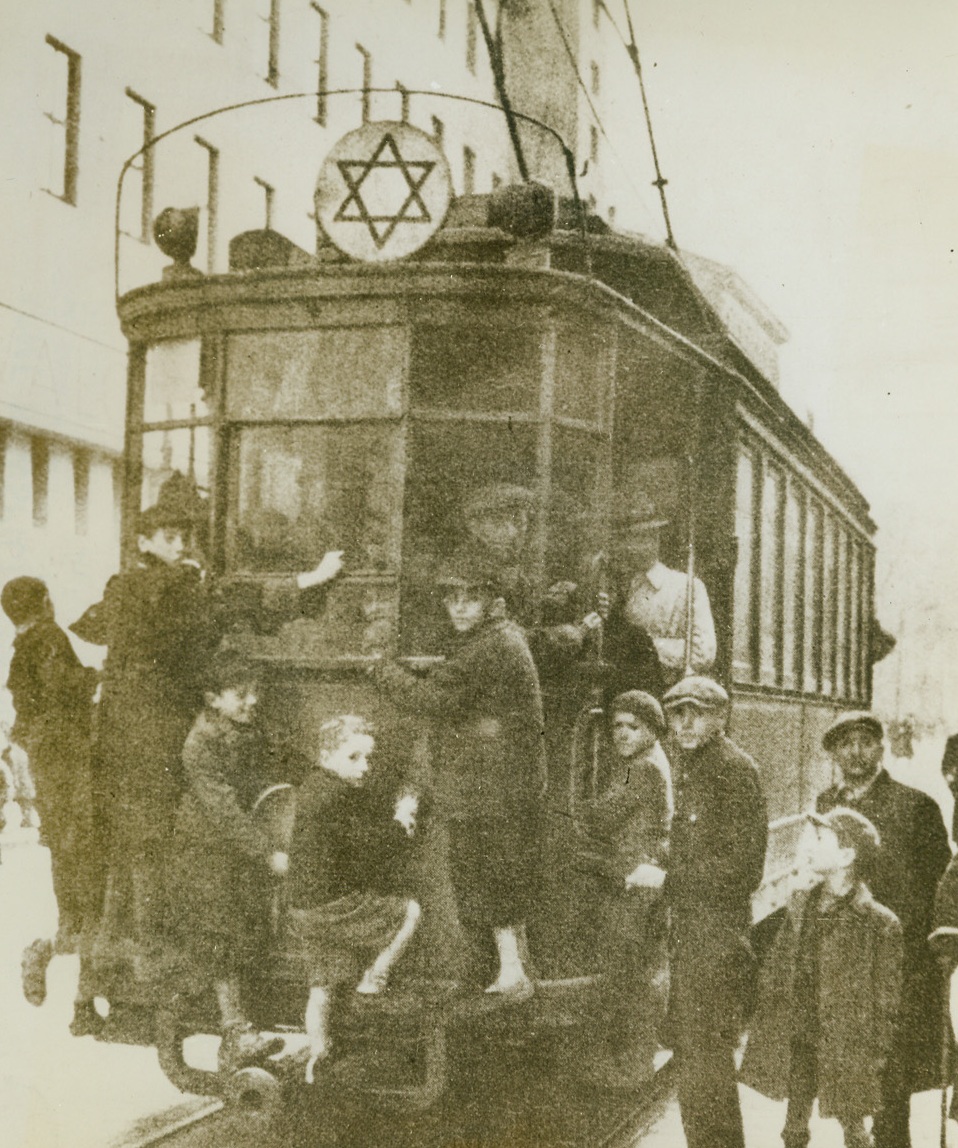
For Jews Only, 2/1/1944. OCCUPIED EUROPE—Crowded to capacity, with Jewish children clinging to the outside, a ghetto street car starts off on a journey, the Star of David (top of car) prominently displayed. The public conveyance is confined to the limits of a ghetto, somewhere in German-occupied Europe, where Jewish people are packed together and segregated from the rest of the world.Credit: Acme;
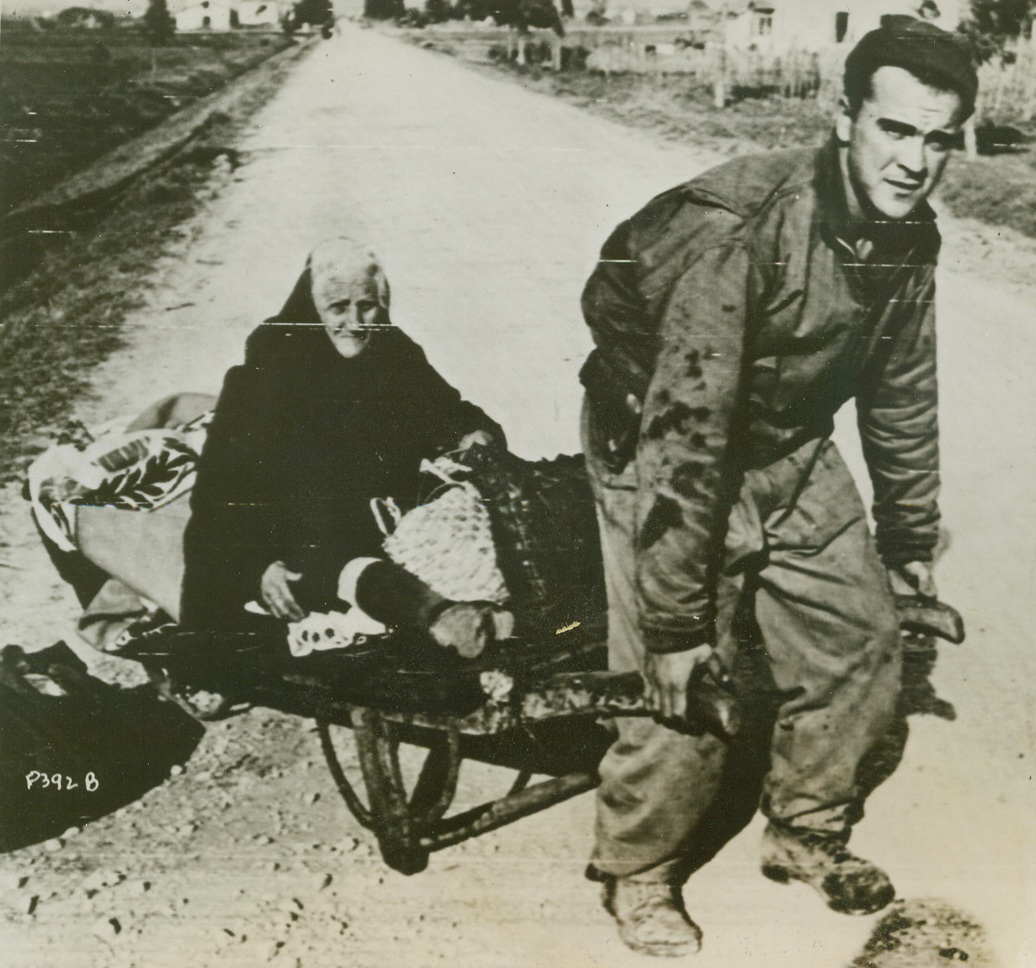
HAND-TRUCKING THE AGED TO SAFETY, 2/7/1944. ANZIO, ITALY—Pvt. Joe Maniscalo, of Brooklyn, New York, believes in chivalry as he wheels an aged Italian woman in a native hand-truck on the road to Anzio. The aged woman fled with her meager personal effects from the German-held territory near Cisterno.Credit: Official Signal Corps radiotelephoto from Acme;

ARTIFICIAL LIMBS DEMONSTRATED, 2/1/1944. WASHINGTON, D.C.—Charles McGonegal, of Sunol, Calif., World War I veteran who lost both arms in combat action, shows his ability to use his artificial hands to a group of present war veterans, similarly afflicted. Demonstration, held under auspices of American Legion, took place in the occupational therapy division of the Army Medical Center, Walter Reed Hospital.Credit: Acme;

PUBLICLY RIDICULED, 2/1/1944. OCCUPIED ERUOPE—The Nazis forced these four bearded Jewish men to march in a parade staged to denounce their own race. The Jews present grief-stricken or uncompromising countenances to the camera as they walk through the unhealthy ghetto in occupied Europe where the Nazis staged the anti-Semite demonstration. This photo was received through a neutral source.Credit: Acme;
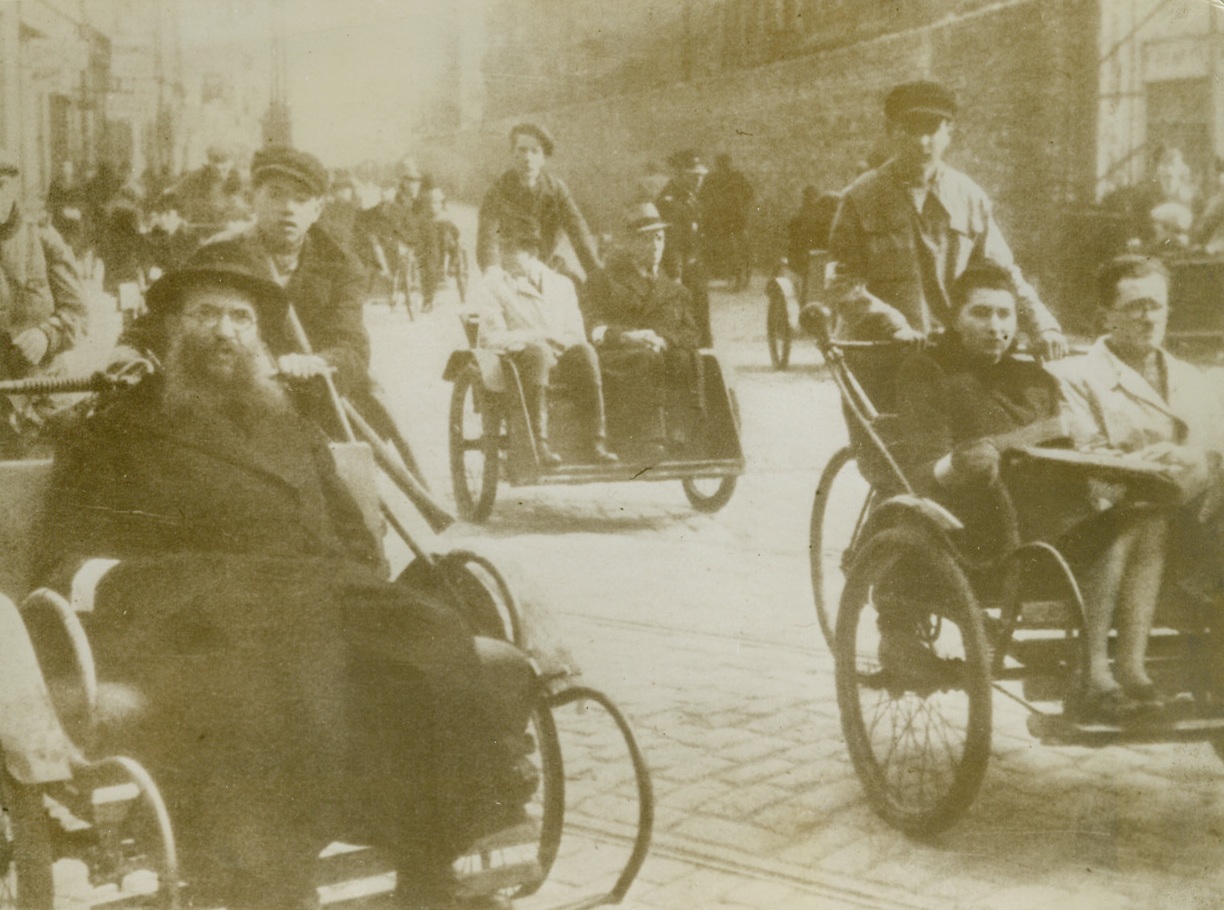
NO “CABS” IN A GHETTO, 2/1/1944. OCCUPIED EUROPE—Young Jewish boys push home-made “taxis” through the street of a ghetto in German occupied Europe. Guarded on the outside by the Gestapo, and on the inside by Jewish police, the inhabitants of the ghetto are segregated from the rest of the country. Received through a neutral source, this is one of the first photos to show a typical day-by-day existence in a Nazi-created ghetto.Credit: Acme;
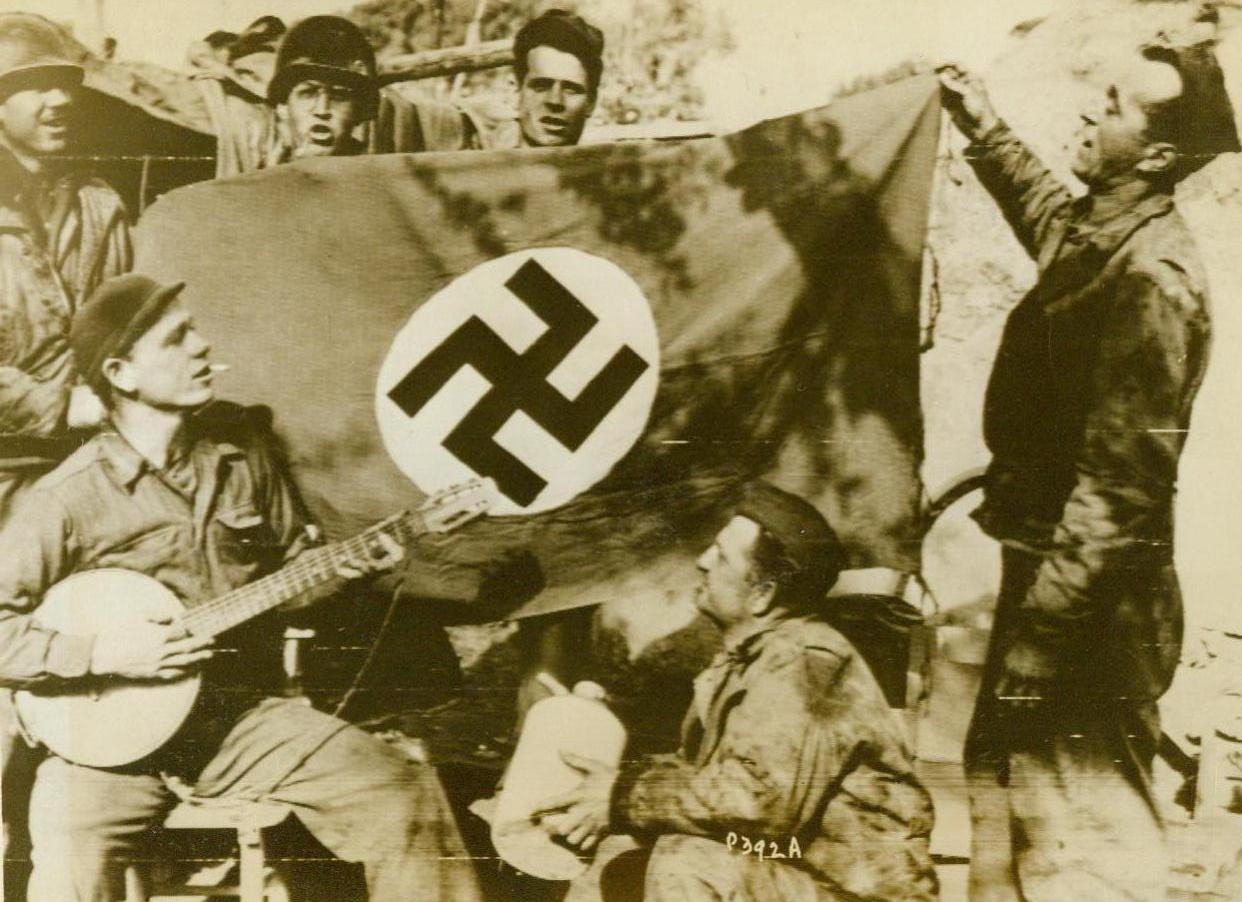
SERENADING DEFEATED ENEMY, 2/7/1944.SOUTH OF ROME, ITALY: Six Yanks break into improvised song about the Nazi Swastika flag that they captured from the enemy near Nettuno, the men, left to right, are : Pfc. Harry C. Belle, of Kingsport, Tenn; Pfc. John Gursky, of Philadelphia, Pa., an Pfc. Peter Safrey, of New York City; rear: Corp. John Cugnini, of Durango, Colo; Pfc. Wilbur Morirarity, of Lancaster, Calif; and Pvt. Kenneth B. Lance, of Toly, Texas Credit (Official Signal Corps Radiotelephoto From ACME);
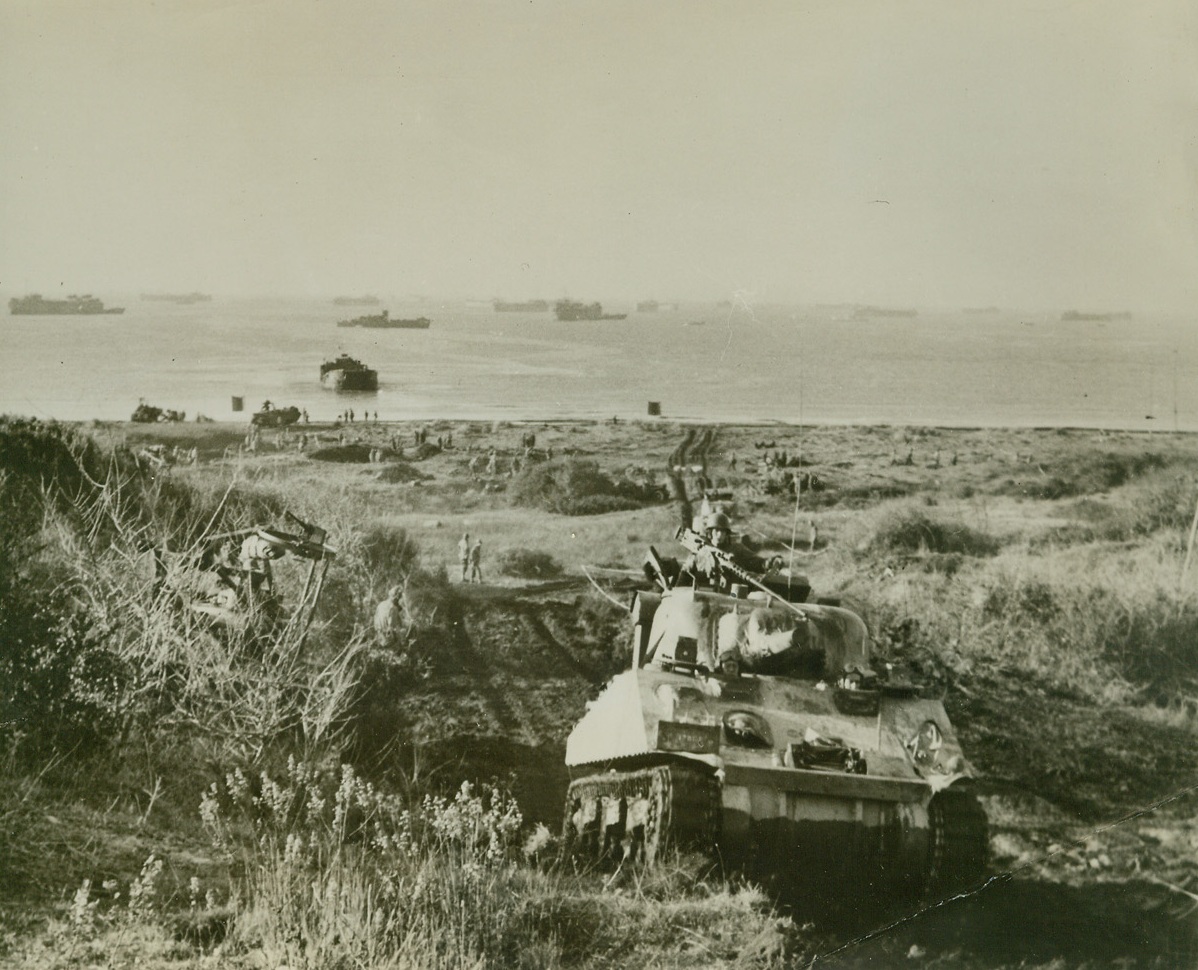
On the Road to Rome, 2/3/1944. Italy—An American tank rolls up a hill from the invasion beach, where it was landed during the first stages of the Allied capture of beachheads in the Nettuno-Anzio area in the drive on Rome, last Jan. 22. Standing off the beach (background in photo) can be seen some of the ships of the huge Allied invasion fleet (passed by censors). Credit: ACME.;
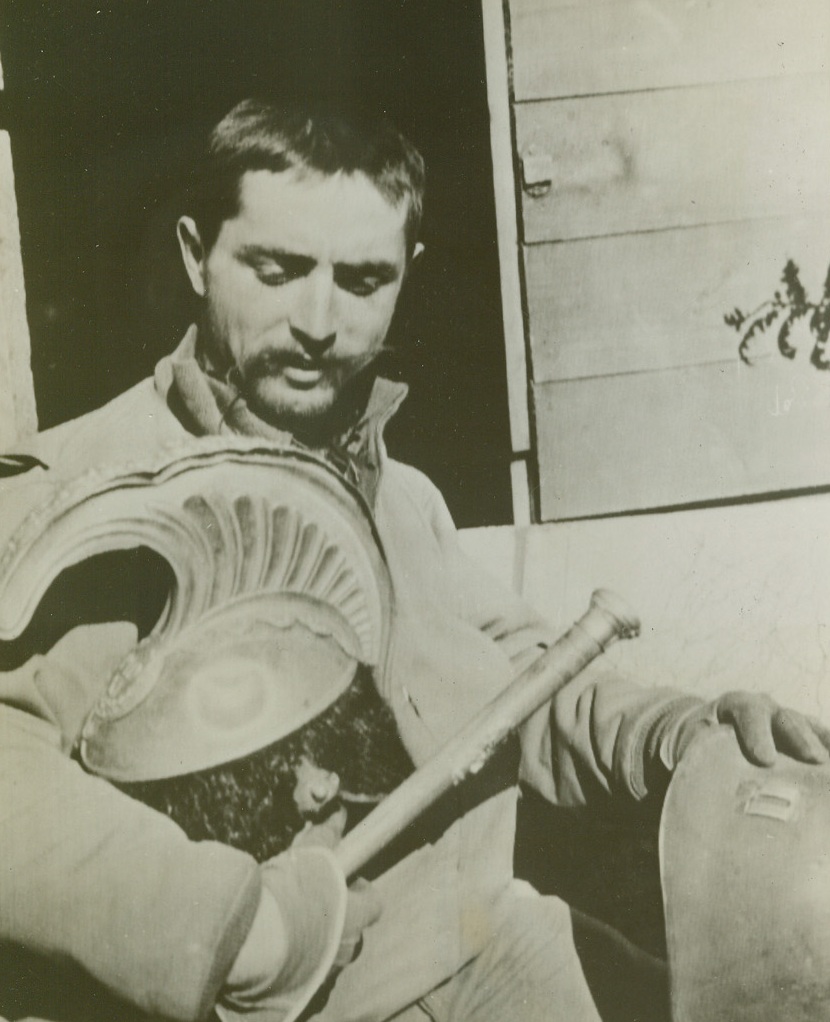
Ancient and New Helmets, 2/1/1944. Italy: Capt. Frederick J. Saam, of Calumet, Mich., presents a contrast in the two epochs of war, which the town of Anzio, Italy has witnessed with the ancient Roman helmet in his right hand and his own 20th century helmet in his left hand. Credit: U.S. Signal Corps radiotelephoto from ACME.;
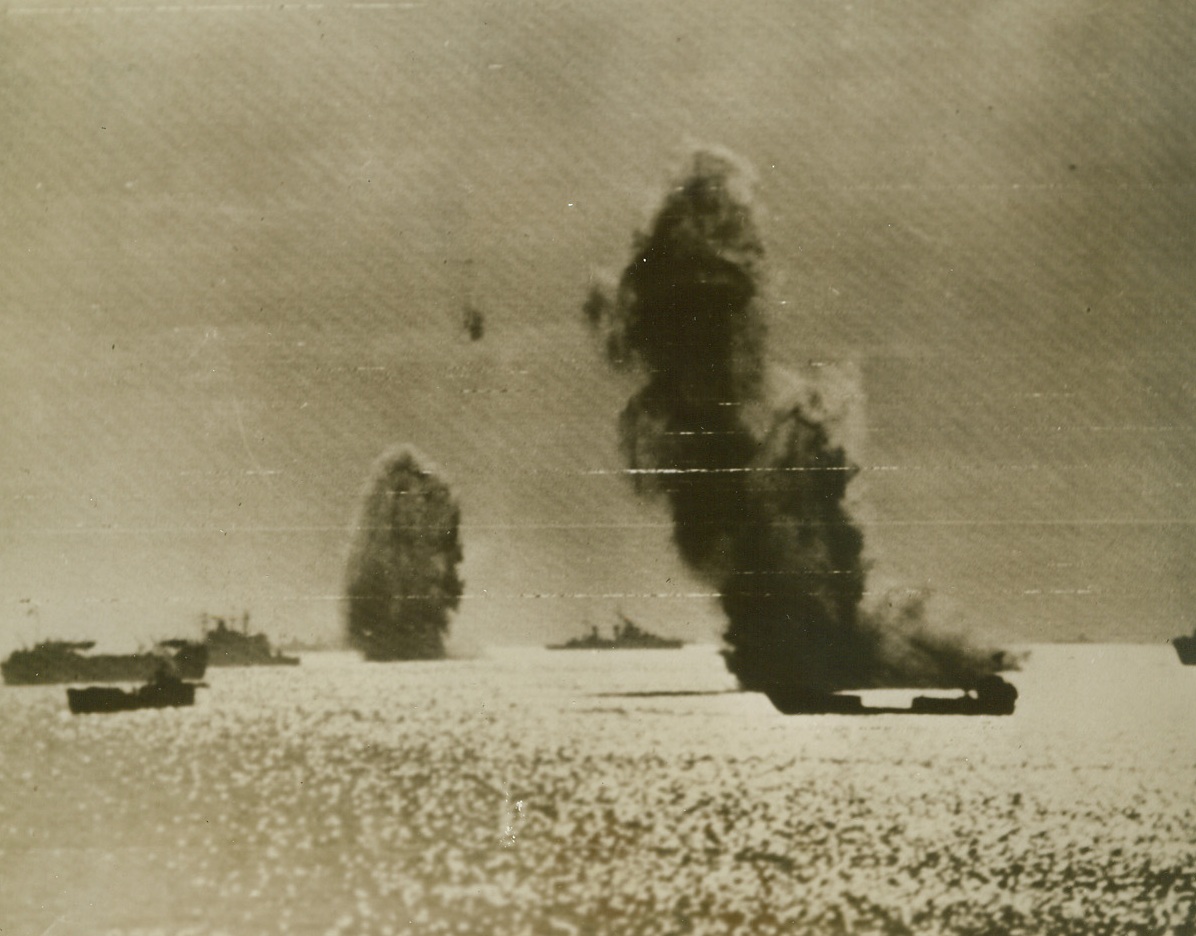
Axis Bid to Stop Allies’ Rome Drive, 2/2/1944. Anzio, Italy—In spite of many German air attacks on the Allies’ supply line to the invasion beaches at Anzio, the U.S. and British forces driving on Rome have pushed ahead and are on the outskirts of Campoleone, 15 miles from the Eternal City. The advance was made possible by a constant stream of men and material passing through invasion beachheads. Here, in this photo flashed to the U.S. by radiotelephoto, German plans attack Allied shipping near Anzio, the bombs falling harmlessly in the water. Credit: ACME photo by Bert Brandt for the War Picture Pool via Army radiotelephoto.;

Yanks in “Surf Blitz”, 2/2/1944. Nettuno, Italy—Cpl. John Chiodo, (left), of Johnston, PA., and Pvt. Murrell Winner, of Louisville, KY, take time out for a dip in the surf at the once-famous bathing resort of Nettuno—one of the Allies’ beachheads in their drive on Rome. Today, the British and Americans have reached Campoleone and are only 15 miles from the Eternal City. Note beautiful villas in background (photo above). Credit: ACME photo by Bert Brandt for the War Picture Pool via Army radiotelephoto.;
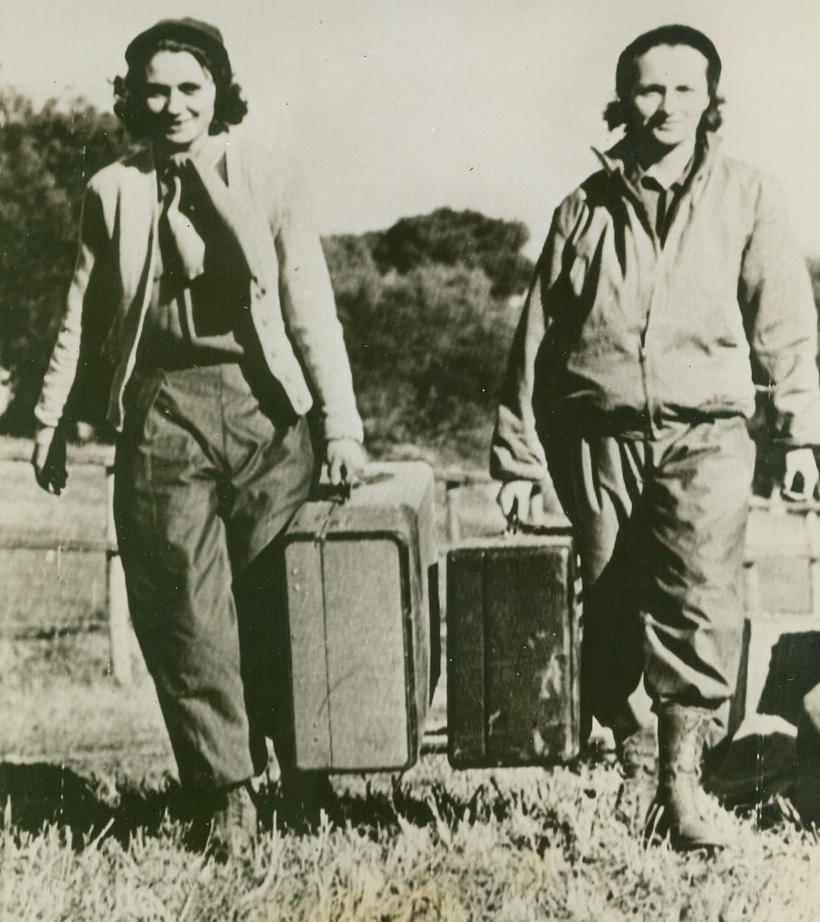
Following the Boys Toward Rome, 2/2/1944. Anzio, Italy—As American and British continue their drive on Rome, these U.S. Army nurses are shown arriving at the Allies’ invasion beachhead of Anzio. Left to right, are: Lt. Isabella Wheeler, of Blanchard, IA.; and Lt. Ruth Wells, Scottsbluff, Neb. Credit: U.S. Signal Corps radiotelephoto.;
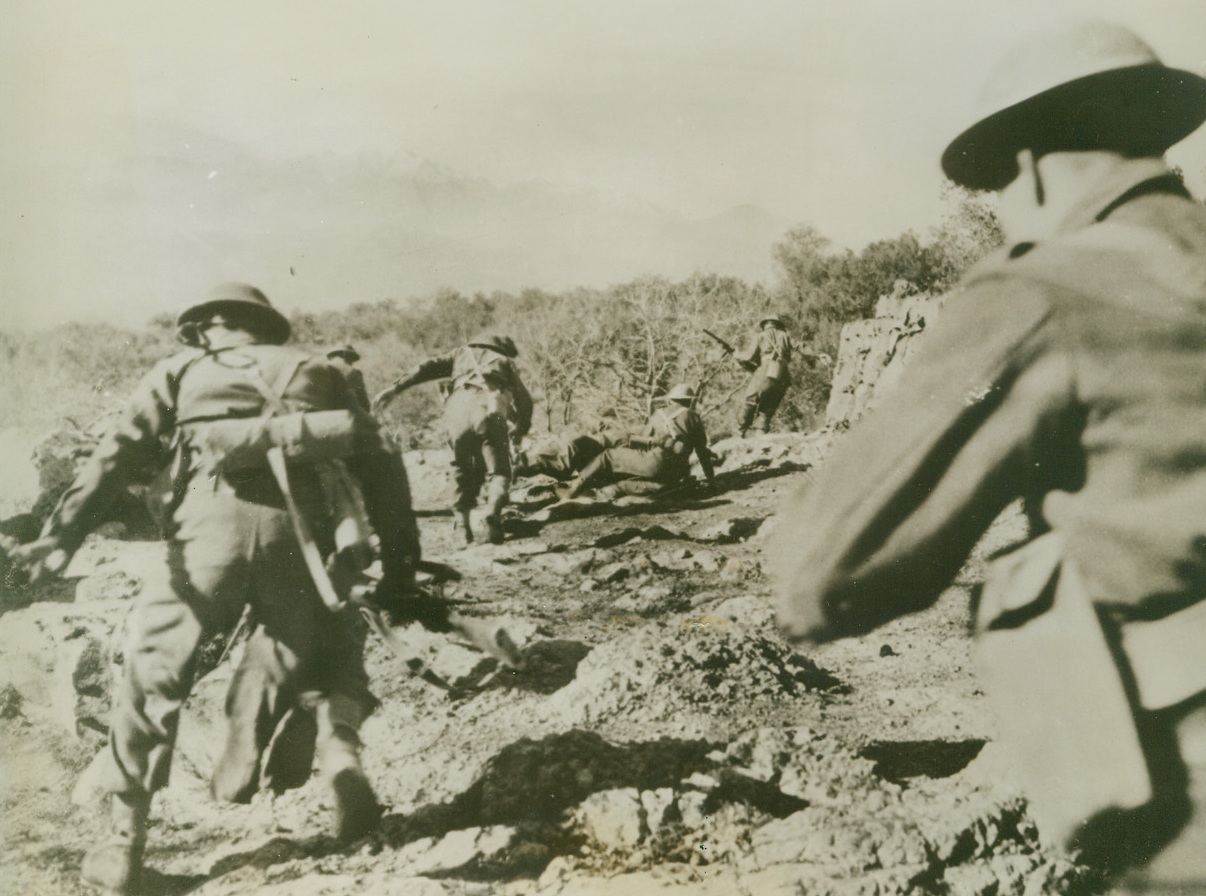
Moving Up, 2/2/1944. Cassino, Italy—Crouching as they dash across the uneven ground, British troops move forward in the Cassino area, on the Allied fifth army front. Credit: ACME.;
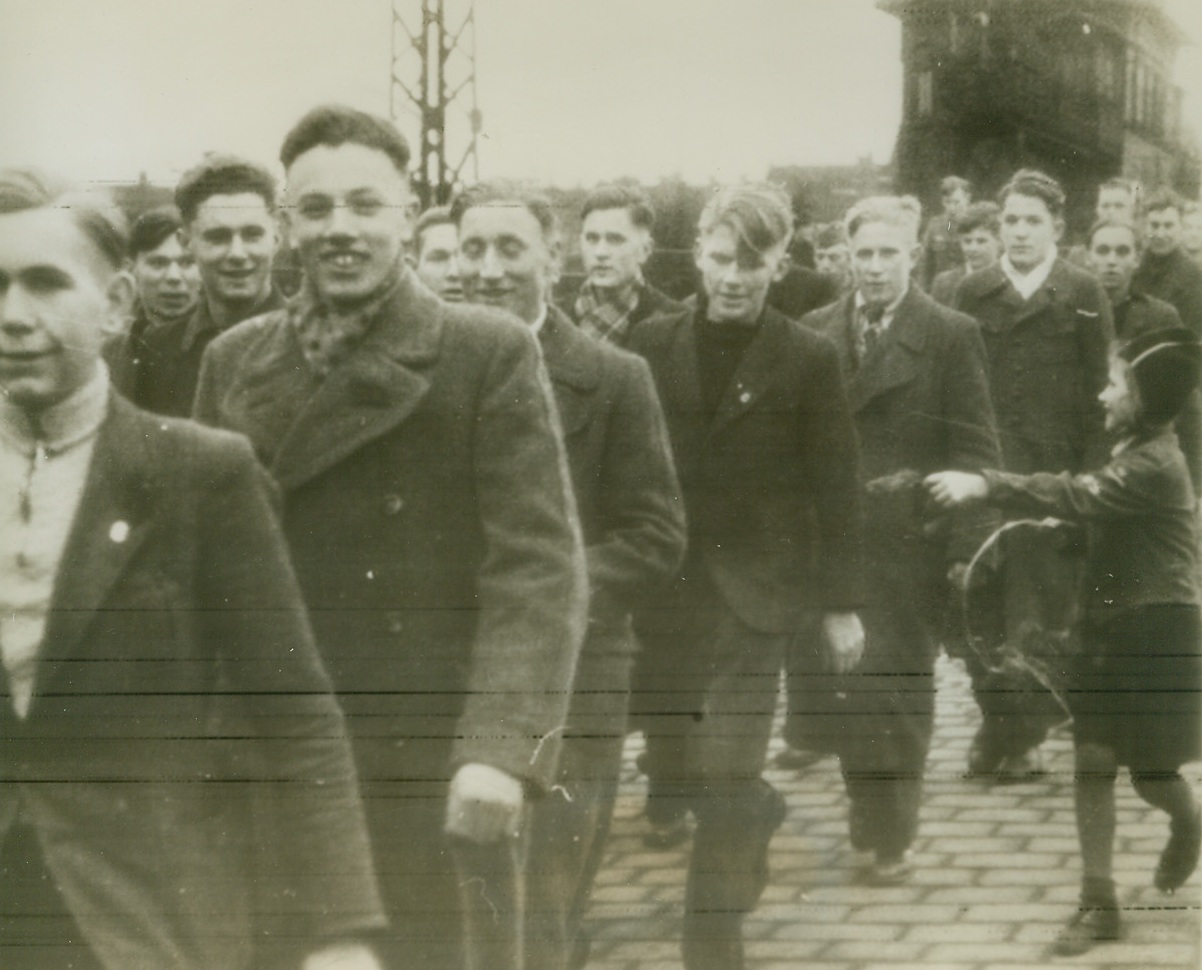
More Fodder for Hitler’s Cannons, 2/2/1944. Germany—Volunteers for Germany’s so-called armoured infantry division “Gross Deutschland,” many of whom are obviously only 15 years old, stage their first “parade” through the town where the division is stationed before they have even received their uniforms. Seemingly unaware of the grim death that awaits most of these unseasoned fighters, a little girl (right) happily offers a parting gift to one of the “men.” Photo radioed from Stockholm this morning. Credit: ACME radiophoto.;
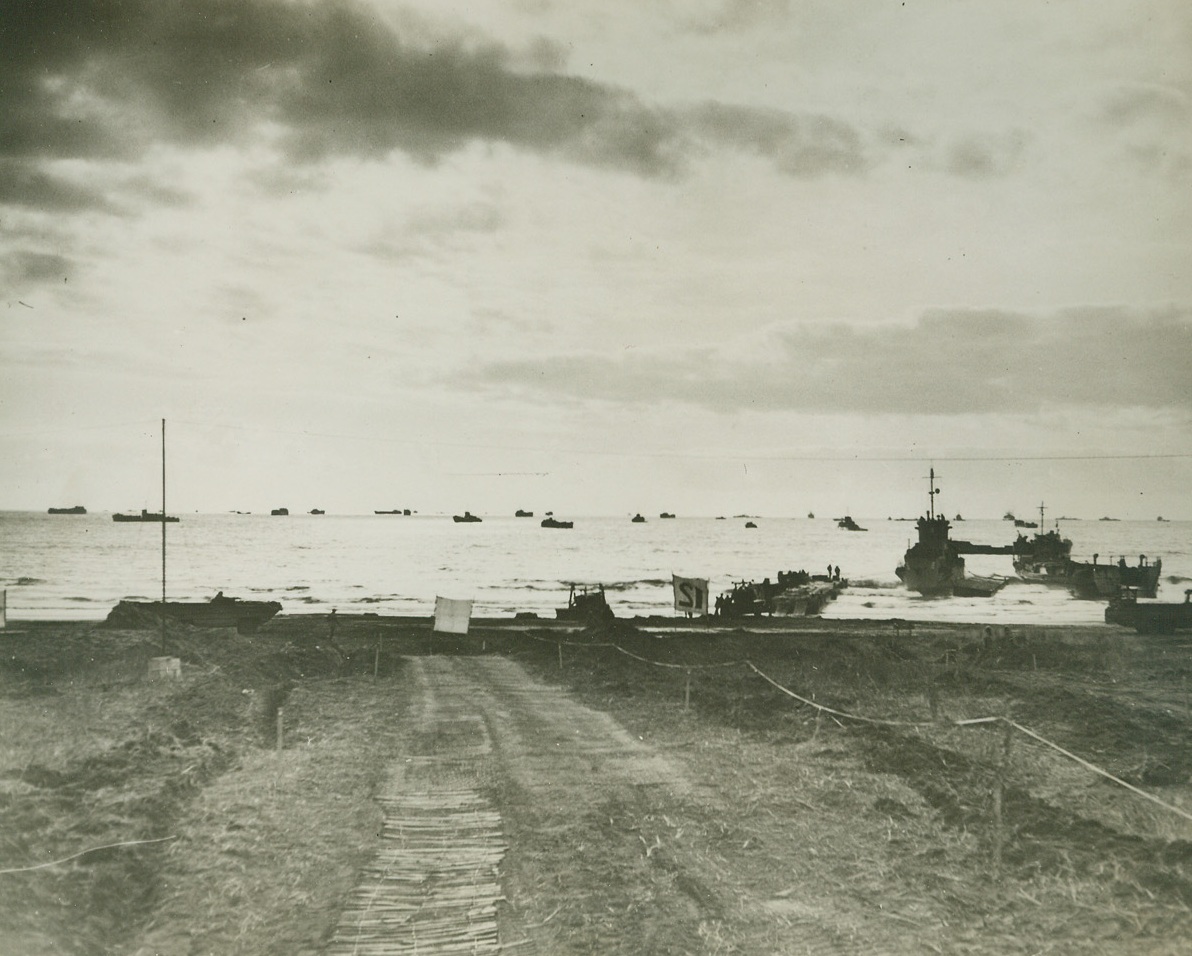
Allied Armada at Leap Frog Landing, 2/3/1944. Italy—A vast flotilla of Allied ships stretches out along the harbor in the Anzio-Nettuno area as troops of the Fifth Army are swiftly landed in the “leap frog” operation. The strategic landing caught the enemy by surprise and resistance was light. Credit: Official U.S. Navy photo from ACME.;
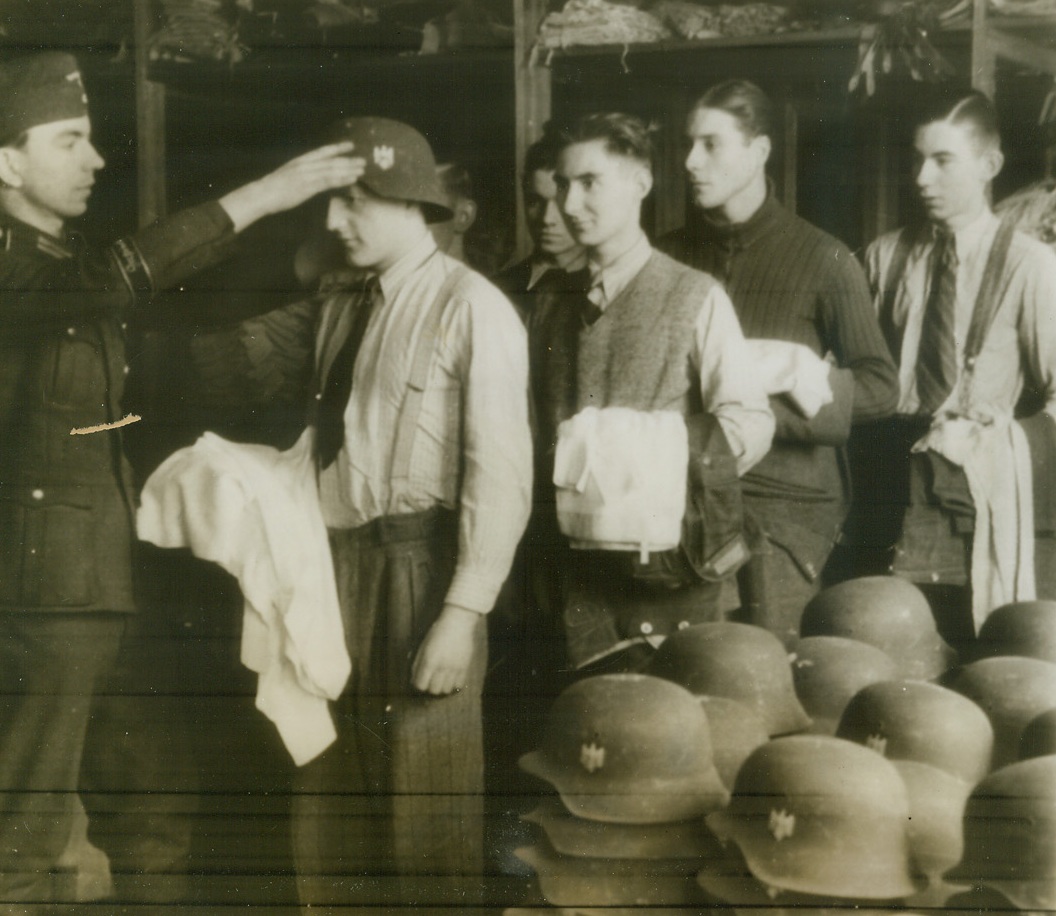
Youth Must Serve, 2/2/1944. Germany—Volunteers for Germany’s so-called “Gross Deutschland,” many of whom are obviously in their mid-teens, are shown receiving their clothing issue in a town where the division is stationed. Looks as if Germany is determined to use her very last drop of manpower in this war before giving up the struggle. Photo radioed from Stockholm this morning. Credit: ACME radiophoto;
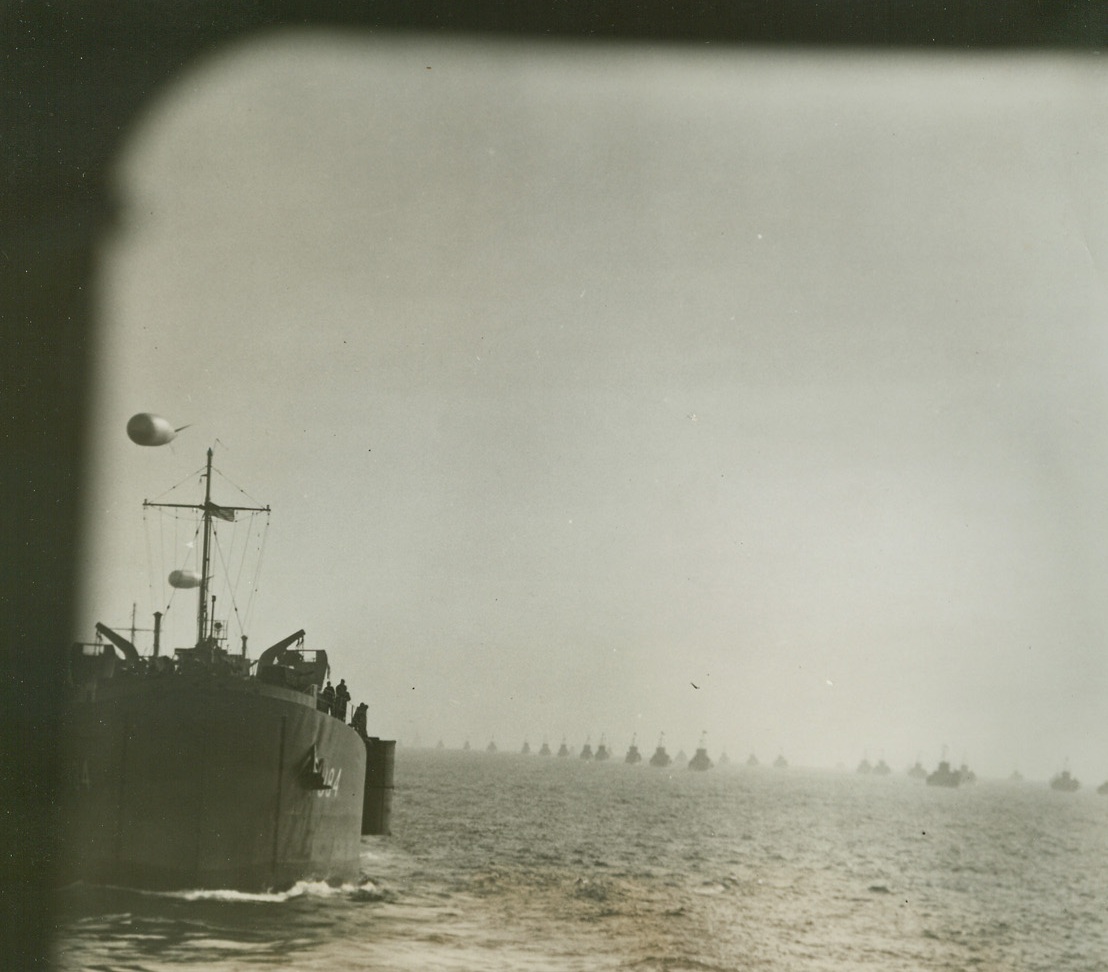
Invasion Armada Heads for Rome, 2/3/1944. This photo, one of the first originals to reach the United States, was taken as the huge Allied invasion fleet headed toward beachheads in the Nettuno-Anzio sector for the drive on Rome. At left (photo above) barrage balloons soar above LSTs (landing ships, tanks), while in center and right background, the sea is covered with invasion craft of various types. (Passed by censors) Credit: ACME photo by Bert Brandt for the War Picture Pool.;
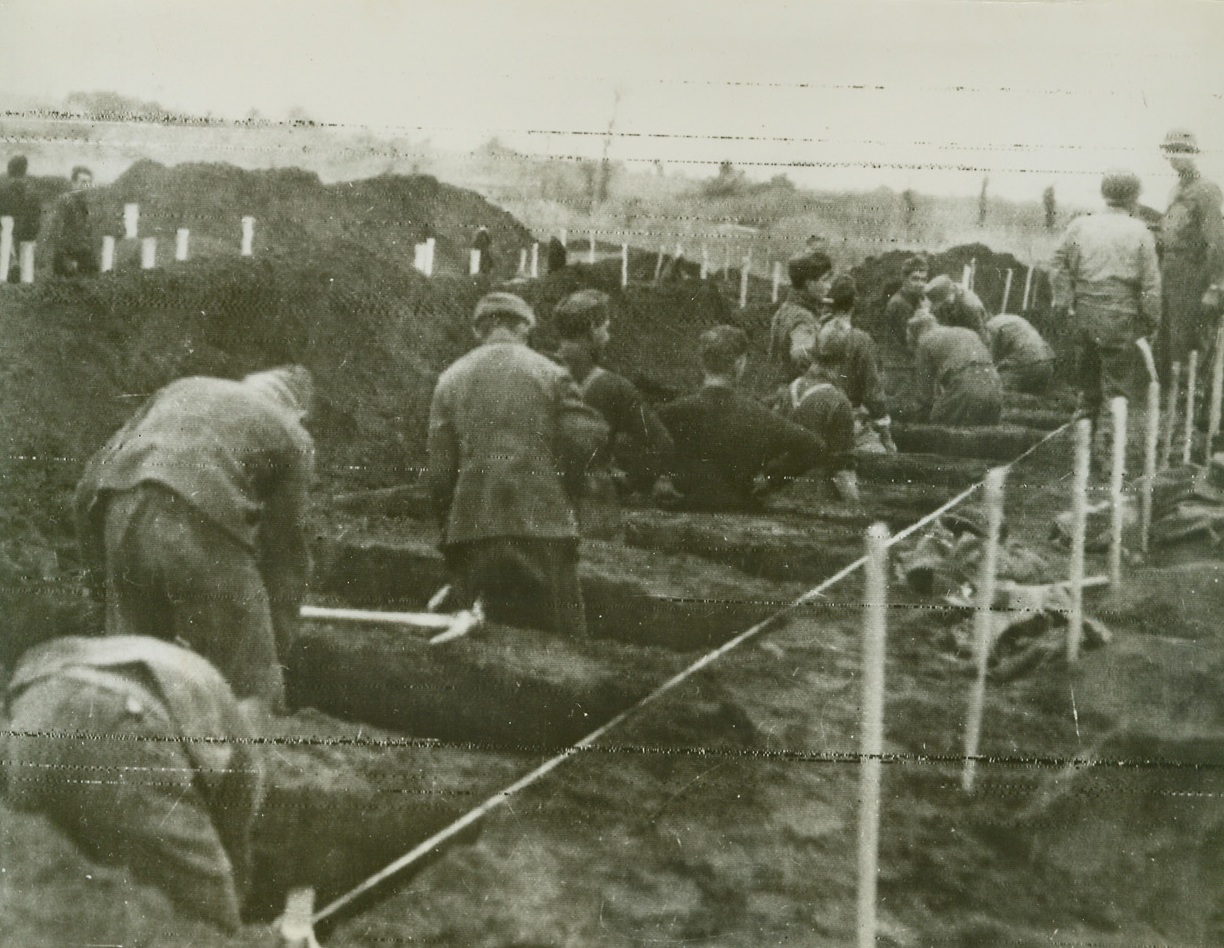
Burying Their Dead, 2/3/1944. Somewhere in Italy—Under the supervision of their Allied captors, German prisoners of war turn up Italian soil, digging graves for their late comrades. The Nazis were taken in the battle for Nettuno. Photo radioed to New York today (February 3rd). Credit: Official OWI radiophoto from ACME.;
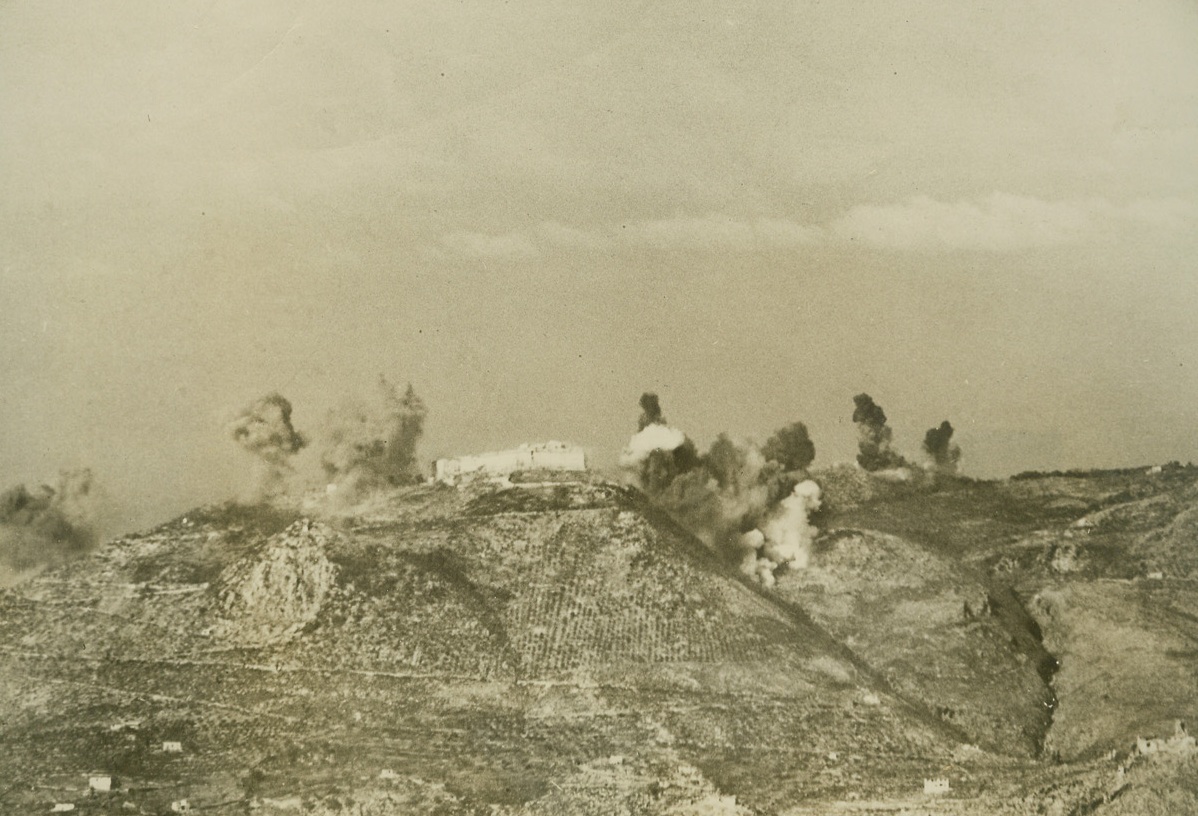
Allies Blast Nazis Out of Cassino Abbey, 2/25/1944. ITALY – Allied aerial bombardment begins against the ancient Benedictine monastery atop Mount Cassino, religious retreat which the Nazis had fortified to halt our drive. Reportedly many civilians were trapped in the cellars of the monastery, held there by the Germans who also met death from Allied bombs and shells. Credit Line (ACME);
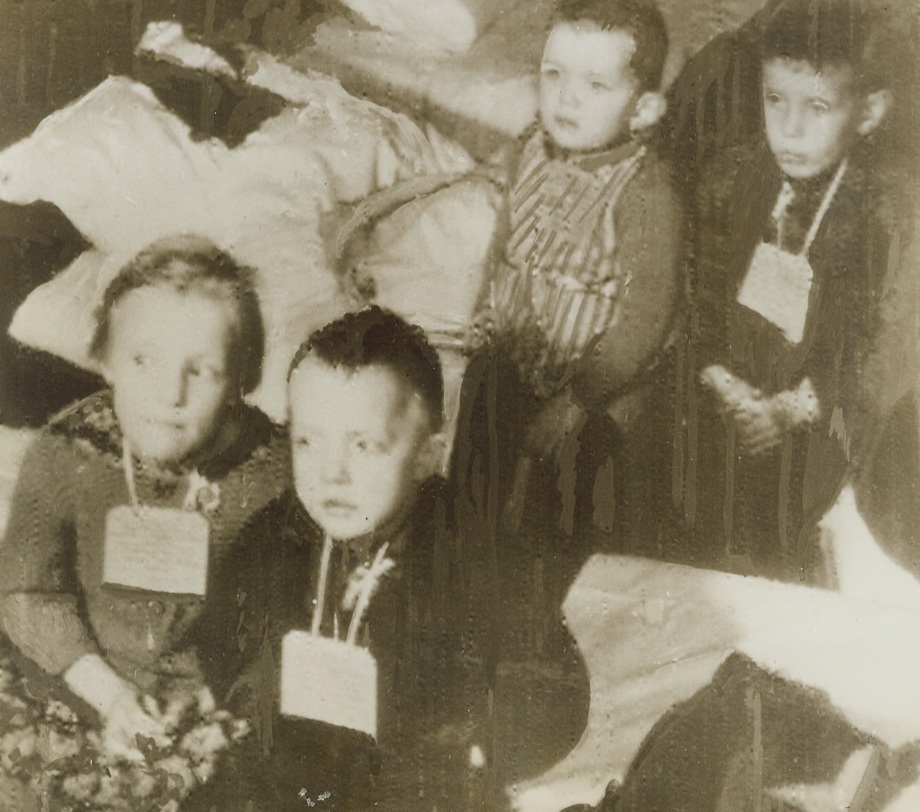
YOUTHFUL REFUGEES, 2/15/1944. STOCKHOLM, SWEDEN—Tired and bewildered, four Finnish youngsters sit quietly with hands folded and tags hung around their necks for identification purposes. The children, evacuated from embattled Finland, are shown as they arrived in Stockholm. Photo radioed to New York today (Feb. 15th). Credit: Acme Radiophoto;
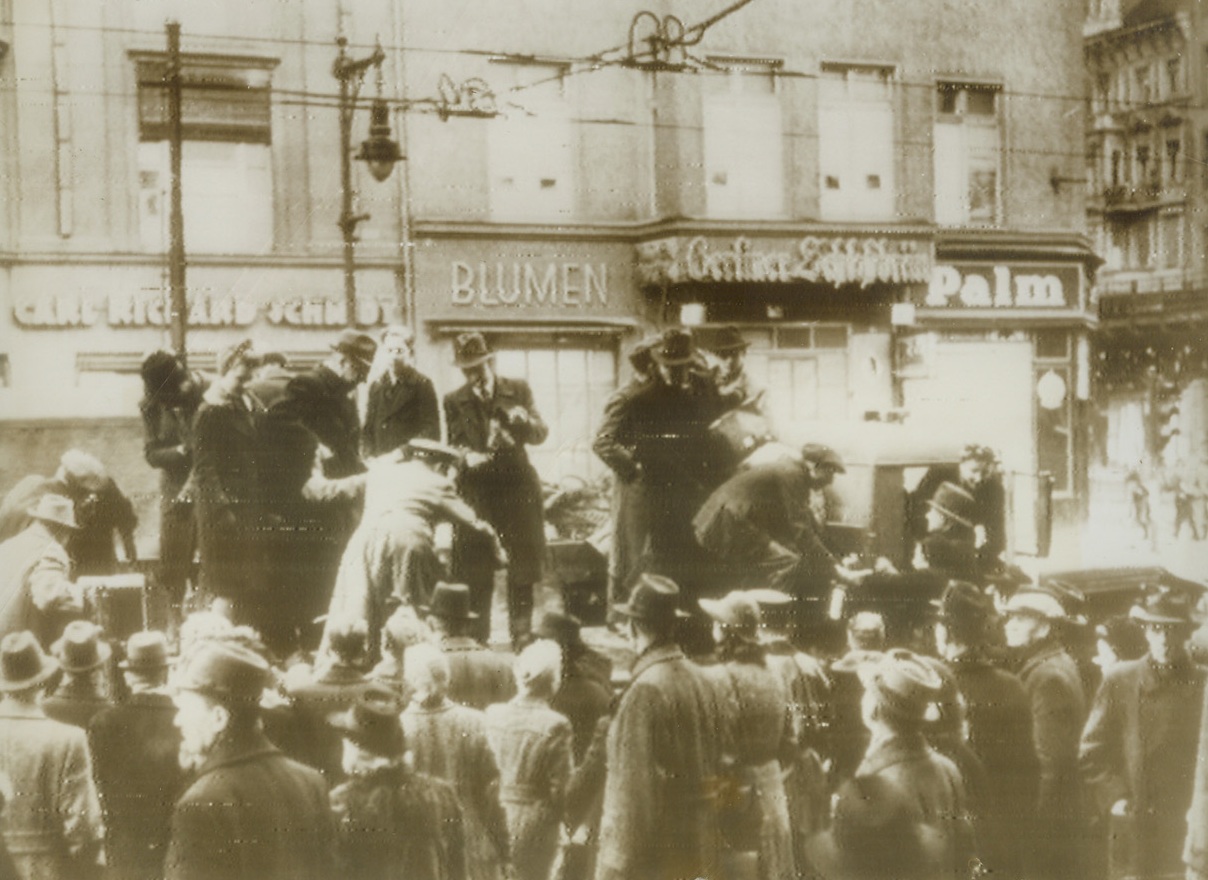
GOING TO WORK, 2/15/1944. BERLIN—This has become a common sight in Berlin ever since the Allies began to pound the German city from the air. Nazi laborers climb aboard a large truck that will take them to work, since bus, subway, street car and elevated lines were destroyed by bombs. But in spite of this means of transportation, many Berliners must walk to their jobs. Photo radioed to New York today (Feb 15th), was obtained through a neutral source. Credit: Acme Radiophoto;
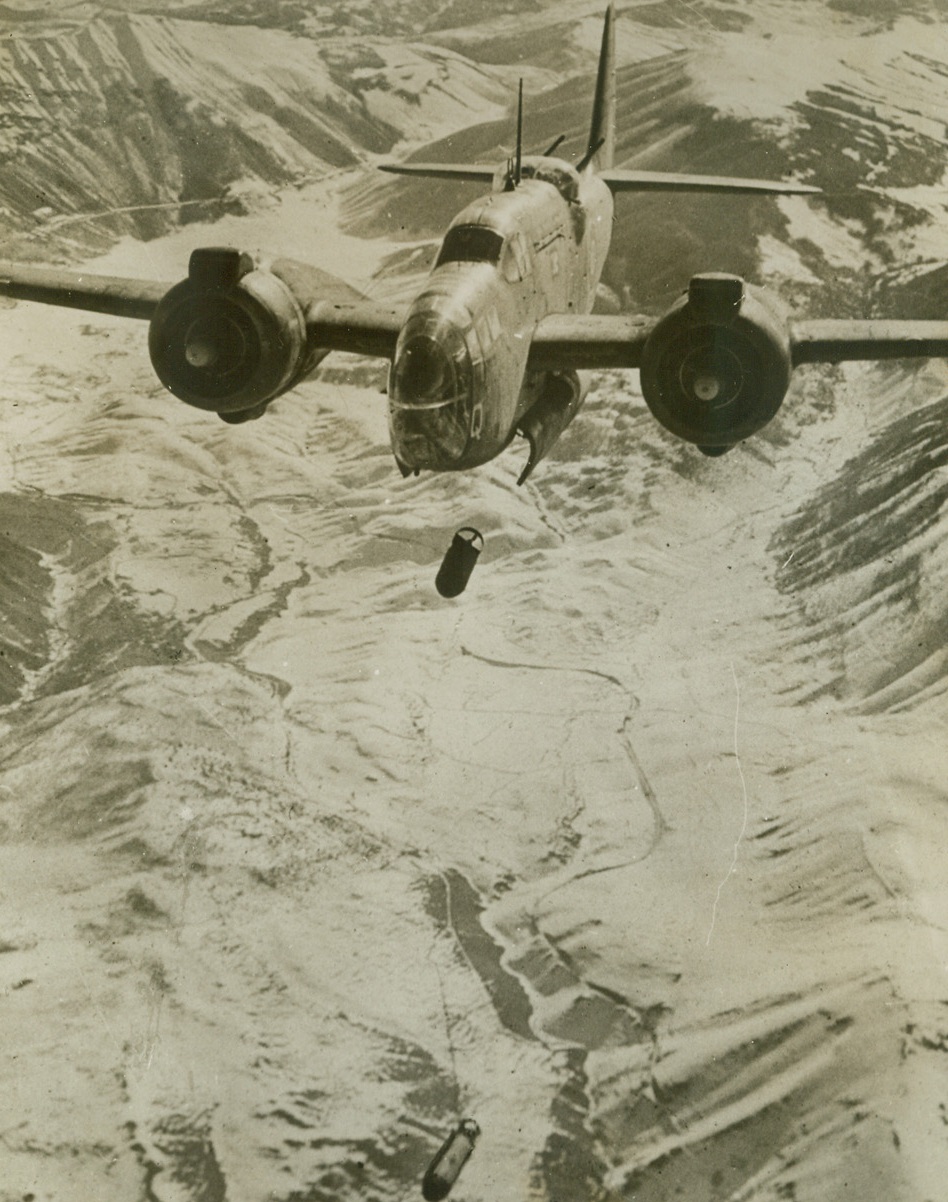
CHIPPING THE ICE OFF NAZI COMUNICATIONS, 2/1/1944. ITALY—An R.A.F. Baltimore lets loose a pair of bombs on the snow-covered town of Sulmona, important Nazi field communications center on the East-West route across Italy. One of the first pictures of R.A.F. support of Allied ground forces on the road to Rome, the photo shows the bomb heading straight for the rail junction and station nestled in the frozen valley. Credit: Acme;

MISSED!—THEY ALWAYS DO, 2/13/1944. ANZIO HORBOR, ITALY—Smoke and water cascade skyward as bombs dropped by Nazi raiders fail to hit their target, landing on the harbor bed. The Germans have tried to bomb these supply ships resting in the harbor at Anzio many times—but they’ve seldom hit the vessels. Credit: Acme photo by Bert Brandt for the War Picture Pool;
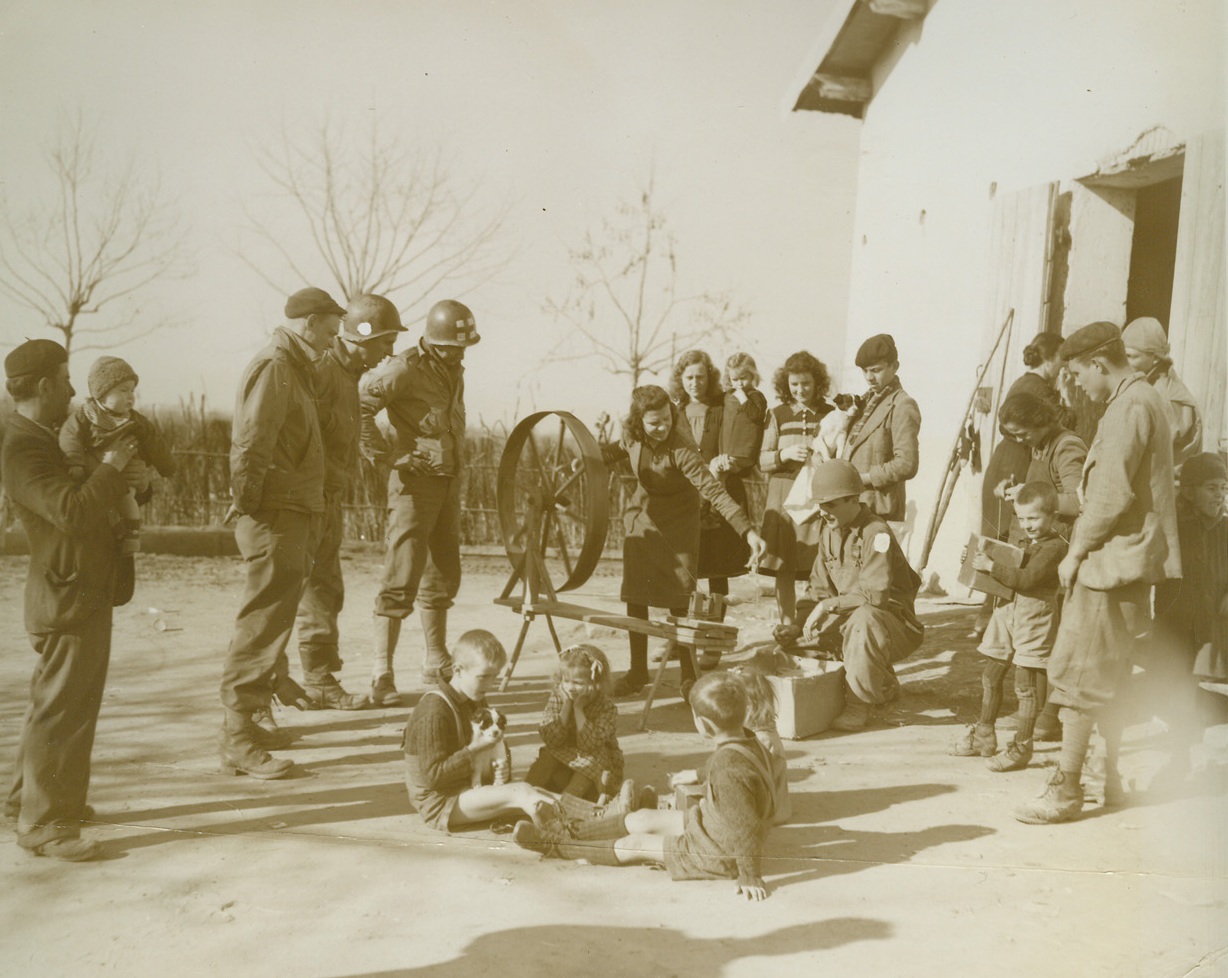
PEACE—IN THE HEART OF THE STORM, 2/13/1944. ON THE ITALIAN FRONT—Describing this photo Acme photographer Bert Brandt says: “This is the kind of scene you see as you travel along near the front—and it always amazes you for it looks so peaceful and yet you are within easy hearing of the shell bursts on the front only a mile away.” Left to right: Pfc Arthur Eames, Suffern, NY; Cpl Willie Whiteside, Rutherfordton, N.C.; and Cpl Arlo Pittman, May, Okla., watch with interest as an Italian family makes yarn from fleece in their farmyard just as they have done for years. Pvt Antone Silva, North Dartmouth, Mass., helps with the operation. Credit: Acme photo by Bert Brandt for the War Picture Pool;

CAPTURED NAZI BOOTY, 2/13/1944. ITALY—A field chock-full of captured German ammunition and mines is guarded by Pfc. Michael Paulik, MP from Pittsburgh, Pa., who is fighting in the Nettuno beachhead area. Credit: Acme photo by Bert Brandt via Army Radiotelephoto;
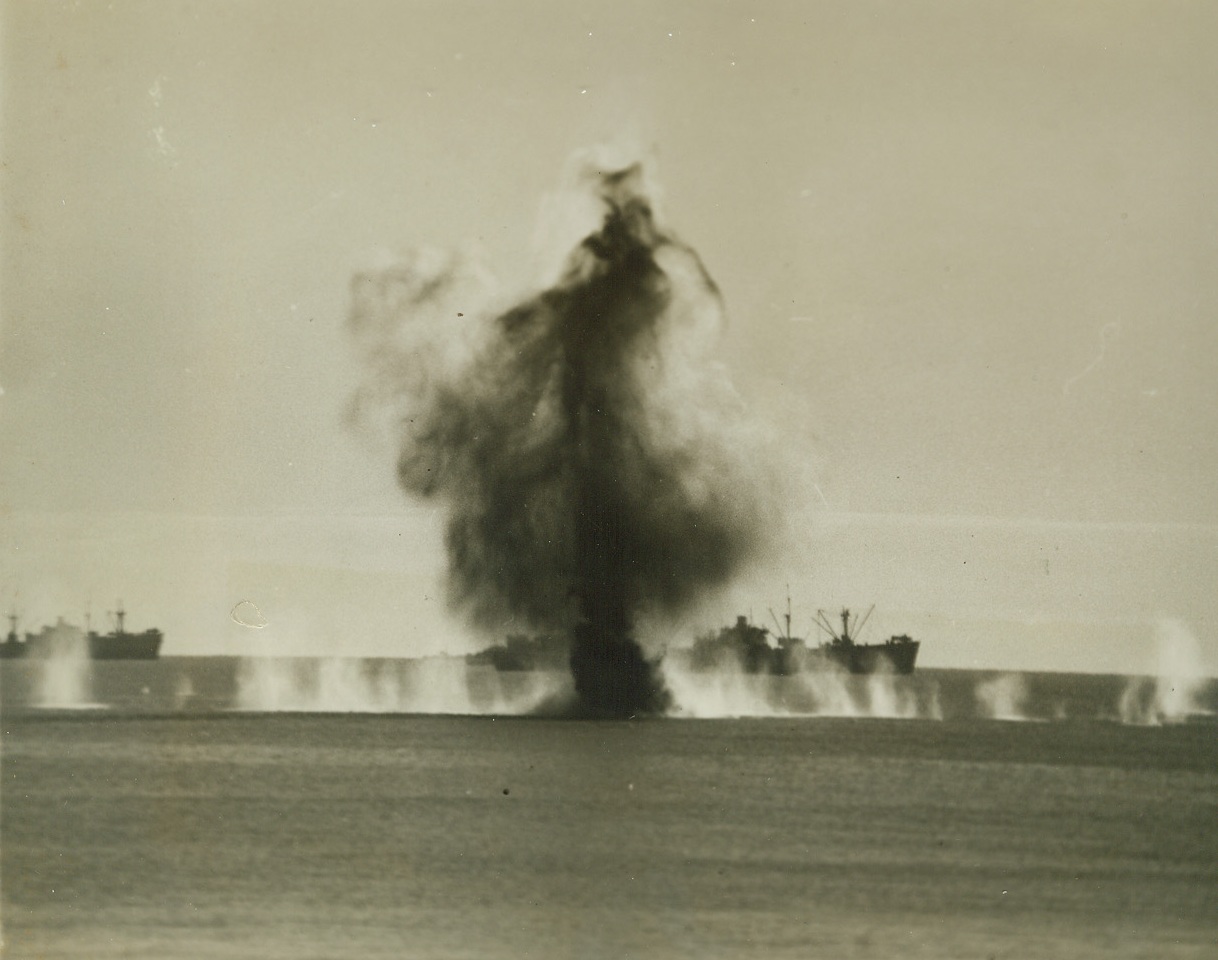
Nazi Shells Hit Only Water, 2/26/1944. NETTUNO, ITALY – A smoky spray of sea water rises high as German shells miss their mark. Attempting to batter Allied shipping off Nettuno from their positions along the coastline north of Anzio, the Germans kick up only wicked streams of water and American ships are seldom hit. Credit Line – WP - (Acme photo by Bert Brandt for the War Picture Pool);
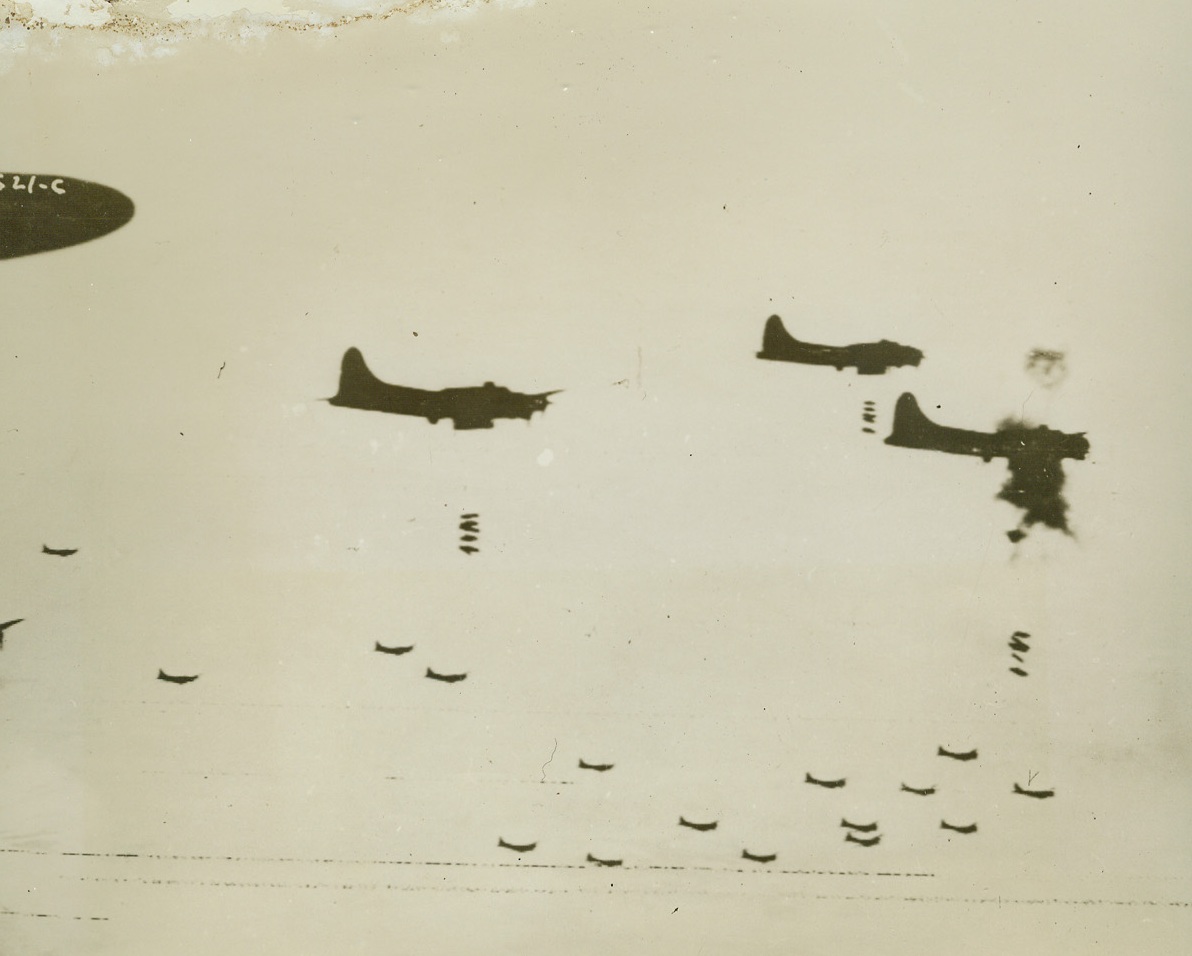
Yank Fliers Blast Leipzig, 2/25/1944. GERMANY – Striving to paralyze the great Nazi plane plants at Leipzig, in central Germany, 8th Army Air Force Flying Fortresses drop their deadly loads of bombs. Flak bursts near the lead plane, during the February 20th record raid, part of the round the clock aerial bombardment which still continues. Credit (U.S.A.A.F. Photo via Radiotelephoto from ACME);
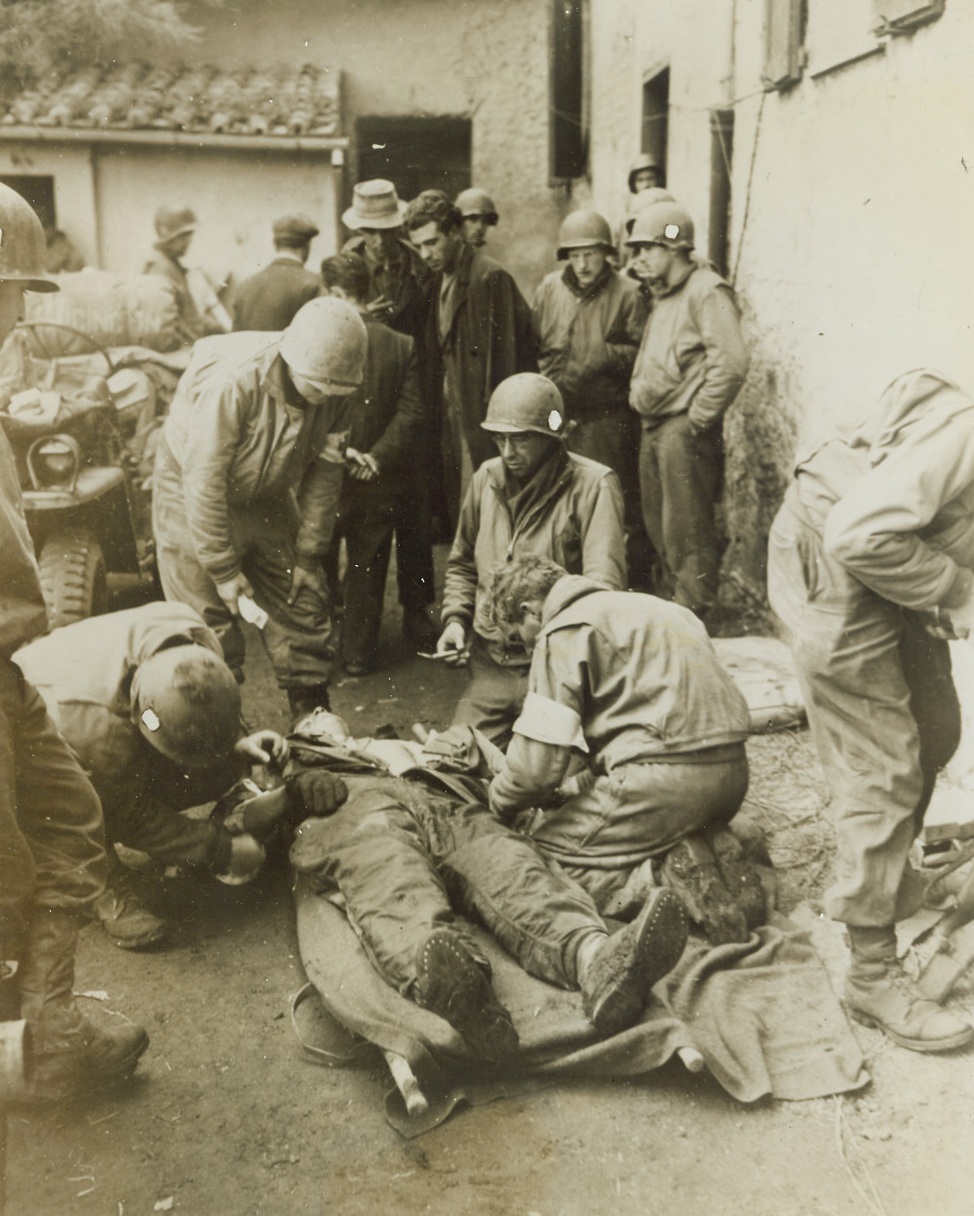
Worried Peasants, 2/11/1944. ACCRIELLA, ITALY -- Looking very much concerned, natives of Accriella stand by as first aid is given to a wounded Fifth Army warrior. The Yank had been injured in nearby patrol action just a few minutes before, as the Allies drove inland after their landing at Nettuno. Credit Line - WP- (ACME) Photo by Bert Brandt for the War Picture Pool;

Fortress' Last Flight #3, 2/17/1944. In its death dive, the forward half of the Flying Fortress, "Lady Liberty", heads for a flaming finale below, after being blasted in half by flak from a German anti-aircraft battery over Flushing, Holland. The ship had been headed on a bombing mission over Germany with other bombers of the U.S. 8th Army Air Force. Credit Line ( U.S. Army Air Force Photo from ACME);
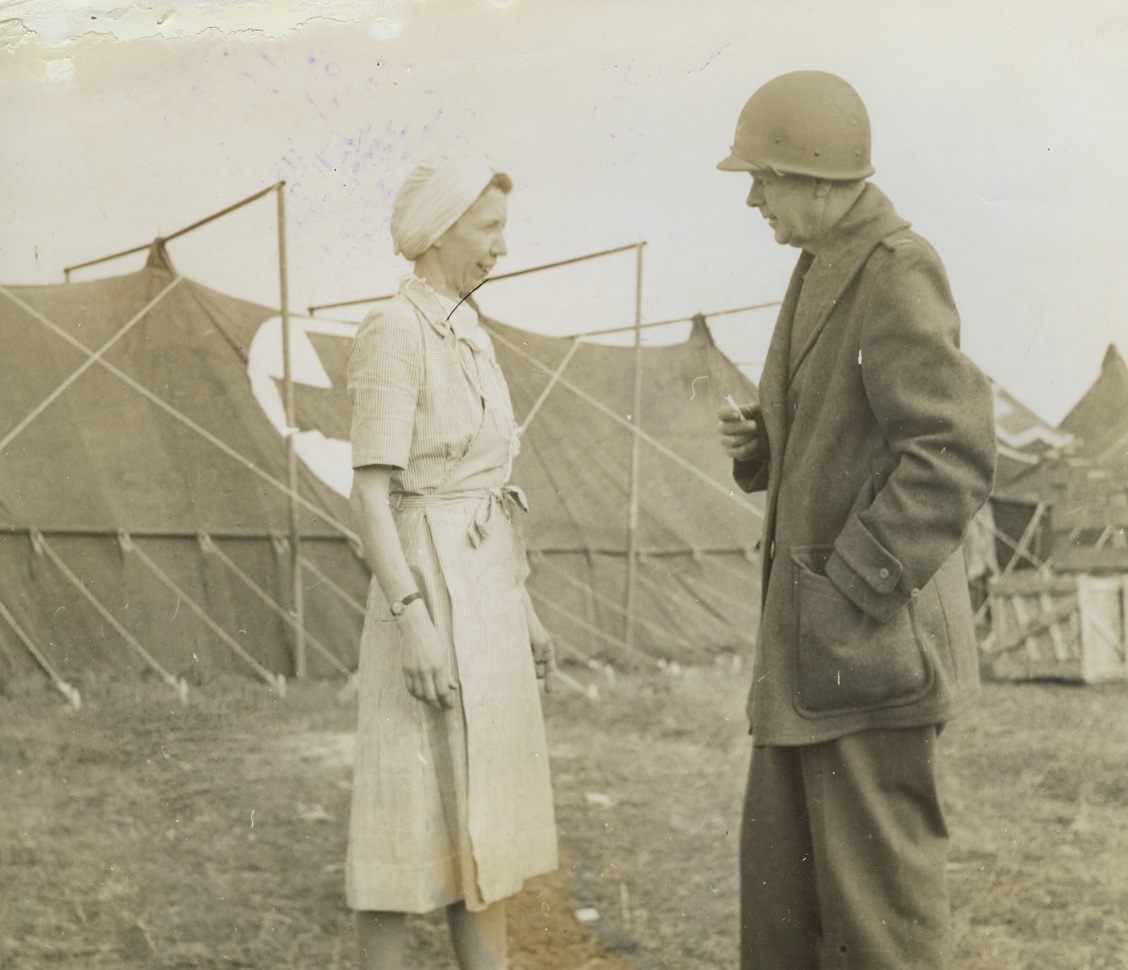
Two Fighters Take a Rest, 2/17/1944. ITALY -- Lt. Mary L. Roberts, of Dallas, Texas, chief nurse in the operating room of an American field hospital in the Nettuno-Anzio beachhead area chats with Col. Henry S. Blisse, of Chicago, Ill. They stand in front of the operation tent where suspension makes inside poles unnecessary. Credit Line (ACME);
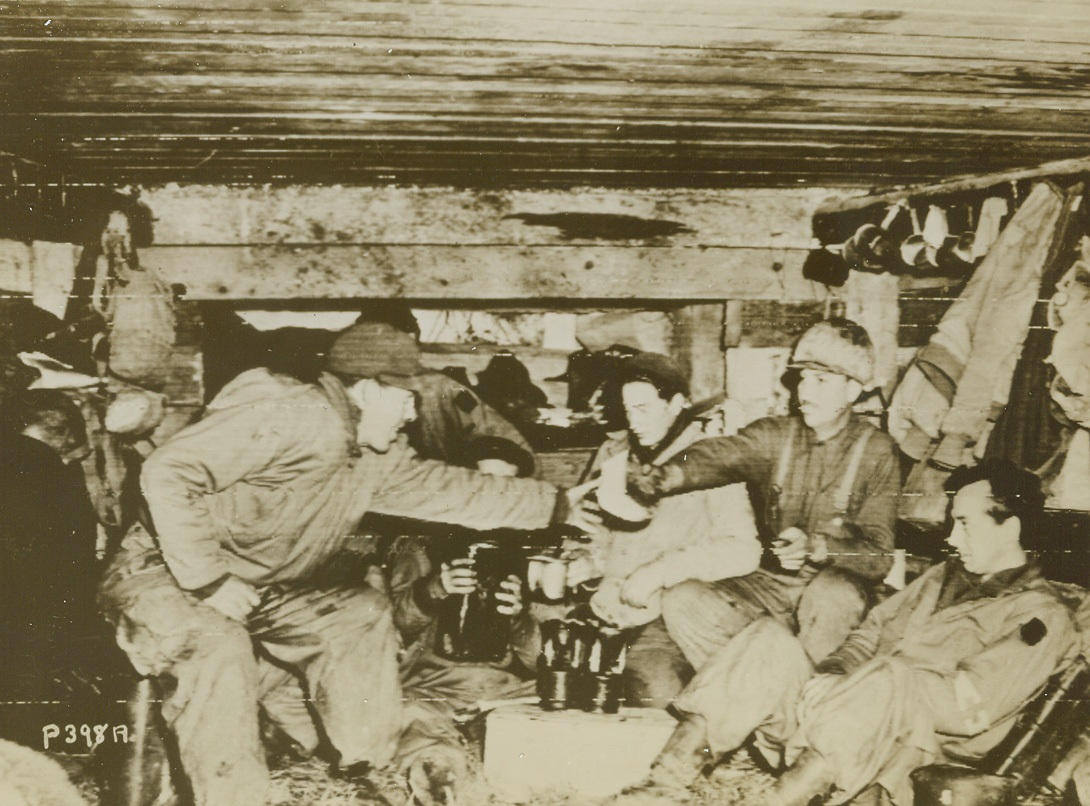
Doctors Live Ground Hog Lives in Italy, 2/12/1944. ITALY -- Point-blank gunfire finally dislodged the Germans from this underground dugout now occupied by American Army doctors in the Cassino sector. Well underground, the shelter is protected by layers of concrete, reinforced with steel girders. Credit (ACME Photo via U.S. Army Signal Corps Radiotelephoto);

After German Bomber Passed, 2/12/1944. ITALY -- Nazi anti-personnel bombs ripped that American Red Cross flag which is spread out behind the bomb crater on the grounds of an evacuation hospital near the Nettuno beachhead. Nurse Lt. Sally Hocutt, of Wendell, N.C. (left) and Pvt. Marshall Floyd, of Marshville, N.C., view the damage to the tent hospital, blasted by the enemy. Credit (ACME Photo via U.S. Army Signal Corps Radiotelephoto);
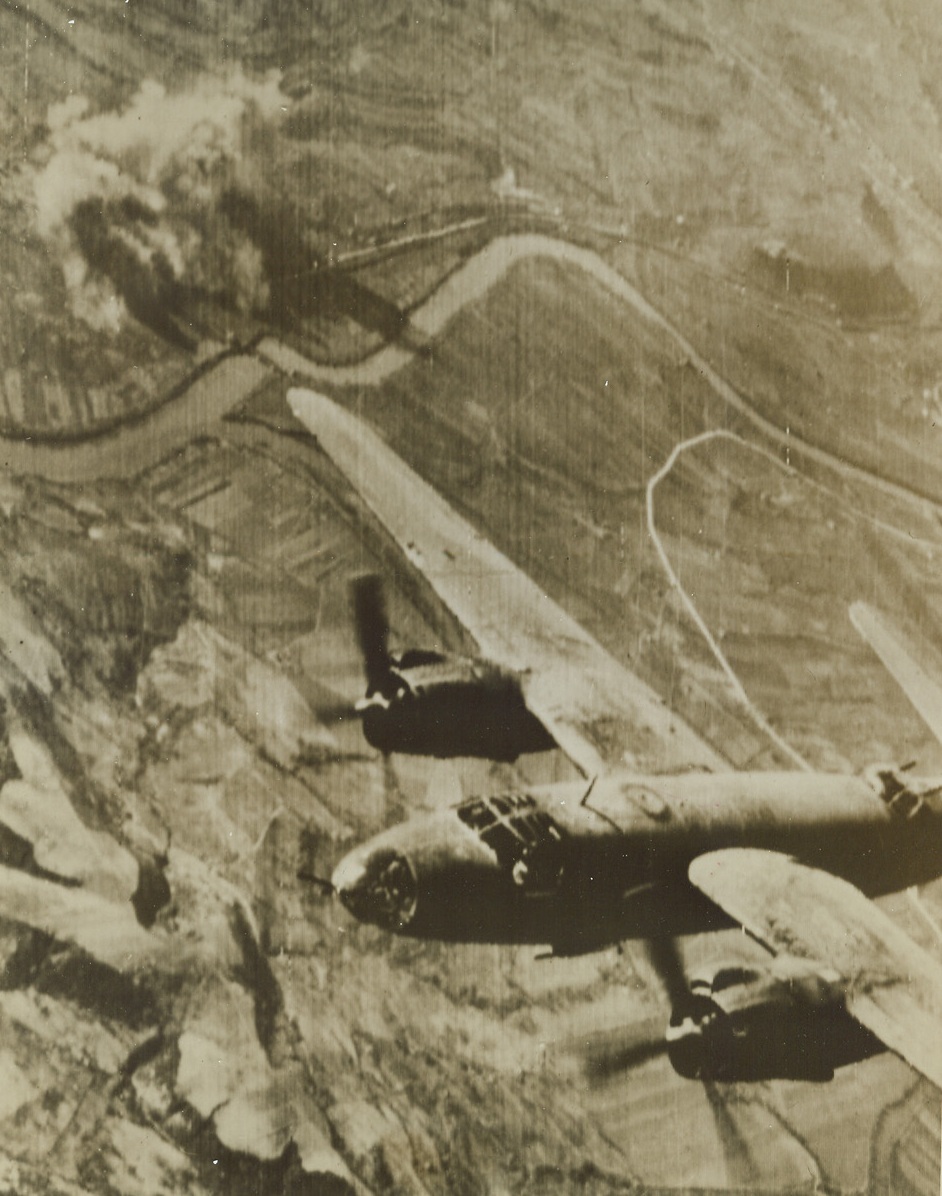
Nazi Communications Walloped From Air, 2/14/1944. ORTE, ITALY -- A B-26 Marauder wings over enemy marshalling yards at Orte, Italy, as smoke (background) marks an Allied bomb-hit on the enemy supply link to Nazis battling at Anzio. The return of fair flying weather has brought out Allied warplanes in a round-the-clock assault against the Germans in Italy. Credit (Signal Corps Radiotelephoto from ACME);
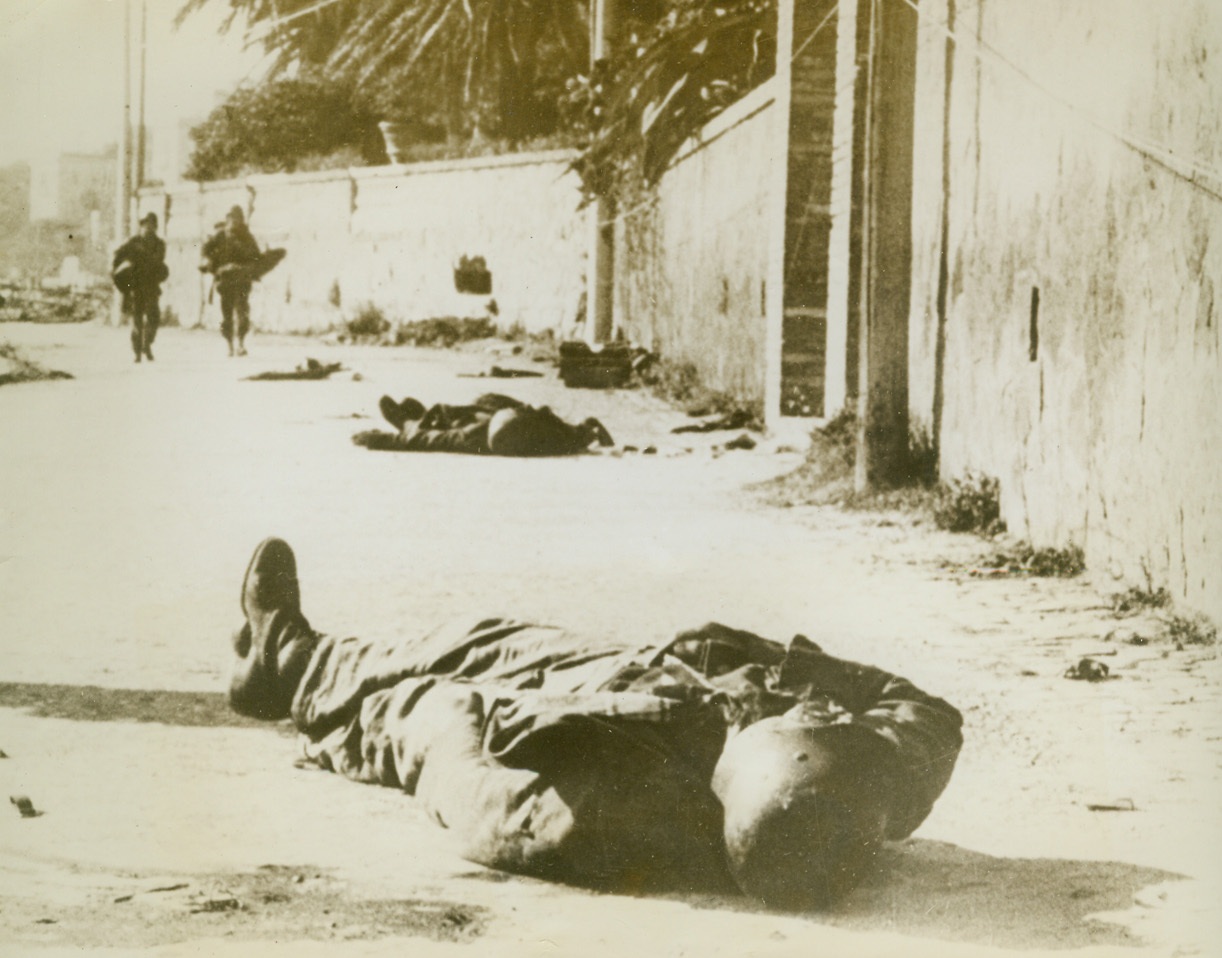
Death in the Streets, 2/9/1944. ANZIO, ITALY -- The bodies of dead German soldiers, members of the Nazi garrison at Anzio that attempted to defend the town when the Allies staged their surprise landing in January, lie in Anzio's streets. Troops of the Allied Fifth Army pass the fallen enemy warriors as they move up through the captured town. Credit Line - WP - (ACME);
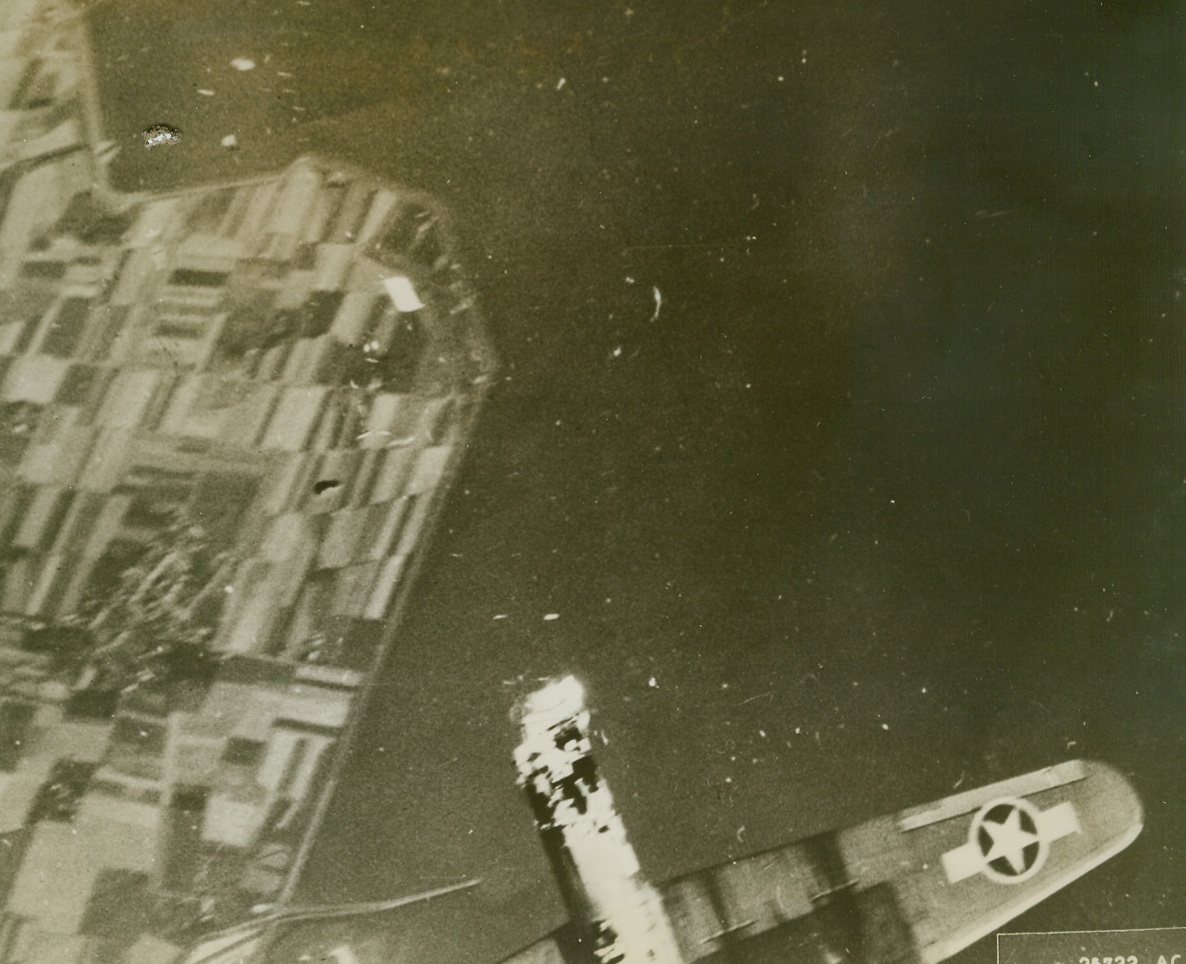
Fortress' Last Flight - # 2, 2/17/1944. Flak from a German anti-aircraft battery has just blasted the tail off the U.S. 8th Army Air Force Flying Fortress, "Lady Liberty", the forward section of the ship (right) continuing in flight over Flushing, Holland. Pieces of the tail section are scattered over almost entire photo. This unusual picture was snapped from another Fortress, accompanying the "Lady Liberty" on her last flight--a bombing mission over Germany. A few moments after the photo was taken, the wrecked bomber started her final dive for the earth. Credit Line (U.S. Army Air Forces Photo from ACME);

Americans Bomb Cassino Monastery, 2/17/1944. This photo, flashed to the United States by Army Radiotelephoto, shows bombs (right circle) falling toward the Cassino Monastery (left circle), which the Germans have been using as a fortified defense point against advancing Allied 5th Army Forces. Allies have warned Italian civilians living in the building to evacuate the Abbey, by leaflets dropped from exploding artillery shells. Credit Line (U.S. Army Air Force Photo via Radiotelephoto from ACME);

No "Double-Cross" For the Mussolini, 2/11/1944. ITALY -- These Italian refugees are permitted to cross the Mussolini canal, but only in one direction -- toward Allied territory. American soldiers help the natives across the small waterway where retreating Germans blasted a concrete bridge. Credit (Acme Photo by Charles Seawood, War Pool Correspondent);
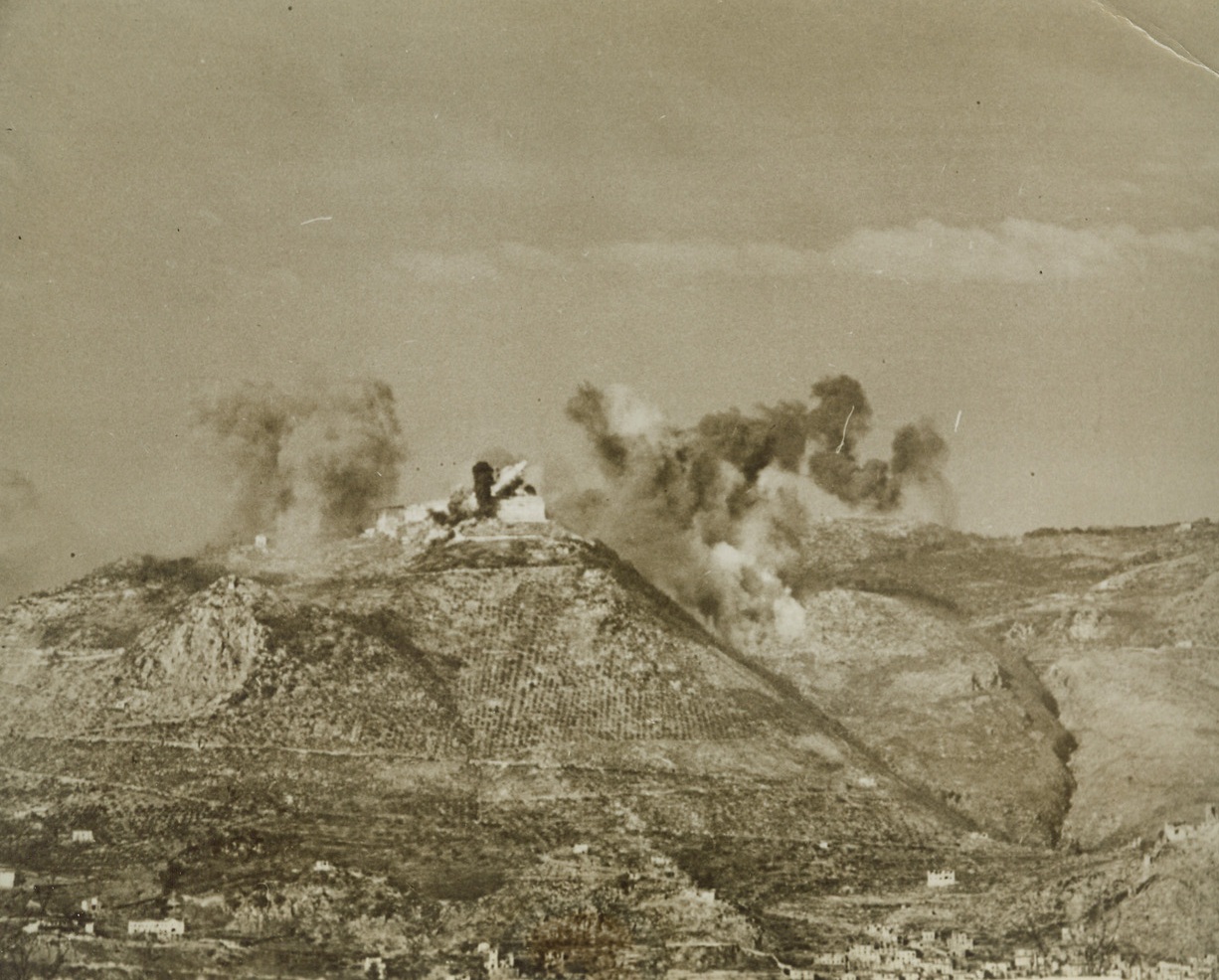
We Fire Cassino Abbey, 2/25/1944. ITALY – Long immune from Allied guns, the Benedictine monastery is enveloped by smoke and flame as waves of Allied bombers fire the retreat, used by the Nazis as a fortress, on the tip of Mount Cassino. The Allies trained their guns away from the abbey until it was obviously necessary, from a military point of view, to shatter the buildings used by the Germans to great advantage over our fighters in the valley below.Credit: (ACME);
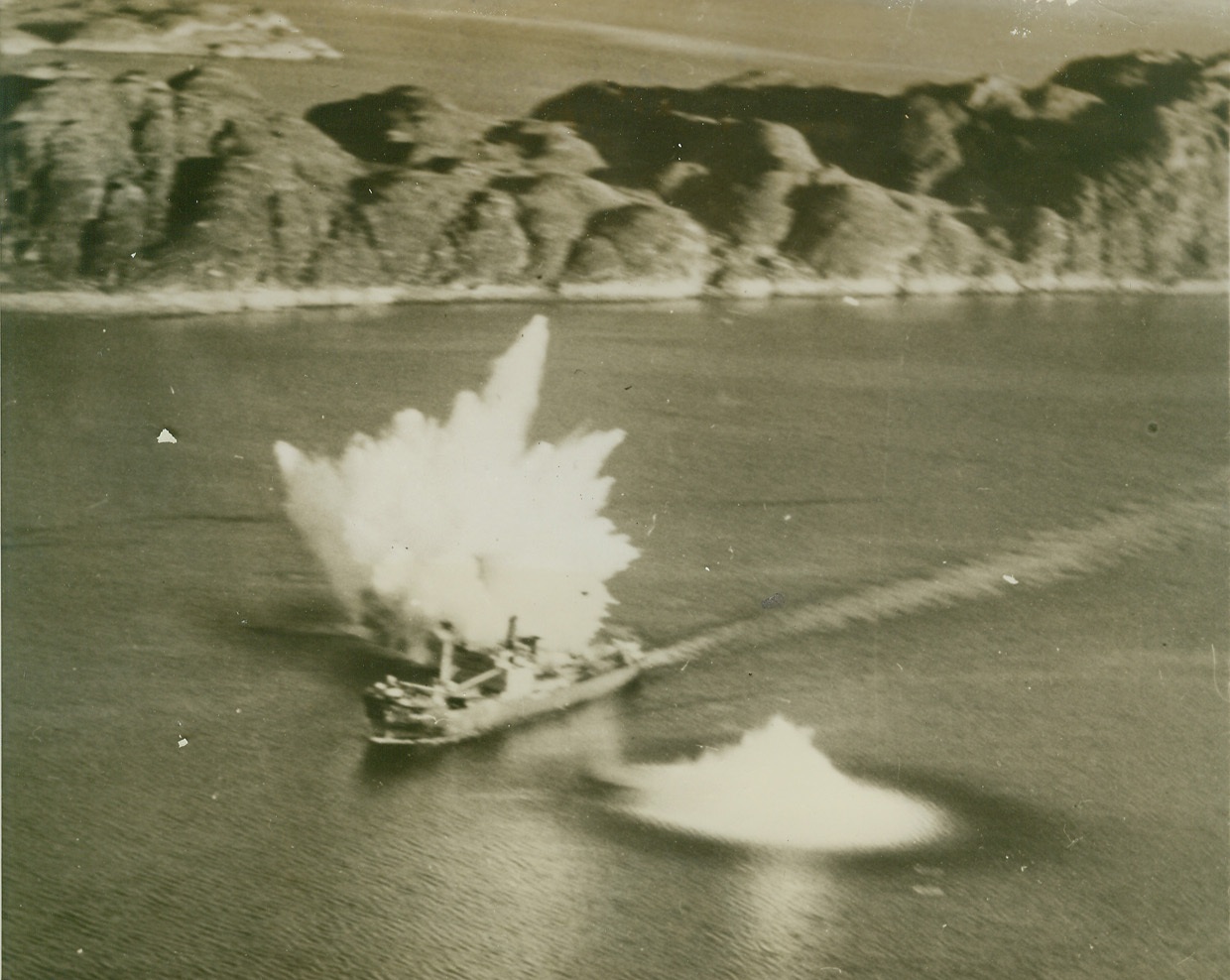
“Ghost” Carrier Packs Real Bombs, 2/9/1944. Two bombs from planes of the aircraft carrier USS Ranger, straddle the German merchantman Saar, during a raid by the American warship on shipping off Bodo, Norway, last October. When last seen, the new type German ship (above) was down by the head. During the raid, which occurred six months after Hitler had decorated one of his U-boat commanders for “sinking” the Ranger, 40,000 tons of enemy shipping were sunk or damaged.Credit Line (U.S. Navy Official Photo from ACME);
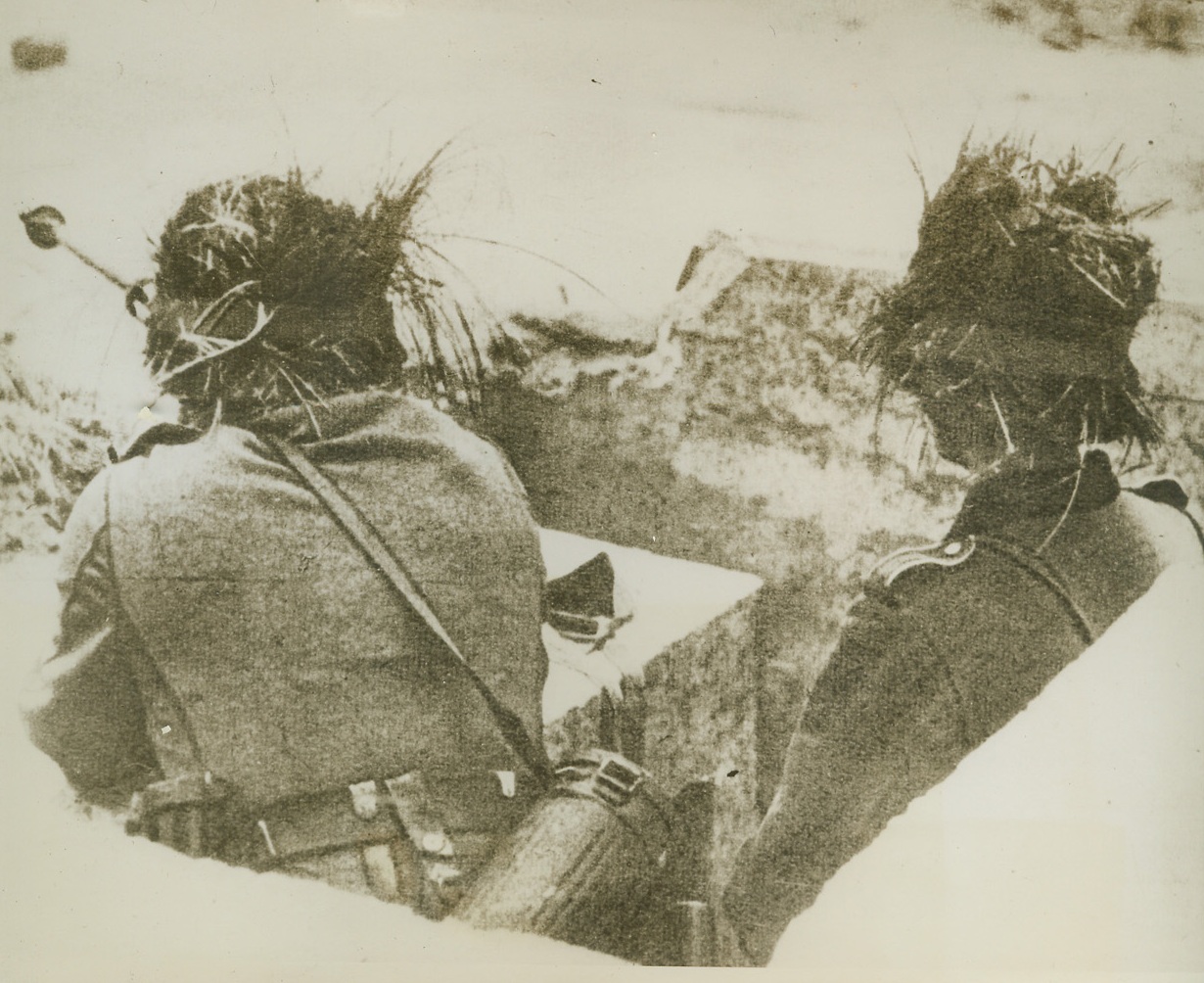
Candidates for Invasion Jitters, 2/10/1944. This photo, just received from a neutral source, shows camouflaged German observers on duty along the “Atlantic Wall”, Nazi defenses along the Invasion Coast of the English Channel. Any day, now, these boys will be in the thick of it when they are confronted by the Allied Invasion Armies under Gen. Dwight D. Eisenhower, Supreme Allied Commander-in-Chief. Credit Line (ACME);
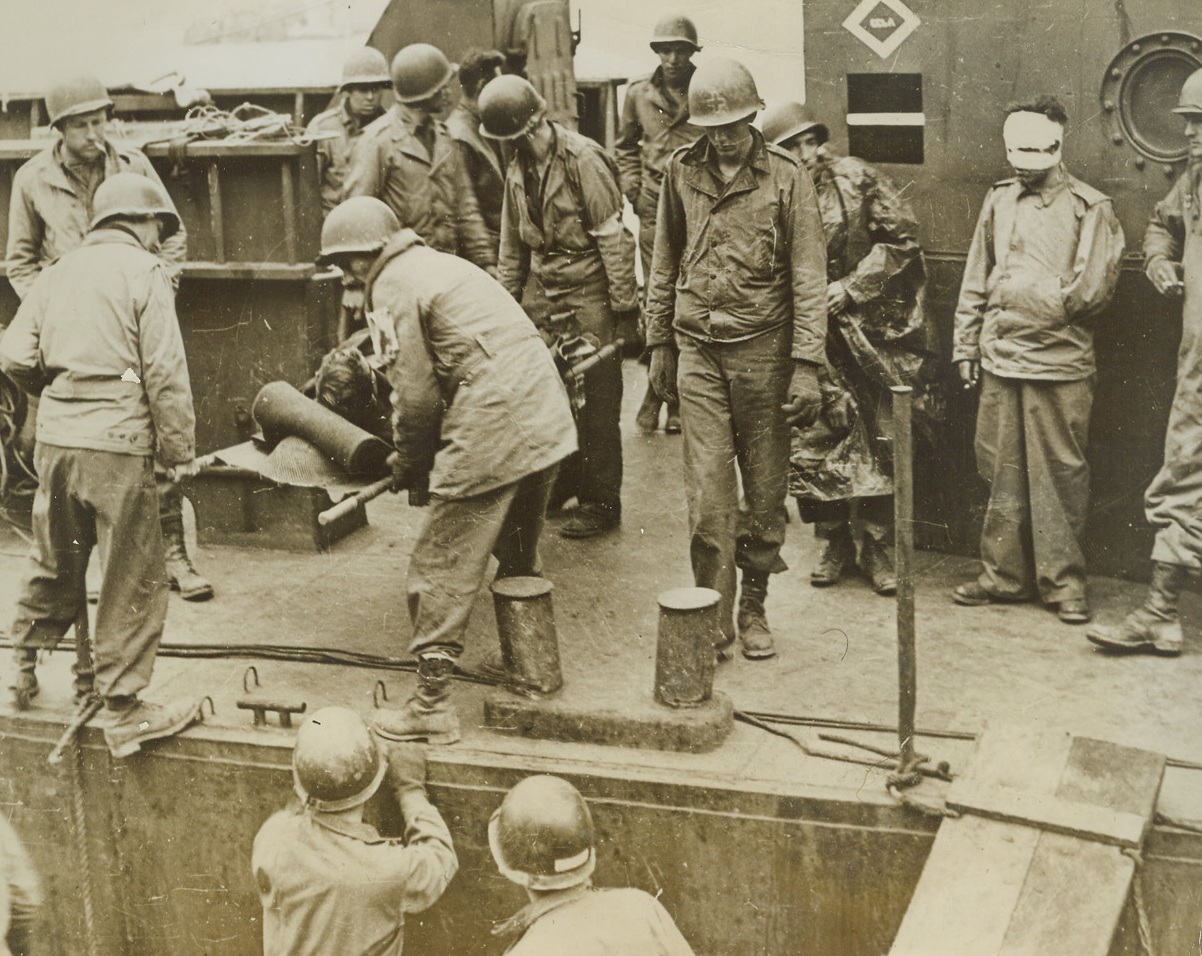
Battered at Beachhead, 2/11/1944. ITALY – Injured fighters who are able to walk, watch their more seriously wounded comrades being loaded aboard a warship off the Anzio-Nettuno beachhead. The shore may be seen, dimly, in the background.Credit Line (ACME);
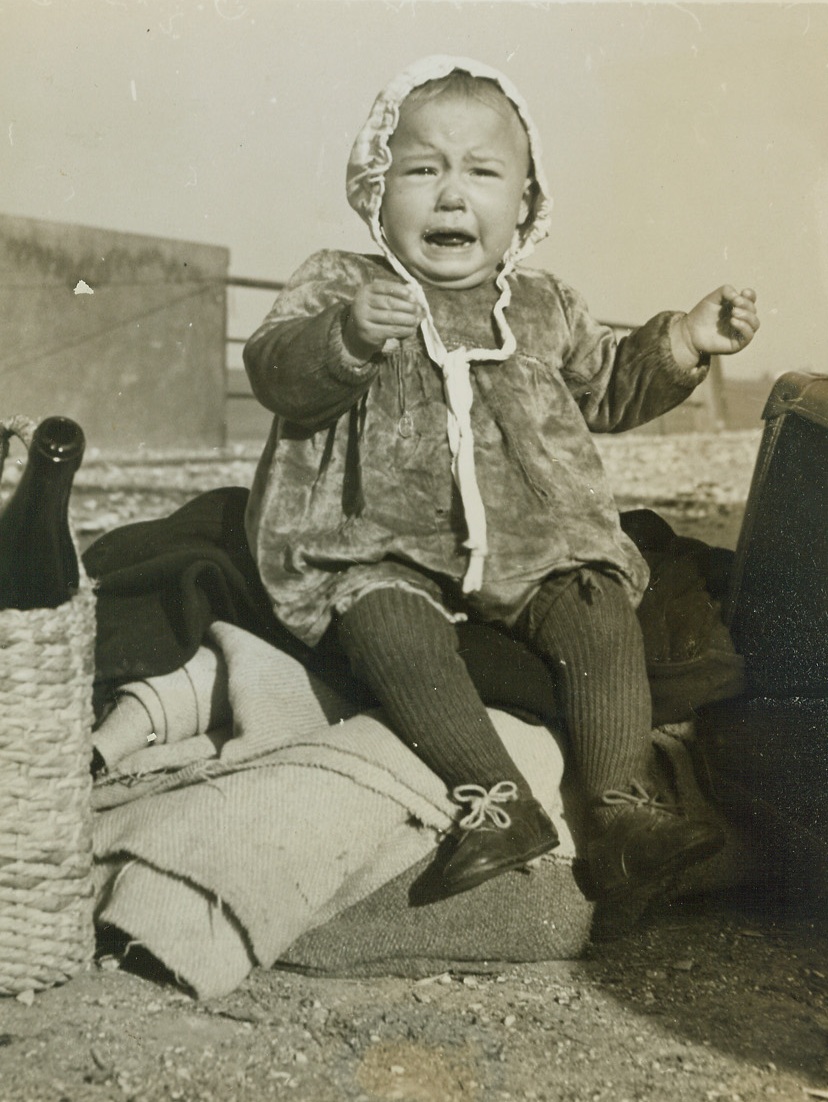
“Hell Hath no Fury Like a Woman Scorned”, 2/11/1944. ITALY – Loudly bewailing temporary desertion by her mother, this little Italian miss is too young to seek consolation from that interesting looking basket at the left. She and her mother had a one-way ticket to the American lines of the Cassino front. The Yanks help them to Allied territory, but they are forbidden a return visit to Nazi-land. That is, if anyone wants to return. Credit (ACME Photo by Charles Seawood, War Pool Correspondent);
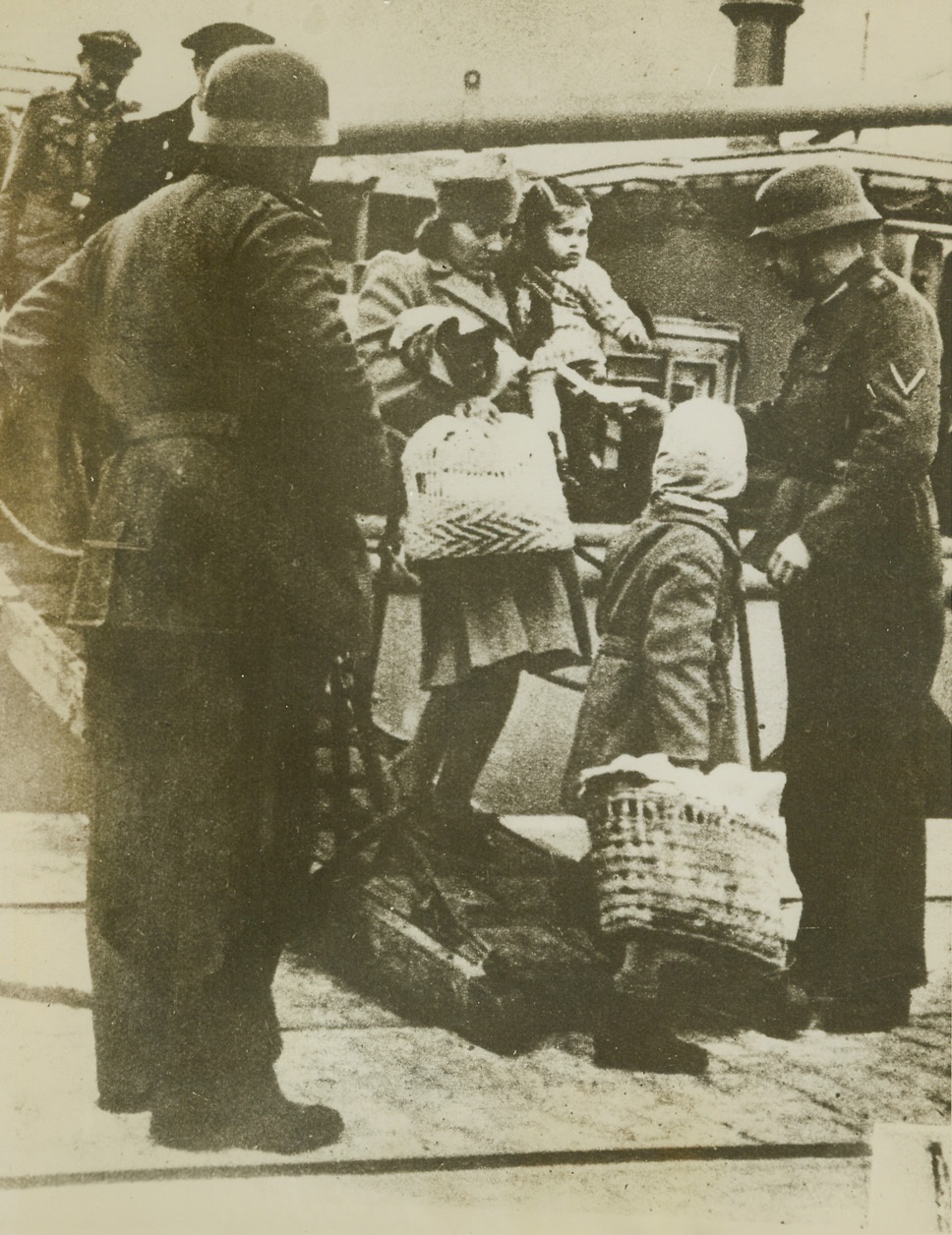
First Photos of Heligoland, 2/10/1944. This photo, just received from a neutral source, is one of the first ever published of the modern defenses of Germany’s Gibralter—the island of Heligoland, in the North Sea. Even in wartime, say the Germans, tourists are still permitted to visit Heligoland, but a special permit must be obtained. Here, a woman and two children land on the quay, where their pass is inspected before they are allowed to go inland.;
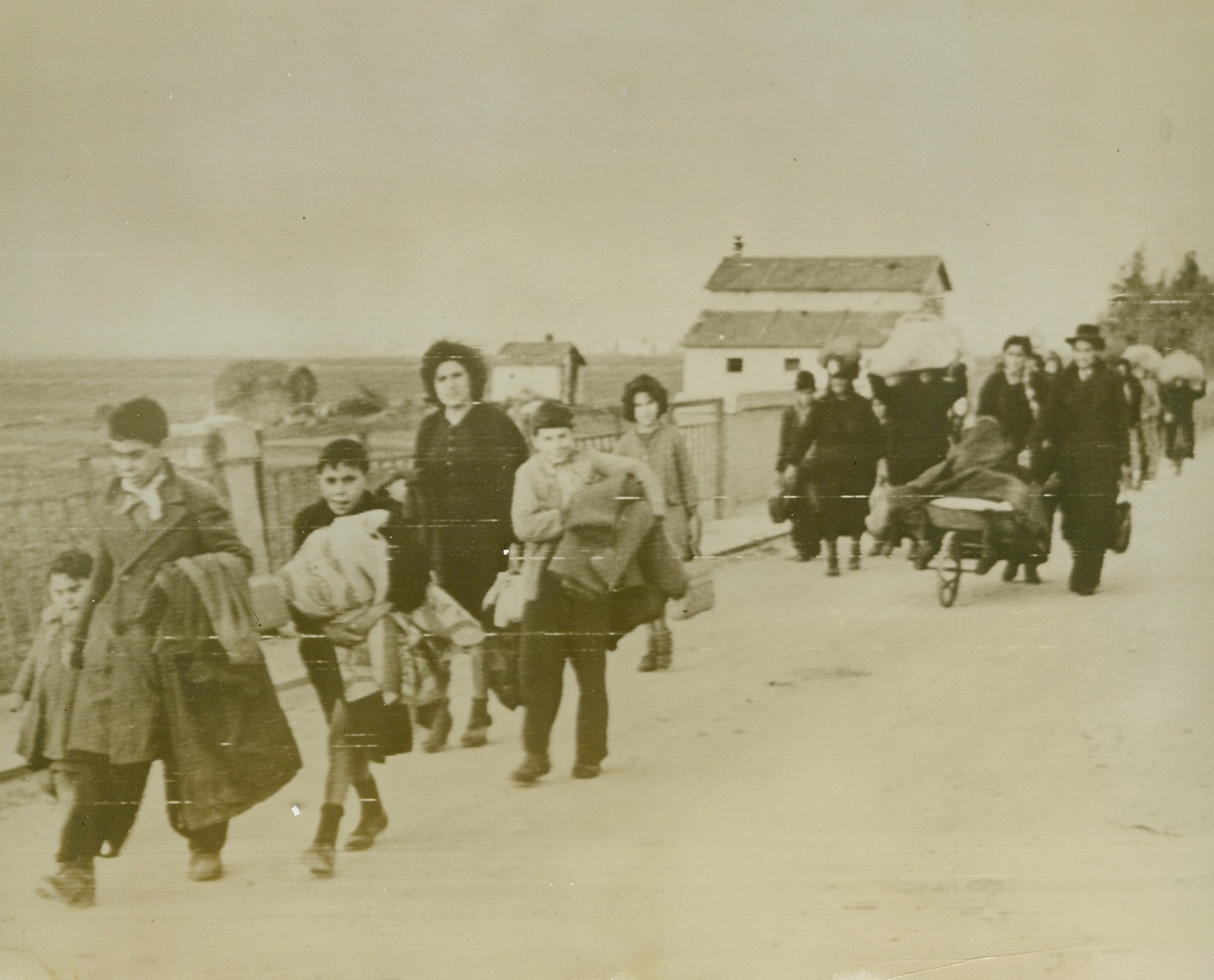
Flee from Former Ally, 2/7/1944. Anzio, Italy – Italian refugees of all ages escape with all their personal effects to Anzio from the German-held territory near Cisterno, where the Fifth Army is battling fiercely for control of the area.Credit (Official Signal Corps Radiotelephoto from ACME);

They Follow Their Men, 2/9/1944. ITALY – Unafraid of war and sudden death, these Goum women follow their menfolk wherever they may go in their fight on the side of the Allies. This group of Algerian tribesmen and their women poses at the Goum bivouac near Caserta. The ram is a mascot.Credit Line (ACME);
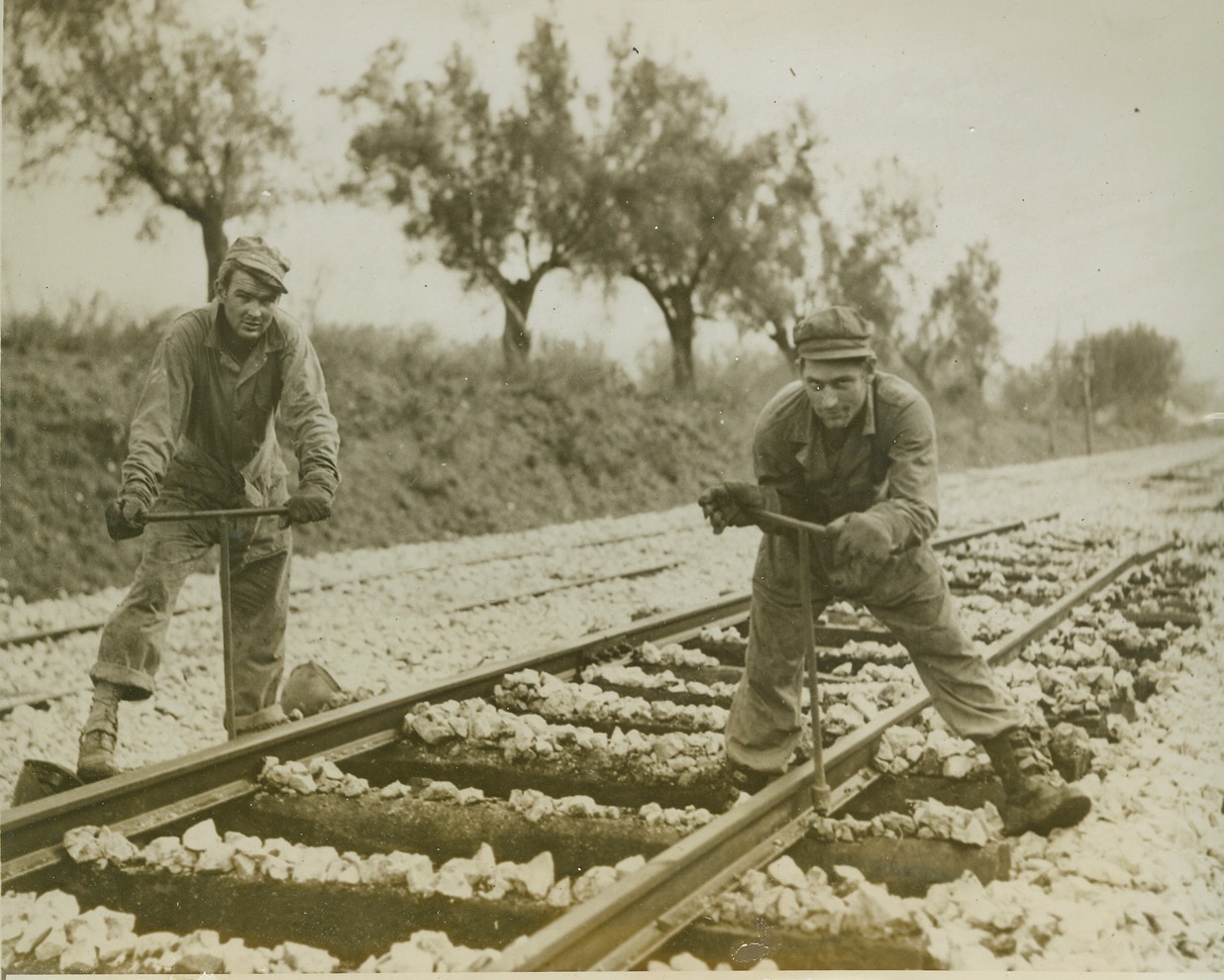
“I’m Working on the Railroad”, 2/9/1944. SOUTHERN ITALY – Corp. Tech. Robert B. Force, of Springfield, Ill., left, and Sergt. Tech. Fritz Herzog, of Shidmon, Tex., repair the damage done to Italian railroads by the retreating Germans, and by Allied shelling and bombing before the area was captured.Credit (ACME);
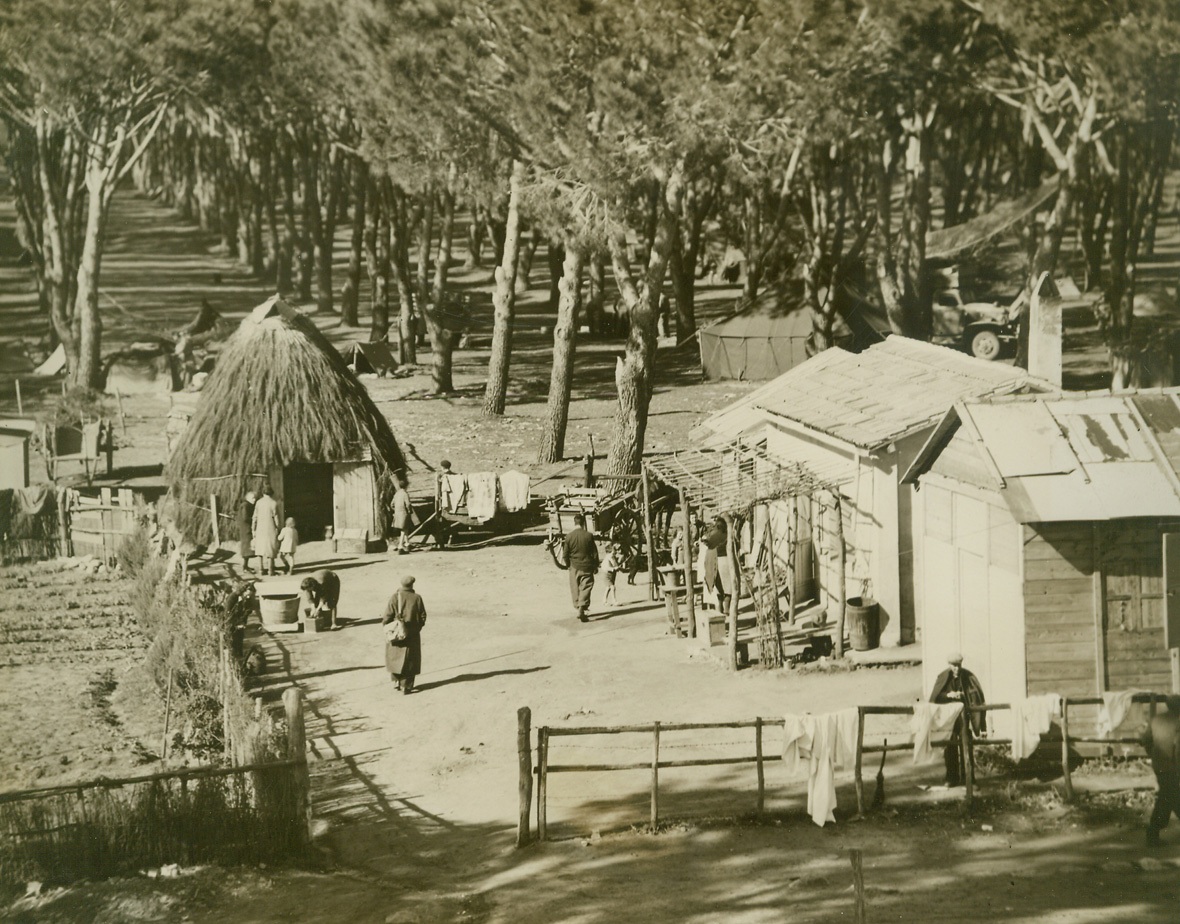
10,000 Homeless on a Single Farm, 2/24/1944. ITALY – The 14,000-acre farm of Prince Stephano Borghese is proving a welcome, if highly uncomfortable haven for approximately 10,000 Italian civilians who where ordered from Anzio and Nettuno by Hitler, last November 1. Planning to use the beautiful seaside towns as rest centers for German troops, Hitler drove out the natives who were allowed only the possessions they could carry. Prince Borghese, head of an old and wealth Italian family, opened his nearby farm to the refugees who now live, for the most part, in straw huts of their own making. The Allies have already made violent alterations in Hitler’s plans for an Anzio-Nettuno rest center, and as soon as possible the civilians will return to their homes. In the meantime, Acme War Pool Photographer Bert Brandt shows you how they live. New York BureauMore closely resembling the South Pacific than “civilized” Europe is a group of the makeshift community dwellings. Many of the women who scrub the family wash in crude buckets were once mistresses of their own beautiful homes. Credit (Acme Photo by War Pool correspondent, Bert Brandt);
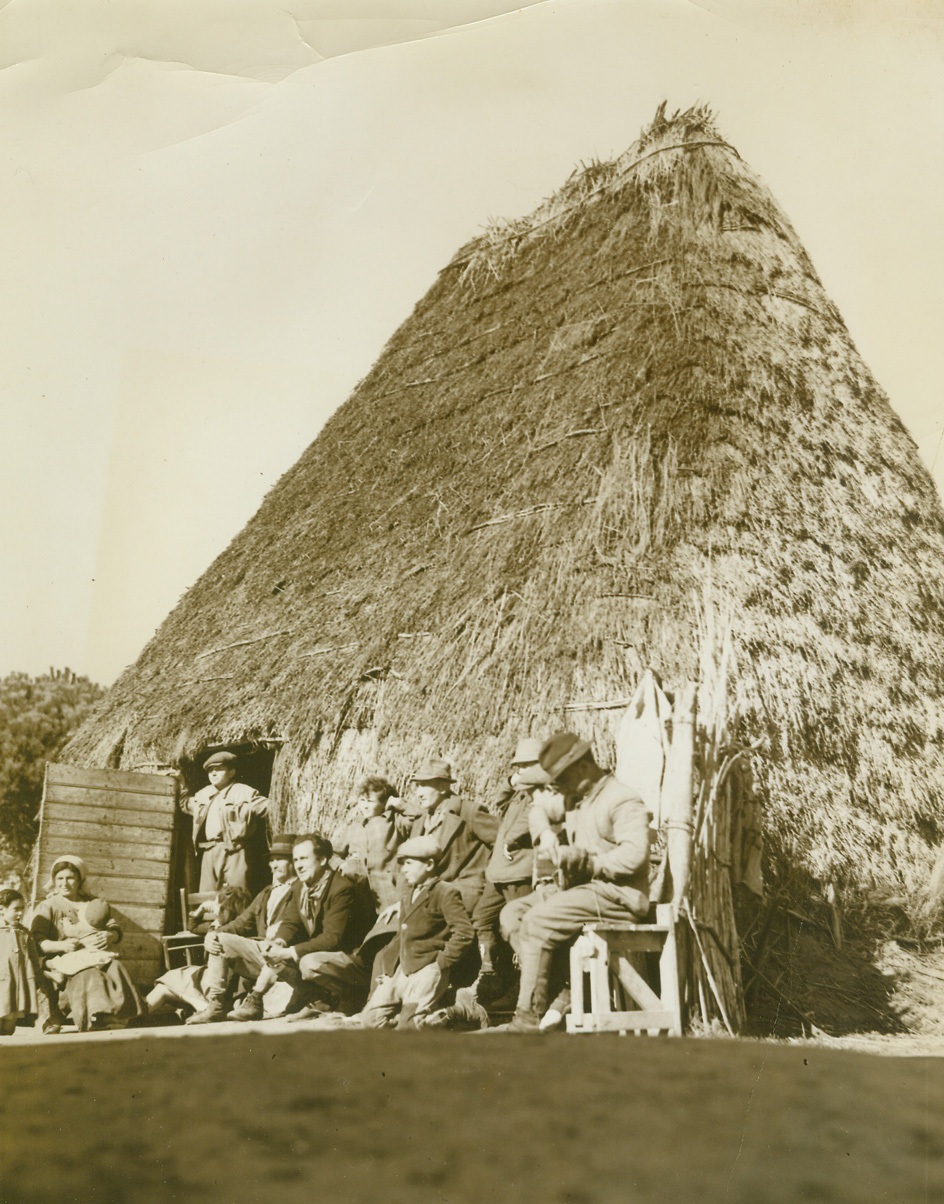
10,000 Homeless on a Single Farm, 2/24/1944. ITALY – The 14,000-acre farm of Prince Stephano Borghese is proving a welcome, if highly uncomfortable haven for approximately 10,000 Italian civilians who where ordered from Anzio and Nettuno by Hitler, last November 1. Planning to use the beautiful seaside towns as rest centers for German troops, Hitler drove out the natives who were allowed only the possessions they could carry. Prince Borghese, head of an old and wealth Italian family, opened his nearby farm to the refugees who now live, for the most part, in straw huts of their own making. The Allies have already made violent alterations in Hitler’s plans for an Anzio-Nettuno rest center, and as soon as possible the civilians will return to their homes. In the meantime, Acme War Pool Photographer Bert Brandt shows you how they live.New York BureauTheir amusements and means of livelihoods snatched away, sitting in the sun is one of the favorite pastimes of Campana refugees. Shown here are some of the members of three families who inhabit this hovel. Credit Line (Acme Photo by Bert Brandt, War Pool Correspondent);
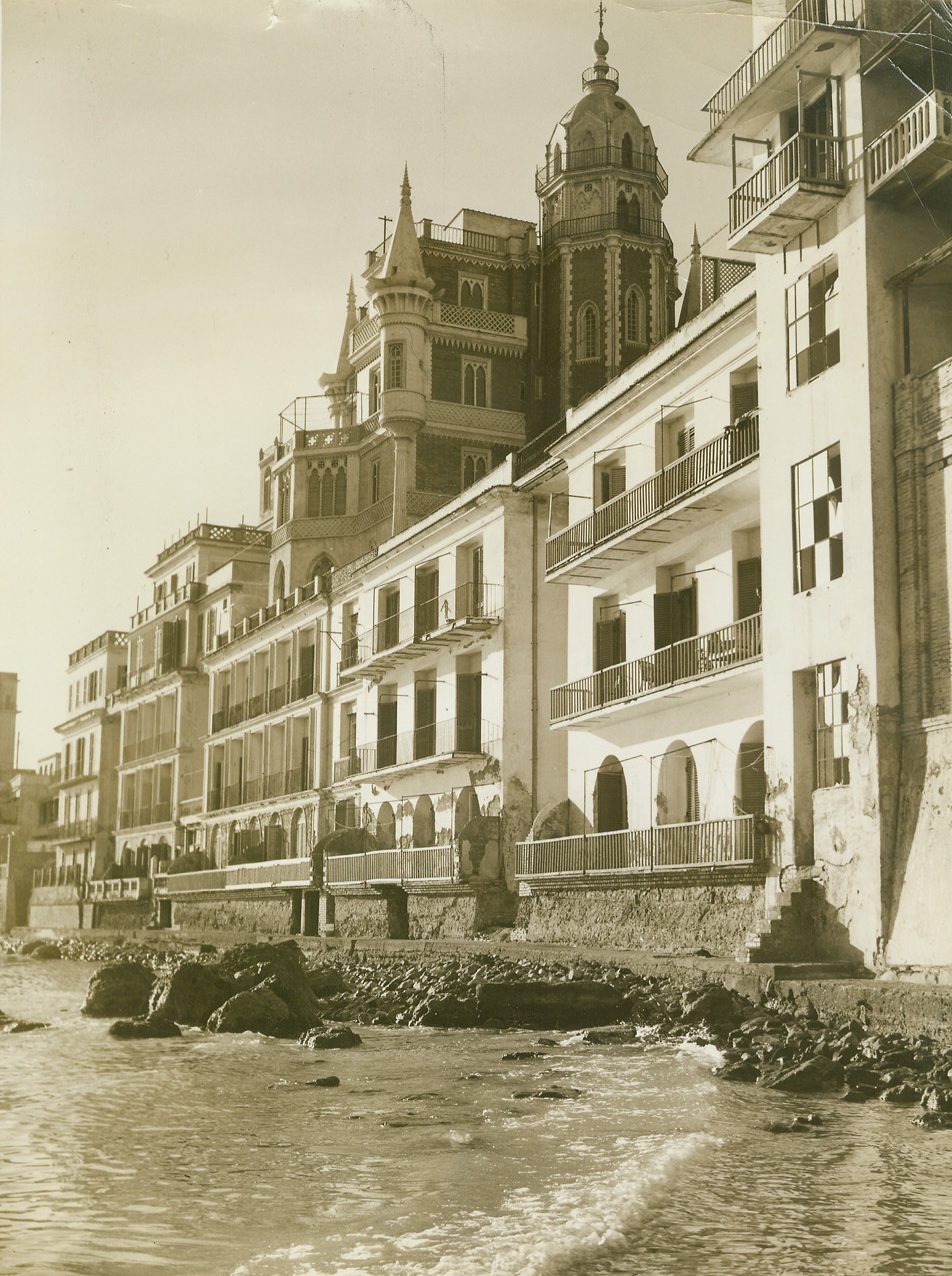
10,000 Homeless on a Single Farm, 2/24/1944. ITALY – The 14,000-acre farm of Prince Stephano Borghese is proving a welcome, if highly uncomfortable haven for approximately 10,000 Italian civilians who where ordered from Anzio and Nettuno by Hitler, last November 1. Planning to use the beautiful seaside towns as rest centers for German troops, Hitler drove out the natives who were allowed only the possessions they could carry. Prince Borghese, head of an old and wealth Italian family, opened his nearby farm to the refugees who now live, for the most part, in straw huts of their own making. The Allies have already made violent alterations in Hitler’s plans for an Anzio-Nettuno rest center, and as soon as possible the civilians will return to their homes. In the meantime, Acme War Pool Photographer Bert Brandt shows you how they live.New York BureauSome of the beautiful homes which the townspeople were ordered to evacuate look out over the water, lining the beach between Anzio and Nettuno. Now, the onetime residents of these houses are jammed into thatched huts that have no conveniences.Credit (Acme Photo by Bert Brandt, War Pool Photographer);
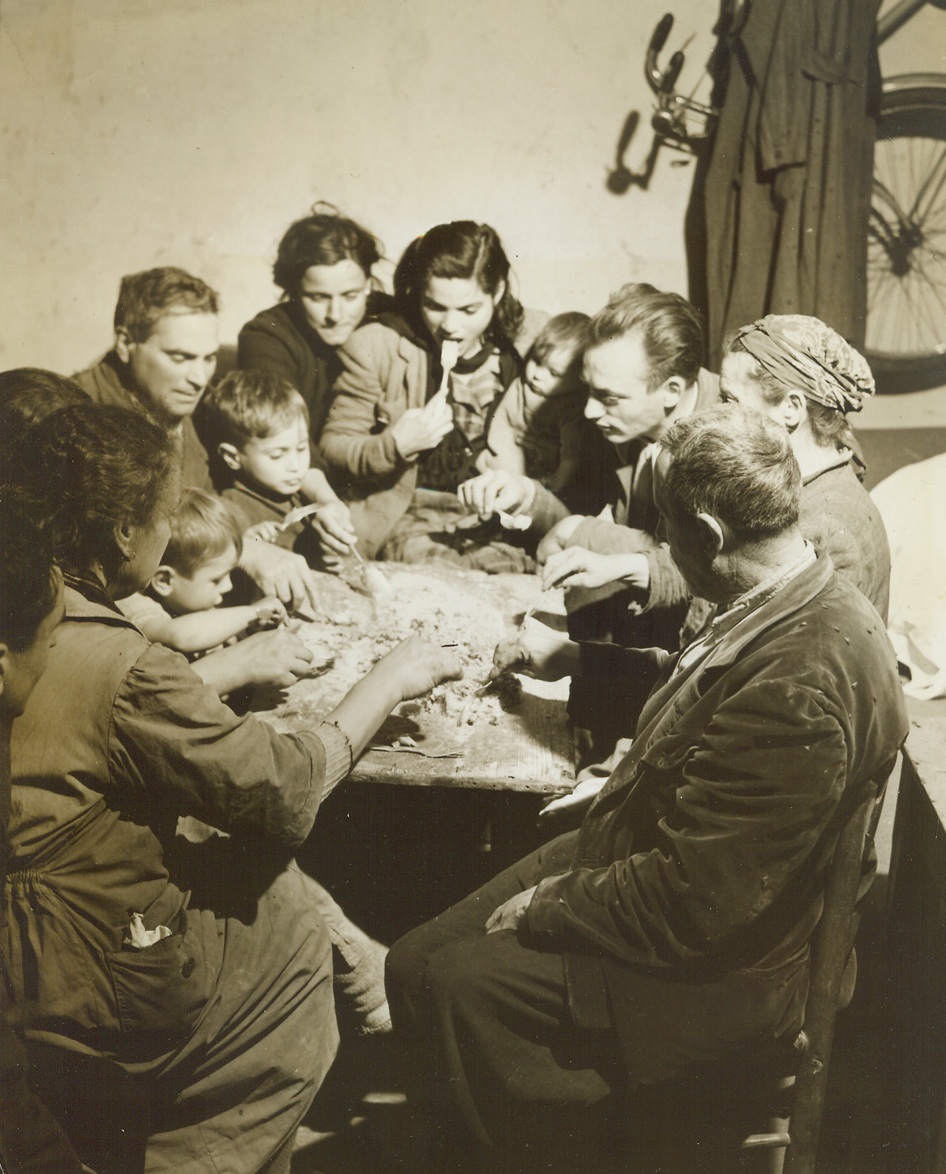
10,000 Homeless on a Single Farm, 2/24/1944. ITALY – The 14,000-acre farm of Prince Stephano Borghese is proving a welcome, if highly uncomfortable haven for approximately 10,000 Italian civilians who where ordered from Anzio and Nettuno by Hitler, last November 1. Planning to use the beautiful seaside towns as rest centers for German troops, Hitler drove out the natives who were allowed only the possessions they could carry. Prince Borghese, head of an old and wealth Italian family, opened his nearby farm to the refugees who now live, for the most part, in straw huts of their own making. The Allies have already made violent alterations in Hitler’s plans for an Anzio-Nettuno rest center, and as soon as possible the civilians will return to their homes. In the meantime, Acme War Pool Photographer Bert Brandt shows you how they live.New York BureauThree families sit down to their noon meal a mound of corn-meal Polenta which is spread on the center of the table, due to a shortage of tableware. The bicycle of one refugee hangs on the wall in a corner. Credit (Acme Photo by Bert Brandt, War Pool Correspondent);
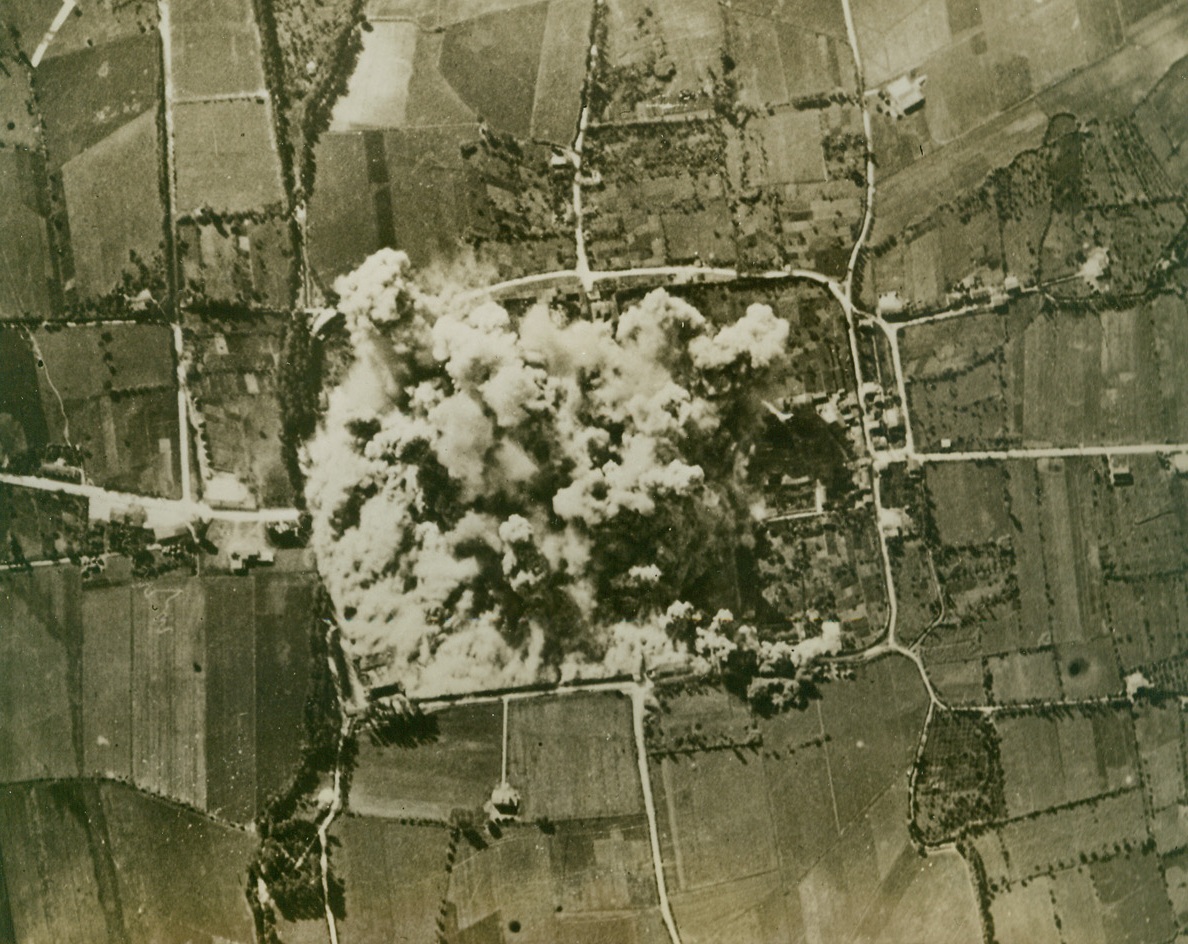
Sample of American Precision Bombing (2), 2/16/1944. ALIFE, ITALY – The target area clearly marked by roads that wind about Alife, Yank bombs raise clouds of smoke as they fall in a tight cluster on their objective. B-26 Marauders of the U.S.A.A.F. gave this impressive showing of their adeptness at precision bombing in the raid of October 13, 1943, before Alife fell to the Allies. Credit (U.S. Army Air Forces Photo from Acme);
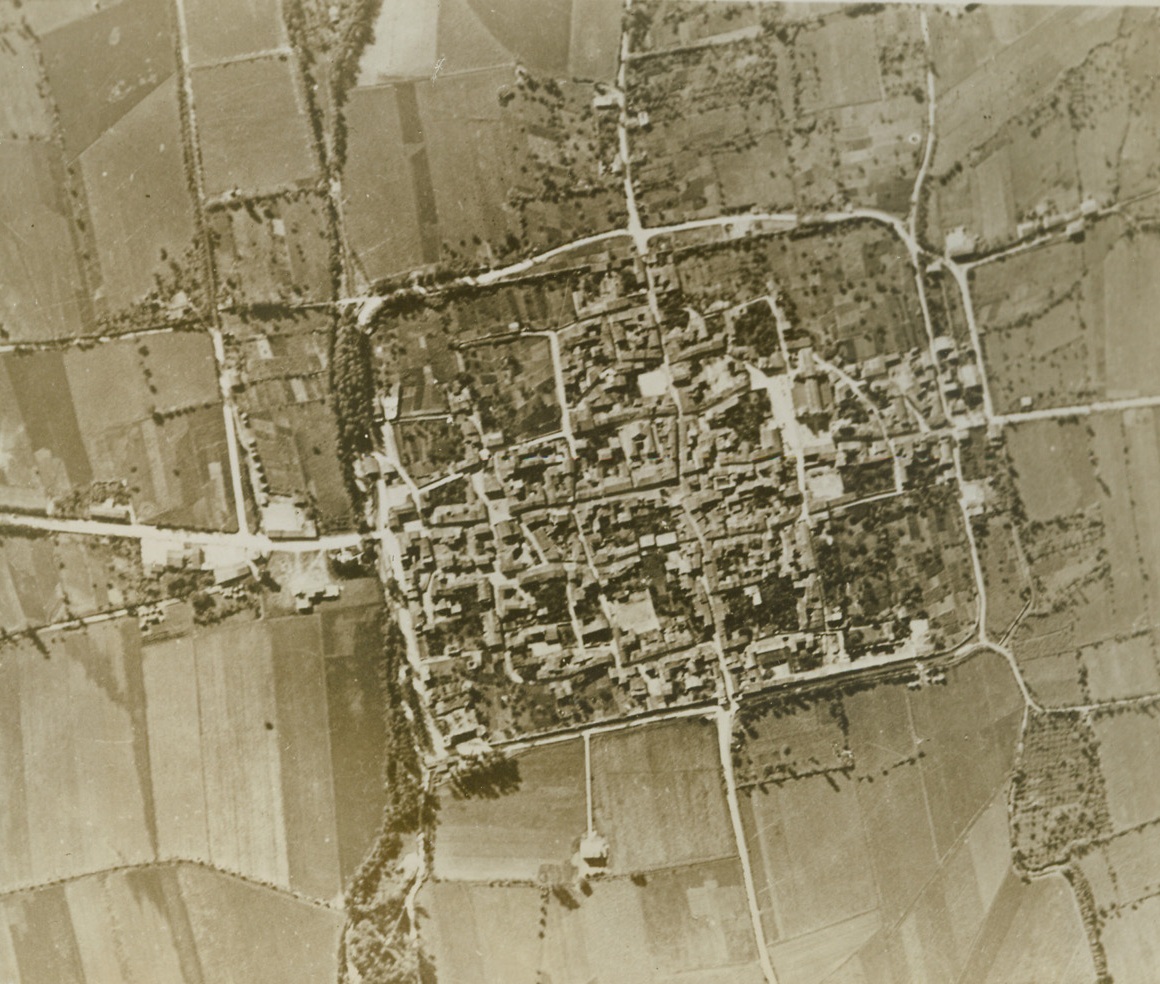
Sample of American Precision Bombing (1), 2/16/1944. ALIFE, ITALY – Now in American hands, the town of Alife was a target for B-26 Marauder medium bombers of the U.S.A.A.F. before its capture. In this photo, one of a pair illustrating the perfection of Yank precision bombing, the town is shown before the Marauder mission of October 13, 1943, which wrecked Alife’s communications center. Roads winding around the town clearly mark the target.Credit Line (U.S. Army Air Forces Photo – Acme);
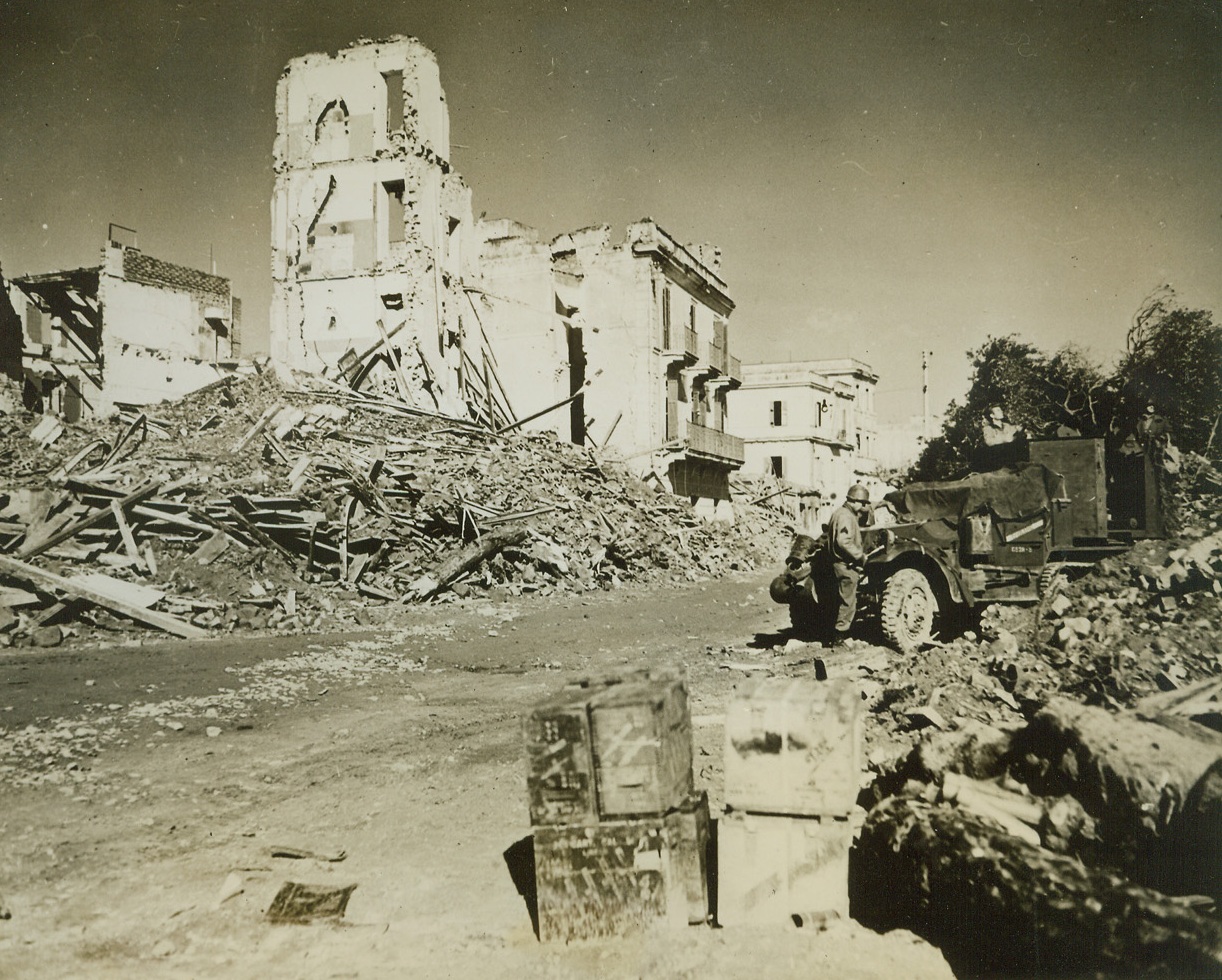
After War Passed Through Anzio, 2/17/1944. ANZIO, ITALY – These shattered buildings at Anzio, through which men and supplies are streaming toward the Allied 5th Army front below Rome, bear the grim mark of battle. At right, an American half-track protects the road from German air attacks. Today, the Allies are fighting bitterly to stem Nazi counter-attacks in the Anzio-Nettuno sector, and are throwing back each one with terrific losses to the enemy.Credit Line (U.S. Navy Photo from Acme);
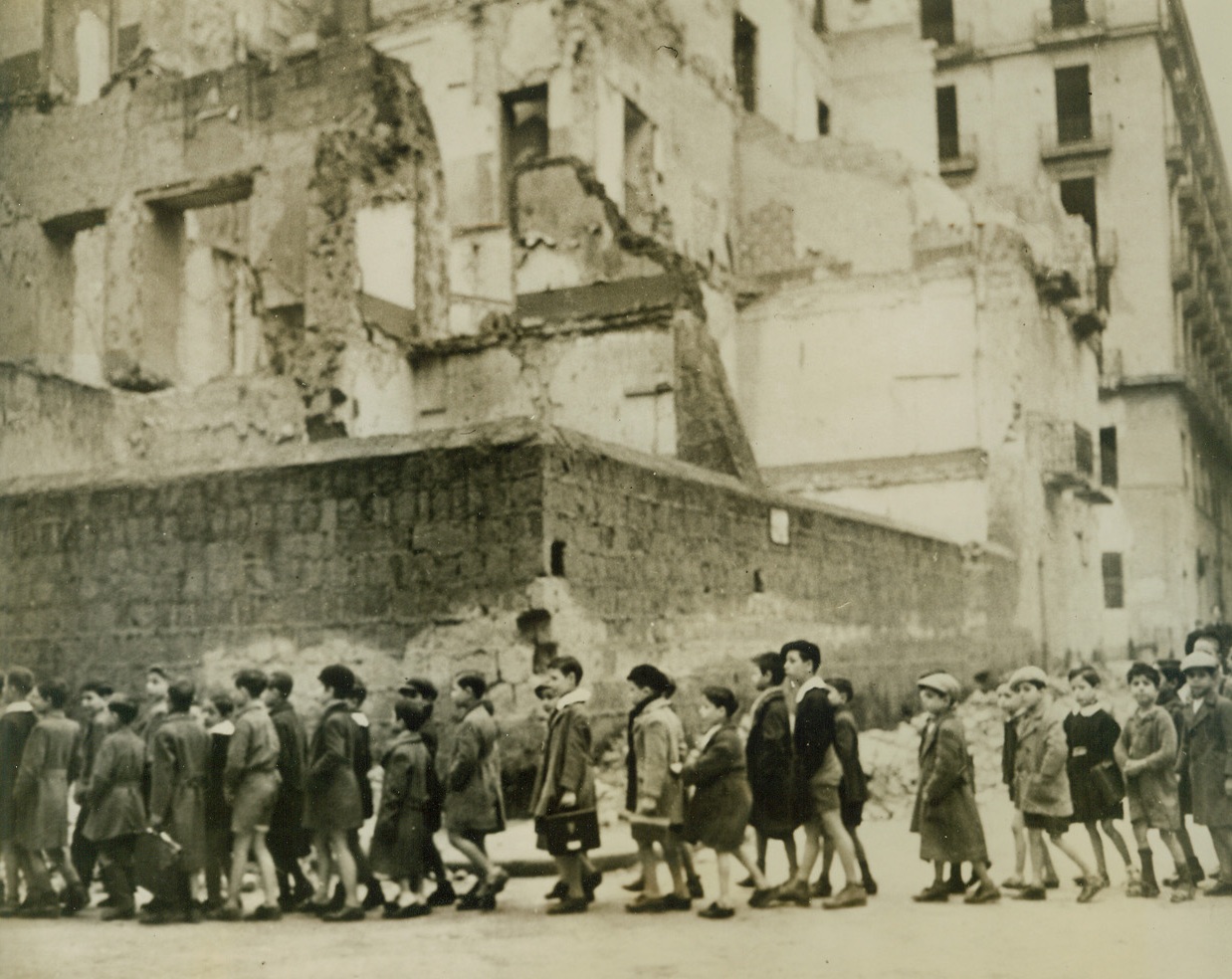
Vacation Over for Naples Kids, 2/14/1944. NAPLES, ITALY – Naples children, who have had a long holiday from the classroom as they hid from both Allied and Nazi bombs, now file back to school, passing war ruins on the way. Many Neapolitan families moved into hillside caves as war rocked their city. Credit Line (Acme);
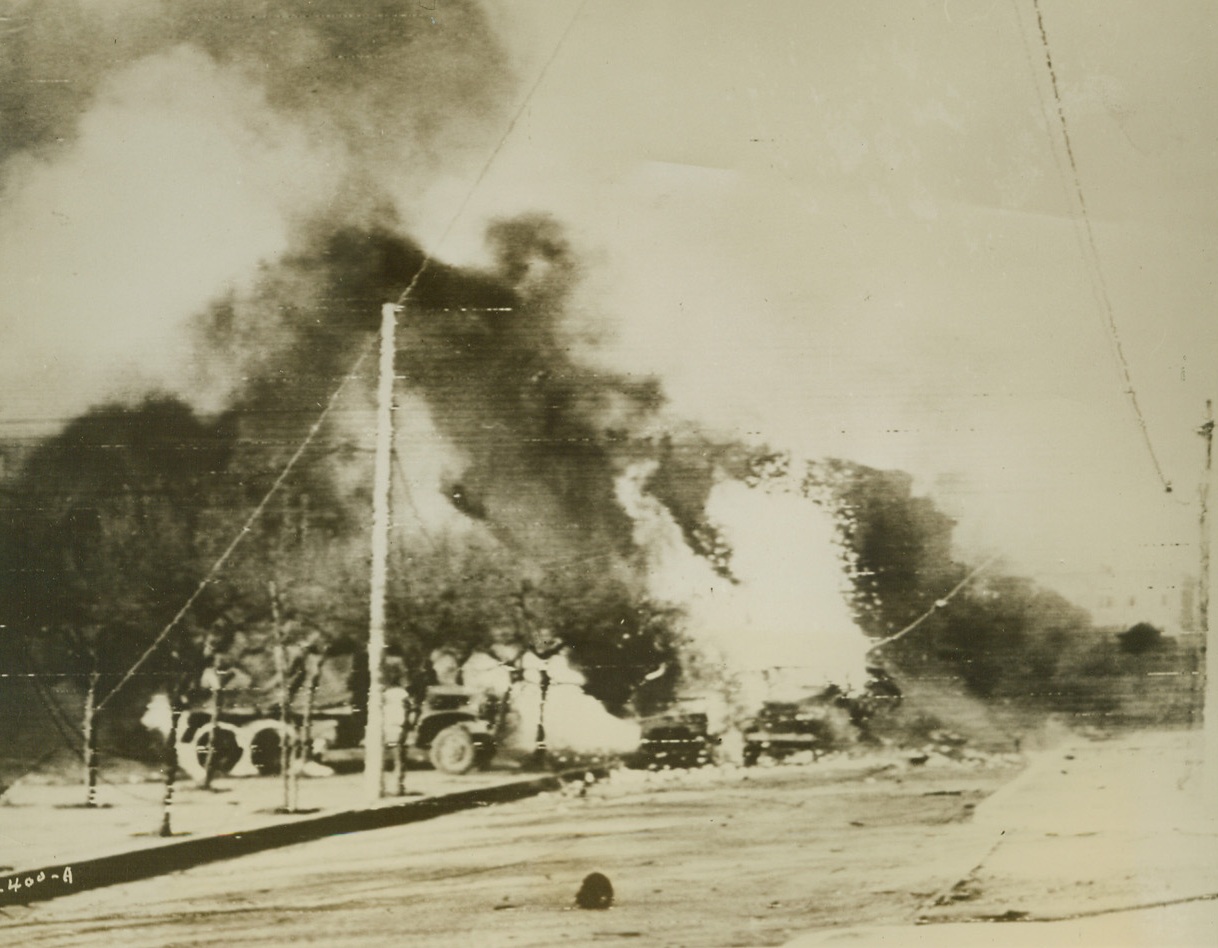
Nazi Planes are Active, Too, 2/14/1944. ITALY – American and British trucks burst into flames, the victims of a Nazi air attack in the embattled Nettuno area. Nazi bombs set off the blaze which is fed by the vehicles’ fuel tanks. Our planes are giving the same sort of treatment to enemy supply dumps and roads.Credit (Signal Corps Radiotelephoto from Acme);
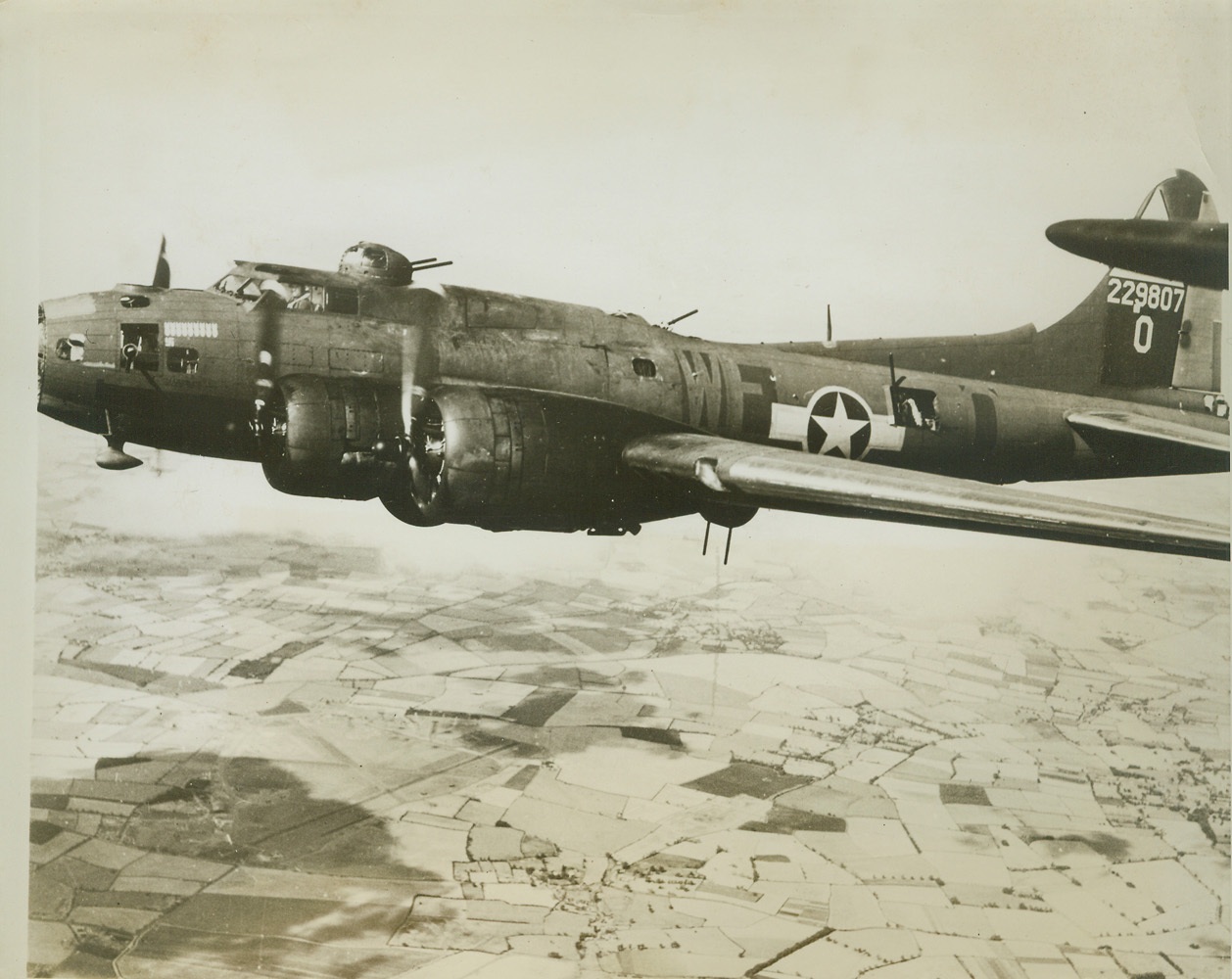
Fortress' Last Flight, 2/17/1944. This photo of the gallant Flying Fortress, "Lady Liberty", veteran of nine bombing missions (note score just below and in front of pilot's compartment), was taken only a few seconds before flak from a German anti-aircraft battery blasted the ship in half, over Flushing, Holland. Here, the ship's pilot, Lt. Ralph R. Miller, of Chicago, can be seen through the window of the control cabin while, aft, a waist gunner can be seen at his post. Credit: (U.S. Army Air Force Photo from ACME);
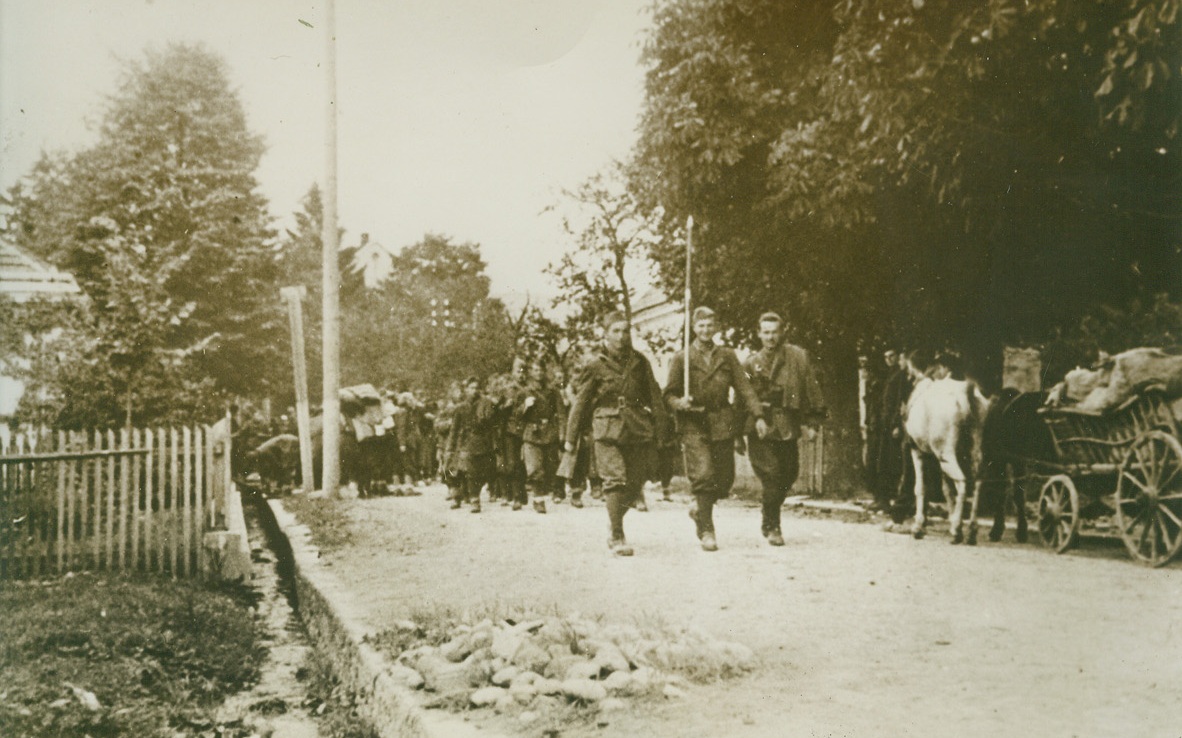
Liberators, 2/9/1944. BOSNIA – Jubilant Yugoslav partisans march triumphantly through a liberated town in Bosnia from which Hitler’s warriors fled. These are Marshal Tito’s men, who are making life miserable for Nazi forces in the Balkans. Credit Line (Acme);
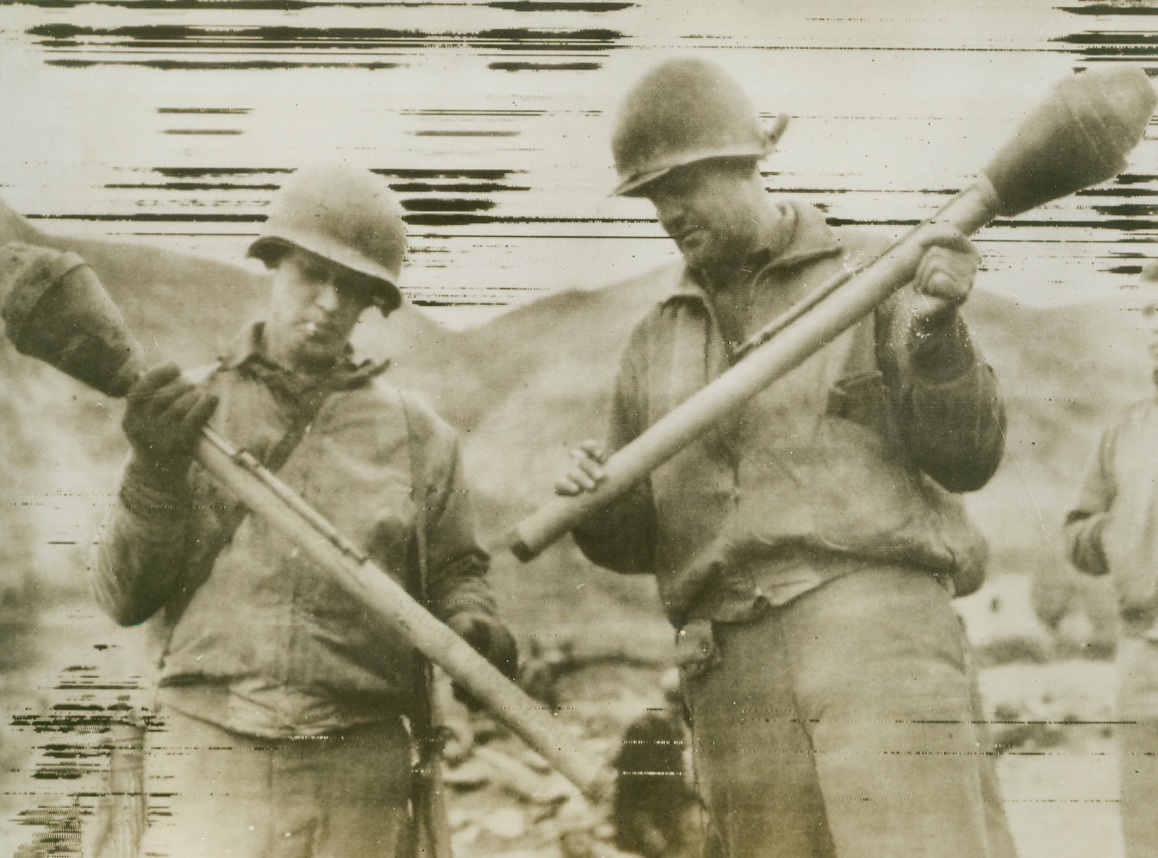
German Bazookas, 2/9/1944. CASSINO, ITALY – Two Yanks examine the Nazi version of the bazooka gun, captured on the outskirts of Cassino by members of the Allied Fifth Army. Left to right: Pfc Carl Swenson of Austin, Minn., and Cpl Dean Alexander of Oklahoma City, Okla. Credit Line (OWI Radiophoto from Acme);

First Photos of Heligoland (#1), 2/10/1944. This photo, just received from a neutral source, is one of the first ever published of the modern defenses of Germany’s Gobralter – the island of Heligoland, in the North Sea. Heligoland, in peacetime a tourist center, and in wartime a military and naval fortress and U-boat base, is claimed by the Germans to be “inaccessible to the enemy.” Here, is a view of the fortress from the sea. Credit Line (Acme);
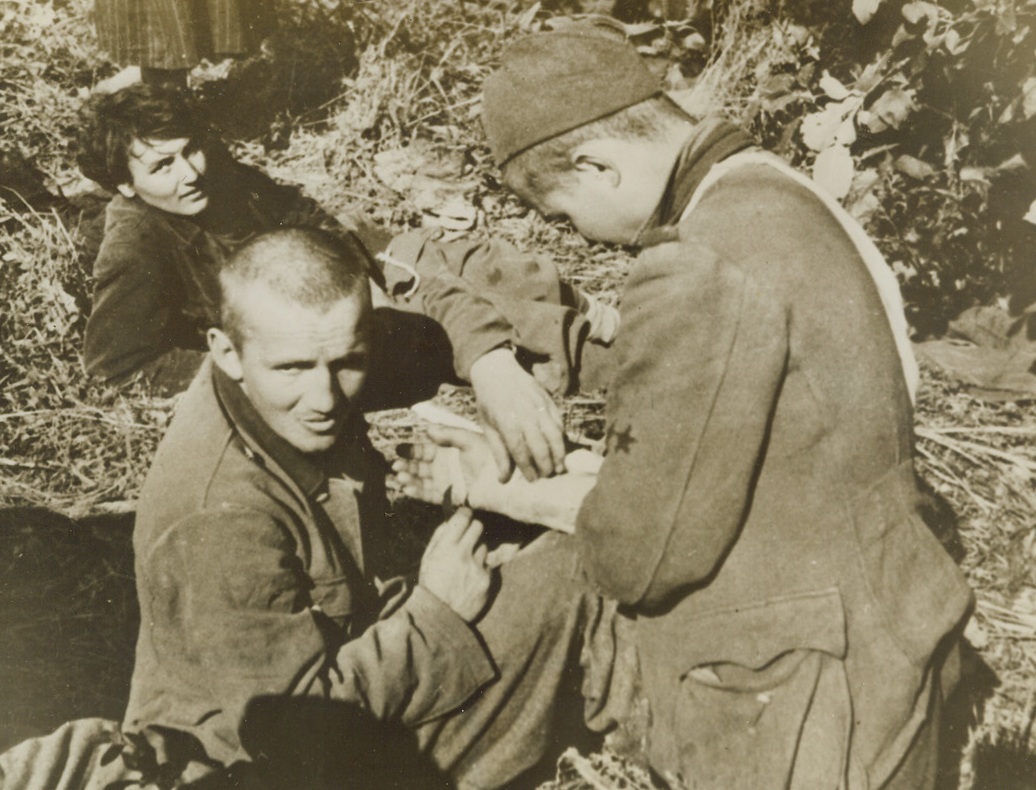
American-Born, He Fights with Tito, 2/9/1944. Yugoslavia – Among the men battling Hitler’s forces in the Balkans is this American-born Yugoslav doctor, known as “John.” Attached to the First Serbian Brigade, he attends to Partisan warriors wounded as they fight under Marshal Tito. Credit Line (Acme);
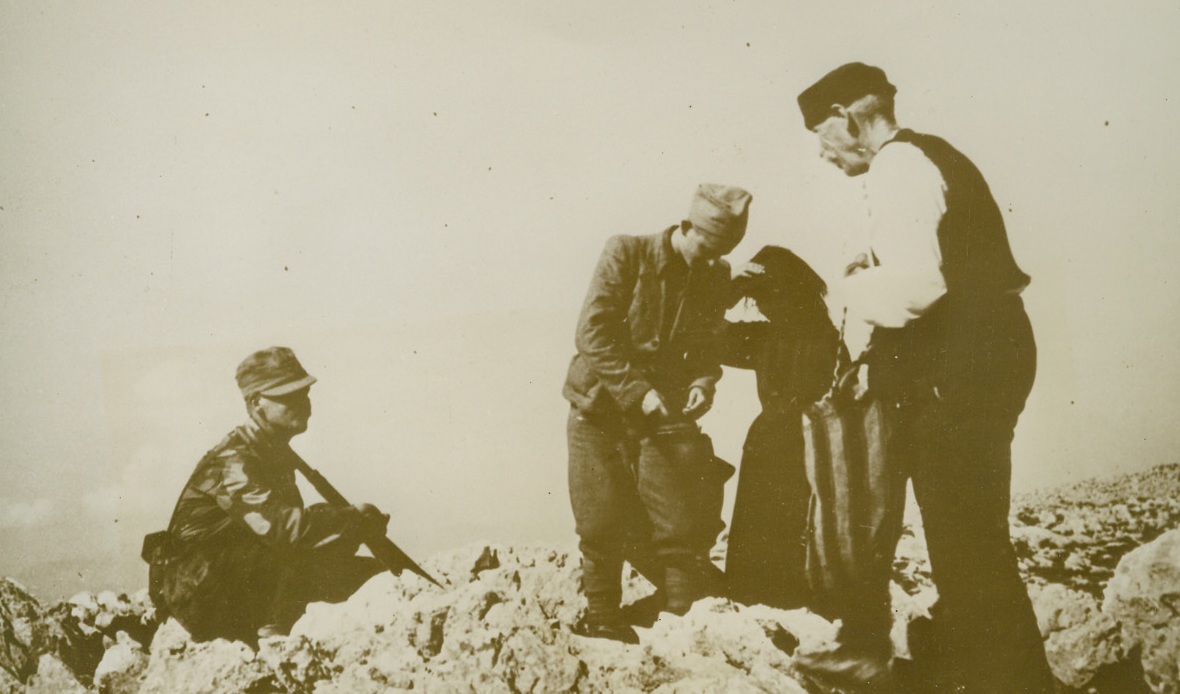
Food for Those Who Fight for Freedom, 2/9/1944. DALMATIA – Two Dalmatian peasants arrive at a mountaintop lookout post, bringing food to Yugoslav partisans stationed there. Too old to join Marshal Tito’s men in their active fight against Hitler, the peasants do all they can to help the small bands battling the Nazis in the Balkans. Credit Line (Acme);
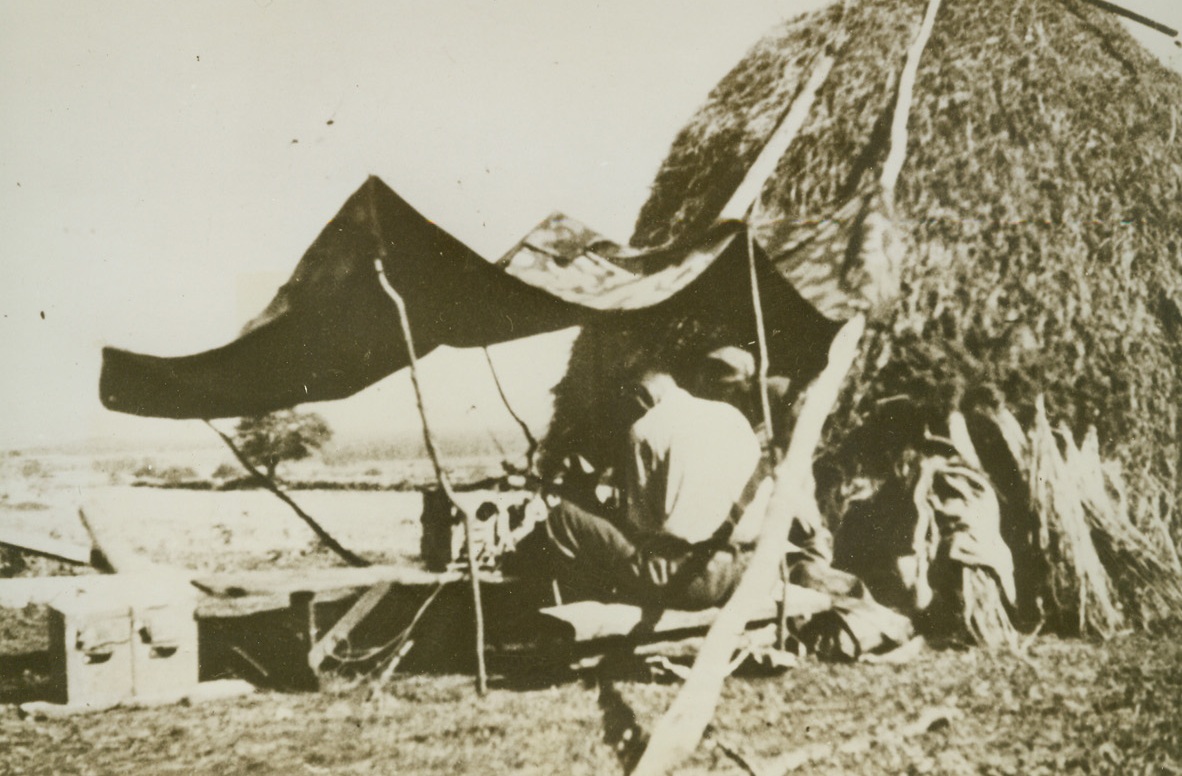
Field Communication, 2/9/1944. YUGOSLAVIA – Under a makeshift canopy at the side of a haystack, Partisan soldiers operate a field radio transmitter somewhere in Bosnia, where Partisan troops are tying up many German divisions. Credit Line (Acme);

Nazis are the Fish, 2/11/1944. ITALY – German prisoners are herded together in the beachhead area south of Rome at a spot so wide-open the Yanks have nicknamed it the “Gold Fish Bowl.” Pvt. William Shea, (left), and Pfc. Andrew Calet, both of New York City, guard the Nazis who will be marched to the rear. Credit Line (Acme);
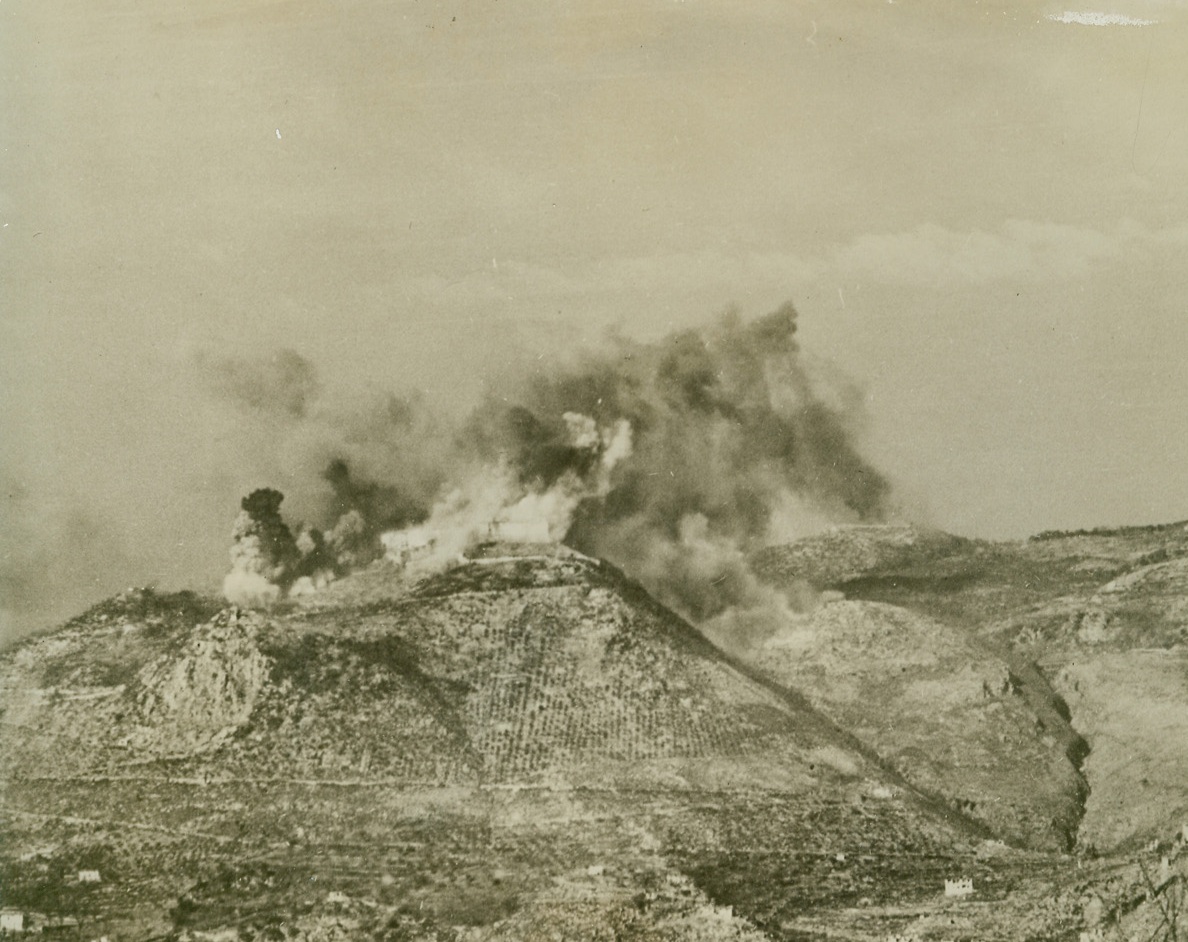
FORTIFIED MONASTERY BATTERED BY ALLIES, 2/25/1944. ITALY—The famous Benedictine monastery on the peak of Mount Cassino is turned into a smoke-shrouded inferno by Allied bombers. Explosives were followed by incendiaries, as some 250 medium and heavy bombers knocked out the religious building which the Nazis had turned into a fortress used to shell Allied troops. Credit: Acme;
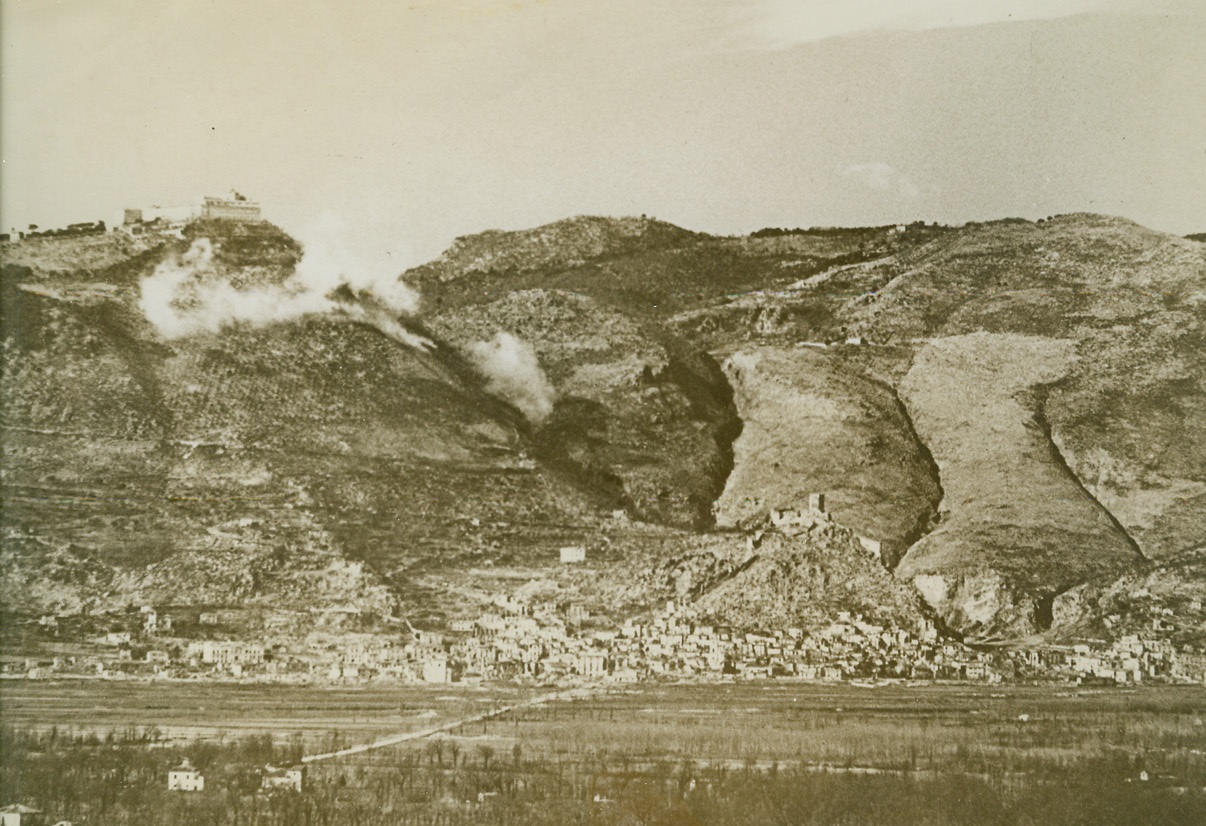
SMASHING NAZI DEFENSES AT CASSINO, 2/25/1944. ITALY—Allied shells burst between the town of Cassino and the famous Monte Cassino Abbey (left) on the tip of the mountain peak, as Fifth Army forces seek to drive the Germans from their strong defense positions. Other shells, which give off very little smoke and are barely discernible, are exploding in the town itself close to the castle which surmounts surrounding houses. Credit: Acme;
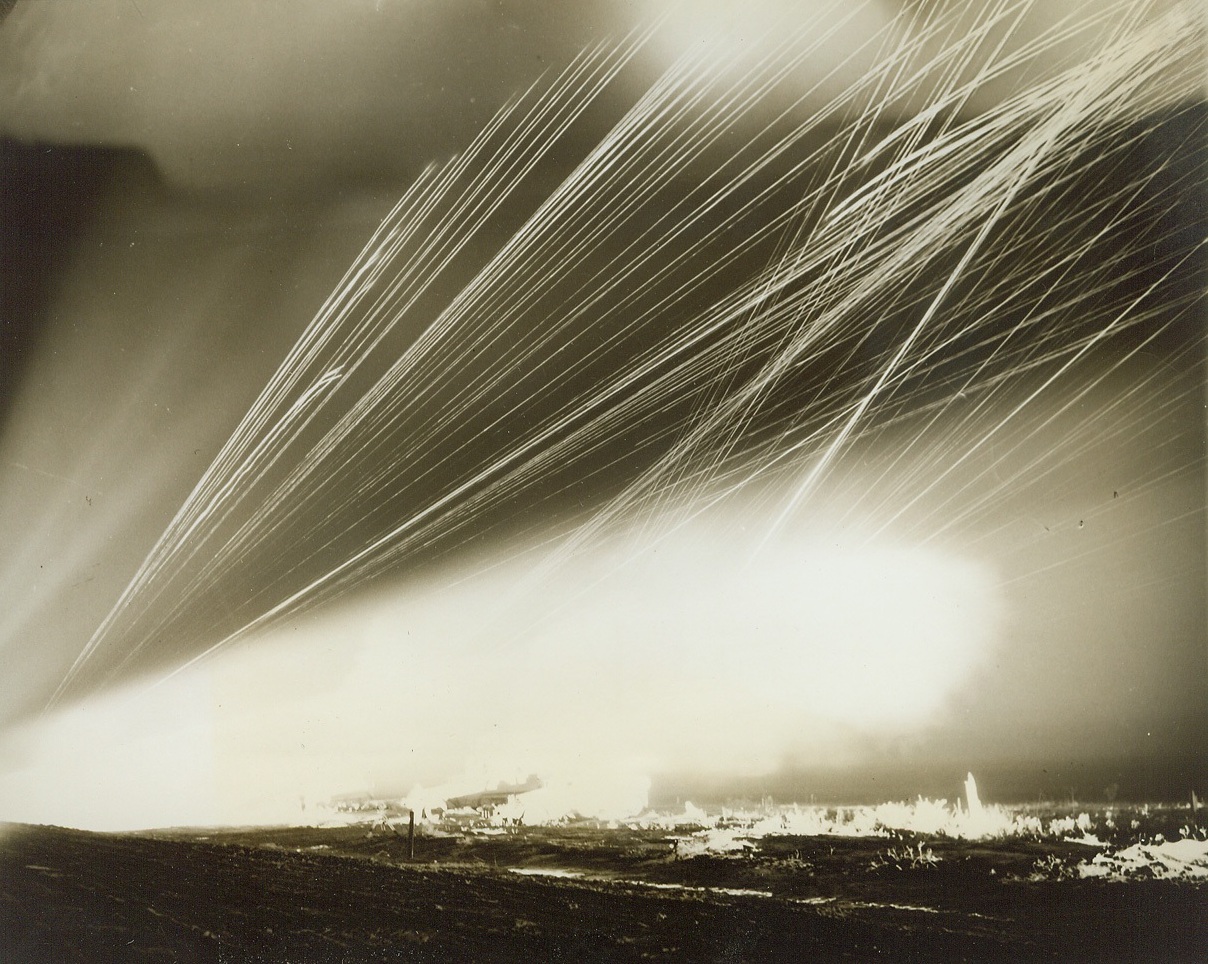
Rocket Targets for Ack-Ack Training, 2/8/1944. CAMP DAVIS, N.C. -- Jet-propelled rocket targets are now being used to train anti-aircraft artillerymen at Camp Davis, giving our gunners practical experience in firing at "enemy planes" diving at terrific speed, and preparing them for action against the jet-propelled planes of tomorrow, should the enemy perfect such planes before this war is over. Fired from specially designed carriages, the rockets have an initial velocity of 450 miles per hour or 675 feet per second. They are released from the range at Holly Shelter, a Camp Davis firing point. Manning 50 caliber machine guns and 20 and 40mm weapons, the trainees improve their aim and accuracy as the track the fast-moving, 59-inch targets. The rocket always describes an approximate parabola and has a maximum horizontal range of about 2200 yards. The following photos show phases of rocket target practice by night and by day. New York Bureau Their guns mounted on half-tracks that shine white in the light of mock battle, the gunners trace lines of fire across the black sky as they get a deadly bead on the rocket targets. The half-tracks are driven speedily up and down the range as the crews pour lead at their targets at a rate of better than 1600 rounds per minute. Credit: (ACME) (date torn at bottom of caption;
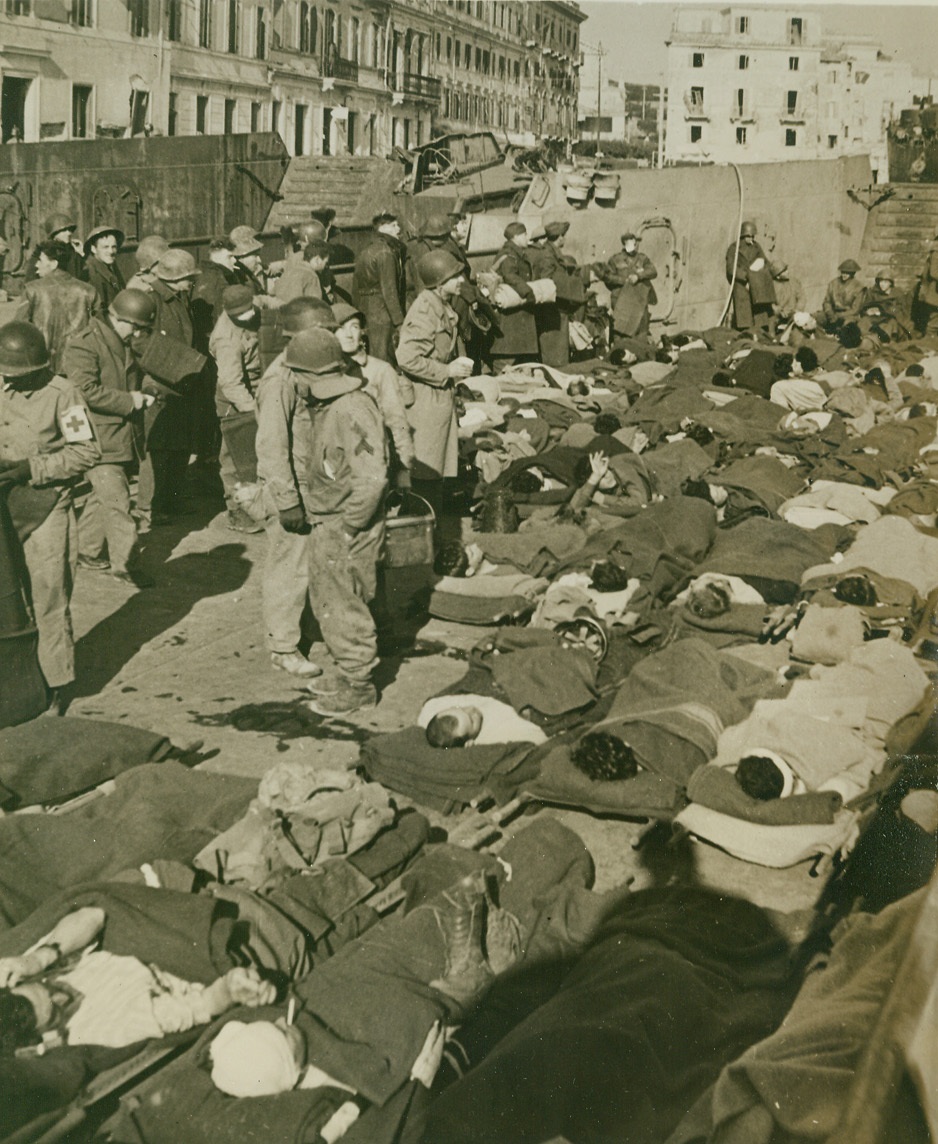
ANZIO BEACHHEAD COST, 2/28/1944. ANZIO, ITALY—Lying along the deck of a landing craft for the trip out to a hospital ship out in the harbor here, are some of the casualties from the fierce battle for the Anzio beachhead. Credit: Official U.S. Navy photo from Acme;
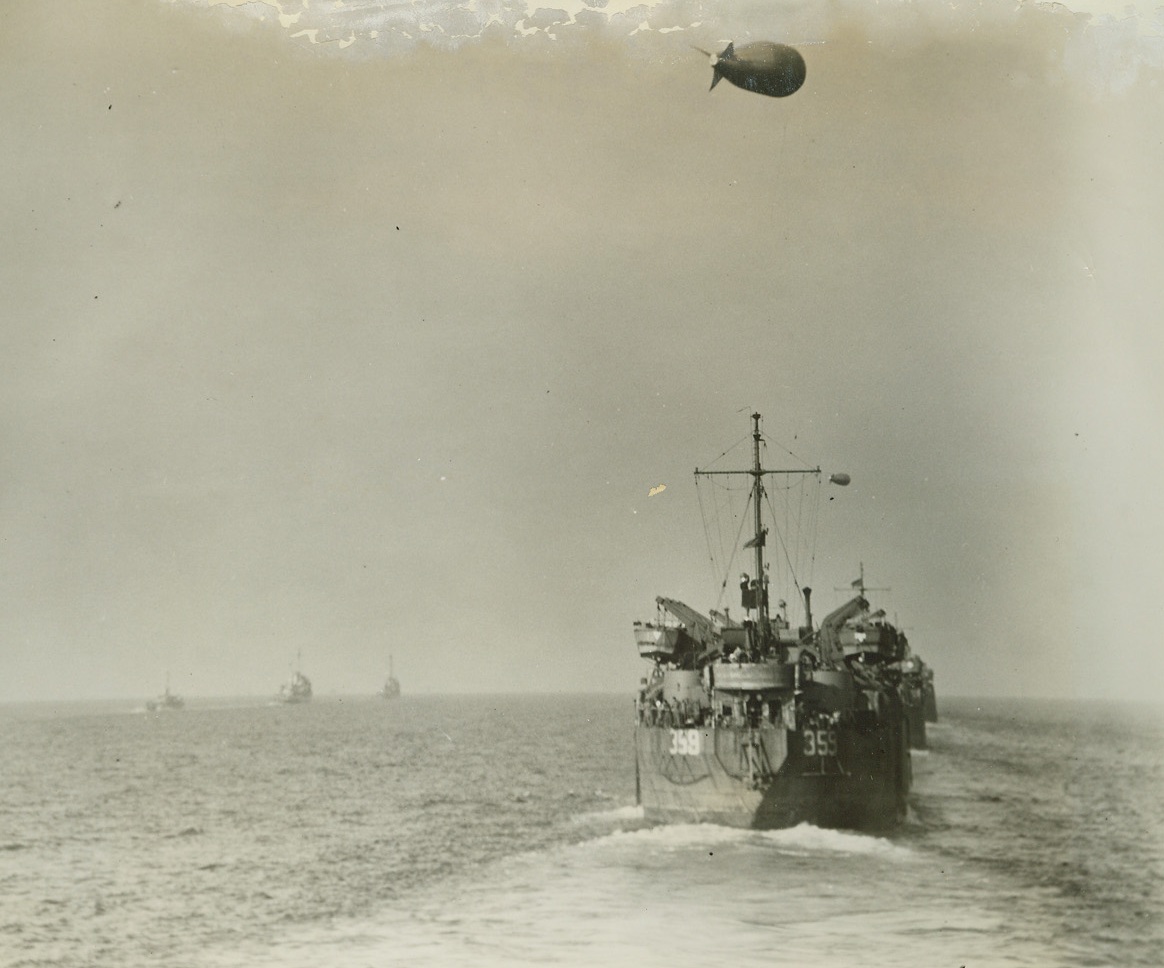
HEADED FOR DRIVE ON ROME, 2/3/1944. This photo, one of the first originals to reach the United States, was taken as the massive Allied invasion fleet headed toward beachheads in the vicinity of Nettuno and Anzio for the drive on Rome. At right, (above) is a LST (Landing Ship, Tanks) with its barrage balloon hovering above. In left, background, are LCIs (Landing Craft, Infantry). Today it was announced that American Infantry, supported by tanks, had driven into the northwestern part of Cassino. Credit Line (ACME Photo by Bert Brandt for the War Picture Pool);
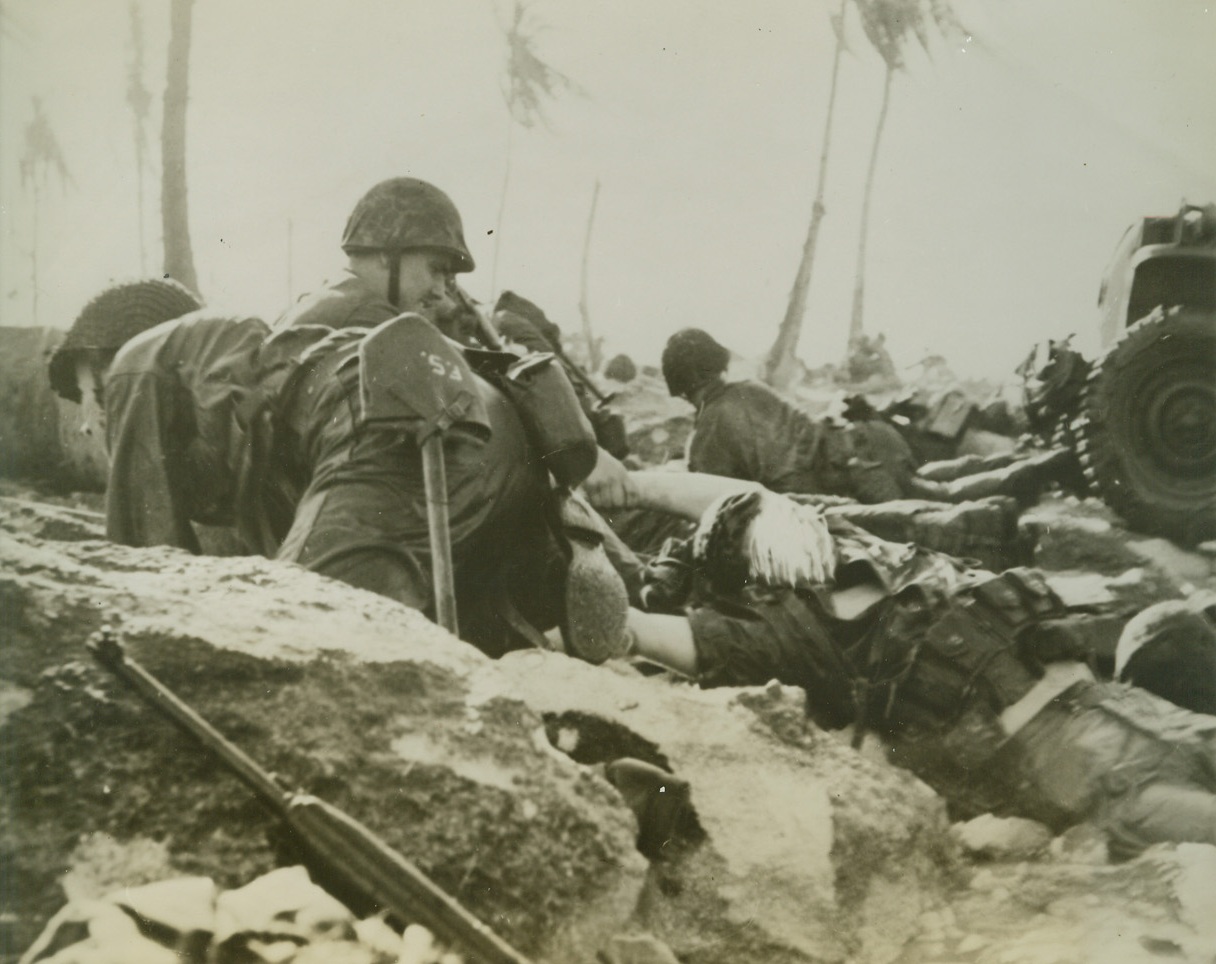
Enitwetok Island Invasion Casualty, 2/25/1944. Eniwetok Island – “Casualties were light.” That phrase from the communiqué gives rise to optimism on the home front but it won’t bring back to life or comfort the next of kin of this Marine being dragged through surf to Coral Beach of Eniwetok Island in Marshalls after Jap bullet killed him as he leaped into surf from landing boat. Did you buy a bond today? 2/25/44 Credit Line (ACME);

THEIR SNIPING DAYS ARE DONE, 2/24/1944. ACCIARELLA, ITALY—Three hatless German snipers (left), who were rounded up by members of an American paratrooper unit, which had suffered casualties from snipers in the Acciarella area. The Paratroopers at right, carries bayonets and cartridge belts taken from the Germans. The third sniper from left, wears a Red Cross arm band, but when captured carried a gun which had been fired. Another sniper shows a bandaged jaw. Credit Line (U.S. Signal Corps Photo from ACME);
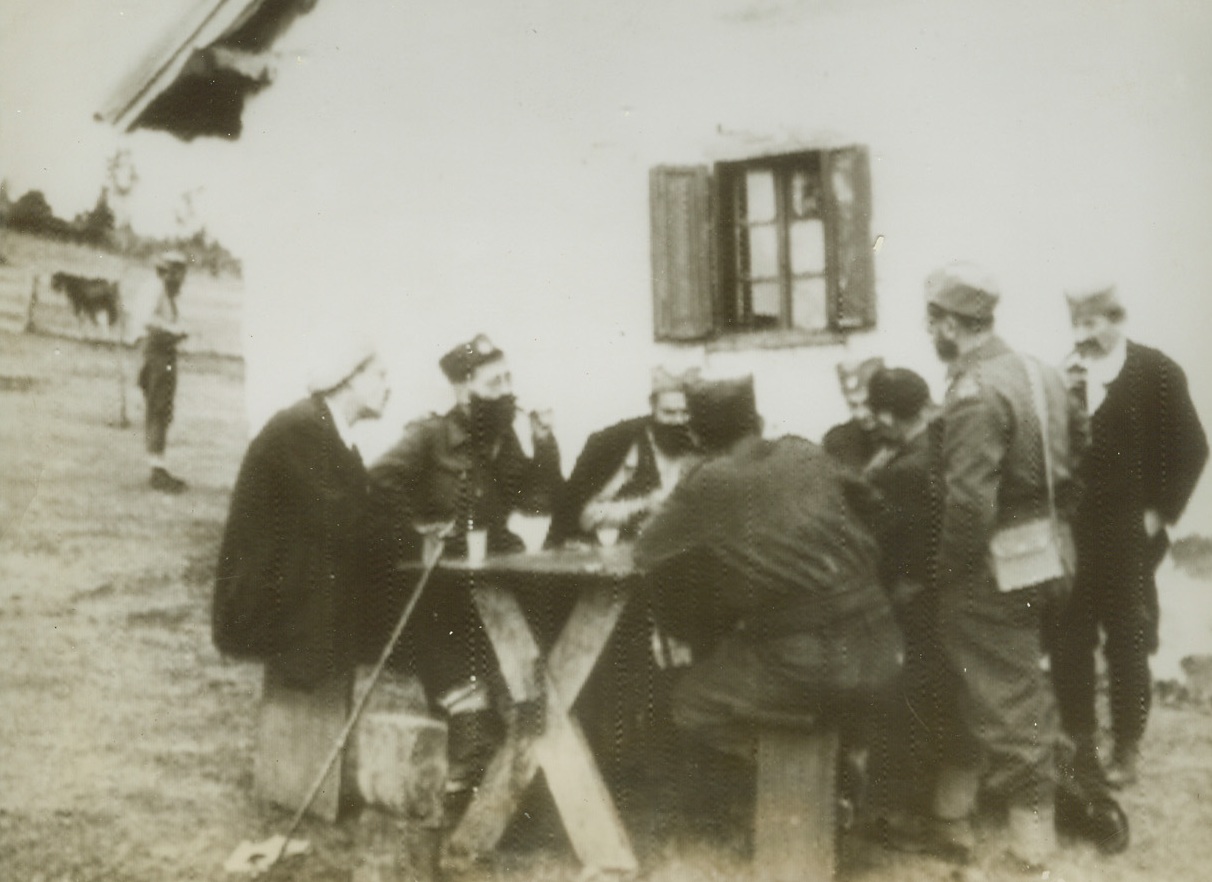
CONFERS WITH BRITISH IN YUGOSLAVIA, 2/19/1944. SOMEWHERE IN YUGOSLAVIA—General Draja Mihailovitch (center), leader of Chetnik soldiers who is minister of War to King Peter’s government-in-exile, confers with two British liaison officers, “somewhere in Yugoslavia.” Photo flashed from Stockholm to New York, today. Credit (ACME Radiophoto);
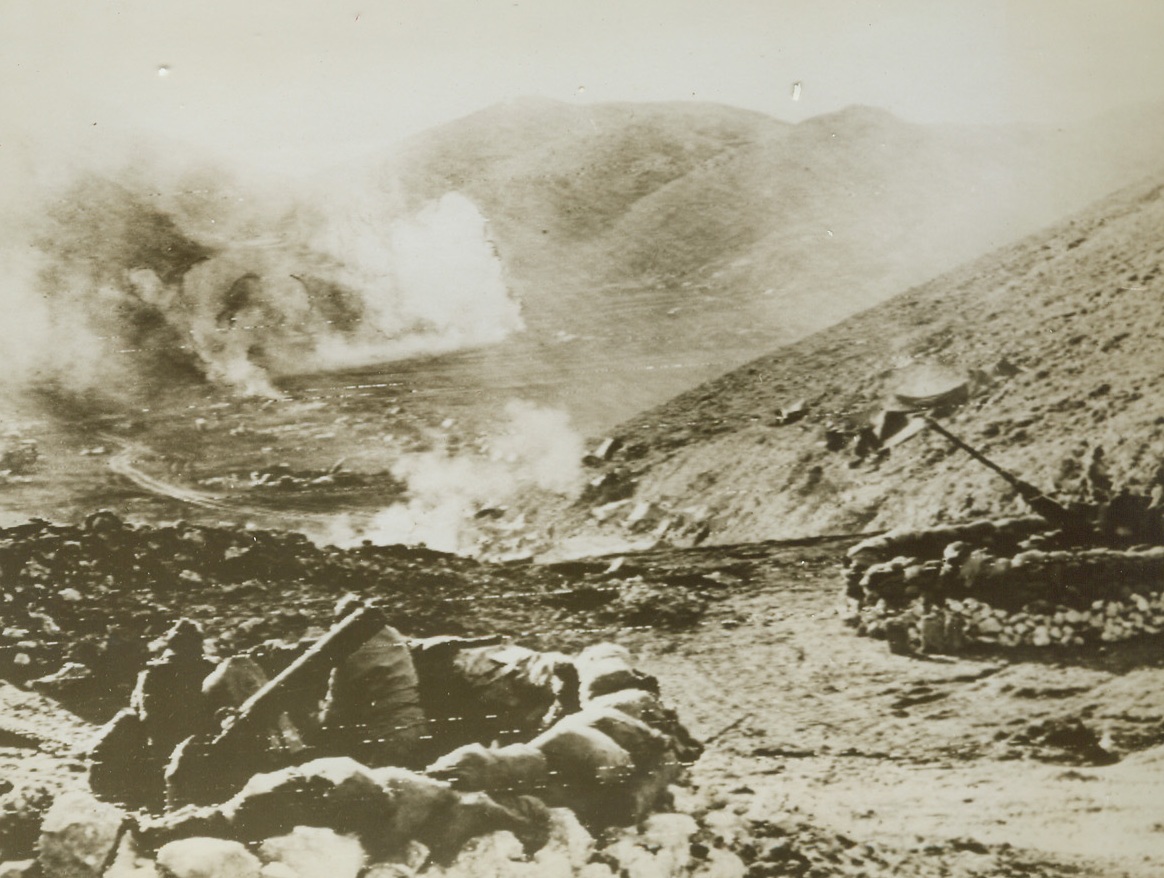
CLOSE CALL, 2/7/1944. NEAR S. ELIA, ITALY: Despite closely bursting German shells, American and French anti-aircraft units stand by their guns in the valley near S. Elia, Italy. Credit (Official Signal Corps Radiotelephoto from ACME);
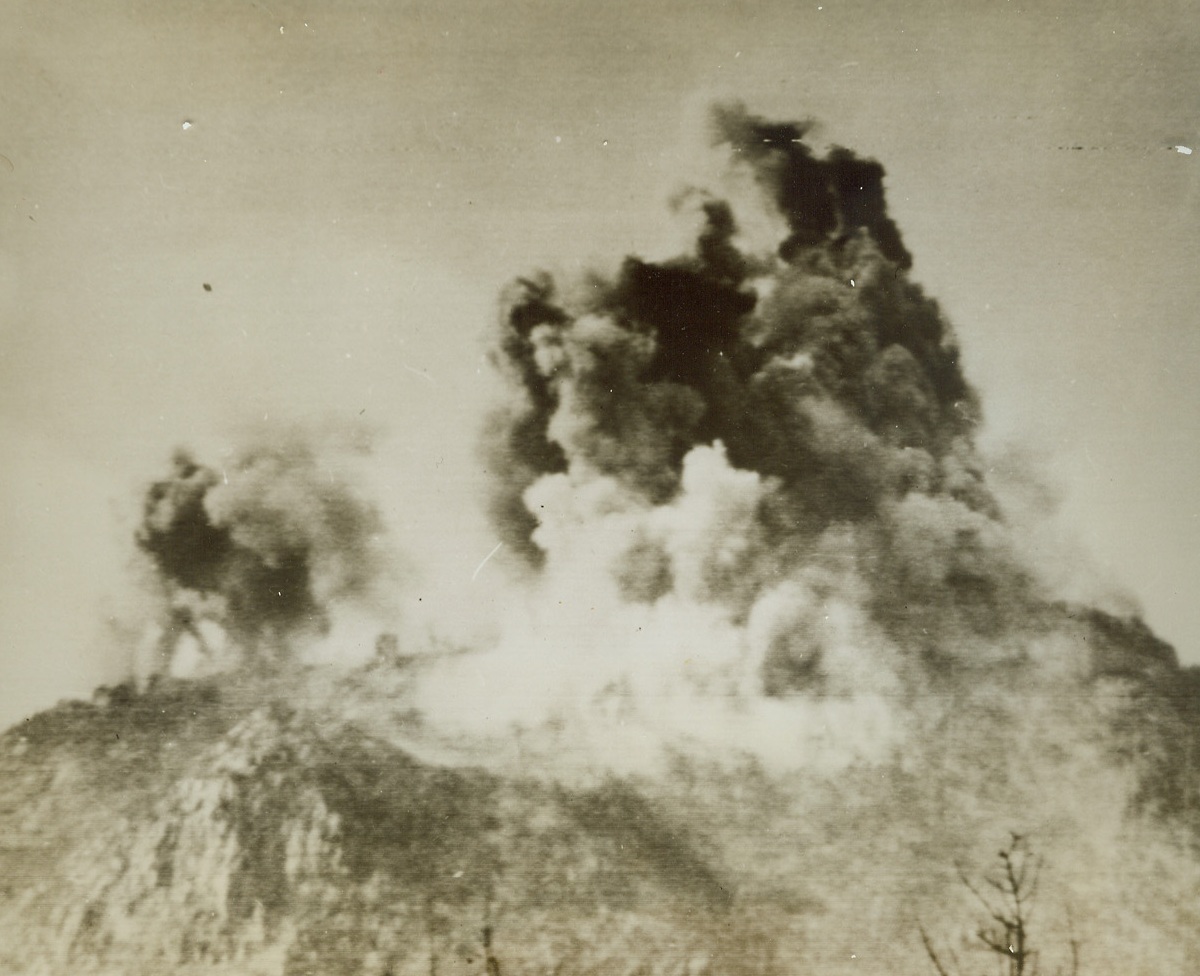
YANKS BOMB MONASTERY, 2/19/1944. CASSINO, ITALY—Here is a view of an American raid on the St. Benedictine Monastery at Cassino after Nazi forces had converted the ancient house of worship into a fortress to halt the advance of the Allied Fifth Army. B-25 bombers of the Allied Air Forces and Fifth Army artillery blasted the religious structure. Credit (U.S. Army Photo via Radiotelephoto—ACME);
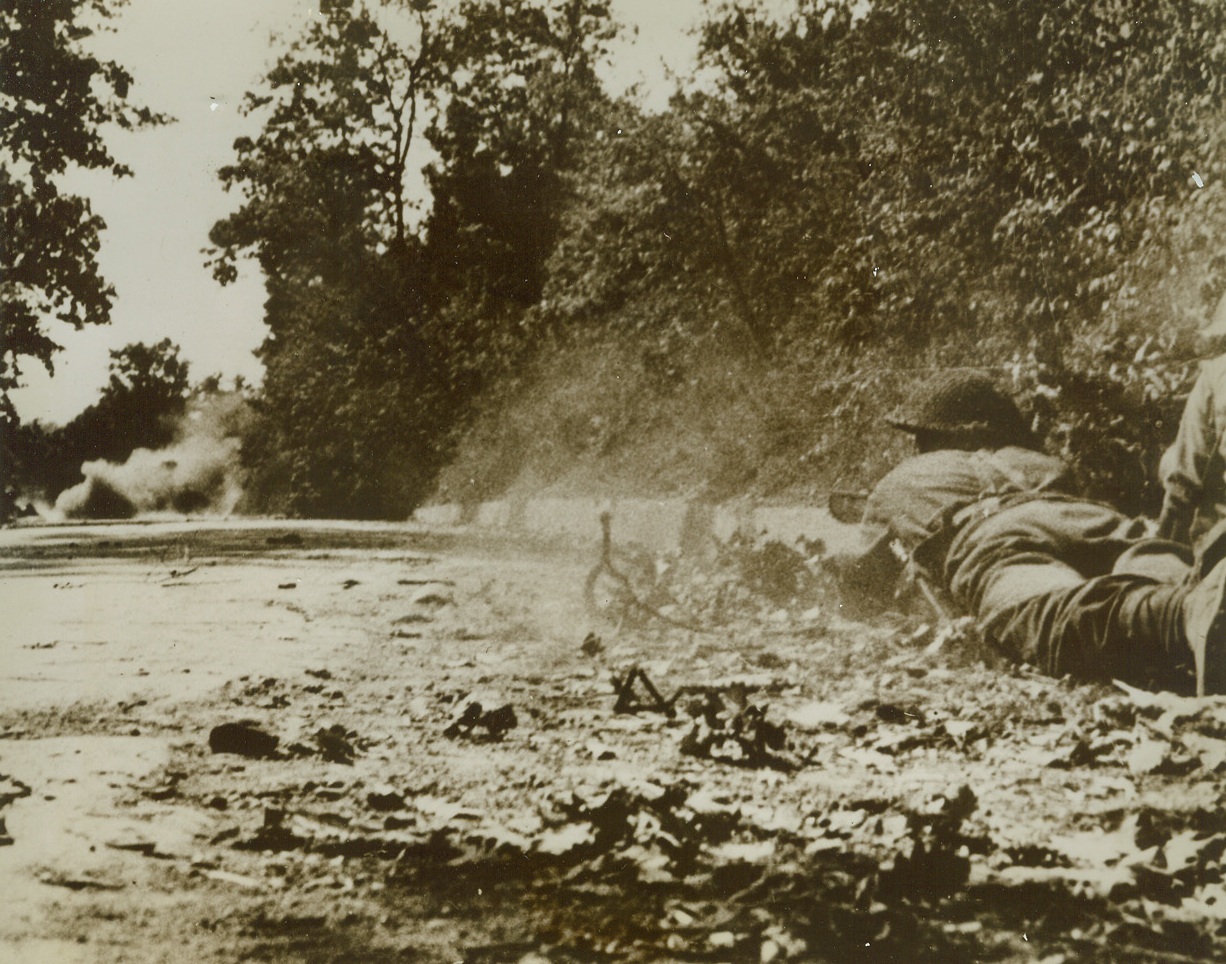
BRITAIN’S CRACK ANTI-TANK GUN IN ACTION, 2/20/1944. ITALY—This action photo shows the precise moment when the two-and-three quarter-pound bomb projected from a PIAT gun hits its target at short range. The target, a German Mark IV tank, is behind the cloud of smoke in background. A new weapon, the PIAT (Projector Infantry Anti-tank) gun can be used with deadly efficiency against concrete pillboxes and machine gun nests as well as tanks. Credit Line (ACME);
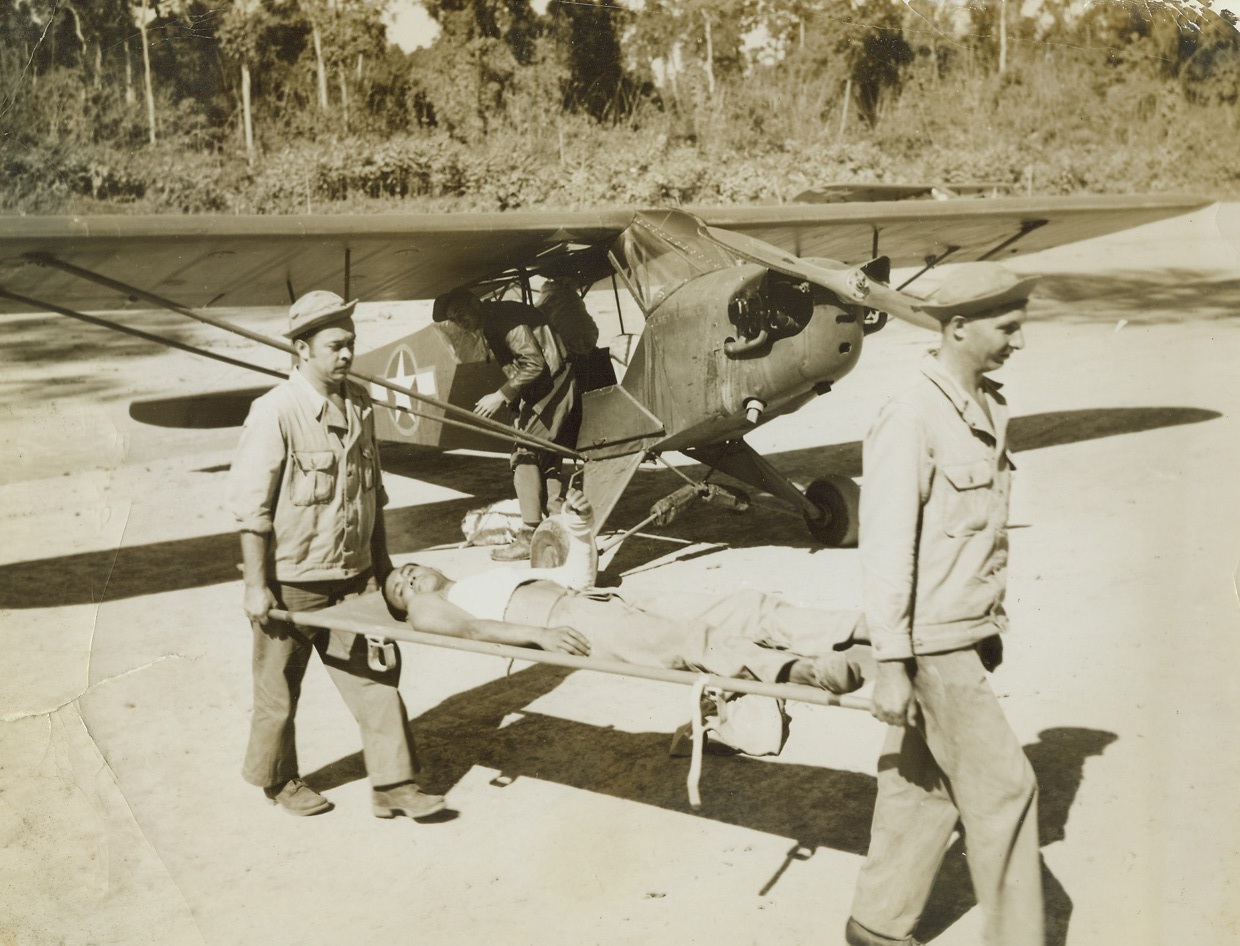
Winged Midgets of the Jungle, 2/3/1944. CBI War Theater – While American bombers and fighters roar into the headlines, a vastly different type of U.S. Army “Air Force” works quietly and efficiently on its own, hidden war fronts. Small and rugged Cubs and Sentinels, piloted by enlisted men who built up their flying time in civilian life, are skimming the jungles, hopping over mountain ridges, and soaring through ragged canyons, on missions invaluable to American, British, and Chinese troops in the CBI War Theater. No guns are carried by the Midget Aircraft. The main “weapon” of the Cub or Sentinel is maneuverability, and when charged by the enemy, the tiny plane adopts the tactics of a mosquito evading a hawk. A Chinese soldier, wounded in Burma, is brought back to a base hospital by a Sentinel (background). Other mercy missions of the Midget Plane include the dropping of food and medical supplies to frontline jungle warriors. Credit: ACME photo by Frank Cancellare, War Pool Correspondent;
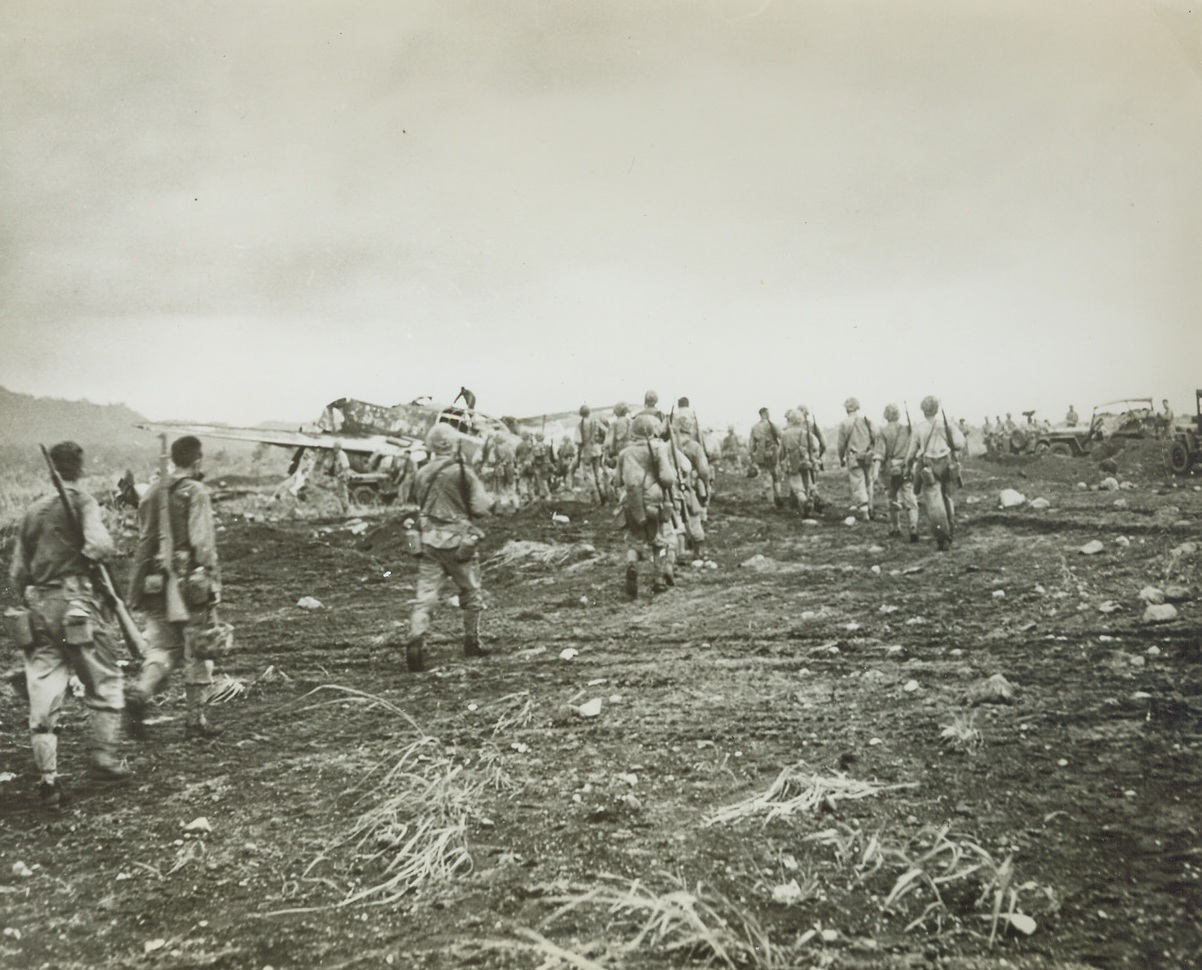
Their Objective Reached, 2/3/1944. Cape Gloucester, New Britain – After three days of hard fighting in the jungles of New Britain, Uncle Sam’s marines reach their Cape Gloucester objective—the strategic Jap-held airfield. At left, background, is a wrecked Jap plane, ruined during the heavy bombardment that preceded the leatherneck invasion. Credit: U.S. Marine Corps photo from ACME;

”Island Forts” Protect British Shipping, 2/2/1944. On the British Coast – Manned by Royal Marines, “Island Forts” like this one are protecting Britain’s east coast. Each fort consists of two concrete towers, 50 feet high, connected by a superstructure on which ack-ack guns and equipment are mounted. Commissioned as H.M. ships, the forts have accounted for a number of German aircraft. Credit: ACME;
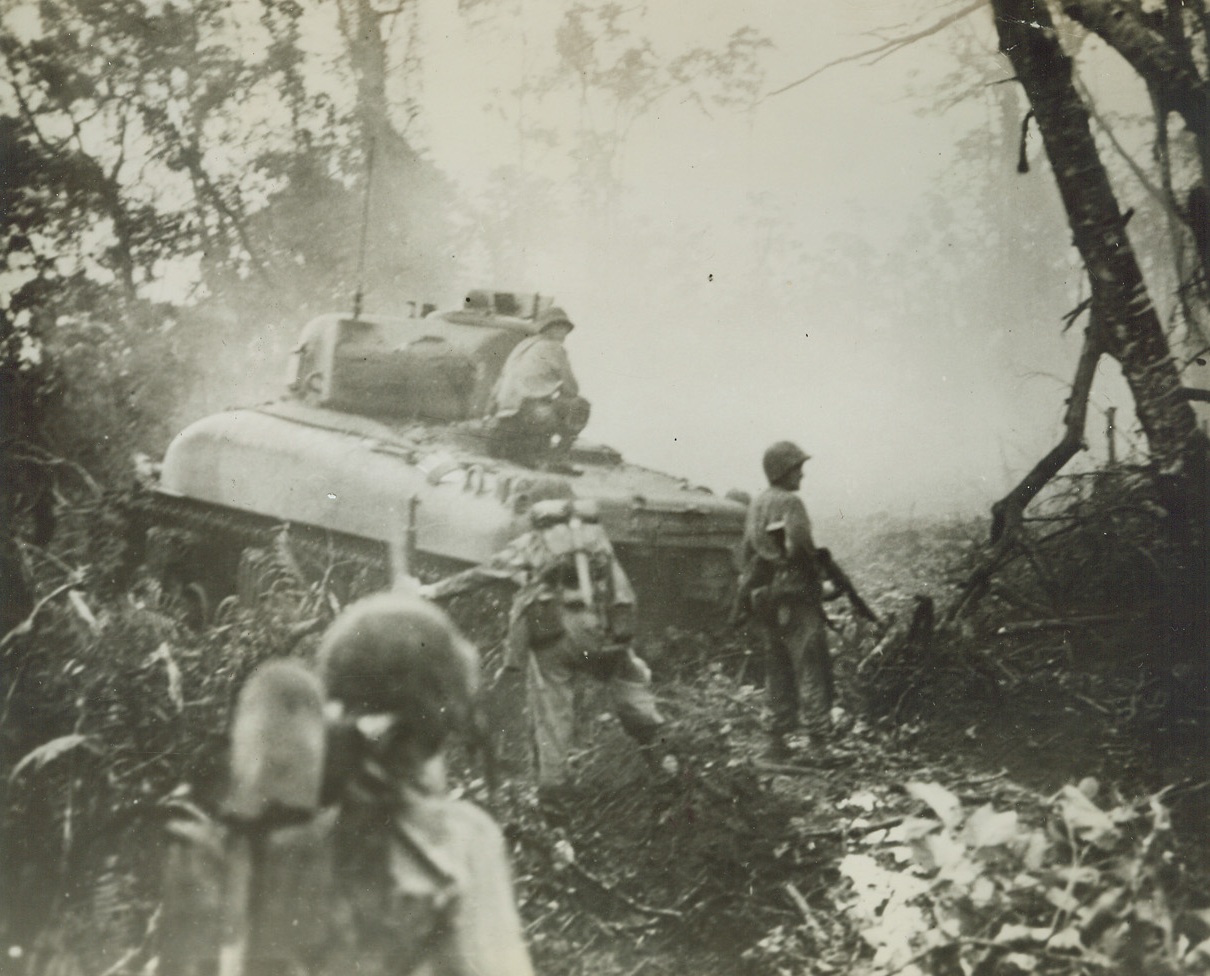
En Route to the Airfield, 2/3/1944. New Britain – Marine riflemen keep a sharp lookout for snipers and attacking enemy warriors as one of their tanks pauses on New Britain to blast away at a Jap pillbox with 75mm and machine fun fire. The leathernecks are en route to Cape Gloucester airfield, which fell to them shortly after this photo was made. Credit: U.S. Marine Corps photo from ACME;
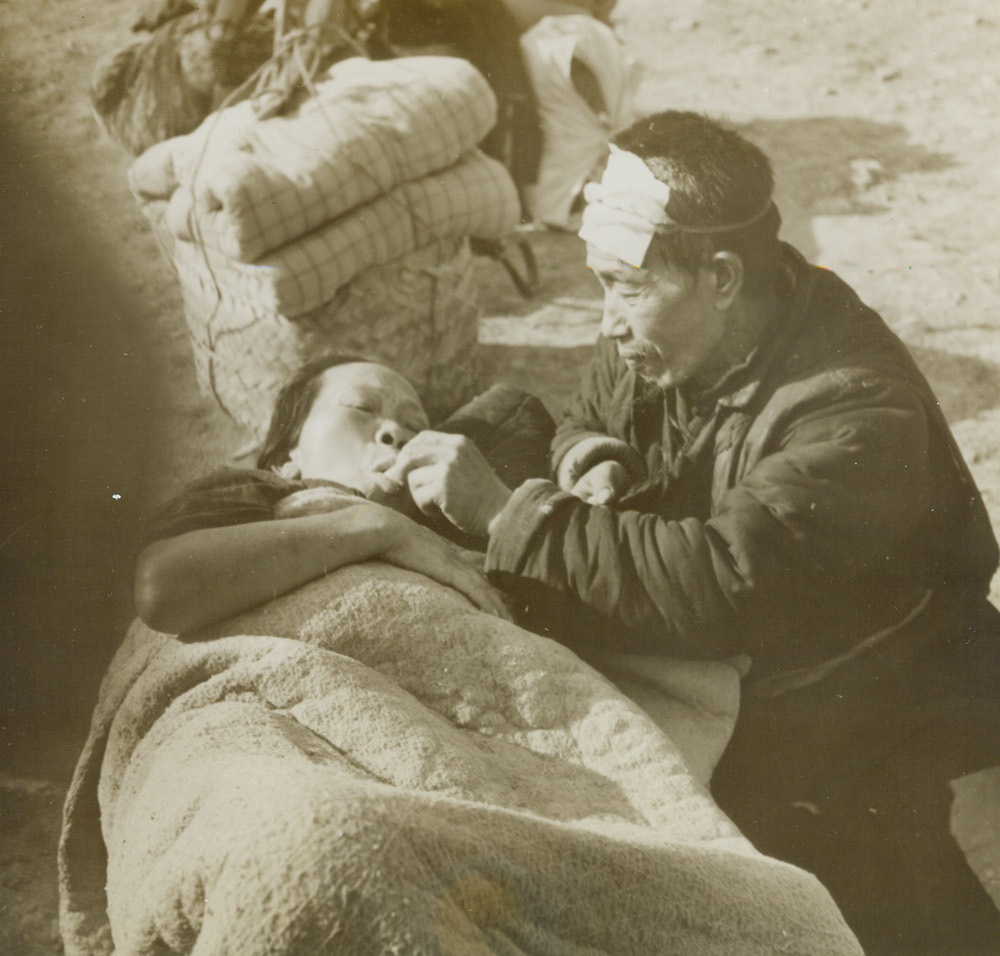
War’s Victims, 2/2/1944. Changteh, China – While waiting for aid from relief organizations set up at Changteh after Chinese fighters drove the Japs from that city. An old man cares for his ill wife. Both were innocent victims of the terrific fight for the key city, from which the enemy was chased on December 9, 1943, six days after the Japs first took Changteh. Credit: ACME;
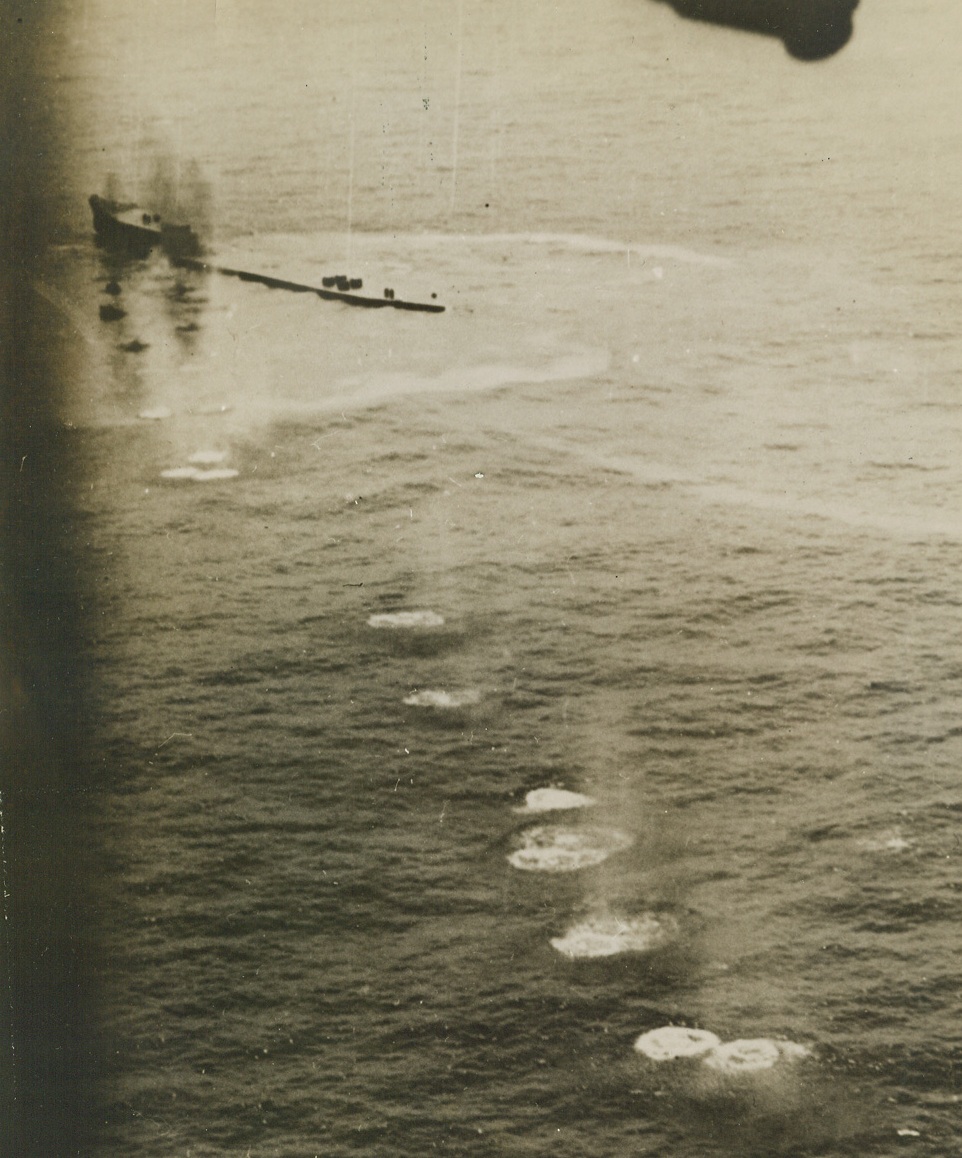
Marked for Destruction, 2/2/1944. This photo, released by the Navy Department in Washington today, shows a U.S. Navy Liberator Bomber (PB4Y) starting a run on a Jap oil barge off New Ireland, in the Pacific. A string of splashes leading up to the enemy craft mark machine gun hits “marching” up and across the barge. Black smoke marking fires and a spreading oil slick around the craft attests to the success of the attack. The barge was later sunk by bomb hits. Credit: U.S. Navy official photo from ACME;
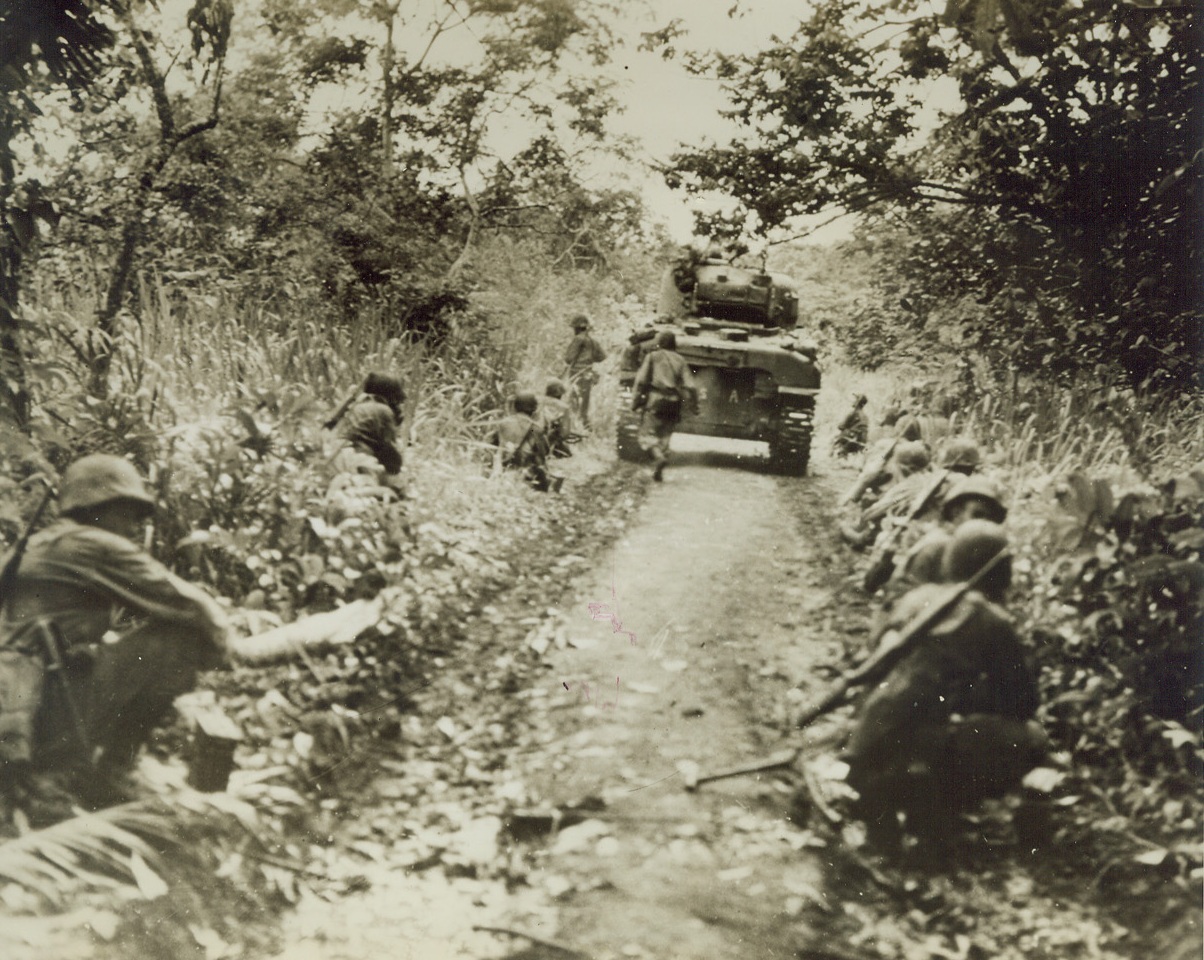
Marines Advance—With Caution, 2/2/1944. Cape Gloucester – Widely separated and hugging the slim cover of the jungle grass, these U.S. Marines advance behind a General Sherman tank near Cape Gloucester. Although the area had been heavily bombarded by American Naval units a short time before, the leathernecks are taking no chances with the treacherous Nips. Credit: U.S. Marine Corps photo from ACME;
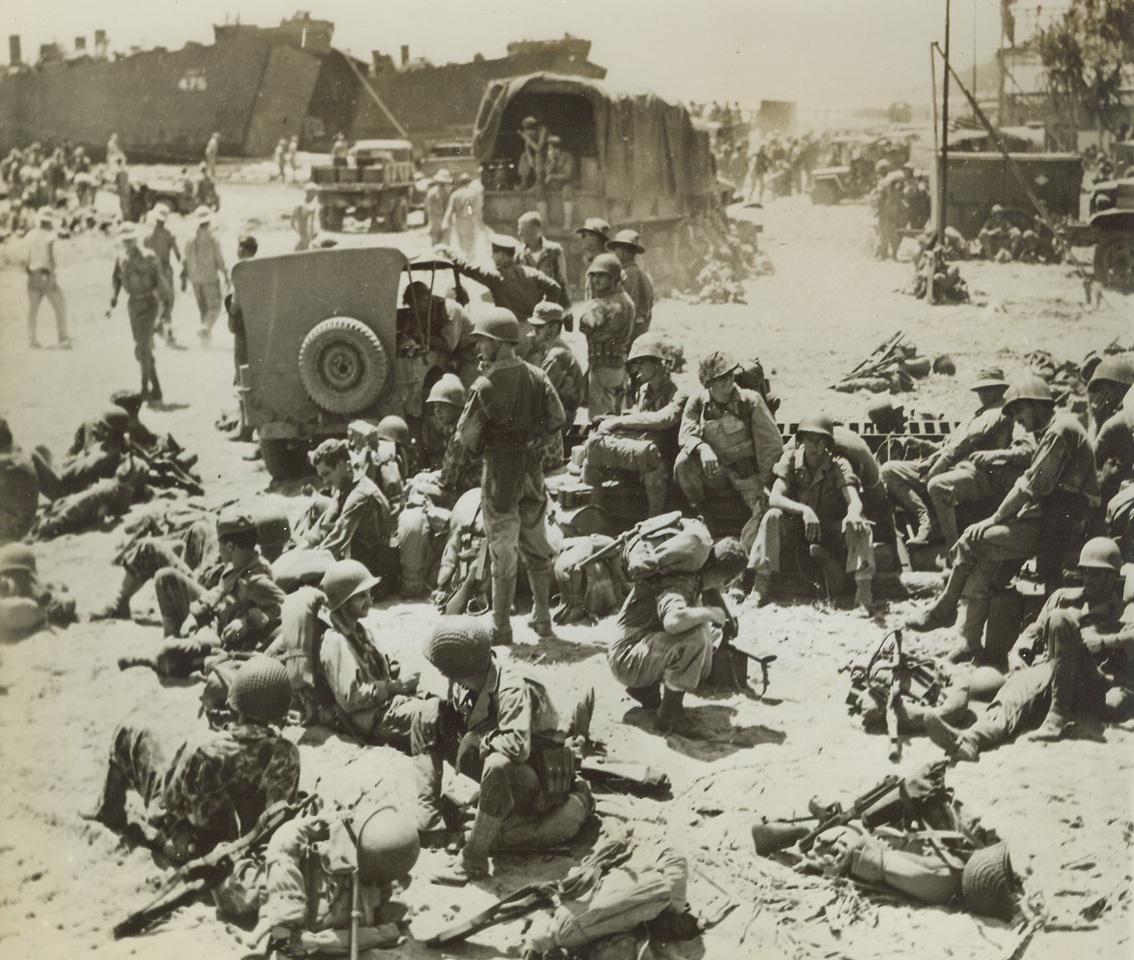
Pre-Assault Rest, 2/1/1944. Cape Gloucester – Marines take it easy prior to boarding an LST at an advance base for their assault on New Britain Island where they took the Cape Gloucester airfields from the Japs. Credit: Marine Corps photo from ACME;
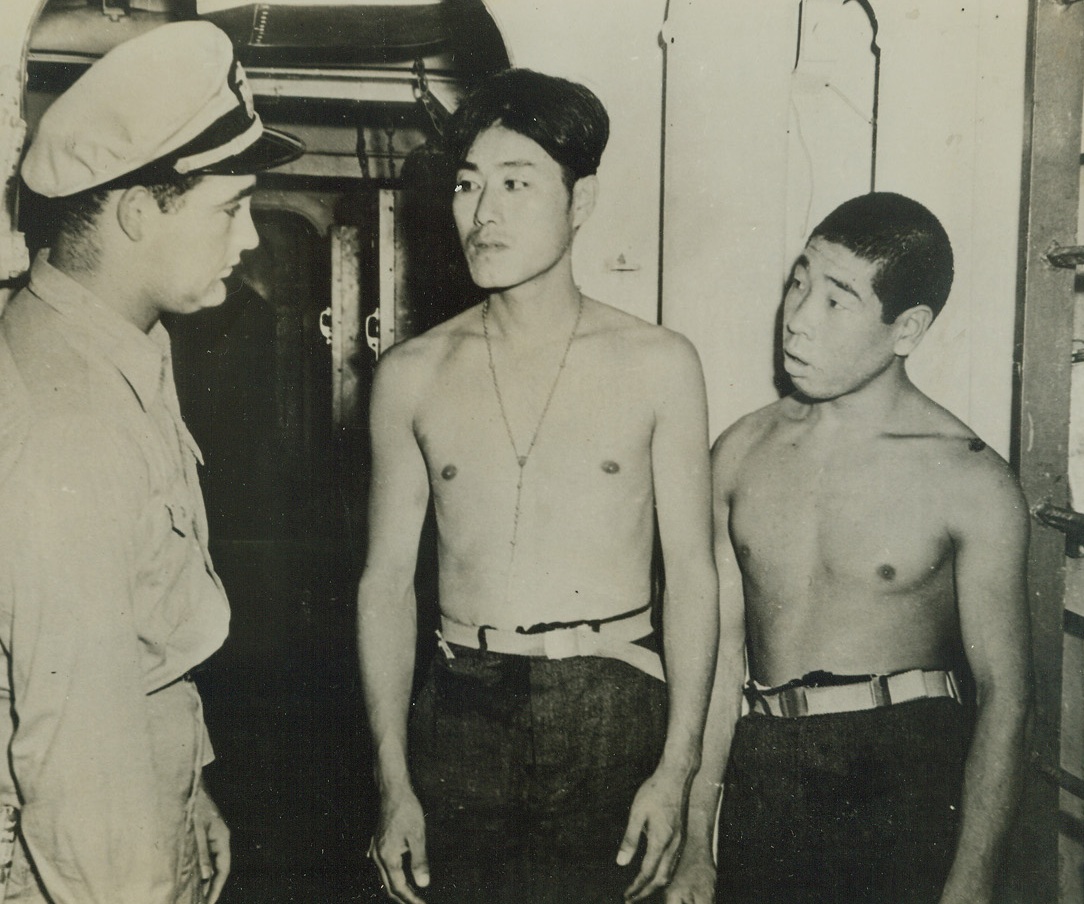
Jap Prisoners Seized in Gilberts, 2/1/1944. South Pacific – An American Naval officer questions two prisoners seized in a raid on an atoll in the Gilbert Islands. The taller of the two, wearing a rosary, claimed to be a Korean—one of the thousands of his countrymen conscripted by the Japs for work battalions. A Jap at the right at first claimed to be a laborer, too, but the Korean put him “on the spot” by signaling to the Naval officer by waving his arms that the man was a Jap flier. Credit: U.S. Army Air Forces photo from ACME;
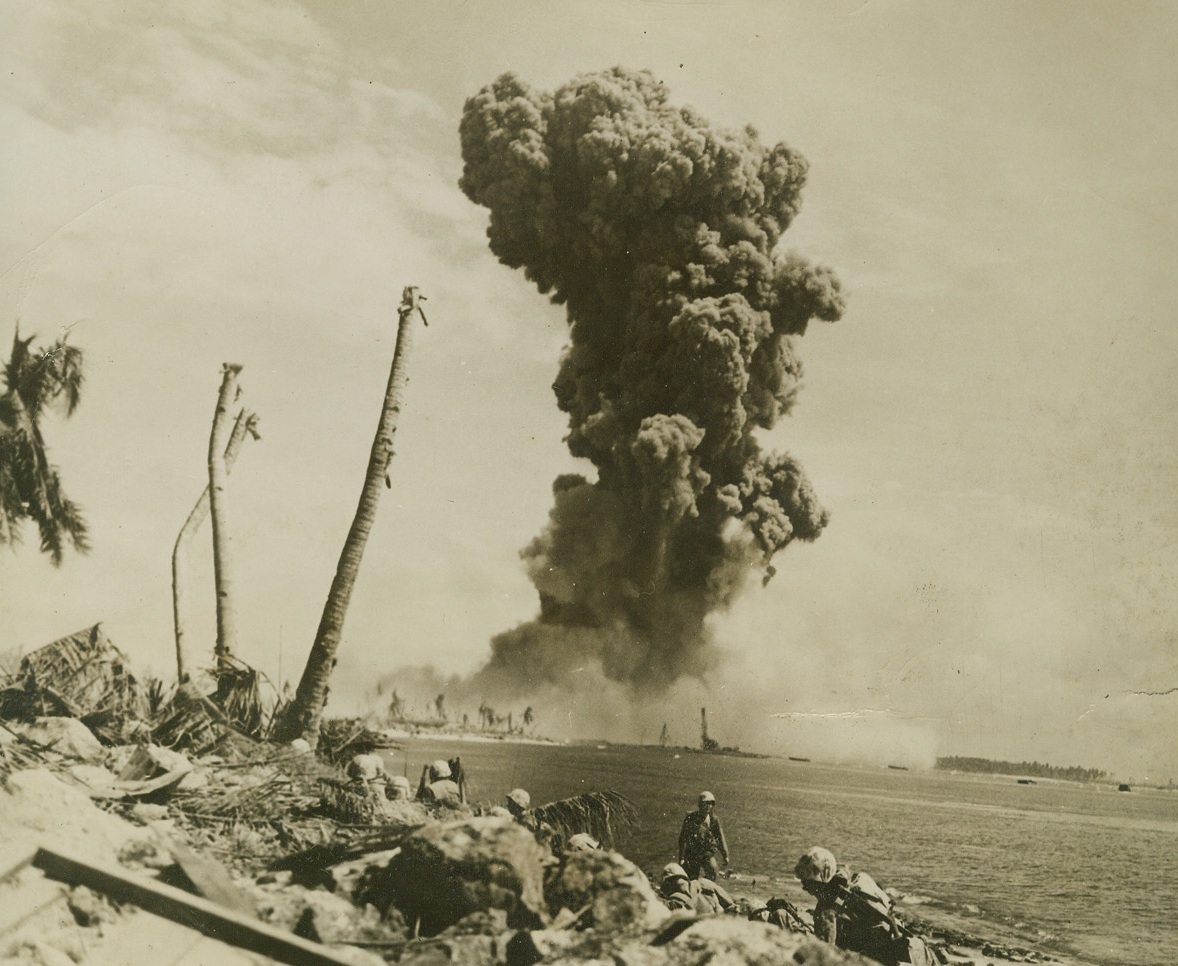
Black Clouds for Tokyo, 2/13/1944. Namur – Jap installations go skyward in the form of smoke as Marine demolition squads do the job on Namur. More Marines return enemy sniper fire on nearby Roi Island beach in foreground. Credit: Official U.S. Marine Corps photo from ACME;
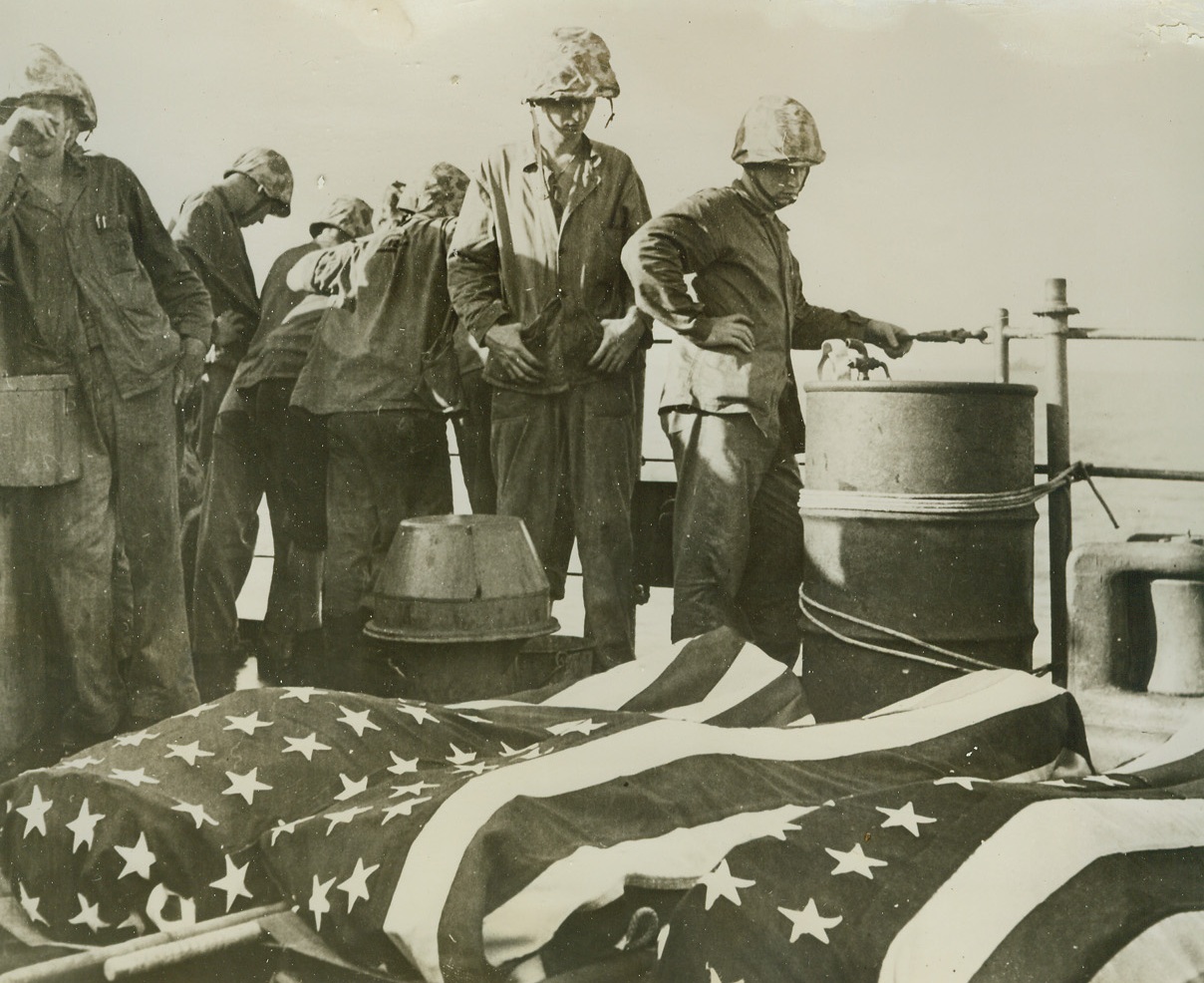
War’s Grim Toll, 2/10/1944.
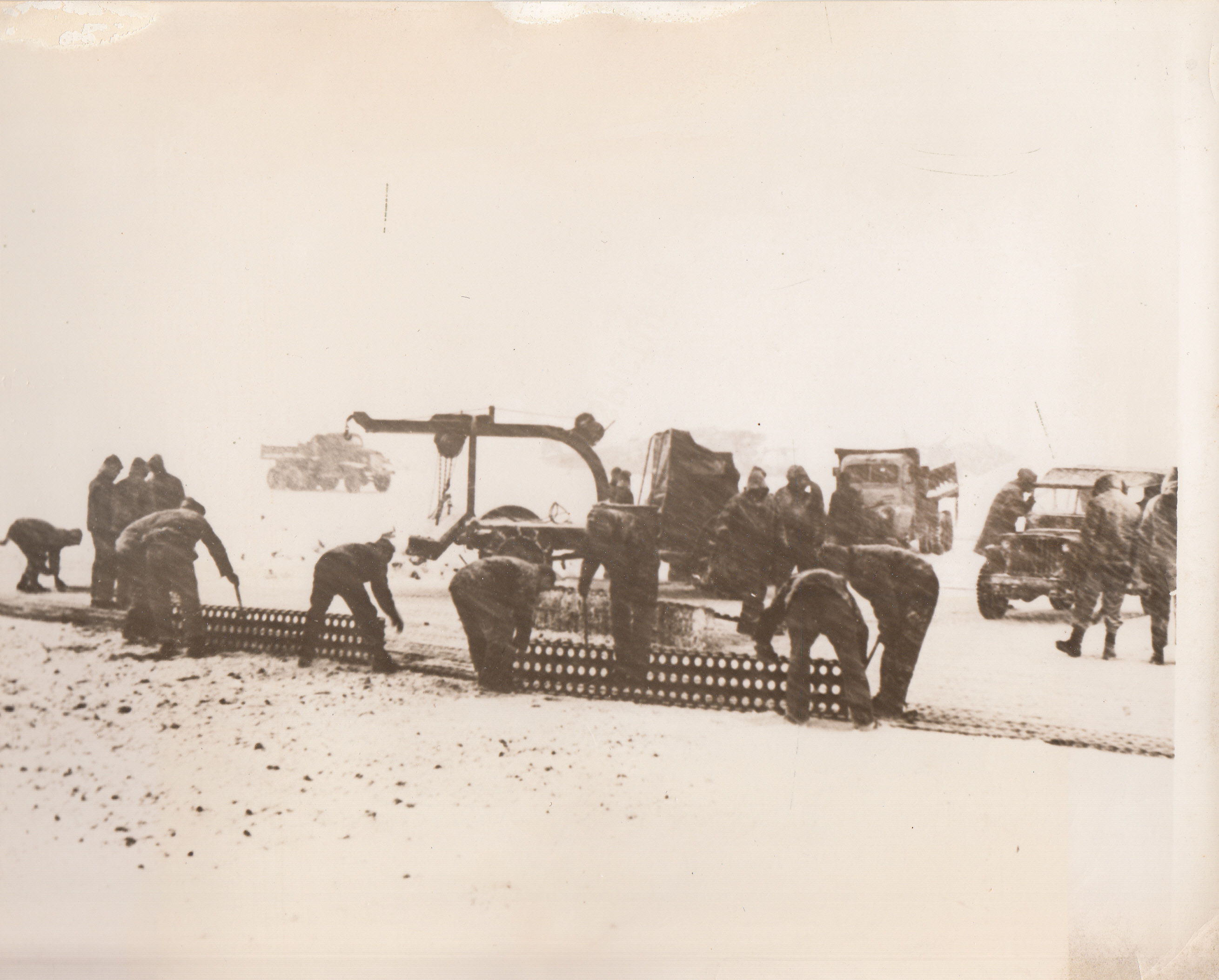
Snowbound Springboard to Paramushiru Aleutians, 2/8/1944. Seabees work through a mile-a-minute gale at an Aleutian base from which American planes take off to bomb Paramushiru, key Jap stronghold in the Kuriles.;
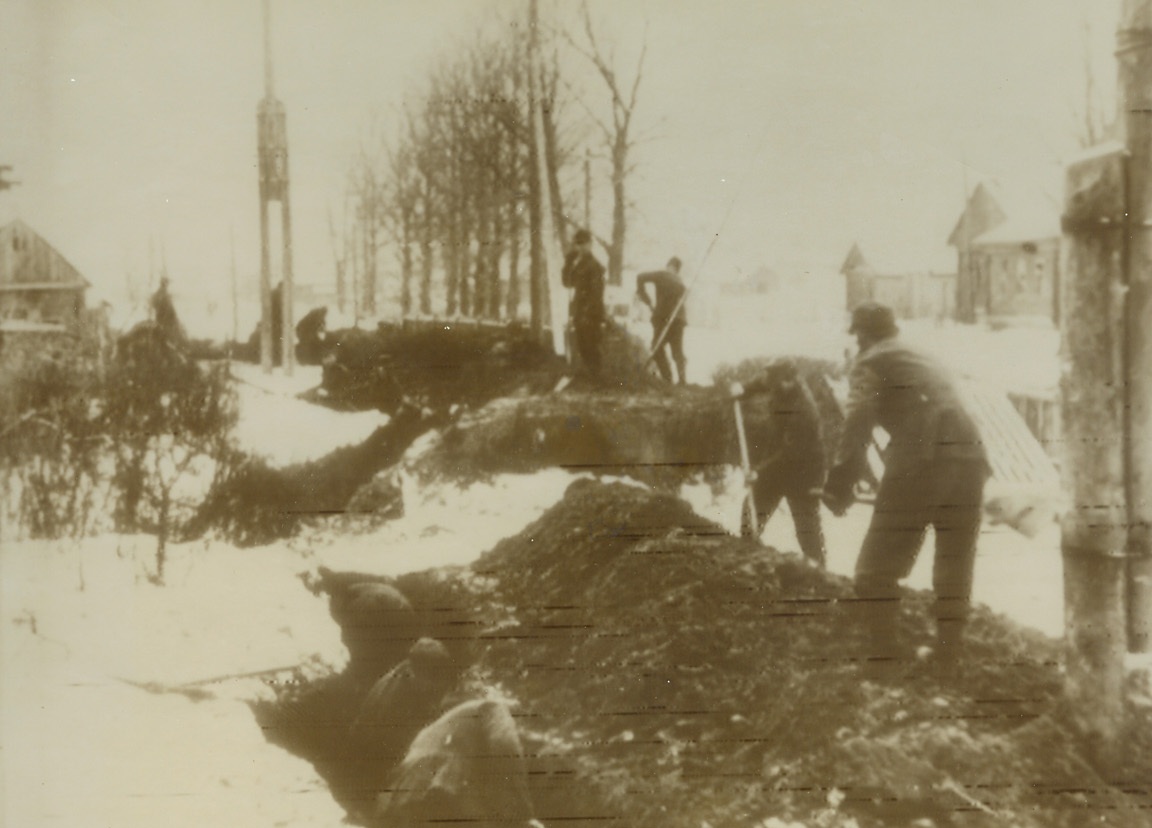
Nazis Dig in on North Russia Front, 2/8/1944. Russia – German soldiers hastily construct trenches on the Northern Russian front in an area named in the German caption as “South of Nevel.” This is in the sector where the Reds have renewed their offensive and taken more than 80 localities in attacks which may form the Southern prong of a great pincers, the Northern arm sweeping through the Leningrad territory.Credit line (ACME radiophoto);
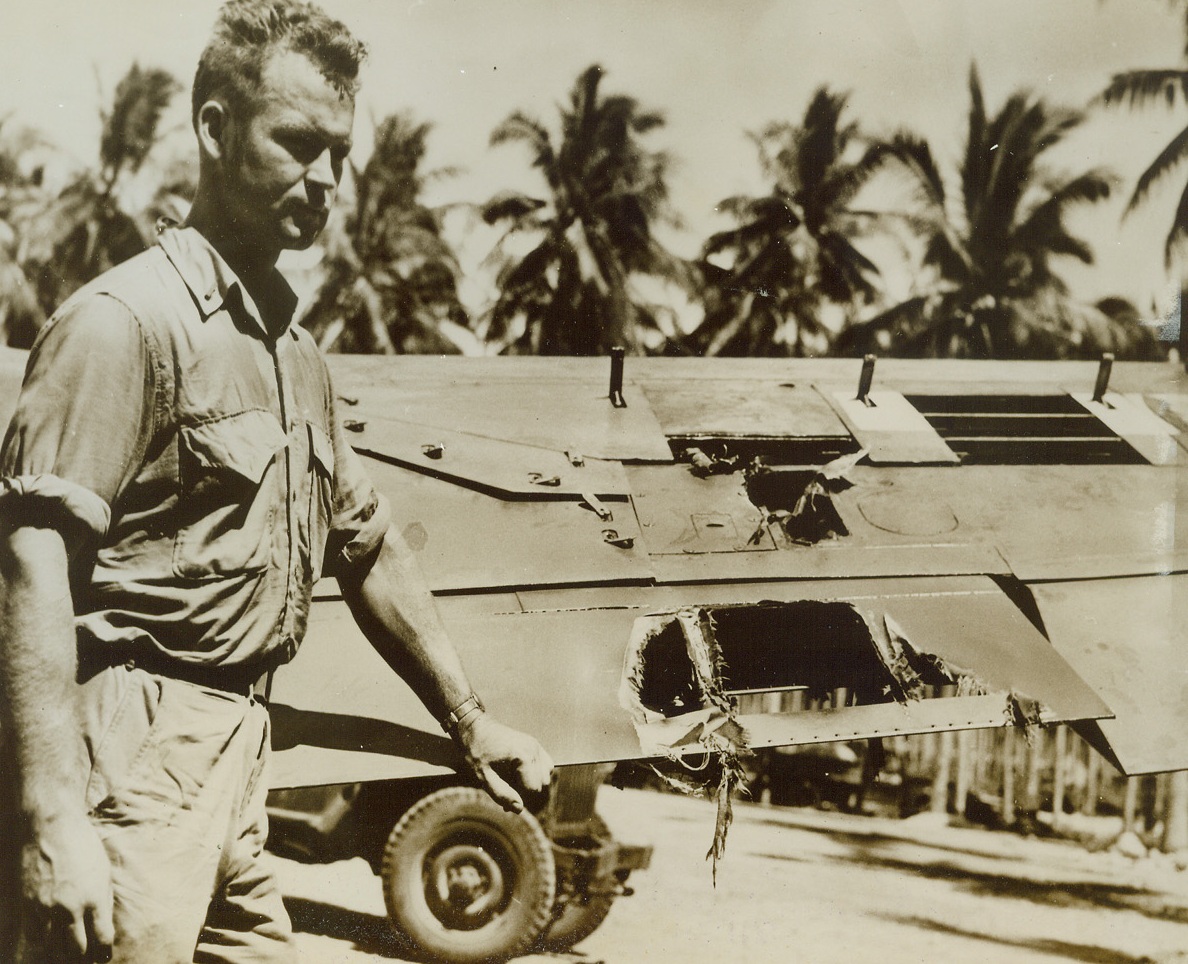
Marine Air Ace Reported Missing, 2/6/1944. South Pacific – Lt. Robert W. Hanson, 23-year-old Marine fighter pilot with a record of 25 enemy planes downed in the South Pacific, has been reported missing in action since Thursday. Lt. Hanson, of Newtonville, Mass., was within one victory of tying the record of Captain Eddie Rickenbacker in World War I. Here, the missing ace inspects the wing of his fighter plane damaged by Jap 20 mm. shells during a fight with a zero. During the battle, Hanson downed the zero.Credit (Official U.S.M.C. photo from ACME);
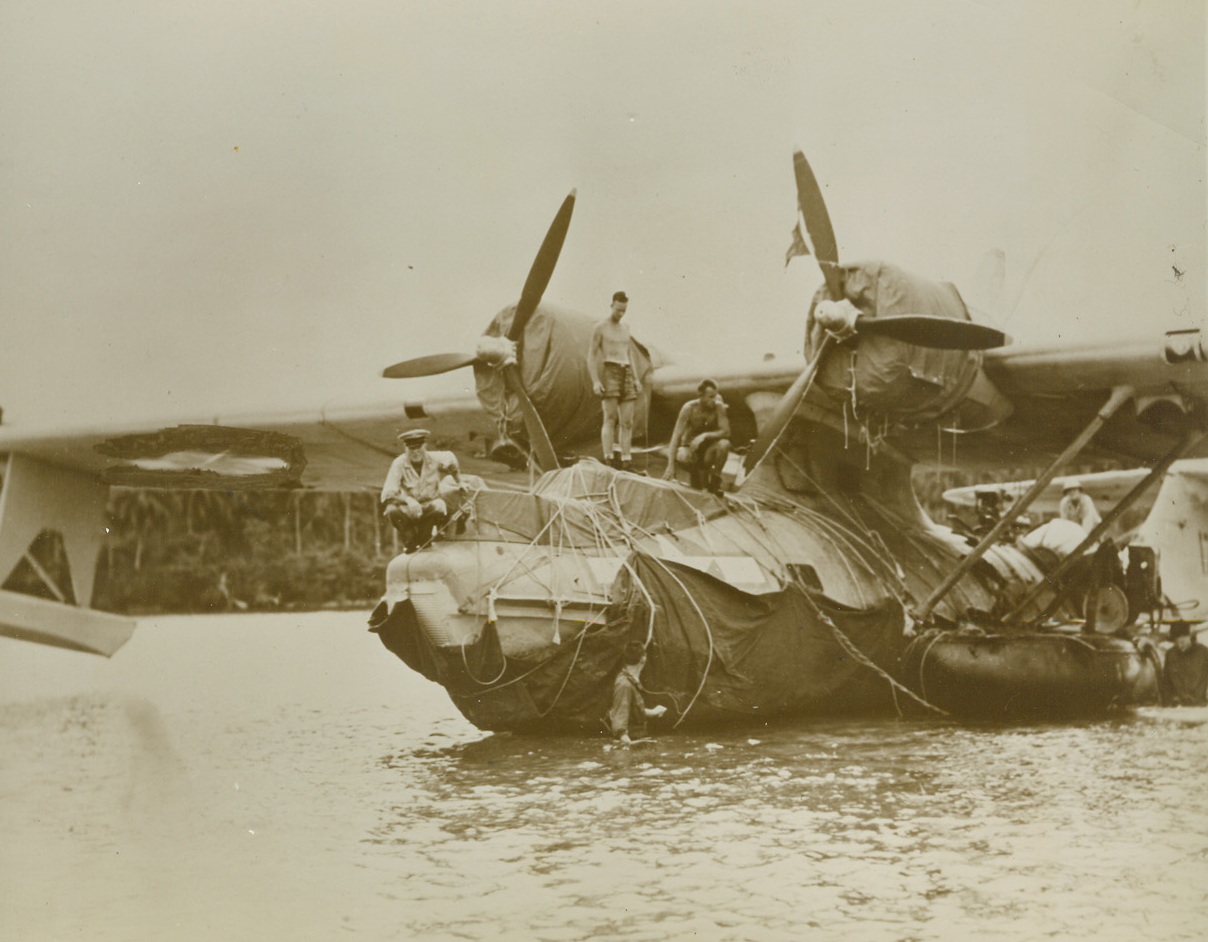
The Seabees Saved Her, 2/6/1944. New Georgia Island – Abandoned as lost when it struck a hidden reef off New Georgia Island in the Solomons, this $250,000 Navy Catalina was salvaged by the Seabees. The construction battalion men lashed tarpaulin around the hull to cover holes in the ship and, using rubber rafts as pontoons, they floated the big ship ashore.Credit line (Official U.S. Navy photo from ACME);
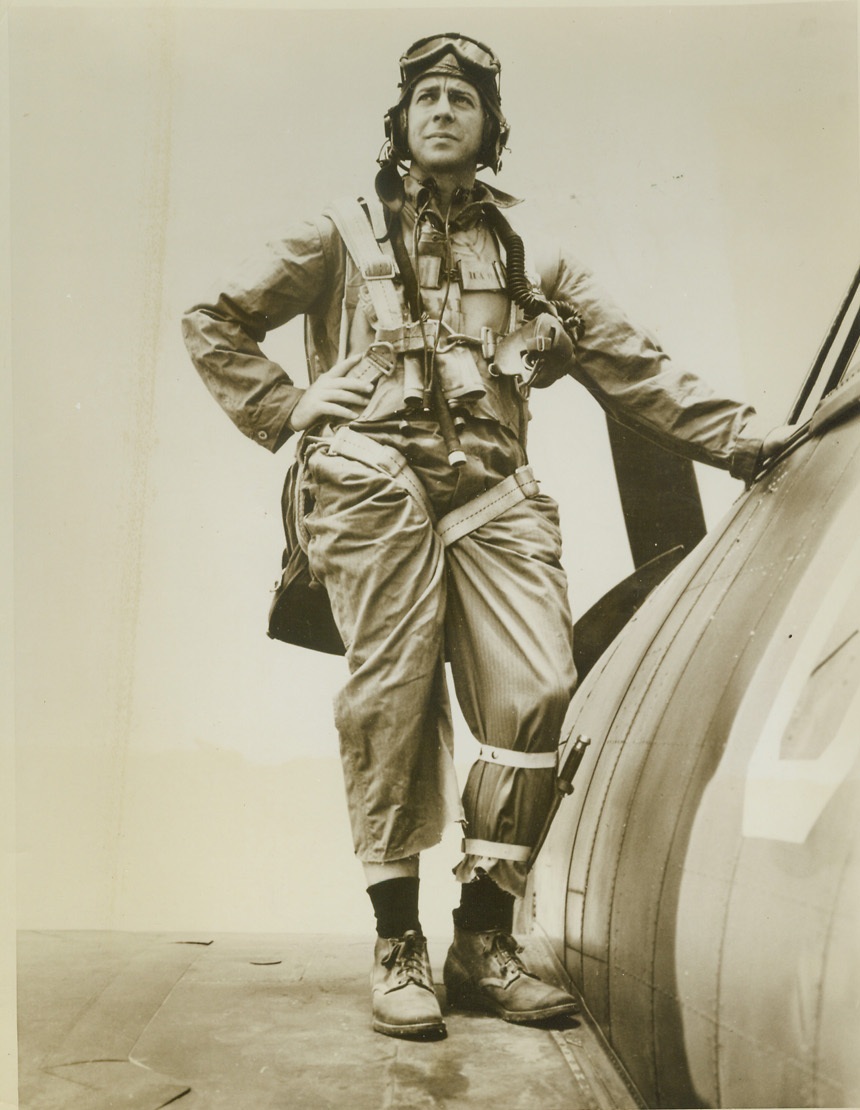
Led Navy Air Fighters on Truk, 2/26/1944. SOUTHWEST PACIFIC - Leader of a U.S. Navy fighter squadron in the daring February 15-16 carrier task force raid on Truk, Lieut. Comdr. W. Harrison, USN, of Miami Beach, Fla., said after the raid: "I saw only nine of about 30 ships left afloat in two anchorages, and three of them were burning." Credit (Official U.S. Navy Photo form ACME);
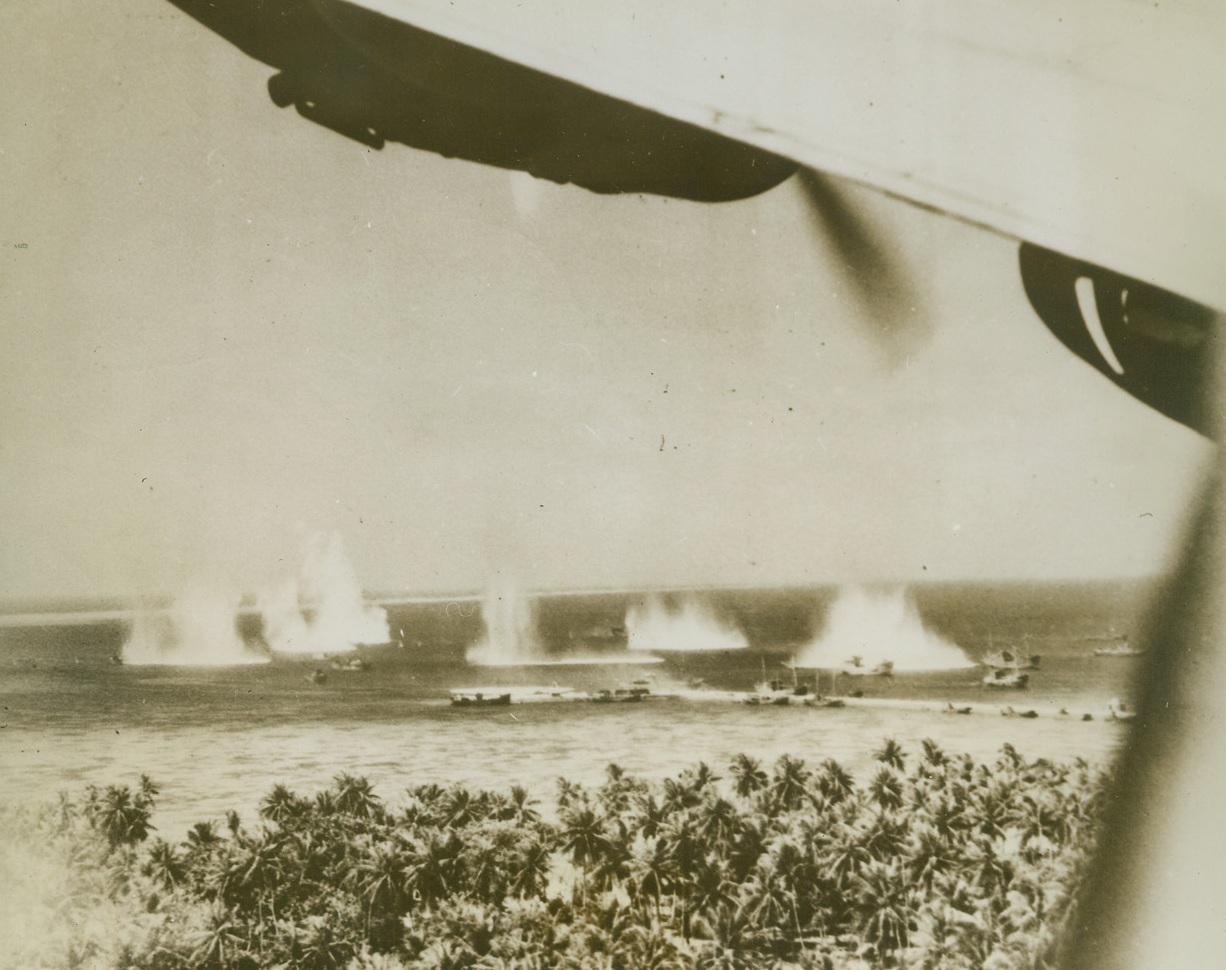
Pre-Invasion Blast at Jap Ships, 2/15/1944. Marshall Islands – Japs ships at Kwajalein atoll are rocked by bombs, as U.S. Navy planes to Marine and Army infantry invasion. The plane from which the picture was taken banks sharply to return to the attack, its wing at upper right.Credit (U.S. Navy photo from ACME);
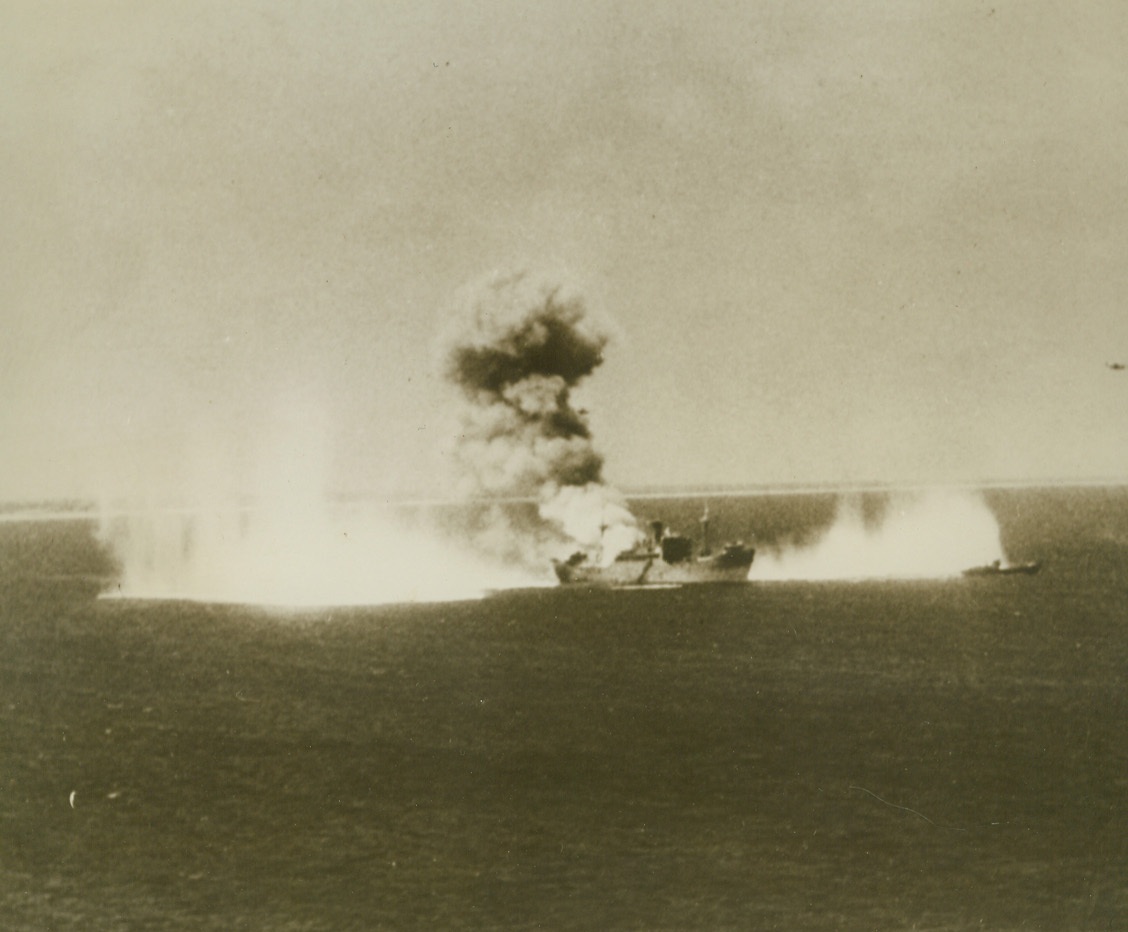
Japs Got a Taste of Things to Come, 2/15/1944. Marshall Islands – Low flying Navy bombers fire a Jap merchantman off Kwajalein Atoll, as part of the softening up exercises that preceded invasion by Marine and infantry forces. Near-misses kick up a lot of water near the ship that suffered direct hits amidships.Credit (U.S. Navy official photo from ACME);
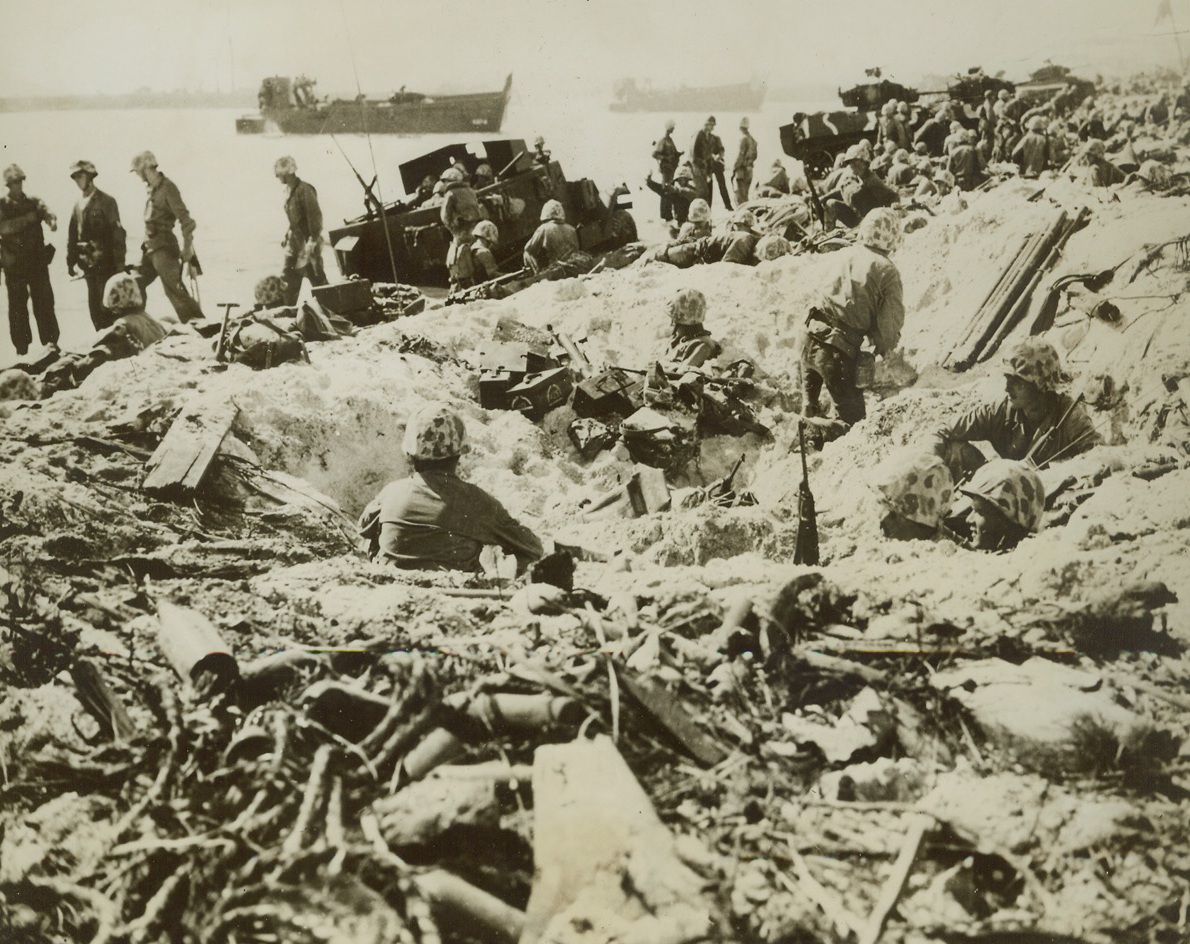
From Shellhole to Foxhole, 2/14/1944. Marshall Islands – U.S. Marines take advantage of the protection offered by shell holes as tanks, half-tracks and other equipment are unloaded from their landing craft on Namur Island where the heaviest fighting of the recent Marshalls action took place. The Leathernecks eliminated all enemy resistance on the island within 24 hours.Credit (U.S. Marine Corps photo from ACME);

Wants to "Get it Over", 2/28/1944. ASSAM -- Sgt. William H. Hancock (left) USA, of Rockhill, S.C., was given a chance to go home on leave after serving two years in the CBI Theater, under the new policy which gives a man a furlough after two years service. But the Sergeant turned down the chance, even though he was anxious to get home, because he wants to stay and get the war over. A Chinese pal is shown with Hancock. Credit: (ACME Photo by Frank Cancellare for the War Picture Pool);
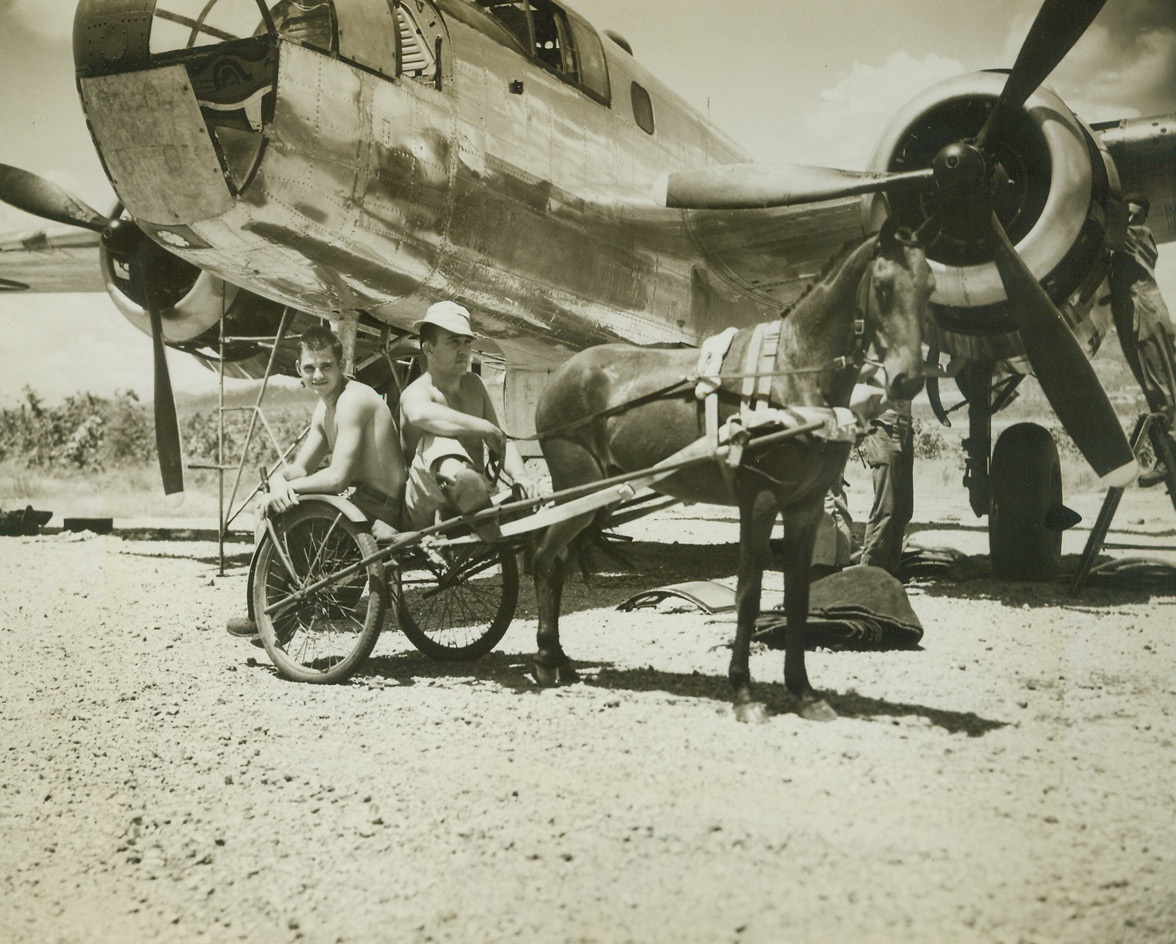
“One-Colt Shay”, 2/17/1944. New Guinea – Here is the modern version of the famous “One Horse Shay” – But it is put together to stay, by mechanics at this advanced U.S. 5th Army Air Force base “somewhere in New Guinea,” and made of bicycle wheels, airstrip matting, and an old parachute harness. The colt, named “Tarzan”, draws the sulky, giving Sgt. Taylor Tyra (right), of Louisville, KY., the airfield’s cook; and Pfc. Harley Janisch, of Montello, Wisc., a ride. The boys pass a Mitchell B-25 strafing bomber, on their way to take a swim.Credit Line (ACME photo by Thomas L. Shafer for the War Picture Pool);

Marines Hit the Beach at Eniwetok, 2/25/1944. Eniwetok Island – Marines crouch in surf on beach of Eniwetok Island, waiting for naval and air bombardment to lift before they storm Jap positions on island.Credit Line (ACME);
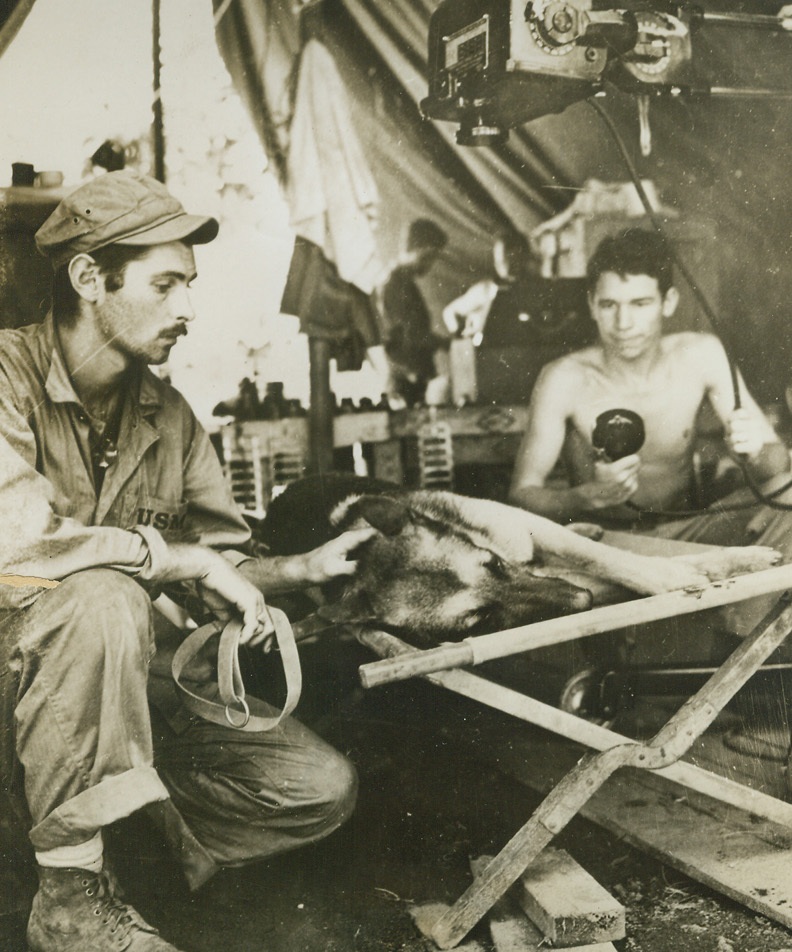
Wounded Dog Completes Mission, 2/12/1944. Bougainville – A Marine Corps messenger dog with a bullet in his spine lies quietly on a cot in the Bougainville sick bay while a Navy Corpsman X-rays him. Shot by a Jap sniper while carrying a message, the German Shepherd completed his mission and was rushed to the hospital. Doctors could not remove the bullet without sacrificing his life.Credit Line (U.S. Marine Corps photo from ACME);
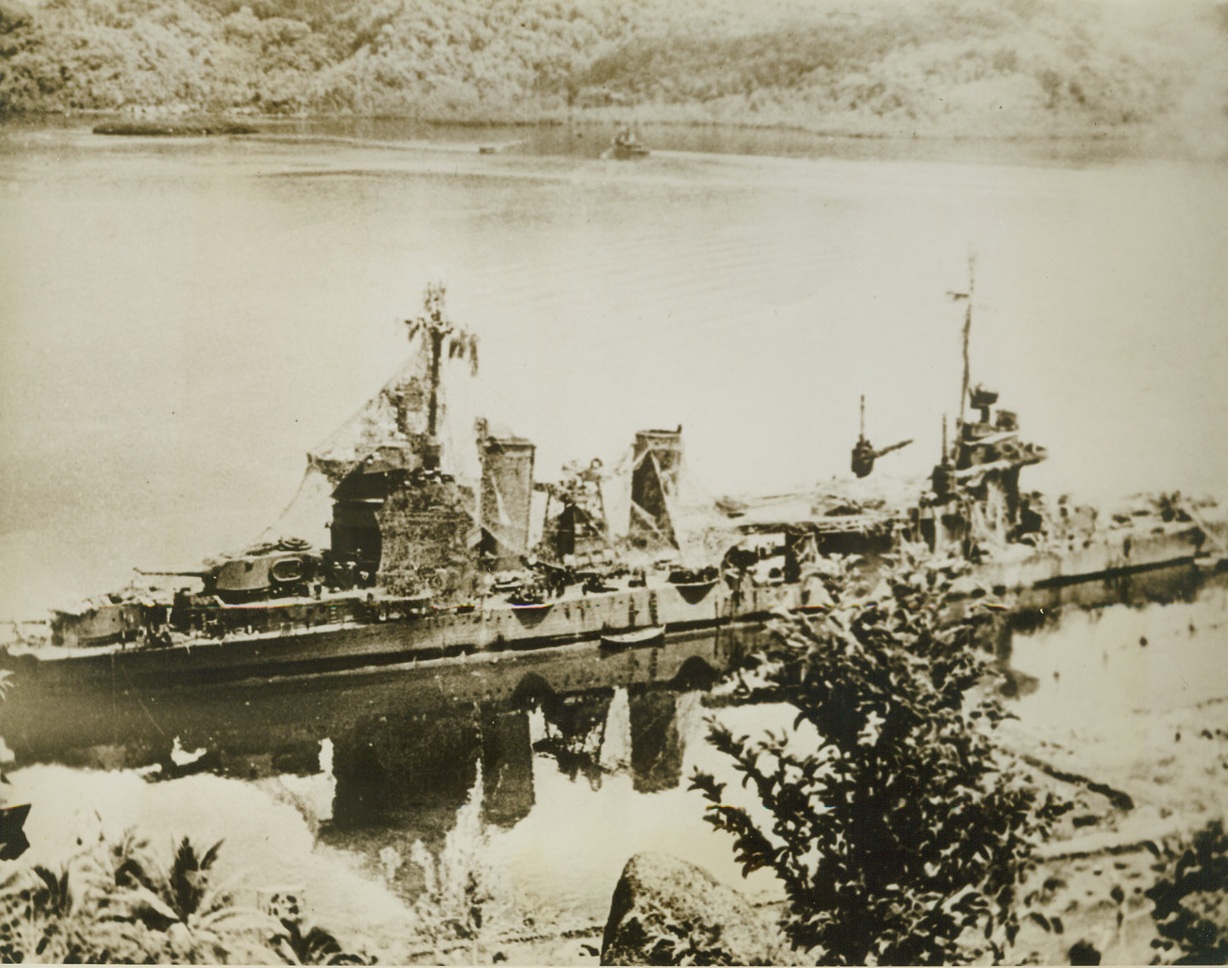
Has Shed Her Cobwebs, 2/26/1944. Tied up in Tulagi Harbor after she was badly damaged in the battle for Tassafaronga, November, 1942, the cruiser Minneapolis wears a “cobweb” camouflage dress over her super structure as she awaits repairs enabling her to journey to Pearl Harbor and then San Francisco. Now, the gallant cruiser is back in the U.S. Navy offensive against far-flung Japanese bases in the Pacific.Credit (Official U.S. Navy photo from ACME);
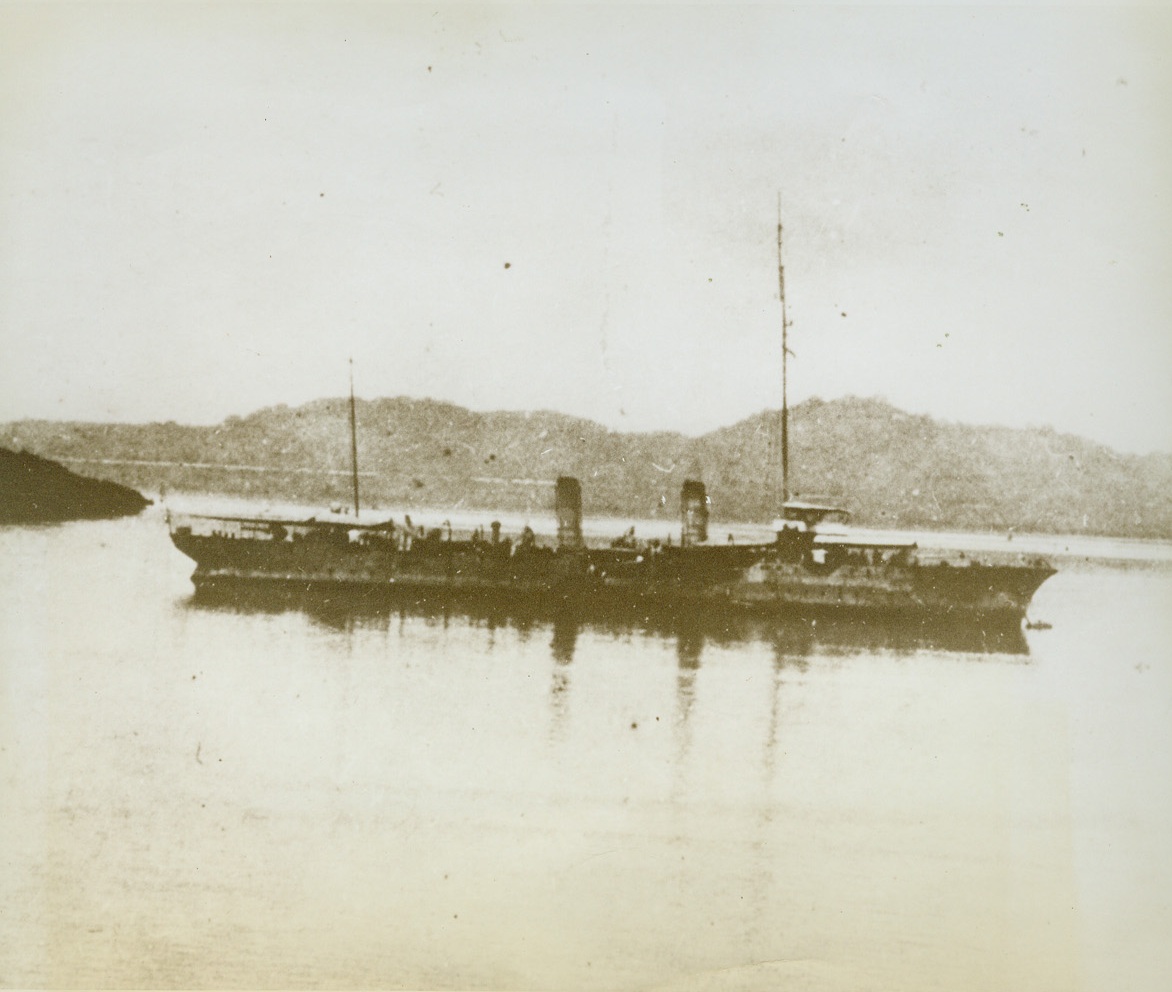
View of Truk, 2/20/1944. The old Japanese cruiser “Yodo” is shown at anchor in one of the numerous harbors at Truk. This photo was made during the pre-war period when the Japs were fortifying the archipelago and building what they thought would be an impregnable fortress. They discovered how wrong they were when a powerful U.S. Navy Task force hurled destruction into the mountain-studded lagoon.Credit Line (official U.S. Navy photo from ACME);

Yanks Raid Jap Base at Dagua, 2/19/1944. Dagua, New Guinea - - Parachute bombs drift down toward Jap Zeros parked on Dagua airfield and smoke rises from the besieged area as B-25 Mitchell bombers of the Fifth Air force stage a surprise raid on the enemy base. The smoke is coming from an oil dump fire which was started by an earlier wave of bombers. The Japs were caught completely unaware.Credit (U.S. Army Air Forces photo from ACME);

To Their Ancestors, 2/19/1944. Kwajalein Atoll – Coast Guard Ensign Robert C. Preston of New London, Conn., stops to look at the bodies of two Japanese imperial Marines on Kwajalein Atoll in the Marshalls. The enemy fighters lie stiffly before their silenced pillbox in which 23 more dead Japs were found.Credit Line (U.S. Coast Guard photo from ACME);
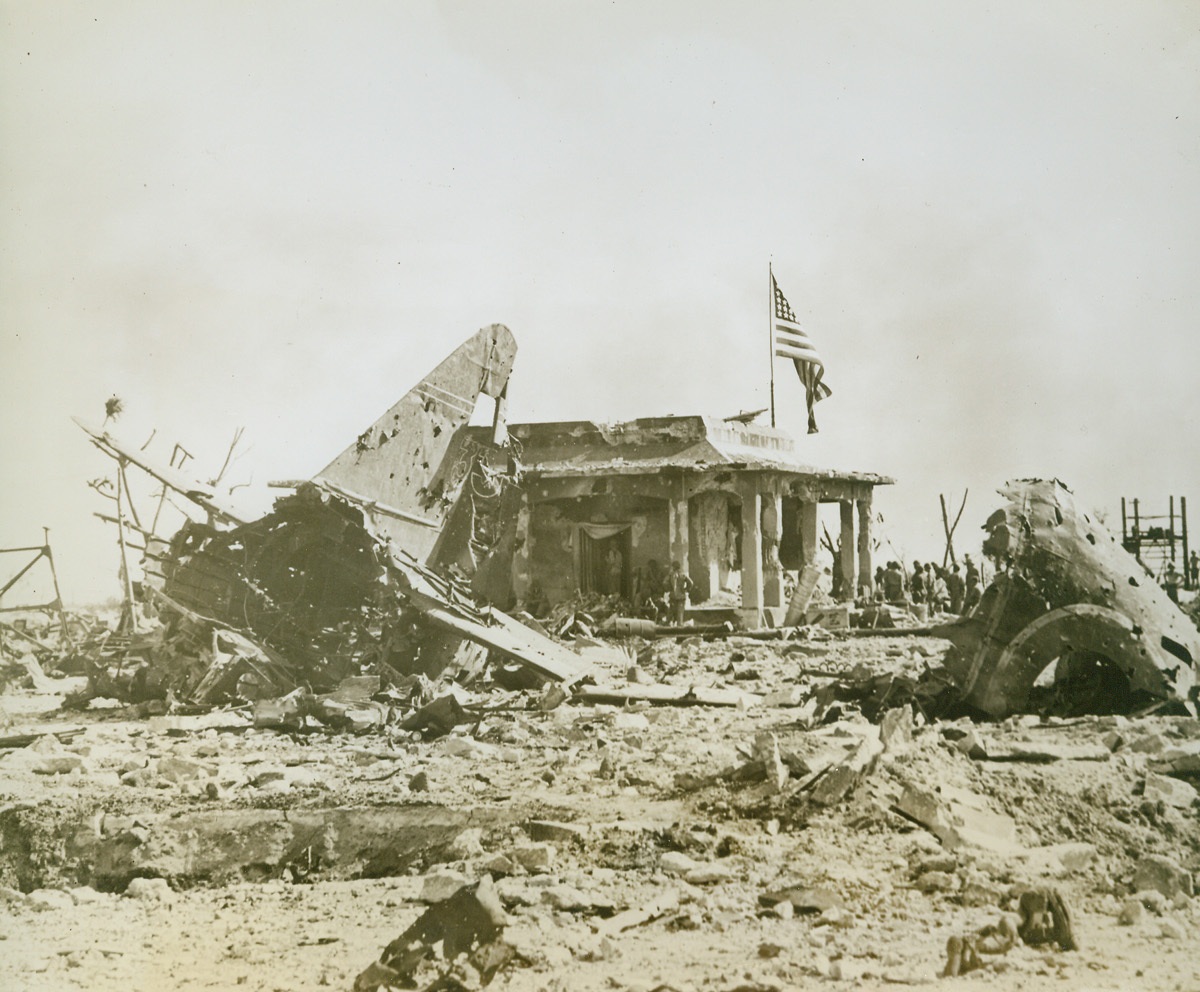
Where Stars Outshone the Rising Sun, 2/19/1944. Namur Island - - The stars and stripes over the battered, former Jap headquarters proclaim complete U.S. victory over Namur island. What is left of a Japanese bomber (foreground) rests amidst rubble and bits of blased concrete.Credit (U.S. Navy photo from ACME);
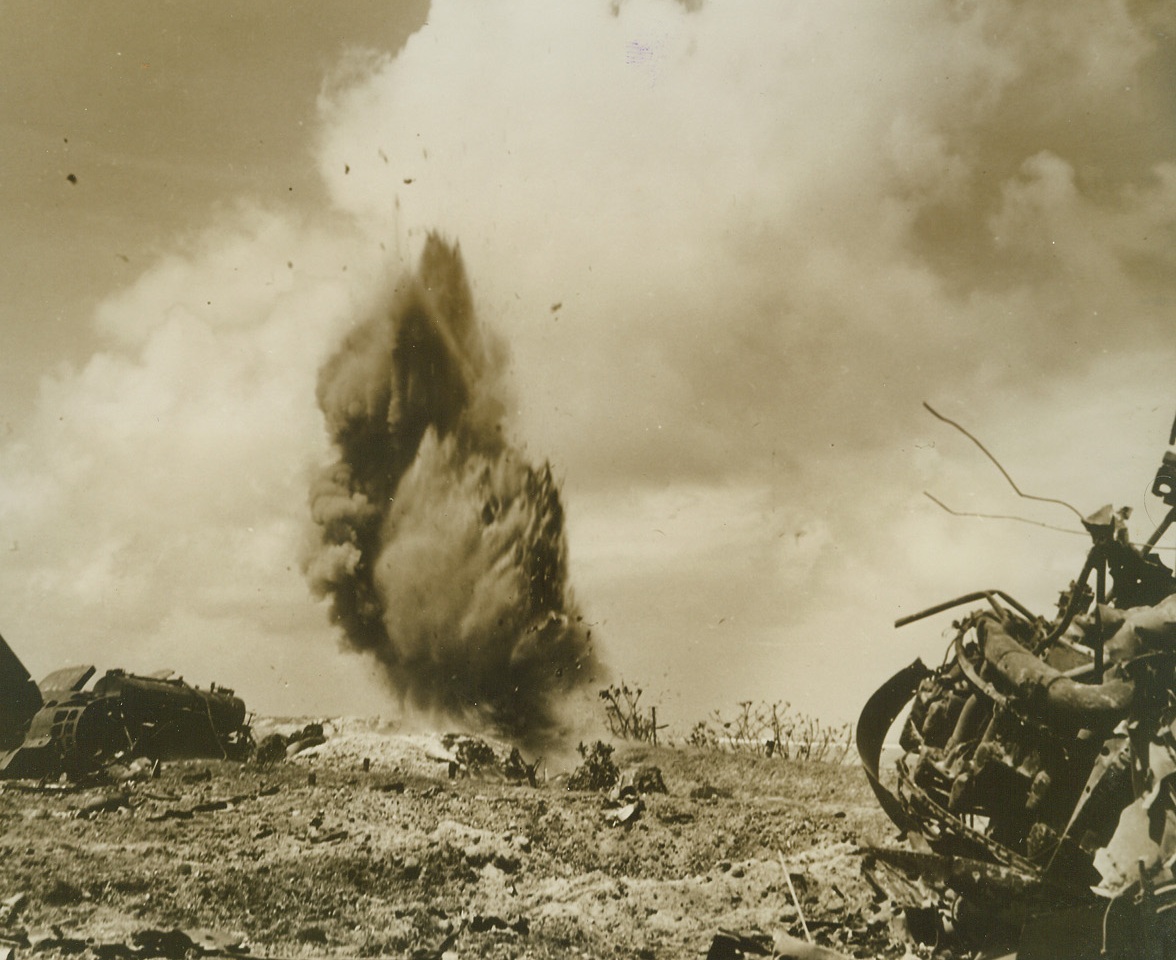
Funeral Pyre for Jap Riflemen, 2/26/1944. Marshall Islands – A towering geyser of smoke and debris marks the extinction of a number of Japanese riflemen who were blown up along with their fortified dugout by U.S. Marine “detonation squads” during the advance over Kwajalein Atoll in the Marshalls on February 1.Credit (Official U.S. Navy photo from ACME);
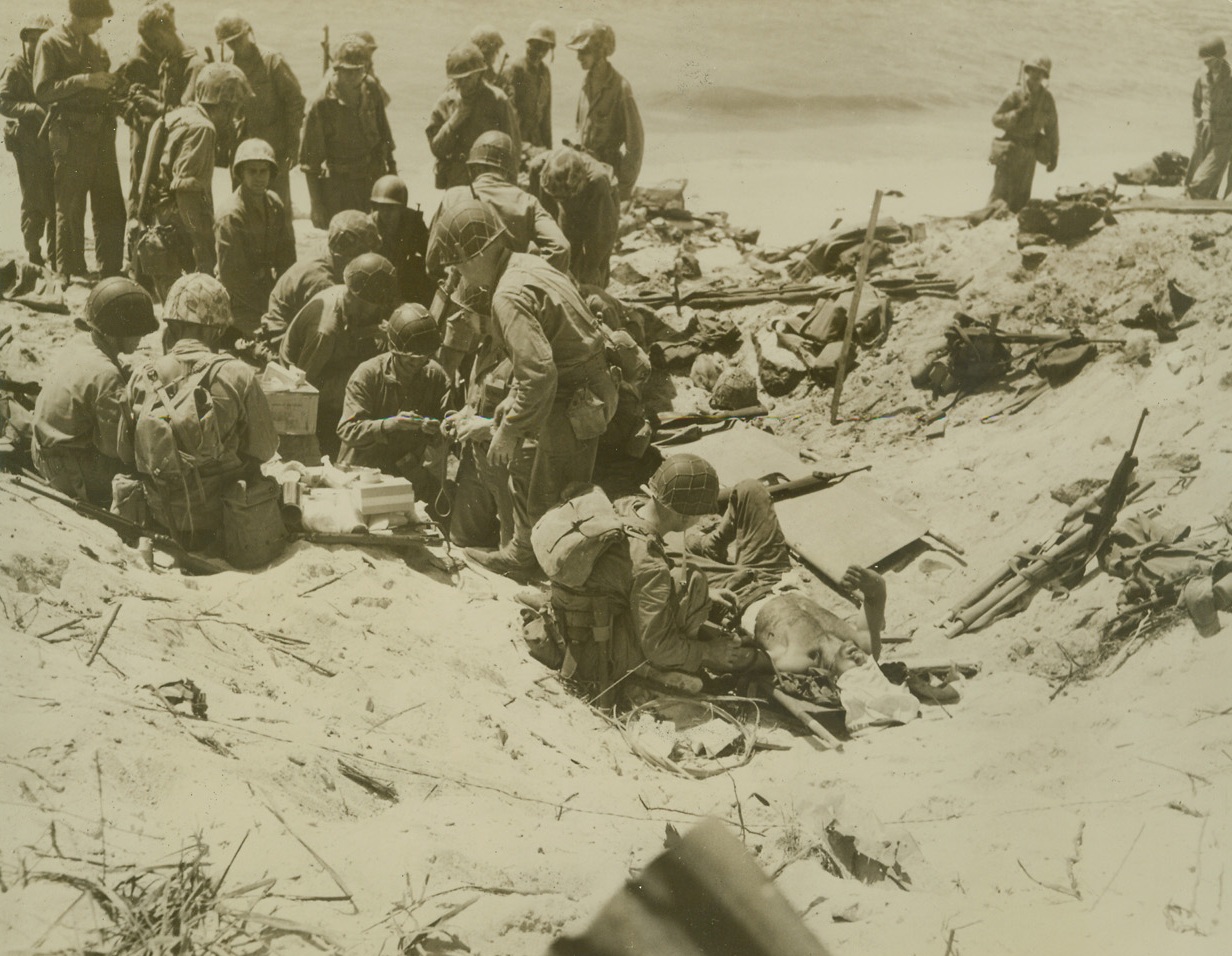
New Strength For The Wounded, 2/28/1944. Eniwetok Atoll – Medical corpsmen give blood transfusions to the Marines who were wounded wresting Eniwetok island from veteran Japanese fighters. In the foreground, a Leatherneck receives plasma while in the background other corpsmen get supplies to be rushed to nearby wounded.Credit (Official Coast Guard photo from ACME);

Yanks Batter Jap Mariana Bases, 2/24/1944. The first American attack on the Mariana islands, Jap bases 1,300 miles South of Tokyo, was made by a powerful Pacific fleet task force, last Feb 22. The target of U.S. carrier-based torpedo and dive bombers were Saipan and Tinian islands, at the Southern end of the Marianas. In this photo, taken before World War two, and just released in Washington, railroad tracks lead to a Jap sugar refinery at Sunharon, on Tinian island.Credit Line (U.S. Navy official photo from ACME);

Moving Day for Natives, 2/9/1944. ENIWETOK - While the battle rages for islands of the Eniwetok Atoll in the Marshalls, this family of natives is removed from the danger area in a Coast Guard manned landing craft, which a few moments before had landed assault troops on the island. In foreground, the native father carries his nude daughter pig-a-back, while, in front of him, mother totes a tiny son in her arms.;
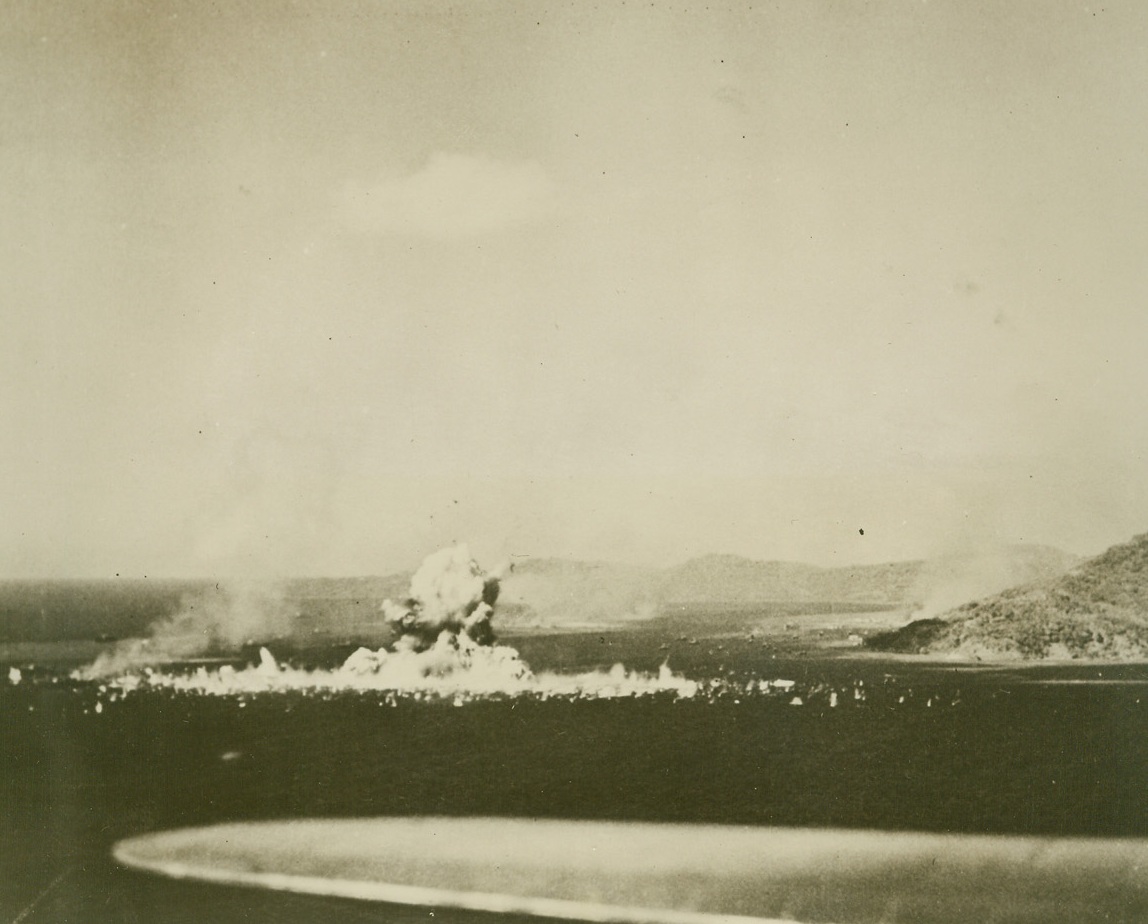
Nip Ship Does “Disappearing Act”, 2/28/1944. Truk—In one huge gout of smoke and debris, a Japanese ammunition ship is blasted to pieces as it receives a direct hit from a U.S. Navy dive bomber, one of the carrier-based aircraft taking part in the recent attack on the Nip Pacific stronghold of Truk, in the Caroline islands. The American plane scoring the hit was caught in the blast and destroyed during the raids by a huge U.S. Task force on Truk Feb 16-17, 23 Jap ships were sunk, six probably sunk, and 11 damaged.Credit Line (U.S. Navy photo from ACME);
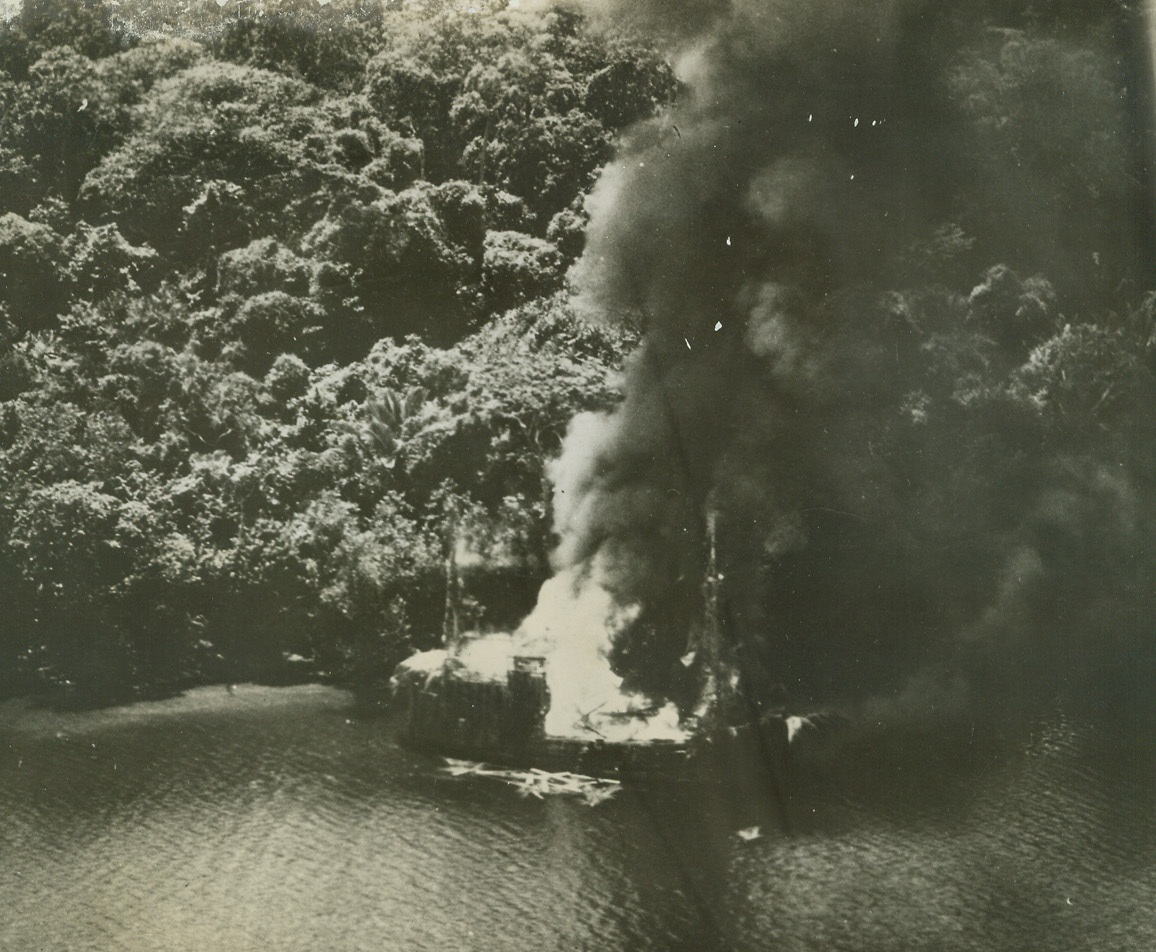
Nip Truck Nipped, 2/24/1944. New Guinea – This Jap barge attempted to sneak down the North coast of New Guinea, covered with camouflage and moving close to overhanging trees ashore, but Australian Beaufighters spotted the ship and blastd it. Here, it is aflame from stem to stern after bombs of the Royal Australian Air Force had caught her.Credit Line (R.A.A.F. photo via U.S. Army Air Forces from ACME);
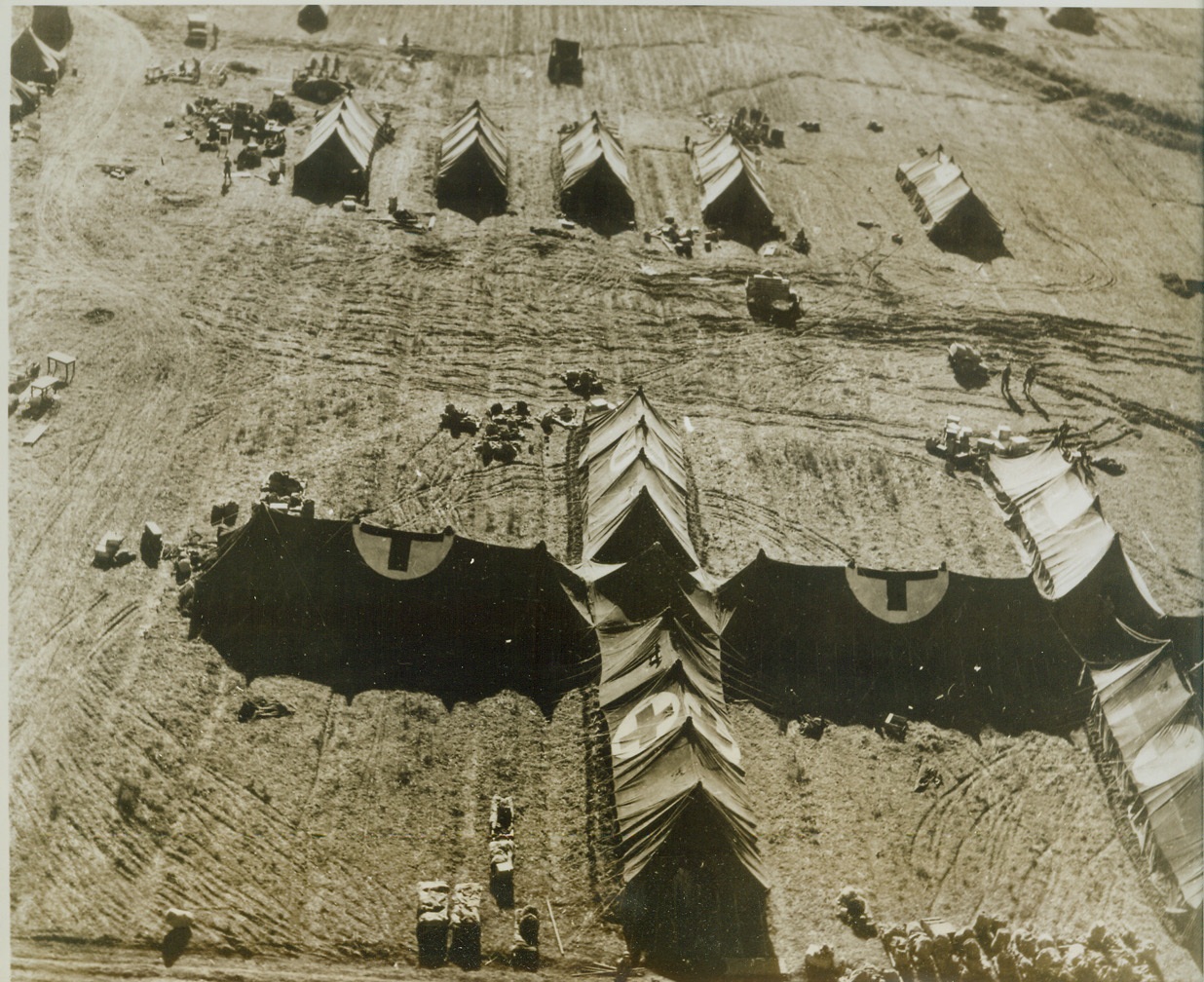
No Mistaking Hospital Markings, 2/11/1944. ITALY -- Red crosses on white backgrounds plainly mark an American field hospital outside of Nettuno; the type of tent hospital twice bombed by the Nazis in the past few days. On February 10, the Germans killed two women nurses and wounded four medical officers and three enlisted patients during an early evening bombing. Credit (ACME Photo by Charles Seawood, War Pool Correspondent);
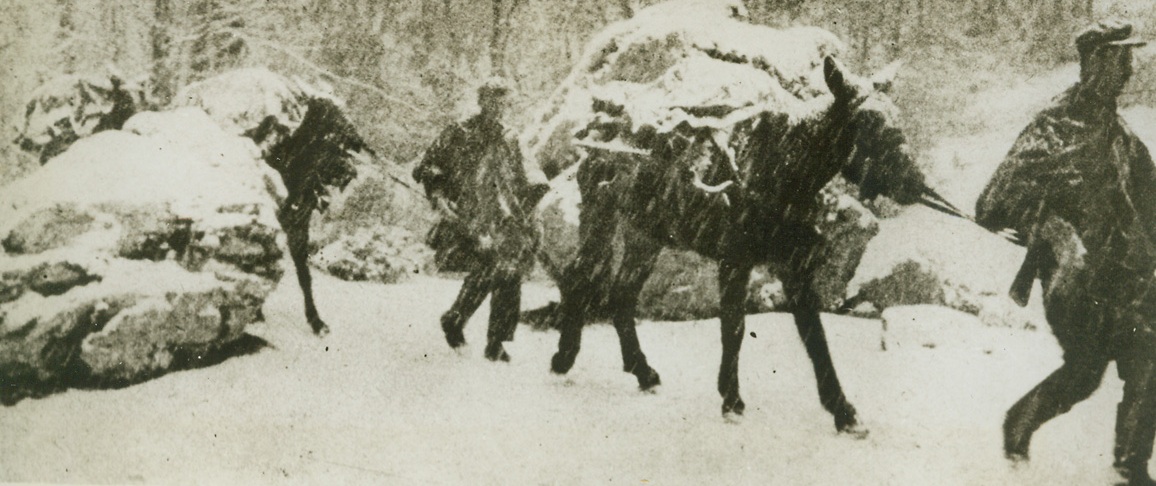
That Nasty Russian Winter Again, 2/2/1944. SOMEWHERE ON THE RUSSIAN FRONT—That nasty old man, the Russian winter, is bringing nightmares in the daytime to Hitler’s soldiers again. Ill clad and almost blinded by the snow, the hapless Nazis retreat, leading their pack mules back from the central Soviet front. Photo obtained through a neutral source.Credit: ACME;
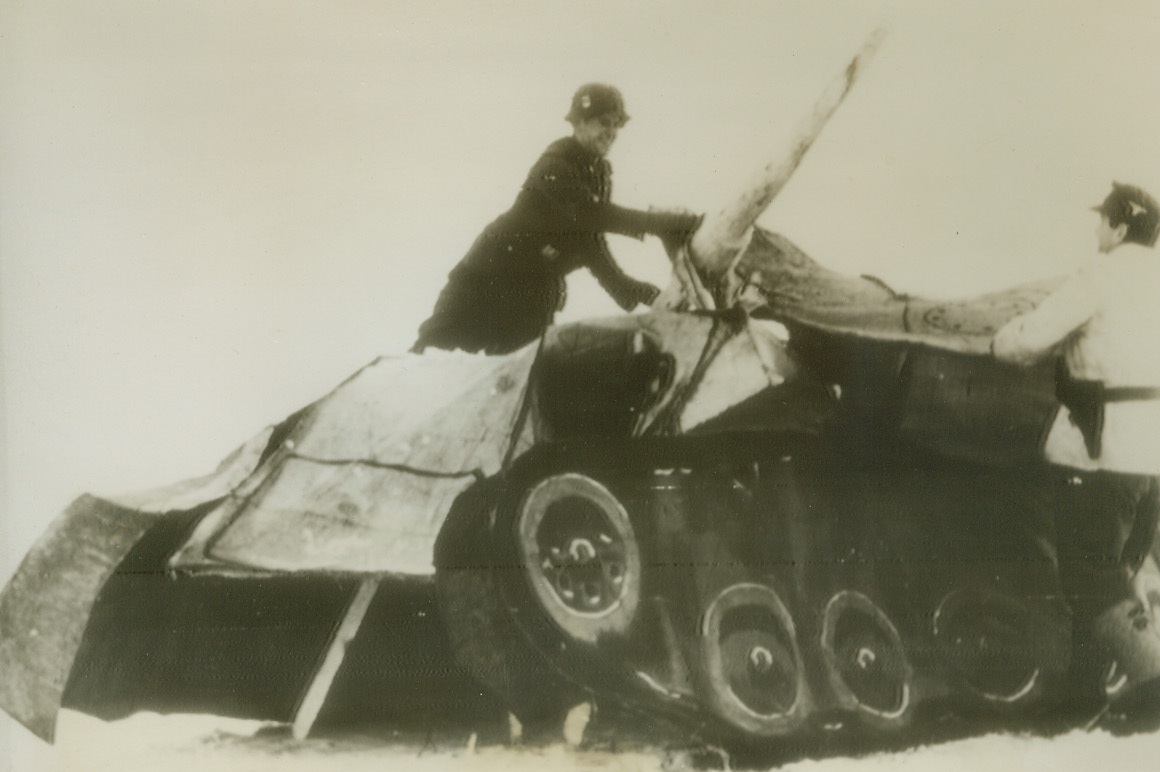
Joke’s On Them, 2/22/1944. RUSSIA—A German soldier can afford to smile as he discovers that a Russian “tank” is a dummy fashioned of wood and canvas. According to the Nazis, who wish that all Russian war machines were made of similar substance, whole fields of the dummy tanks were discovered at Pogrebichtche. Radioed from New York to Stockholm today.Credit: ACME;
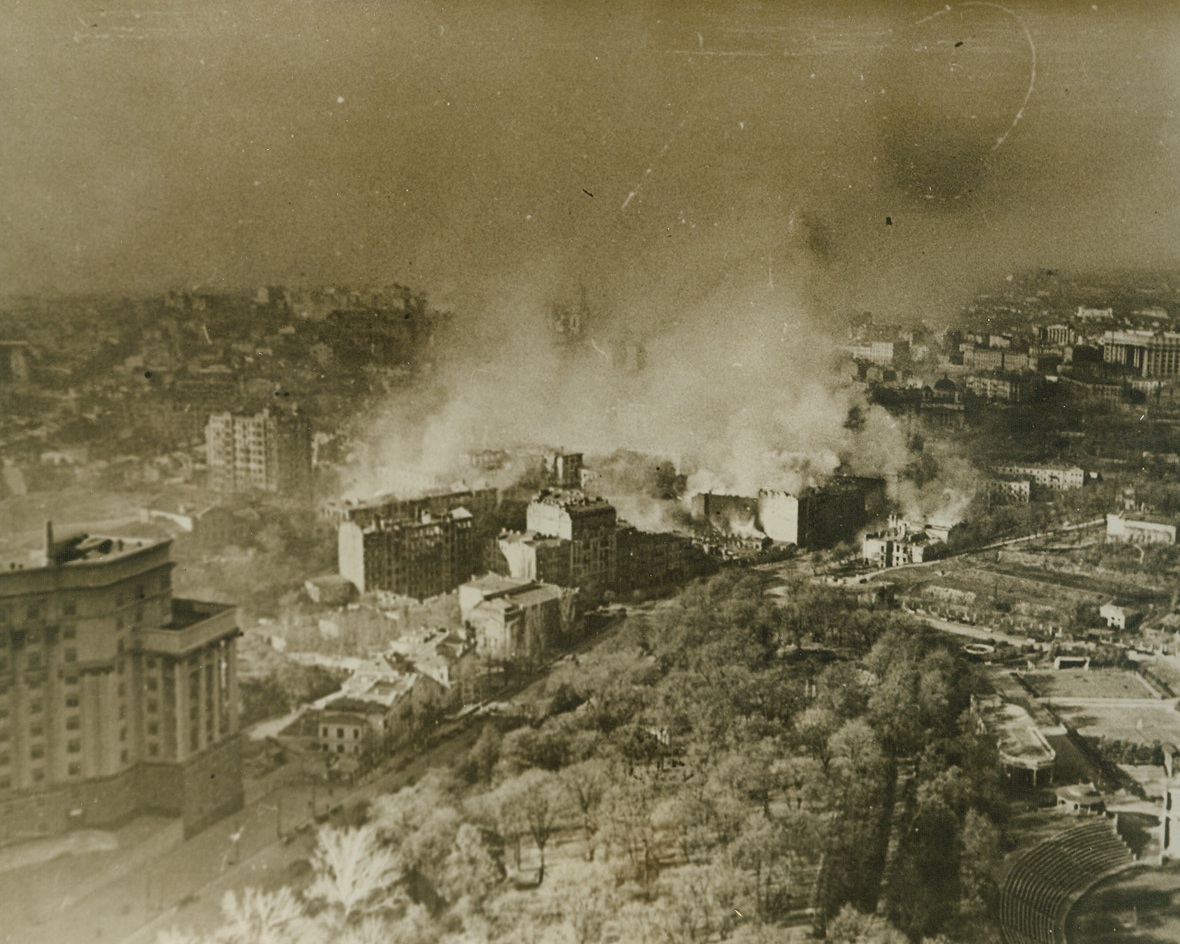
As Germans Retreated from Kiev, 2/9/1944. This photo, just released in the United States, shows the central part of the Russian city of Kiev burning after Nazi demolition and incendiary squads carried through their “scorched earth” orders before retreating in the face of powerful Soviet forces. Passed by censors.Credit: ACME;
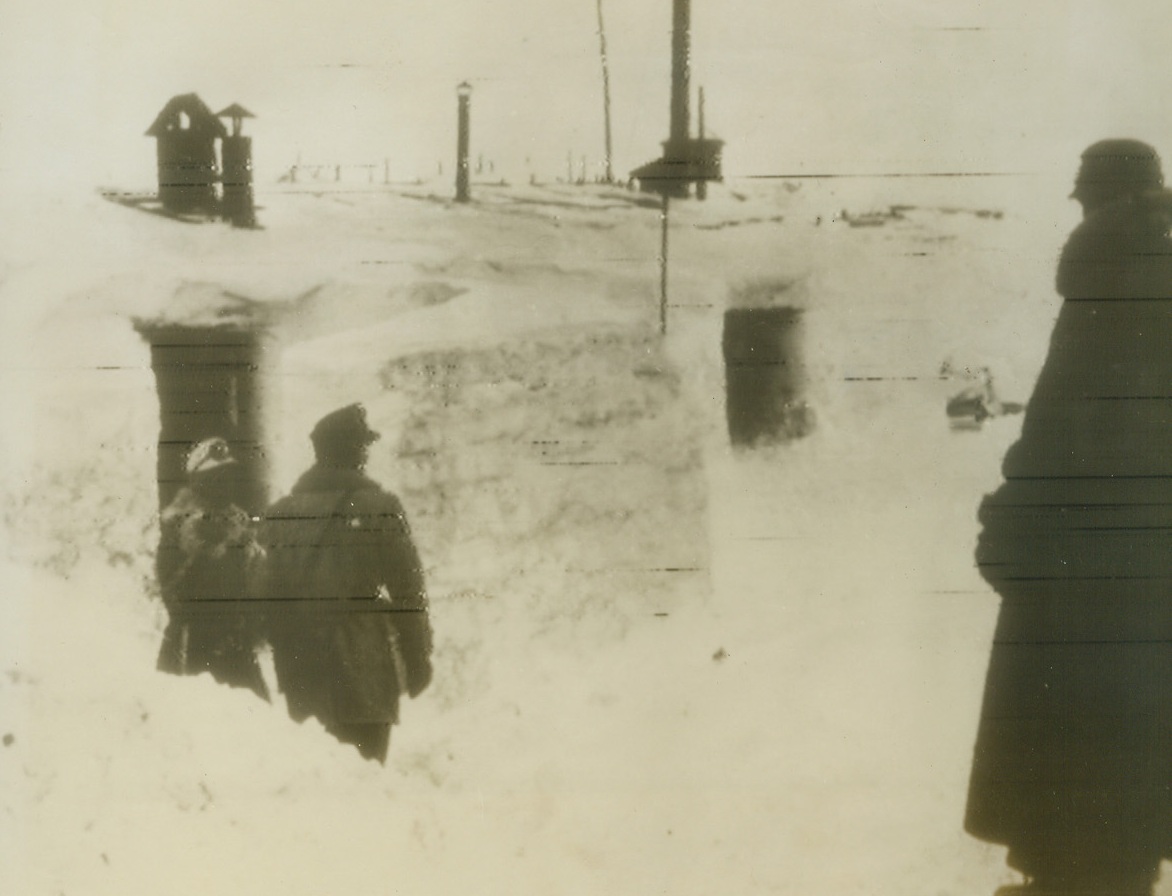
Ready for a Hot Time on a Cold Front, 2/8/1944. FINLAND—Nazi soldiers under command of General Dietl, German Chief of the Finnish Front, use ice walls and snow roofs to “insulate” their wooden barracks from the piercing cold. As Russia promises heavier blows at Finland, the snowbound Nazi fighters may soon see grim action. Photo flashed from Stockholm to New York.Credit: ACME;
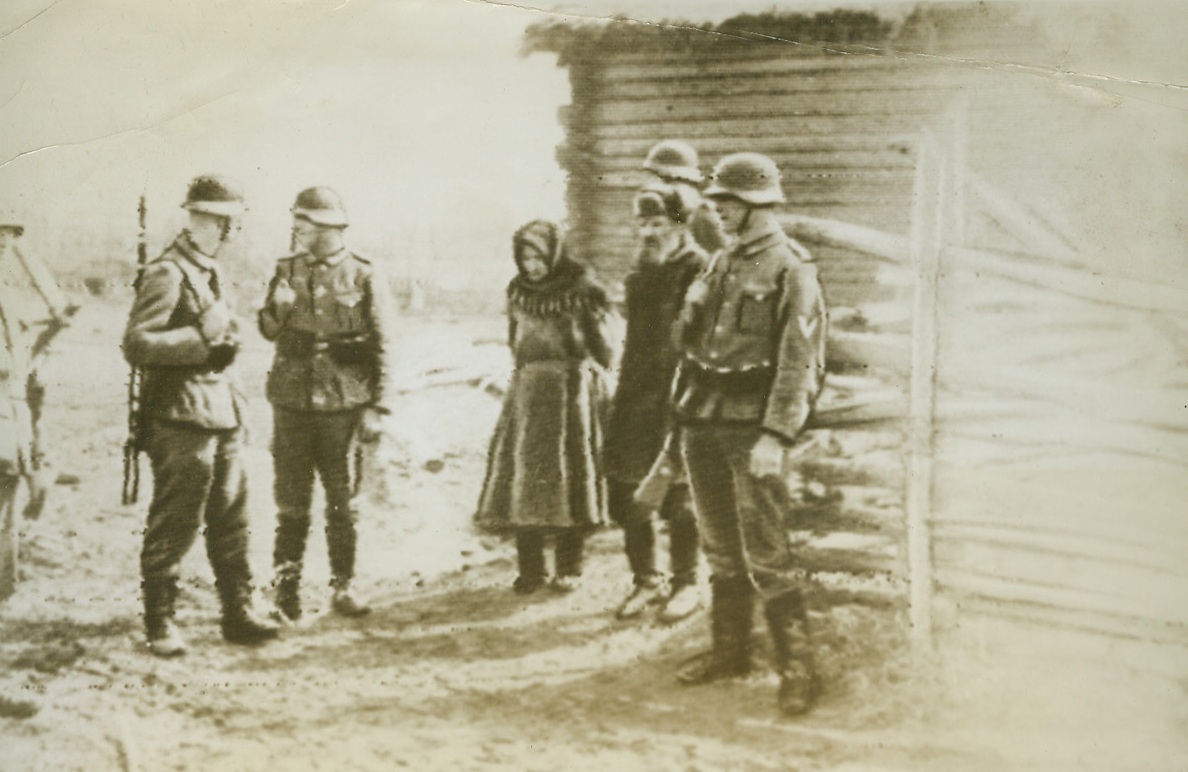
Nazis Preserve Their Crimes on Film--!, 2/4/1944. RUSSIA—A Nazi soldier was evidently proud of the way his cohorts rounded up this old Russian farm couple to be hanged, for pictures of the deed were found in his pockets when he was taken prisoner in the Ukraine. The elderly peasant man and woman know what is in store for them.Credit: ACME;
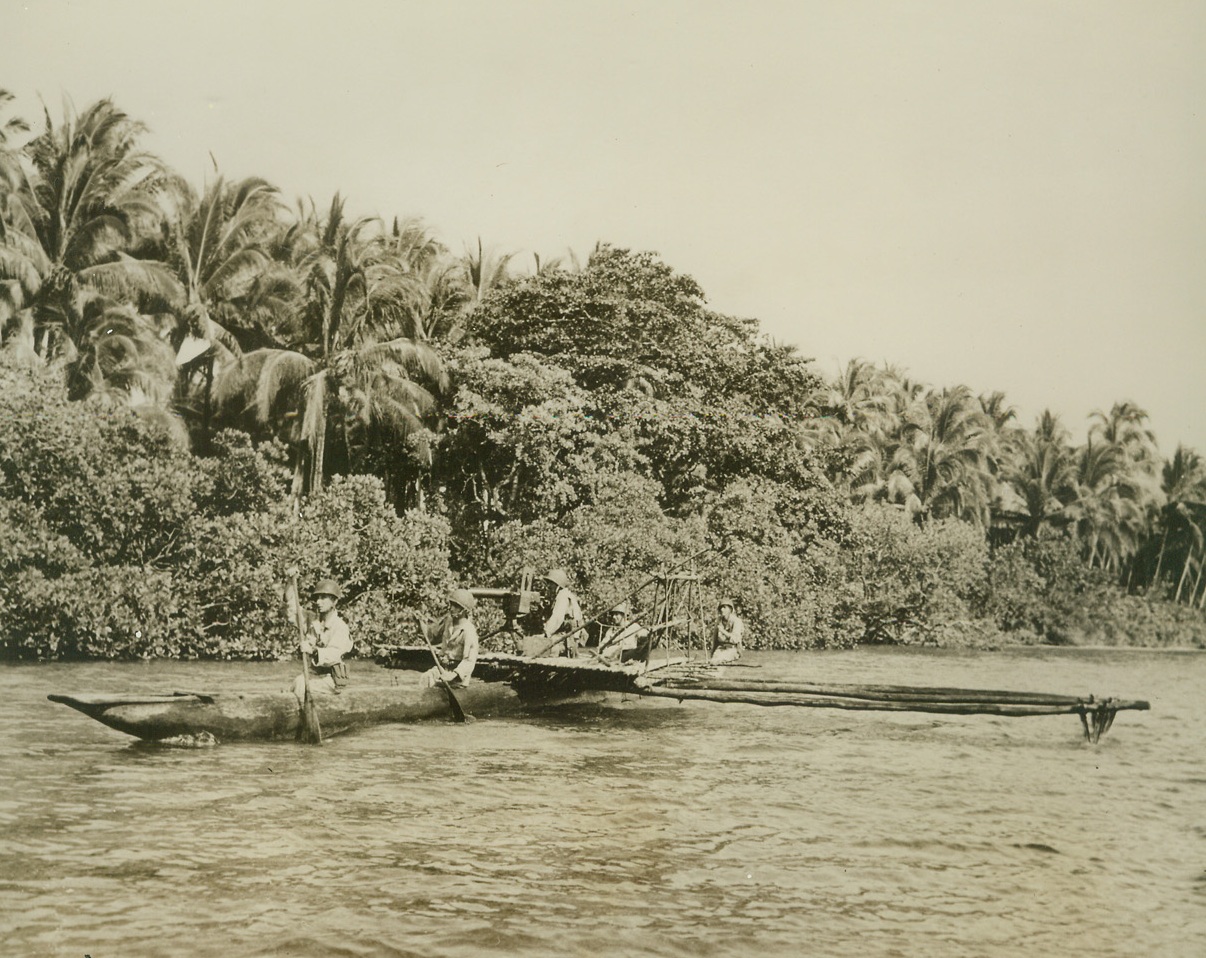
New Britain Paddle-Patrol, 2/14/1944. New Britain – U.S. infantrymen go native with a genuine outrigger canoe as they patrol the coast line of New Britain in reconnaissance of enemy positions at Arawe. A heavy machine gun is mounted amidships, just in case. Credit (Signal Corps photo from ACME);
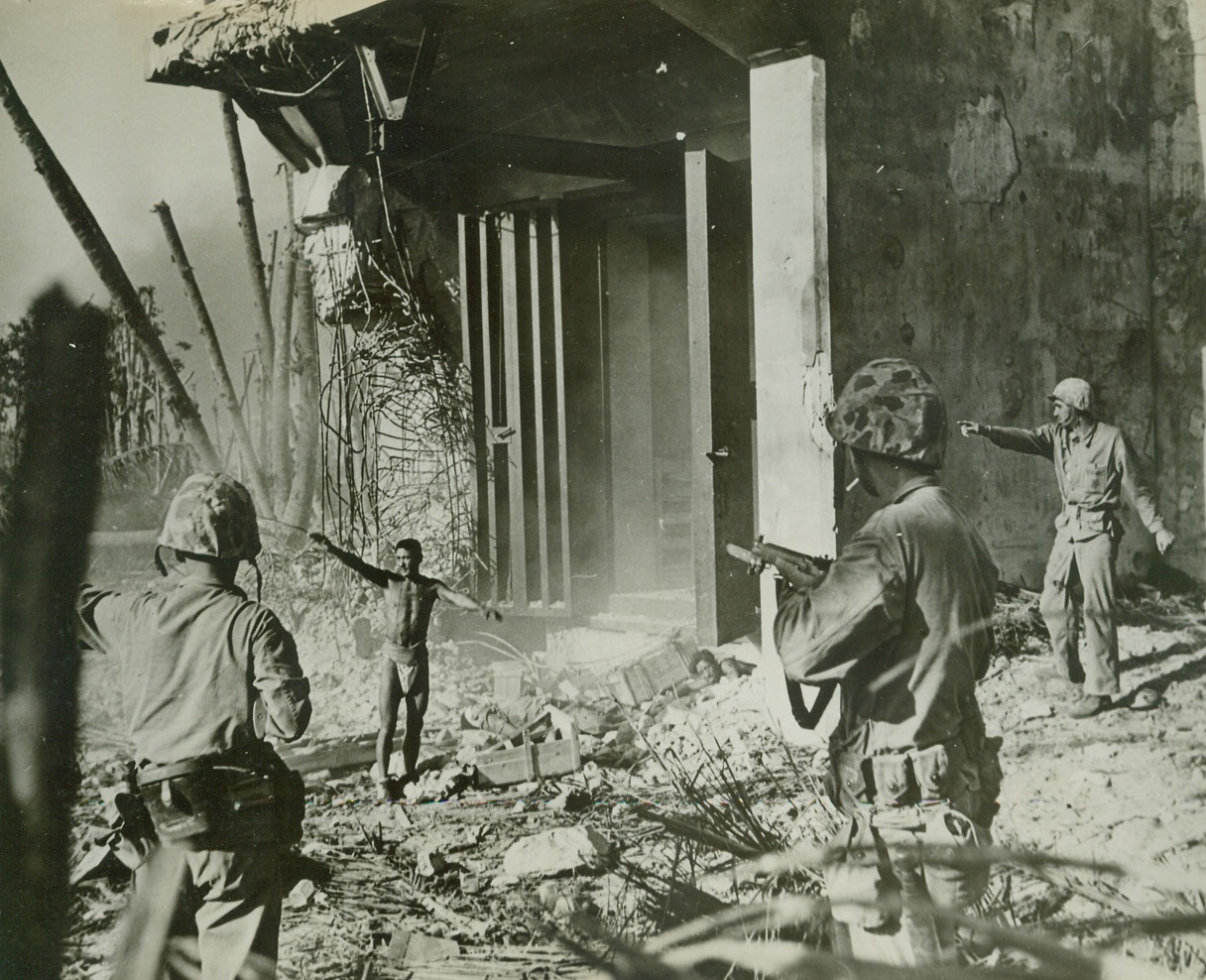
Bursts blockhouse Reveals 20 Japs, 2/16/1944. Namur Island – Thirty-six hours after Namur Island on Kwajalein Atoll in the Marshalls was “secured”, a supposedly silenced Jap block house blew up, bursting a steel door. A Jap soldier stumbled through and three more were found inside. There had been 20 Japs in the block house before the explosion. Here suspicious Marines direct an uninjured Jap, clad only in a loin cloth, away from the building, as another crawls out from wreckage beneath the door. A third Jap lies dead between them. Credit (U.S. Marine Corps photo from ACME);
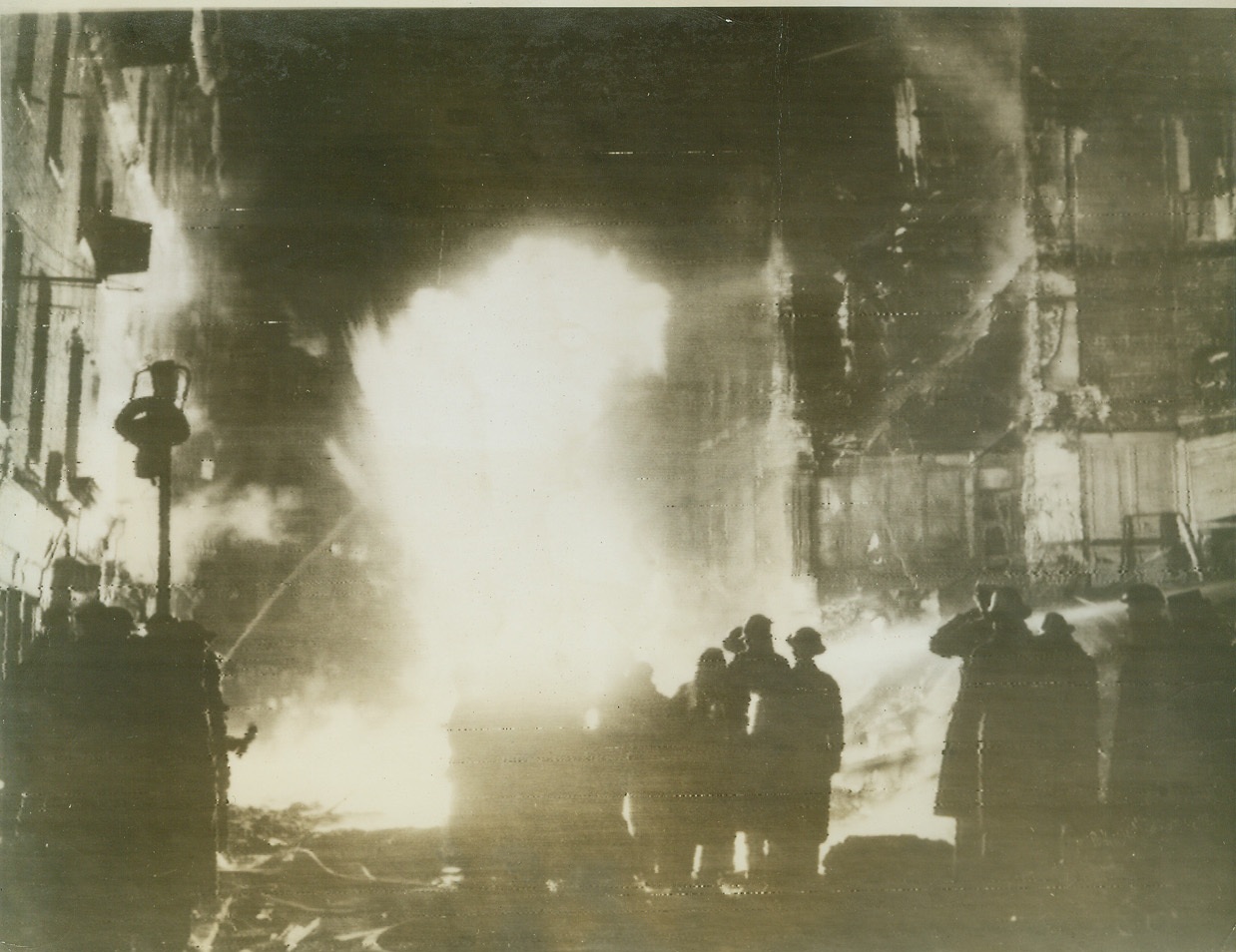
Gas Main Burns After Raid, 2/25/1944. LONDON -- British air raid wardens and fire fighters are silhouetted against the roaring flame of a burning gas main during last night's (Feb. 24th) raid on London by Hitler's bombers. In the background are bombed and burning buildings. Photo radioed to New York today from London. Credit: (ACME Radiophoto);
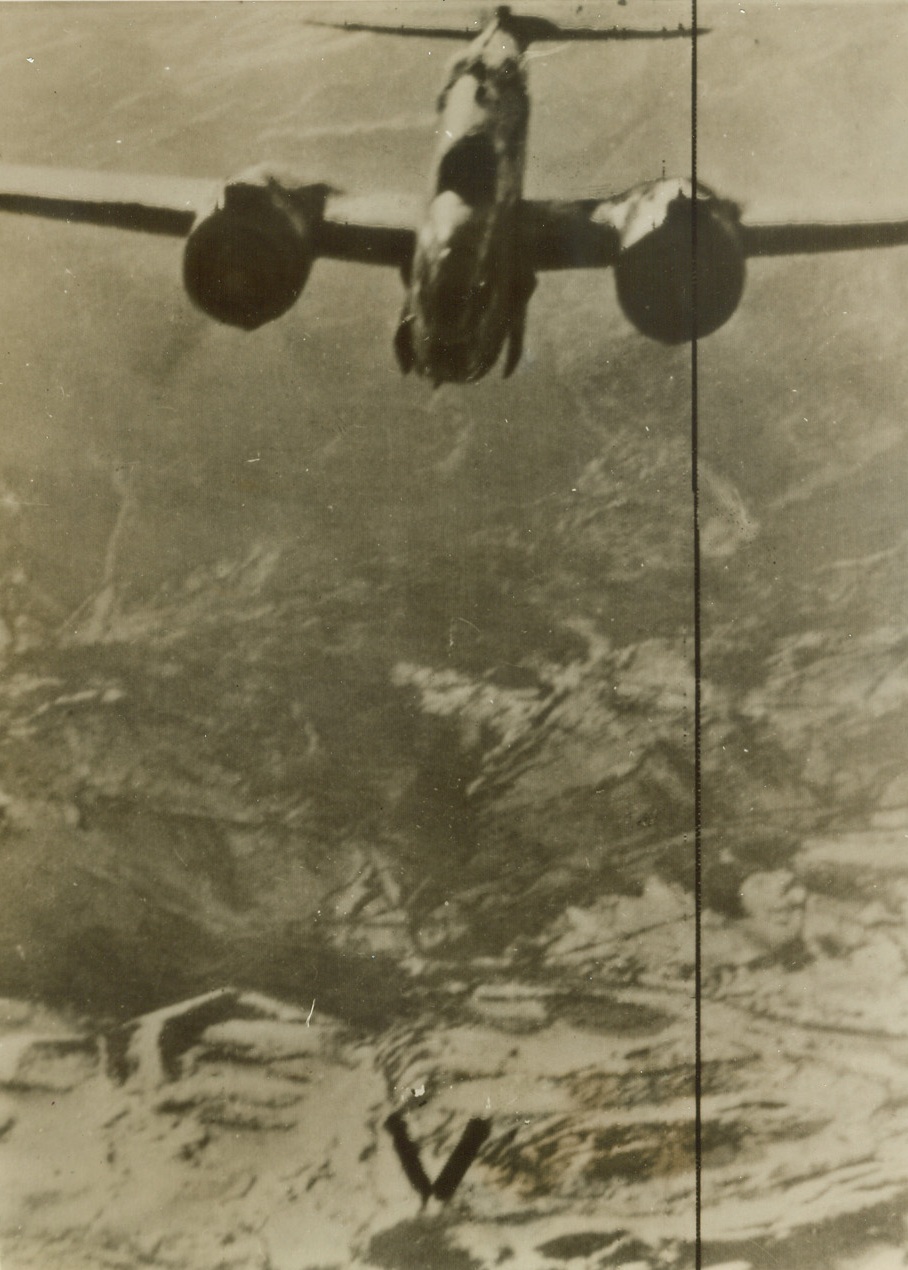
Sign of the Times, 2/1/1944. This photo, flashed to New York tonight by radio from Algiers, shows two bombs (bottom center) forming a perfect “V” – the victory sign – as they fall from the bomb bay of a Baltimore bomber of the RAF, on their way to the target, communications centers along the Rome-Pescara road in Italy. Today, it was announced that British and American troops have launched their first offensive since the landing on Anzio beaches 10 days ago, and have driven to the outskirts of Campo Leone, only 15 miles Southeast of Rome. Credit line (ACME radio photo);

Special Delivery to Davy Jones, 2/19/1944. Engebi Island—A Jap medium size freighter is caught in an exploding net of bomb bursts, as Navy carrier planes send enemy supplies to the bottom of the sea, off Engebi Island, Eniwetok Atoll in the Marshalls. On a return trip to the Northwest Marshall Island Group, Navy fliers softened Eniwetok as Army and Marine assault troops stormed ashore. Credit: US Navy photo from ACME;
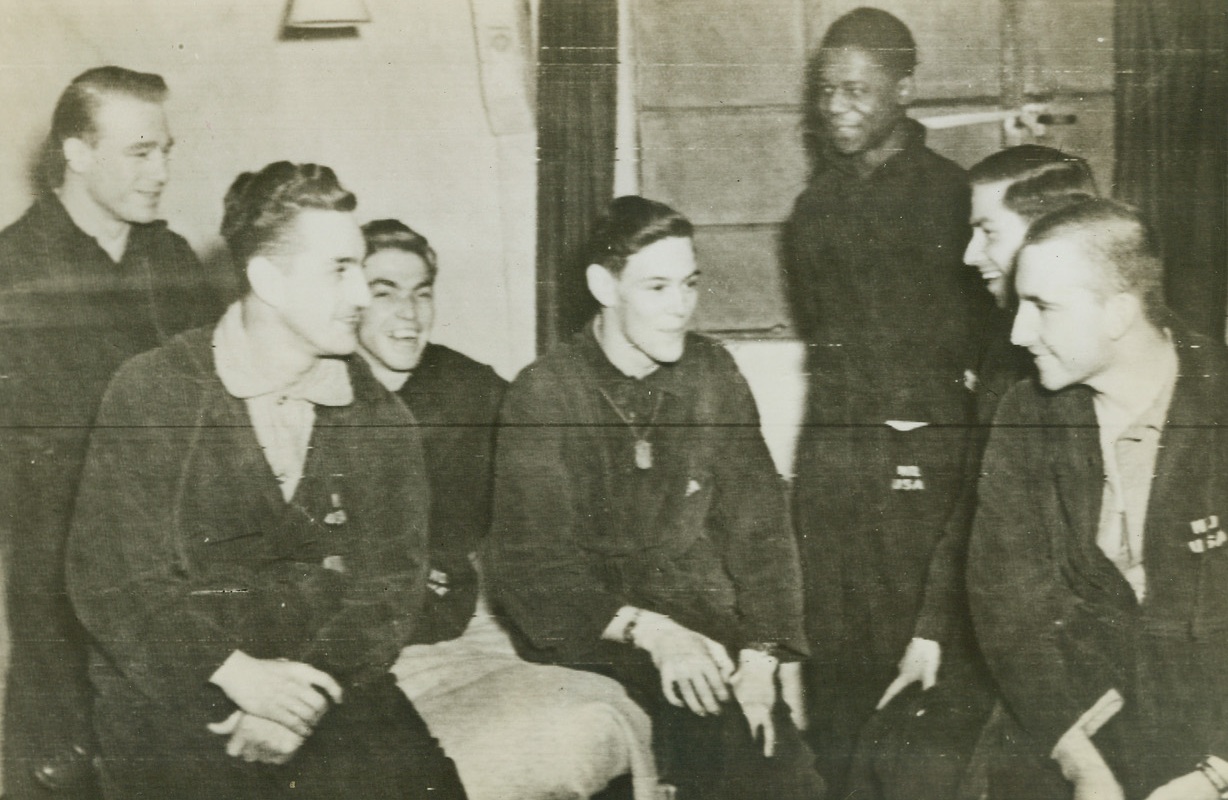
He Lived to Serve, 2/19/1944. England—When his fort, the “Jersey Bounce Jr.” was limping home from a raid over Europe and he was too badly wounded to be of further service to his buddies, T/Sgt Forrest Vosler of Livonia, NY, begged to be thrown from the plane to rid the warbird of extra weight to be carried back to its base in England. His buddies refused to sacrifice him, and the plane crashed into the English Channel. Then, blinded and bleeding, the heroic sergeant saved the life of the crew’s rear gunner, holding onto him until help came. Sgt Vosler, shown fourth from left with the crew after the rescue, has been recommended for the Congressional Medal of Honor. Credit: US Army photo via radiotelephoto—ACME.;
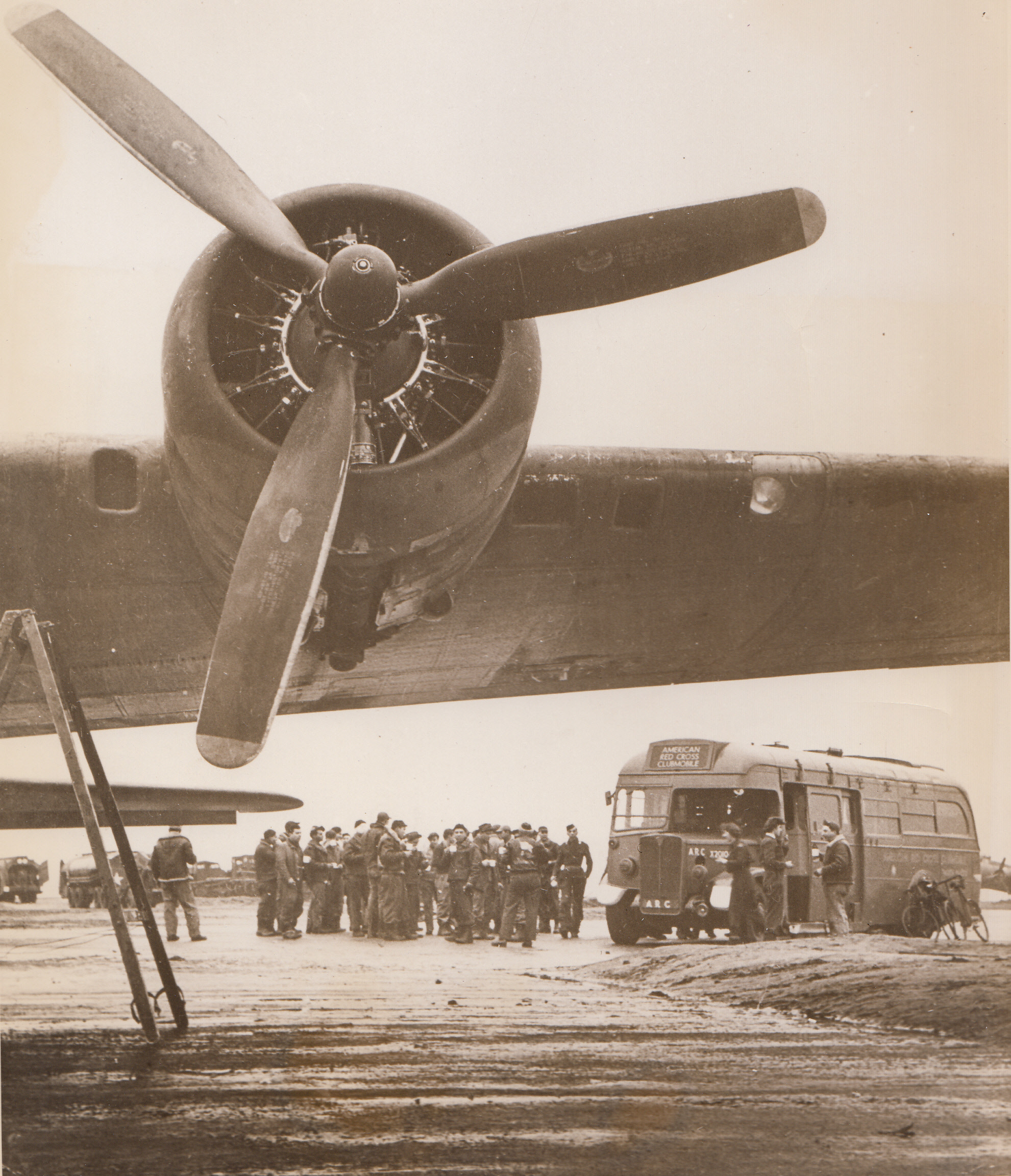
Clubmobile Gals, 2/19/1944. Somewhere in England—Based at a large, 15th century mansion owned by an English Earl and his Countess, four American Red Cross girls staff a Clubmobile bus, one of 51 such mobile canteens operating in the British Isles. Katharine Spaatz, 22-year old daughter of Lt. Gen. Carl Spaatz, is one of them. Pounding their “beat” of several camps and airfields within easy riding distance of their base every week, the girls hand out doughnuts and coffee and generally serve as morale boosters for their G.I. customers. This series shows the quartette at their jobs. ... The Clubmobile’s first stop is a flying fortress base, and girls put on recordings as their “bus” drives up. Music blaring from the loudspeakers, fore and aft, draw Yanks to the “wagon” for coffee, doughnuts, smokes, and chatter. Two girls serve the men while the other two busy themselves inside.;
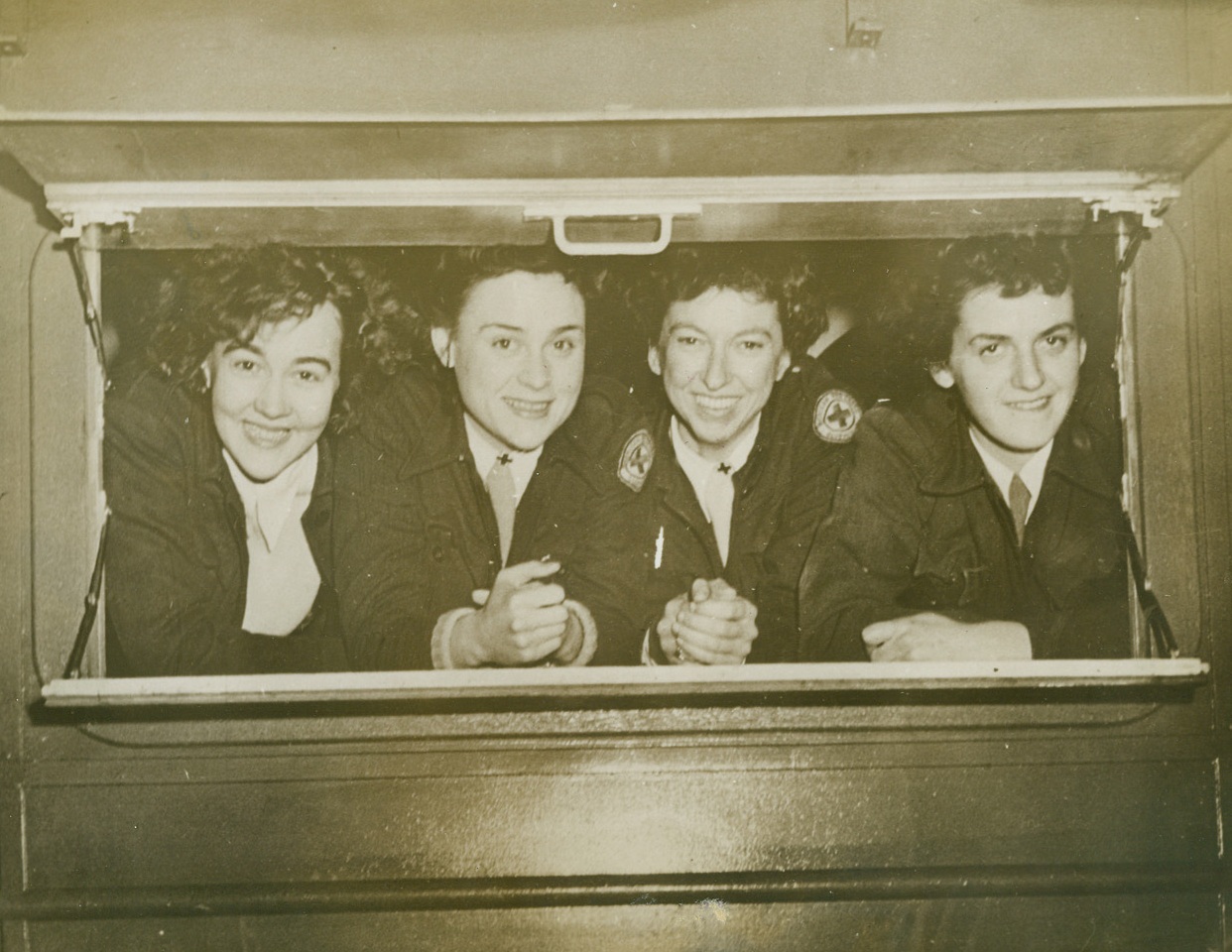
Clubmobile Gals, 2/19/1944. Here are the girls who man the Clubmobile (left to right): Dorothy “Mike” Myrick, 24, of Whiting, Ind; Katharine “Tatty” Spaatz, 22, “homeless” daughter of the Air Forces; Julia “Dooly” Townsend, 28, New York City; Virginia “Ginny” Sherwood, captain of the crew, 24, of Portland, Ore. The girls have named their mobile canteen the “North Dakota.” Credit: ACME.;
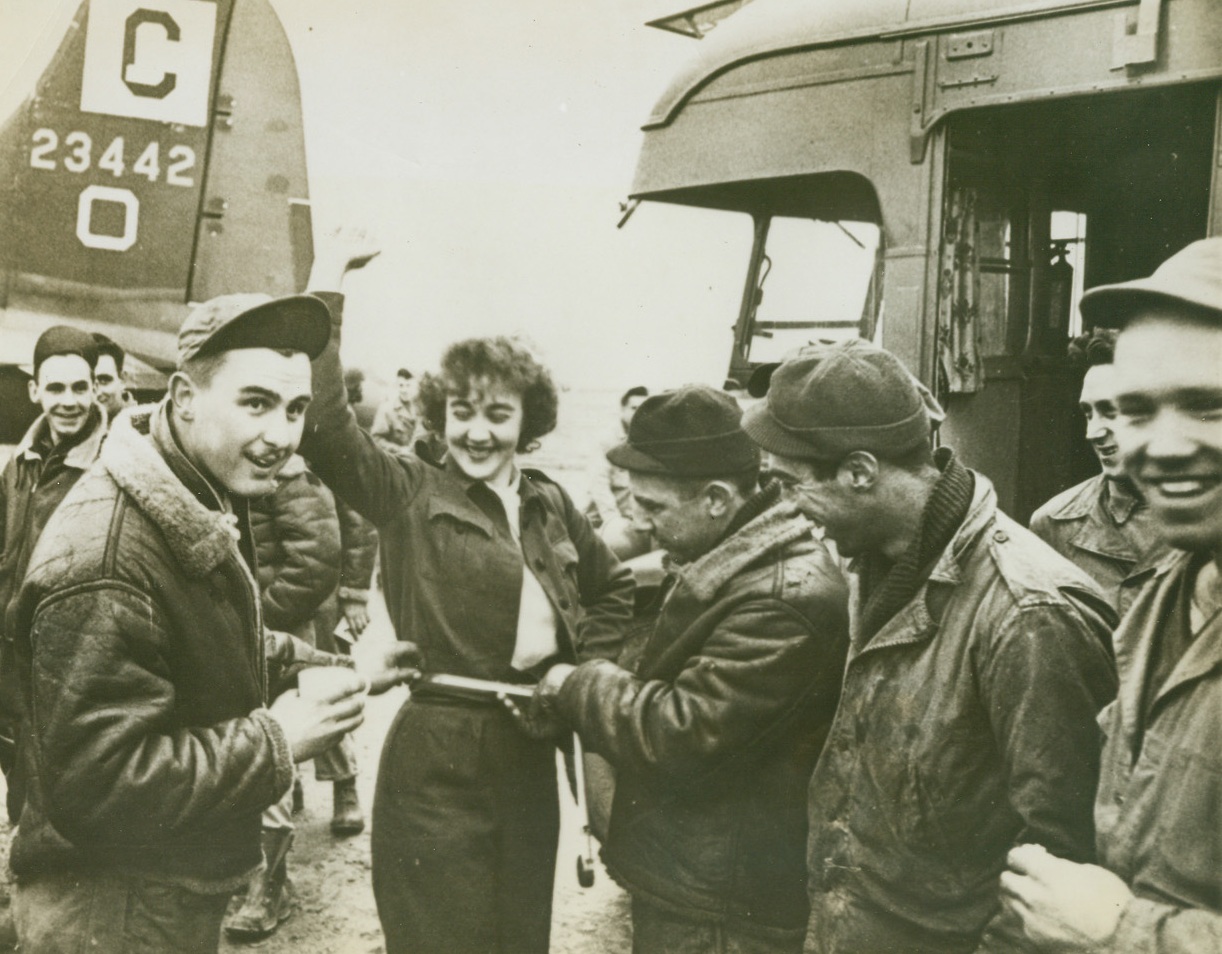
Clubmobile Gals, 2/19/1944. Somewhere in England—Based at a large, 15th century mansion owned by an English Earl and his Countess, four American Red Cross girls staff a Clubmobile bus, one of 51 such mobile canteens operating in the British Isles. Katharine Spaatz, 22-year old daughter of Lt. Gen. Carl Spaatz, is one of them. Pounding their “beat” of several camps and airfields within easy riding distance of their base every week, the girls hand out doughnuts and coffee and generally serve as morale boosters for their G.I. customers. This series shows the quartette at their jobs. New York Bureau “She’s a perfect 42, fellas,” this mechanic teases Dorothy Myrick as the boys measure her waist at a Flying Fortress repair depot. The Red Cross girls come in for a lot of good-natured kidding from the servicemen, with whom they become quite friendly. Credit: ACME.;
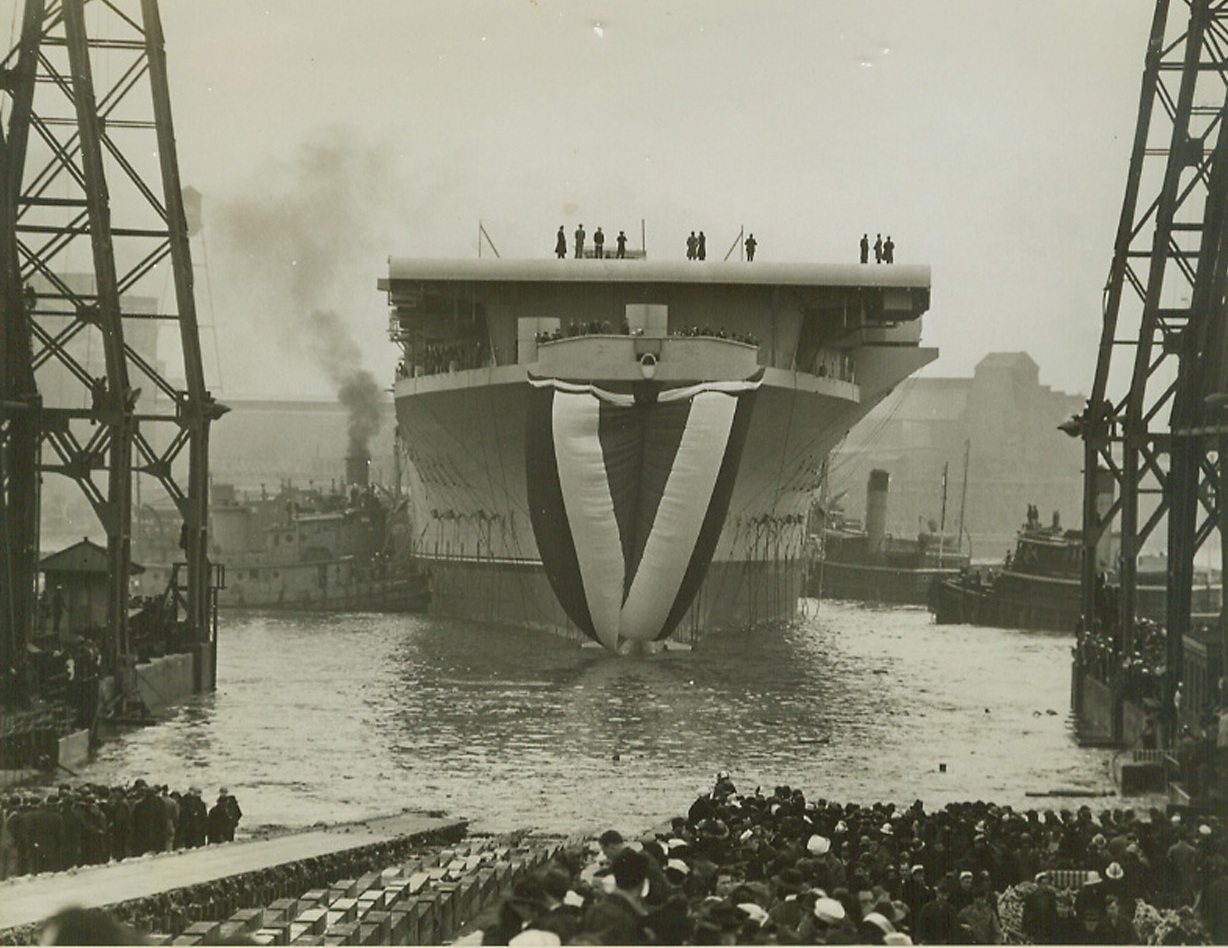
“Shangri-La Goes to Sea”, 2/24/1944. Norfolk, Va.—Jugs cluster about the 27,000-ton aircraft carrier “Shangri-La” after the flat-top was launched at the Norfolk Navy Yard where it was built at a cost of 866,000,000. Tokyo remembers the mythical airbase “Shangri-La” which turned out to be the U.S. carrier “Hornet,” and will be hearing from the new floating threat. Credit: ACME.;
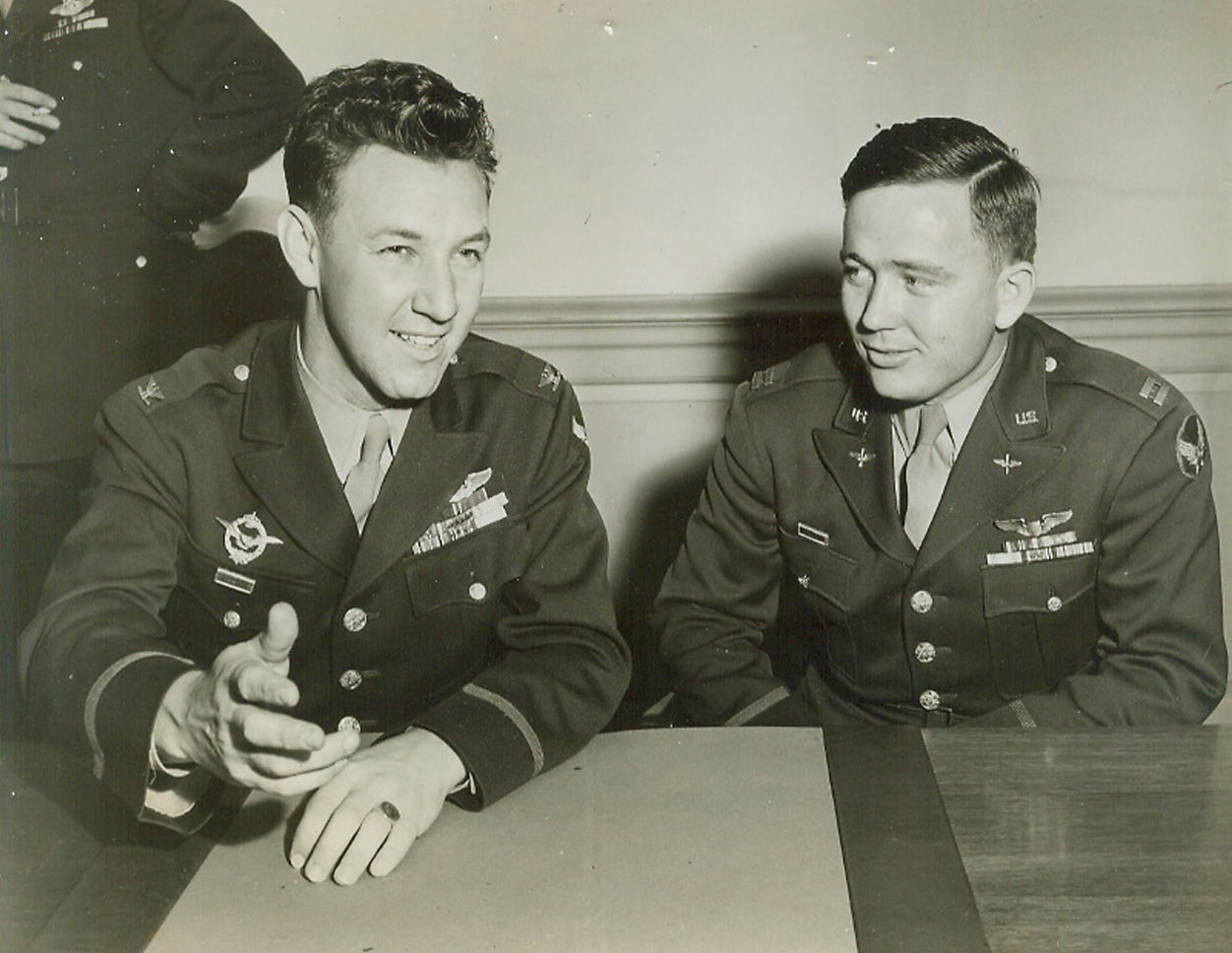
No Title. 2/24/1944. Col. Keith Compson, left, commanding officer of a B-24 heavy bombardment group now operating in the Mediterranean theater, and Capt. Daniel B. Orr, right, operations officer in the group, who combined have compiled a record of almost 700 hours of operational combat flying, are shown during a press conference at the Pentagon Building today. Col Compton, 28, is of St. Joseph, Mo., and Capt. Orr who is 24, is from Graham, Texas. Credit: ACME.;
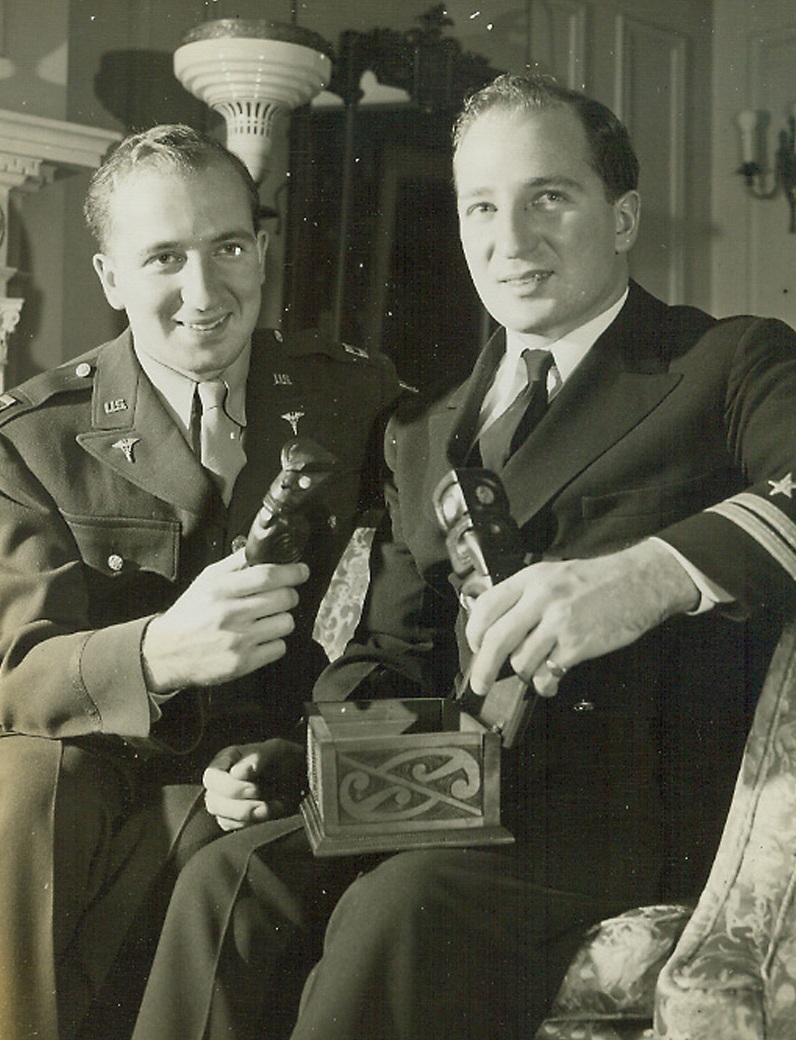
Identical Twins Get Identical Leave, 2/24/1944. Chicago—Identical twins with comparable rank got identical leave from Army and Navy and returned to their home in Chicago to see each other for the first time in three years. Capt. Richard Cook (left) of the Army medical corps has been stationed in Camp Hahn, Calif., and is en route to a new assignment. Lt. Robert Cook was on a boat in Pearl Harbor at the time of the Jap sneak attack and has been in the Pacific since that time. Only change they noted at their reunion is that Robert has lost some hair and Richard has put on some weight.Credit: ACME.;
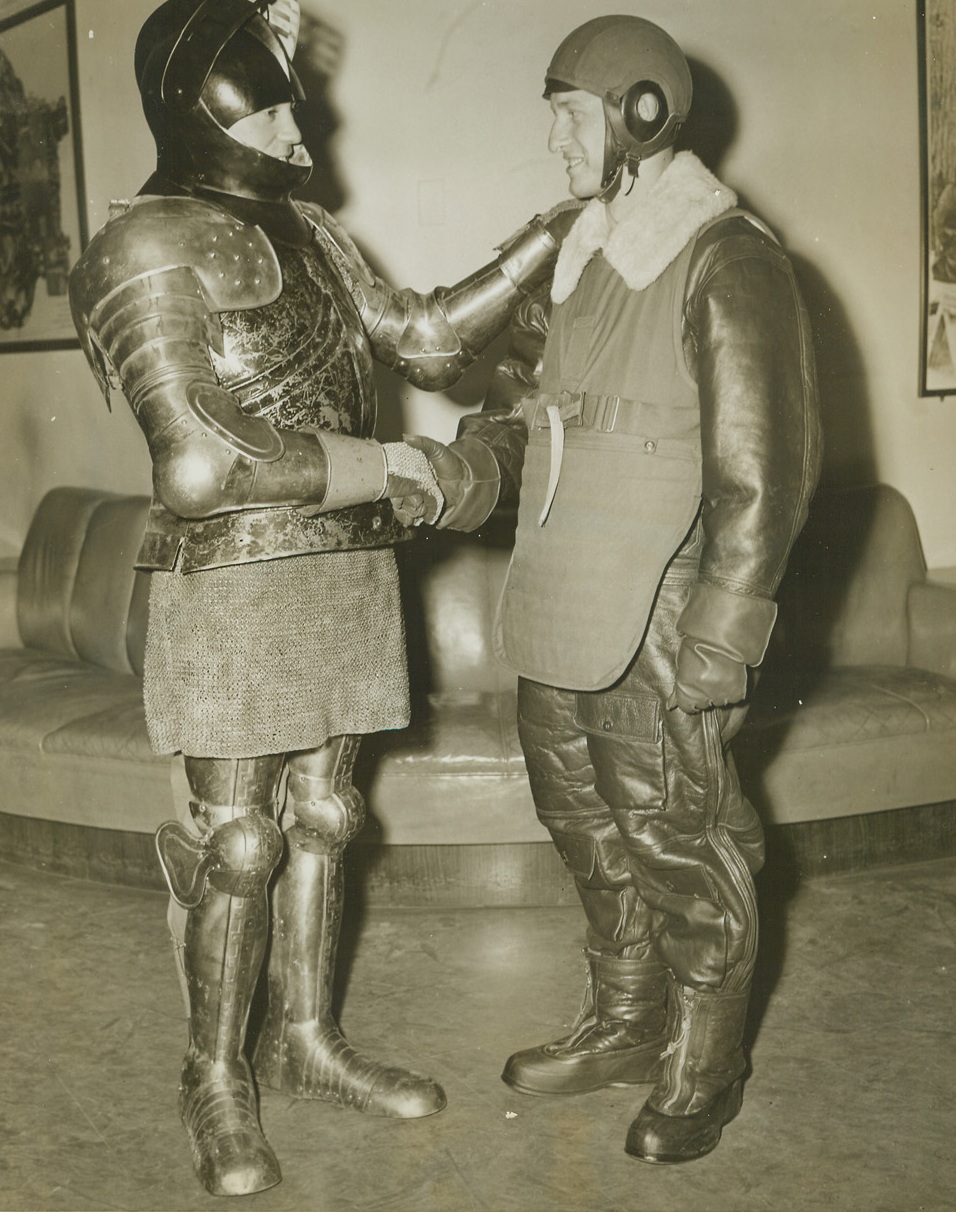
You’re Safe, Bud, 2/19/1944. New York City—Decked out in the cumbersome armor and mail used for protection by ancient warriors, Pfc. Kenneth Tracy tells Pvt. Lee Morris (right) that he’s twice as safe and many times more comfortable in the Army Air Forces body armor the modern flier wears. Designed to protect airmen from enemy flak, the new body armor is shown publicly for the first time at the Army Ordinance Exhibit in the Chrysler Building.Credit: ACME.;

Bombing Junkers Repair Shops, 2/20/1944. Villacoublay, France – A cluster of bombs whizzes down toward Junkers Repair Shops at Villacoublay during the Allied raid of February 5th. Below, bombs that have already found their mark begin to send up puffs of smoke as our Airmen blanket the area with high explosives. Credit: U.S. Army Air Forces photo via OWI from ACME;

Nazi Prisoner Buried, 2/16/1944.

FDR Presents French Navy With New DE, 2/13/1944. Washington, D.C.—The destroyer-escort “Senegalais” flies the French Tricolor (stern in background) after being presented by President Roosevelt as Commander-in-Chief of the Armed Forces, to the French Navy. French and U.S. soldiers stand at attention during the colorful ceremony. The President’s car is in the foreground. Credit: ACME.;
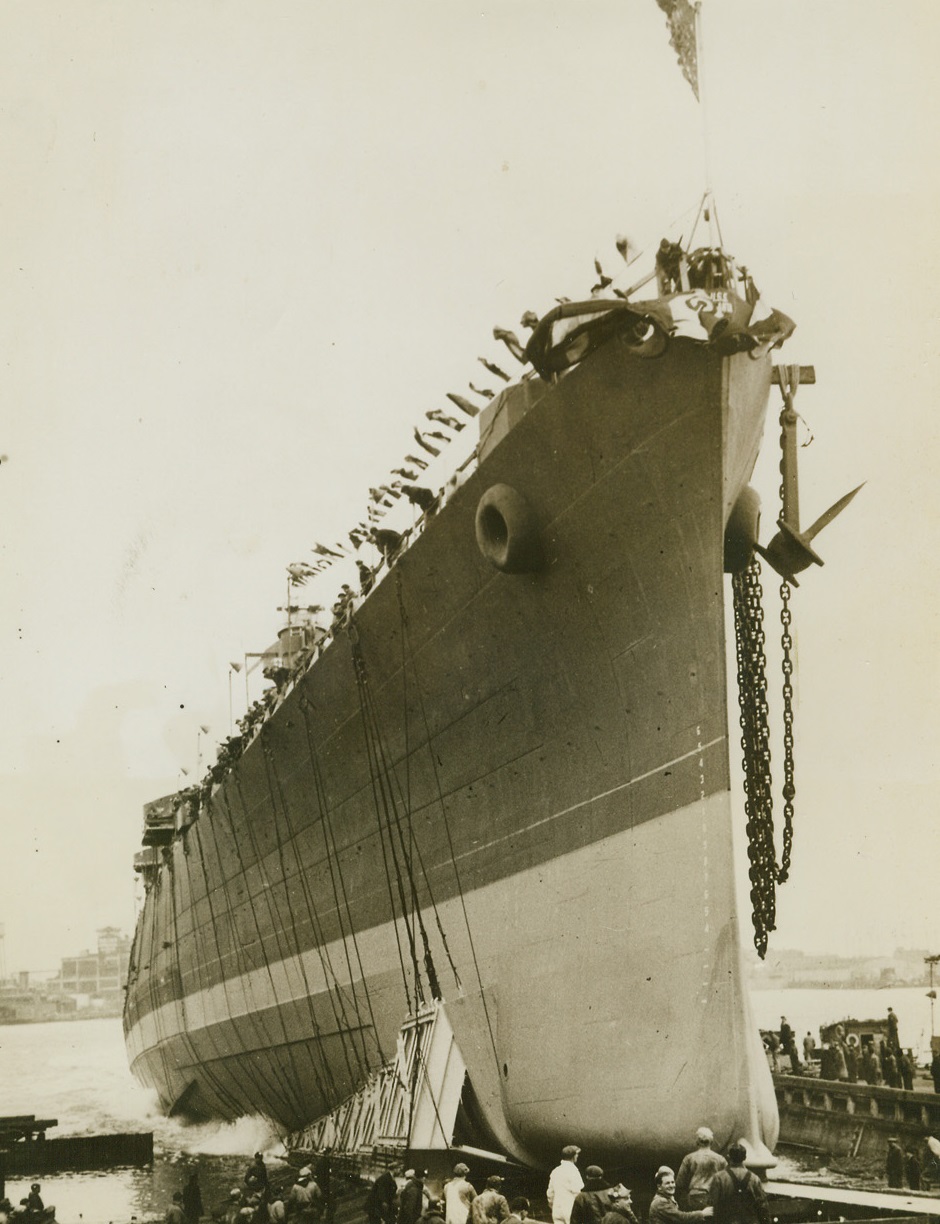
Cruiser Atlanta Launched, 2/6/1944. Camden, N.J.—The Cruiser Atlanta, fourth Naval vessel to bear that name, goes down the ways of the New York Shipbuilding Corp. at Camden, after its christening today (Feb. 6th). Mrs. Margaret Mitchell Marsh, author of “Gone with the Wind,” sponsored the vessel for which citizens of Atlanta raised $63, 387, 879 in war bond sales after the third ship of the same name was sunk off Guadalcanal. Mrs. Marsh also sponsored the third Atlanta. Credit: Official U.S. Navy photo from ACME.;

Shakes Hand That Piloted Ship, 2/6/1944. Oklahoma City, Okla. - Oklahoma’s Governor, Robert S. Kerr, welcomes Capt. John R. Johnson, pilot of the famed Flying Fortress Hell’s Angels and veteran of European combat missions, while S. Sgt. Edward W. West Jr. and M. Sgt. Fabian S. Folmer back him up. Ground and combat crews of the ship were reunited at Tinker Field, Oklahoma City, when the ship arrived there to start on a War Loan tour. Credit: ACME;
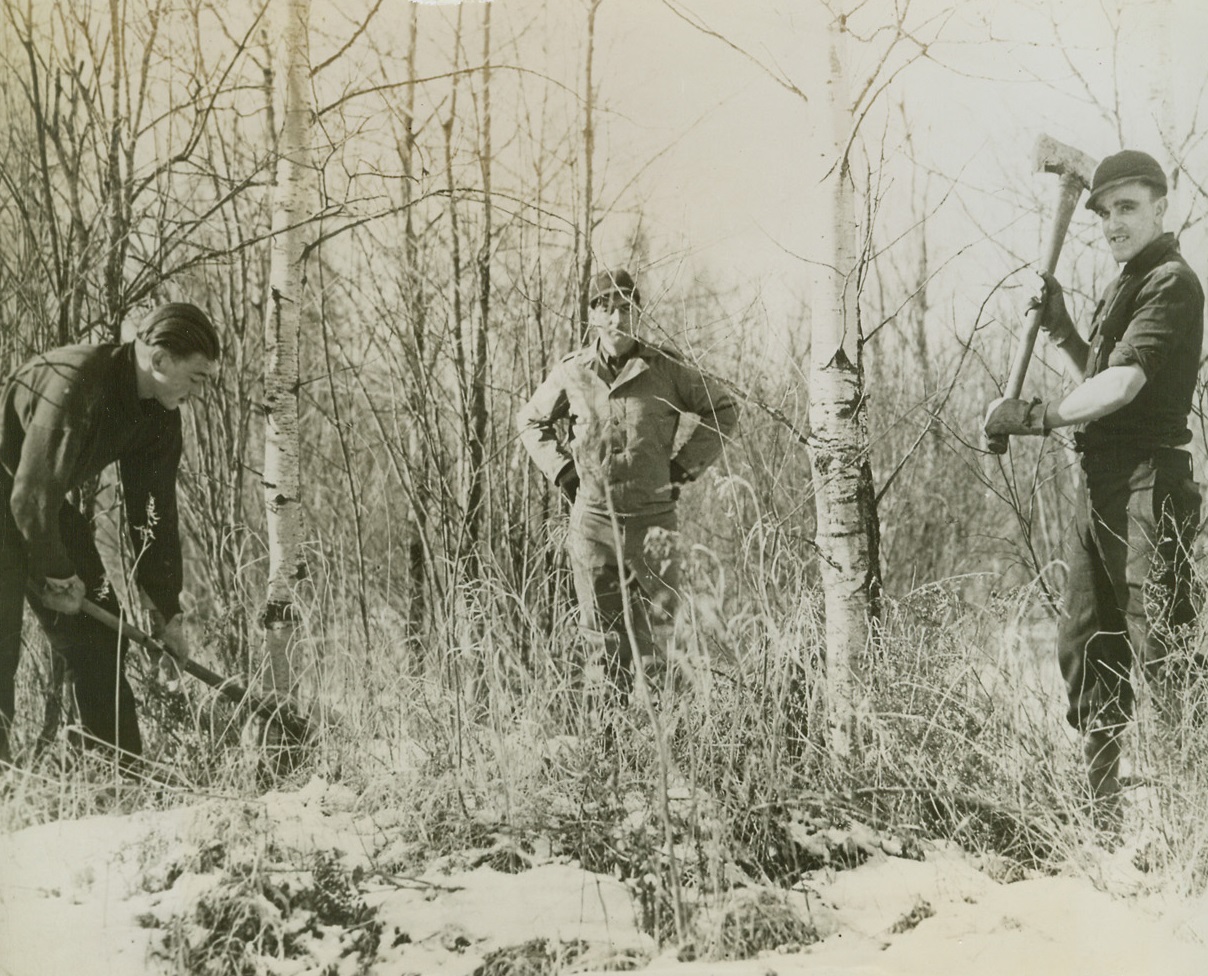
Enemy Aids in Woods, 2/6/1944. Remer, Minn. -- These two German war prisoners with their guard, rear, helping to alleviate the manpower shortage in the pulpwood industry, are the first of an estimated 1,000 to work in Minnesota’s forests. Other prisoner work camps are tentatively set for Duluth and International Falls, Minn. Credit: ACME;
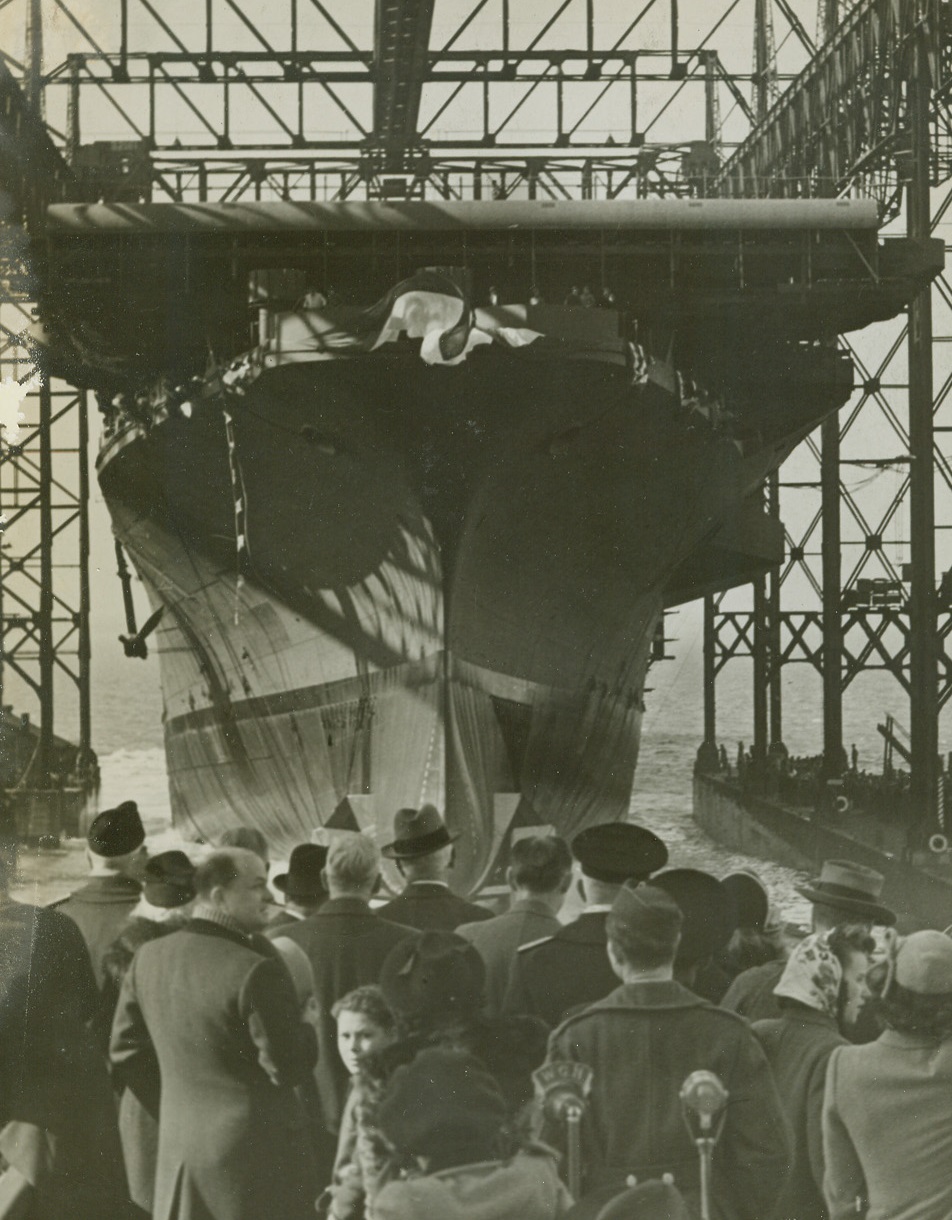
New Carrier for Uncle Sam, 2/7/1944. Newport News, VA. - Named after Fort Ticonderoga, the U.S. Navy’s newest Aircraft Carrier, the USS Ticonderoga slides down the ways at the Newport News Shipbuilding and Drydock Co., after launching ceremonies today. Miss Stephanie Sarah Pell, who christened the warship, had to take two swings at the huge bow, before the champagne bottle smashed against the vessel’s sides. The Ticonderoga is the sixth carrier of the Essex Class to be launched by the yard. It is the fourth ship in the history of the U.S. Navy to bear the name. Credit: ACME;
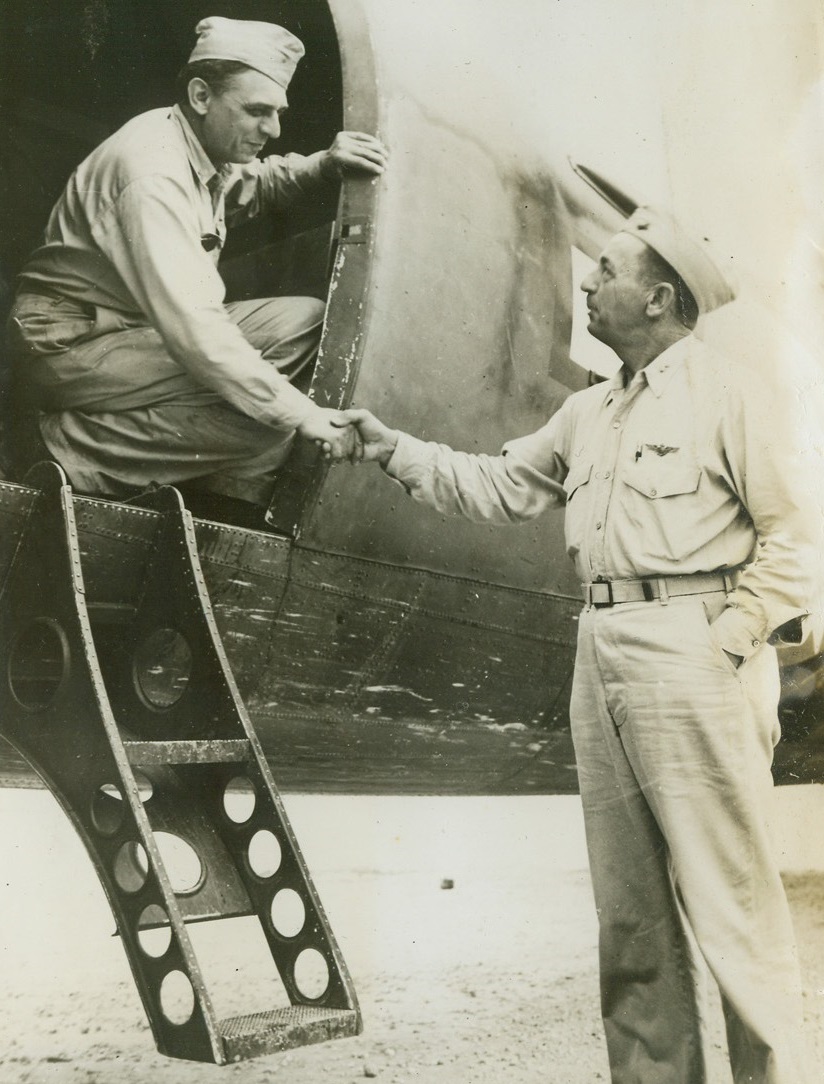
Adieu, 2/11/1944. Raymond E. Clapper, left, newspaper columnist for the Scripps-Howard Newspaper Alliance and Radio Commentator, bids goodbye to Major General Ralph J. Mitchell, right, Commander of Marine Air Units in the Solomons; as he took off from Munda Airfield. Mr. Clapper died in mid-air crash while on a tour of the South Pacific Bases and the war zones. Credit: U.S. Marine Corps photo from ACME;
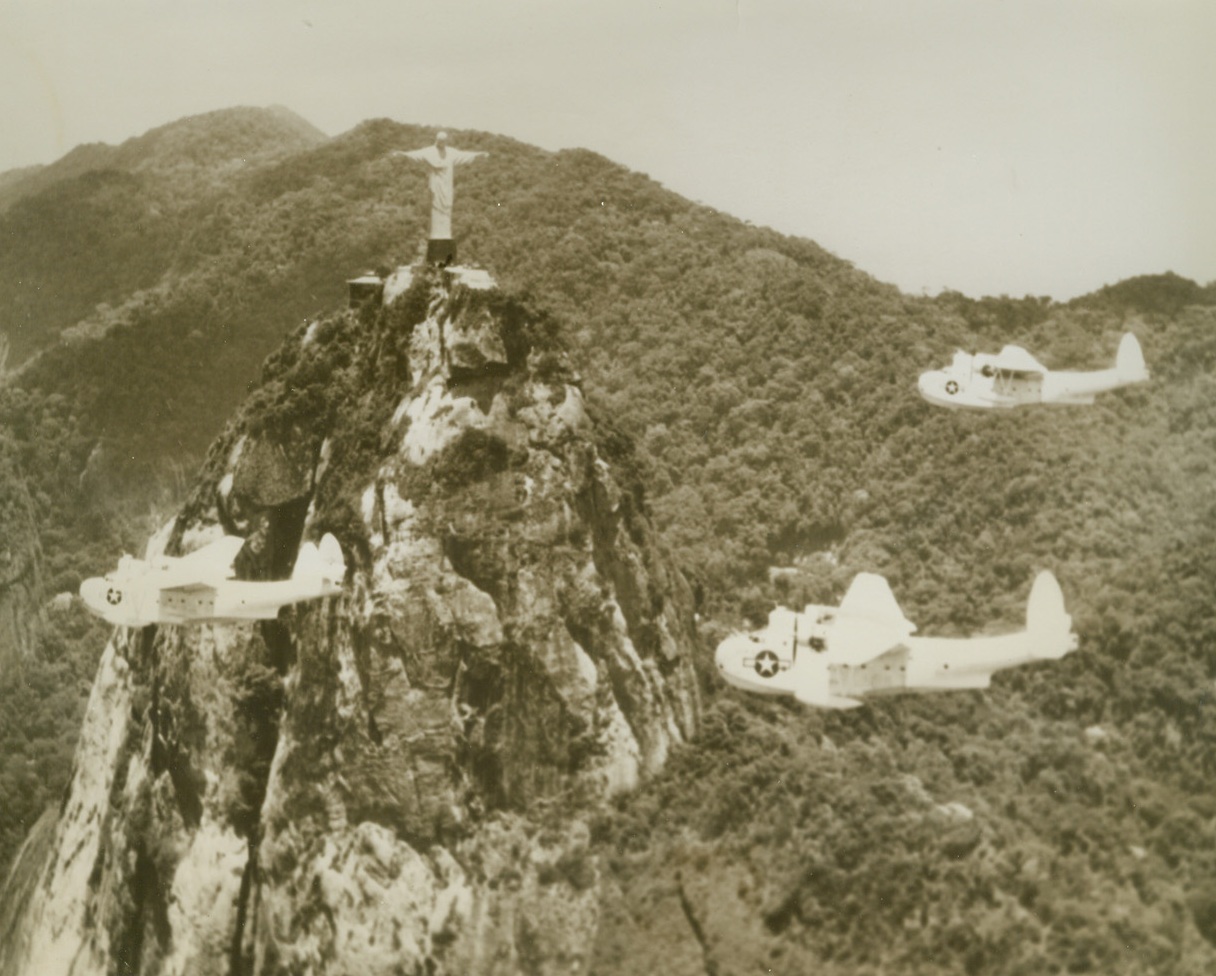
The Eternal--and the Modern, 2/1/1944. Rio de Janeiro -- As though casting a blessing over these three white, gull-like Martin Mariners of the U.S. Navy, this statue of Christos Redemptor--Christ, the Redeemer--stands with outstretched arms atop Corcovado Peak near Rio de Janeiro. The war planes are part of a group flying on Navy Business, guarding convoys to and from Brazil. Credit: U.S. Navy photo from ACME;
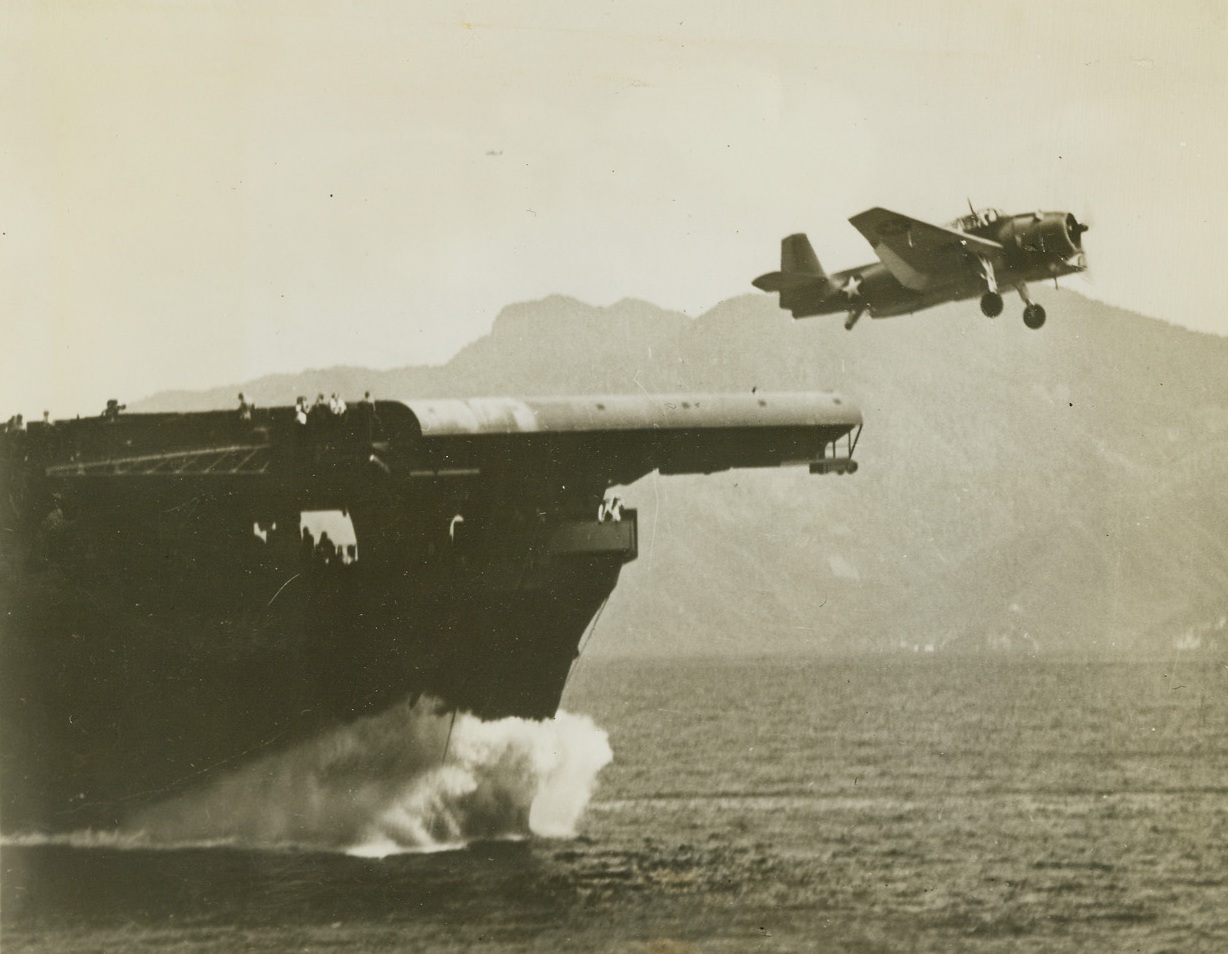
An “Avenger” Awing, 2/1/1944. This photo, released by the Navy Department in Washington today, shows a Grumman Avenger Torpedo Bomber taking off from an American aircraft carrier “somewhere at sea.” The high, white bow wave of the warship indicated the speed with which the ship plows through a calm sea. Today, in Washington, the Navy announced that the greatest task force ever used, including carrier and land based aircraft and surface craft, had effected a U.S. landing at two points in the Marshall Islands, the first beachhead to be established in territory held by the Japs before Pearl Harbor. Credit: U.S. Navy photo from ACME;
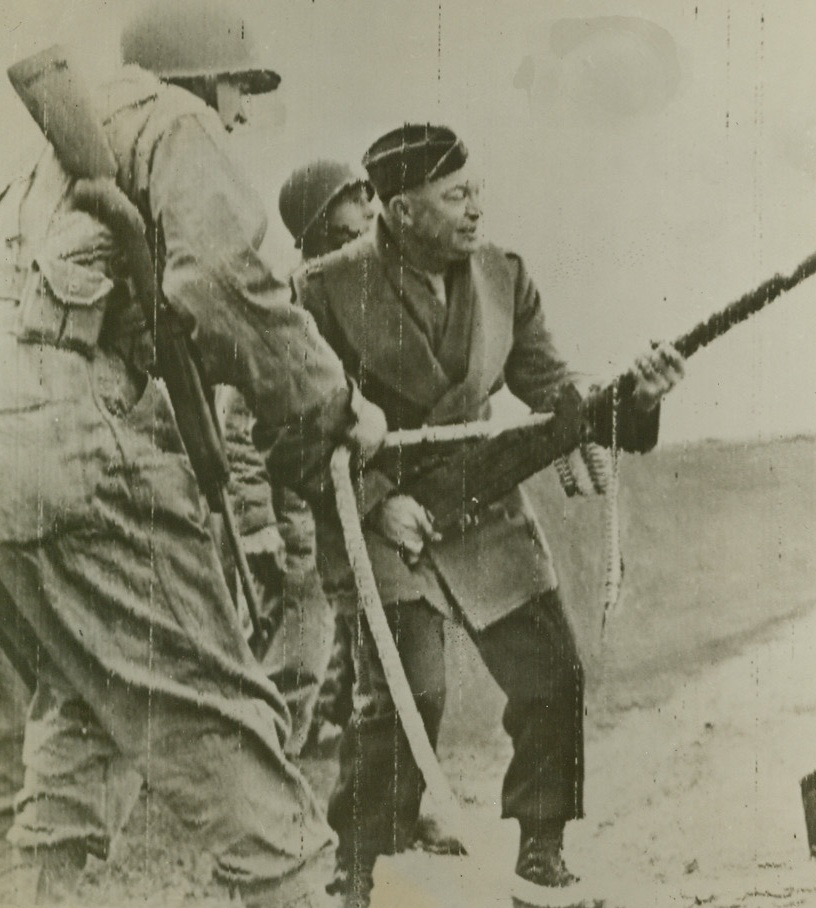
Hasn’t Lost His Touch, 2/18/1944. Somewhere in England - Inspecting an Infantry Unit somewhere in England, General Dwight D. Eisenhower shows his men that he hasn’t’ lost his Doughboy touch. Using a Browning Machine Gun - off its mount - he shoots from his hip. Credit: ACME photo via Army Radiotelephoto;
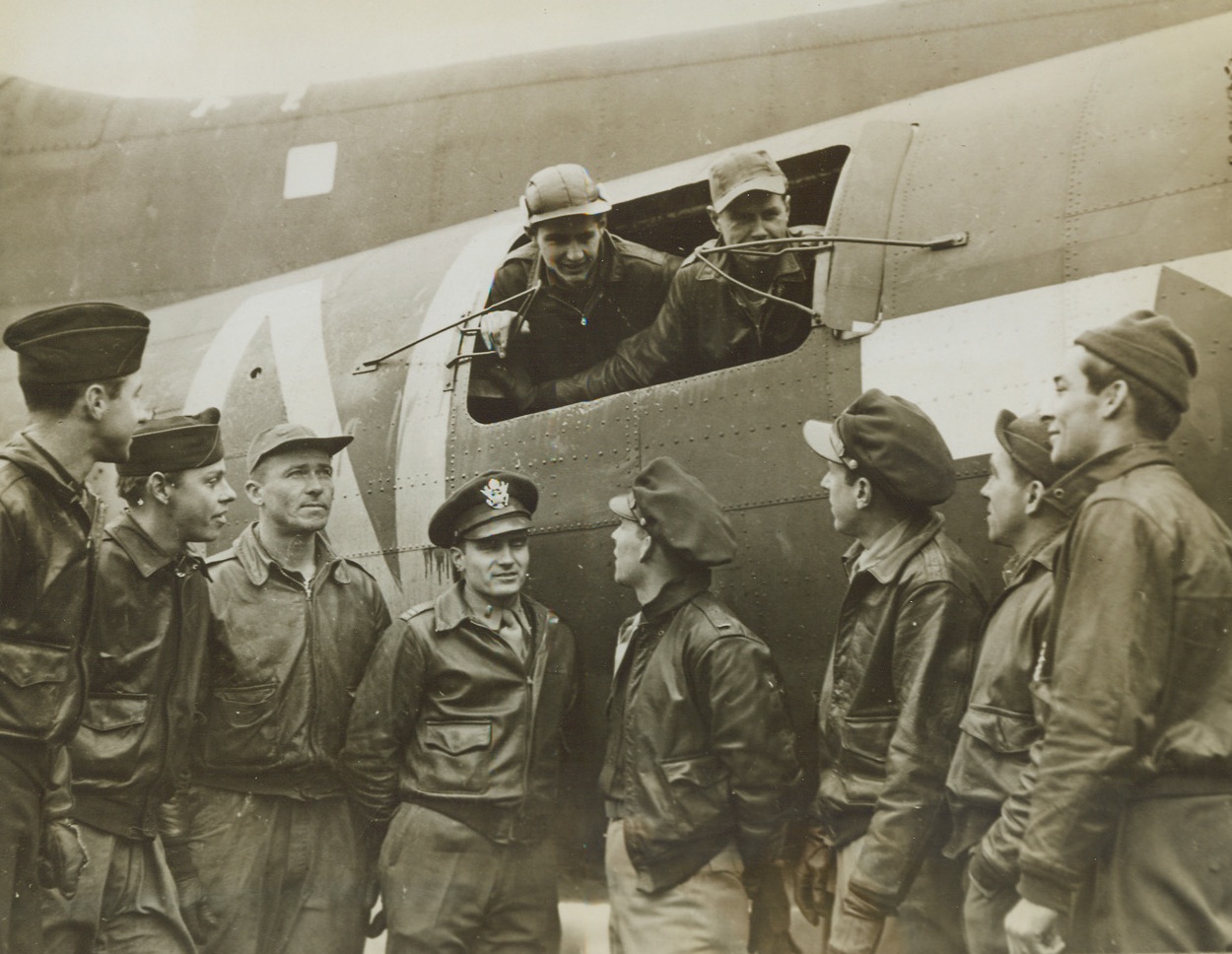
They Got Home!, 2/20/1944. England - These boys had to jettison everything, including the Ball Turret, to get their Flying Fortress home after two engines had been knocked out by flak during a raid over Frankfort. Left to right: 2nd Lt. William C. Johnson, pilot, of Lewis Chapel, Tenn.; Ball Turret Gunner Sgt. David E. Cameron, Boothwin, PA; Radio Operator S/Sgt Ruben Kisner, Doylestown, PA; Bombardier 2nd Lt. James P. Cain, Barnum, IA; Navigator 2nd Lt. William C. Gray, Wilkes Boro, N.C.; Co-Pilot 2nd Lt. Matt Farmer, Mankato, Minn.; Tail Gunner Sgt. Ed. J. Skiba, Aliquippa, PA; Top Turret Gunner S/Sgt Robert D. Cavanaugh, San Antonio, Texas; (and in window) Right Waist Gunner Sgt. Raymond G. Calvert, Detroit, Mich.; and Left Waist Gunner Sgt. Glenn E. Bratcher, Lamesa, Texas. Credit: U.S. Army Air Forces photo via OWI - ACME;
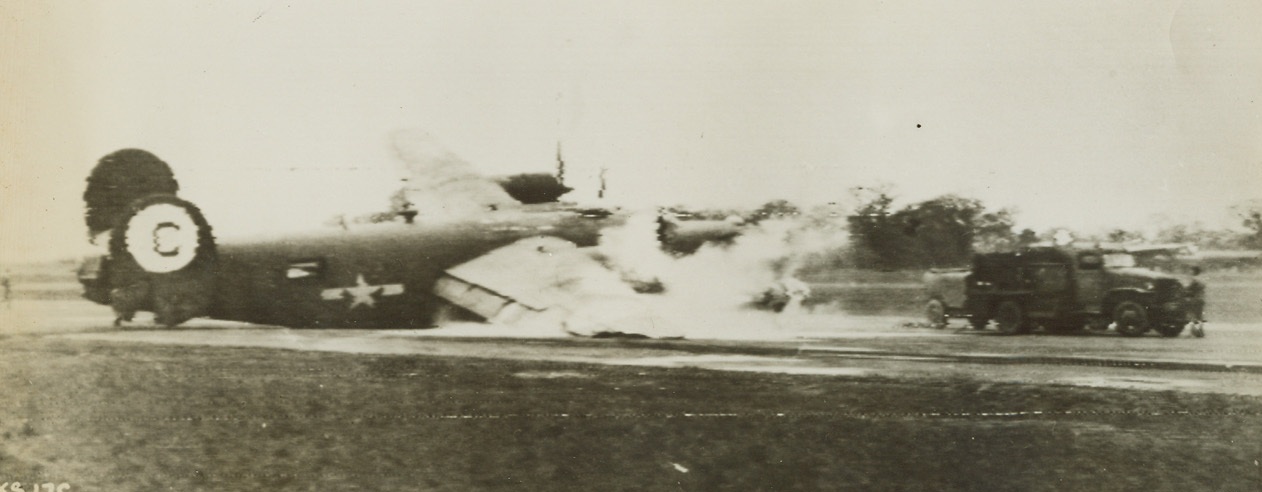
Liberator in Trouble, 2/18/1944. Somewhere in England - Returning to its base somewhere in England, a Liberator Bomber crash-lands and catches fire. Piloted by Lt. Claude E. White of Tushka, Okla., the ship came in with only one wheel and the propeller of its #4 engine was knocked off as it hit the ground. Flames were soon doused by the station’s ground forces. Credit: U.S. Army Air Forces photo via U.S. Army Signal Corps Radiotelephoto from ACME;
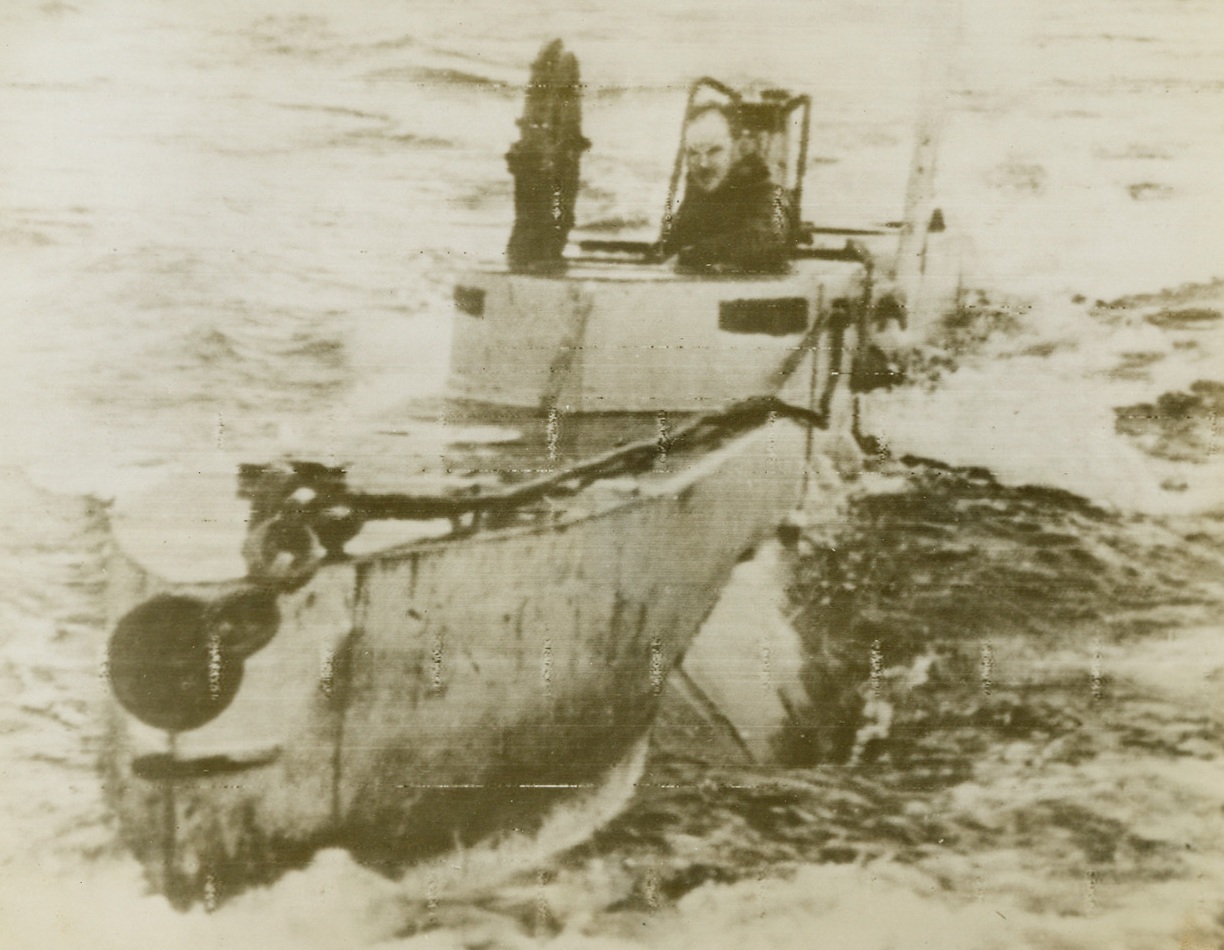
Britain’s Midget Submarine, 2/22/1944. England - A crewman looks out of the conning tower of a tiny, British three-man submarine of the type that helped wound the mighty German warship Tirpitz last fall. Small and deadly, the sub can penetrate shallow channels, sneaking up into an enemy vessel’s hiding place. Credit: ACME Radiophoto;
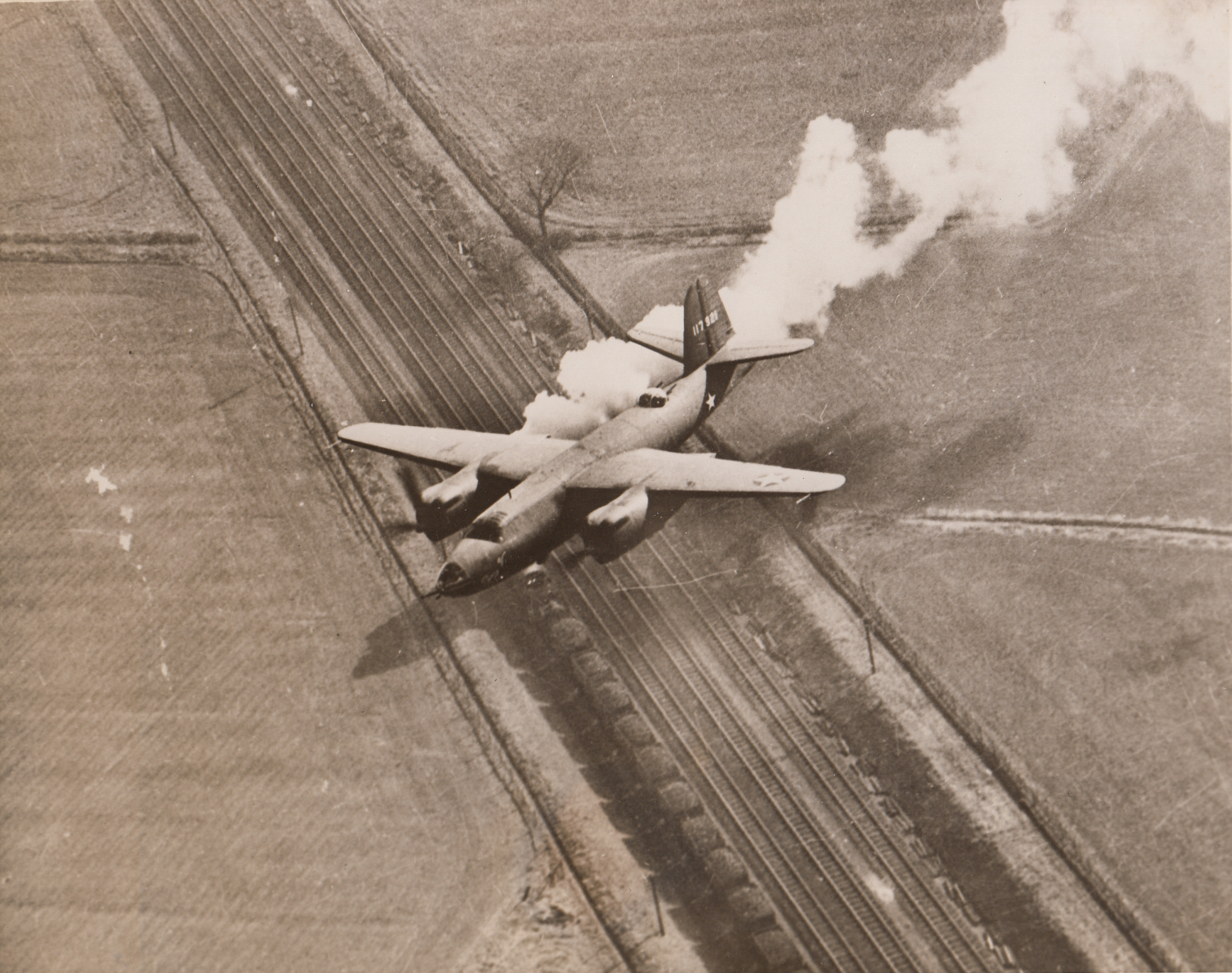
FOOLED YOU, DIDN'T IT?, 2/16/1944. ENGLAND—At first glance it would seem that this B-26 Marauder is coming home in distress with its right engine ablaze. Actually the white smoke is puffing from a locomotive on the tracks below. A fast-thinking aerial photographer in another Marauder snapped the optical illusion returning from a raid over occupied Europe.;

HELLCAT FLIES FOR THE BRITISH, 2/10/1944. AT SEA—An American-built Grumman Hellcat fighter of the British Fleet Air Arm, comes in for a landing aboard the escort aircraft carrier H.M.S. Ravager “somewhere at sea”, as a signalman gives the all clear. Credit Line (ACME);

General's Wife and Son, 2/25/1944. Australia—Young Arthur MacArthur, son of America’s General Douglas MacArthur, accompanies his mother on a shopping tour in Australia where they are living. Holding tightly to Mrs. MacArthur’s hand, the boy has just celebrated his sixth birthday. 2/25/44;
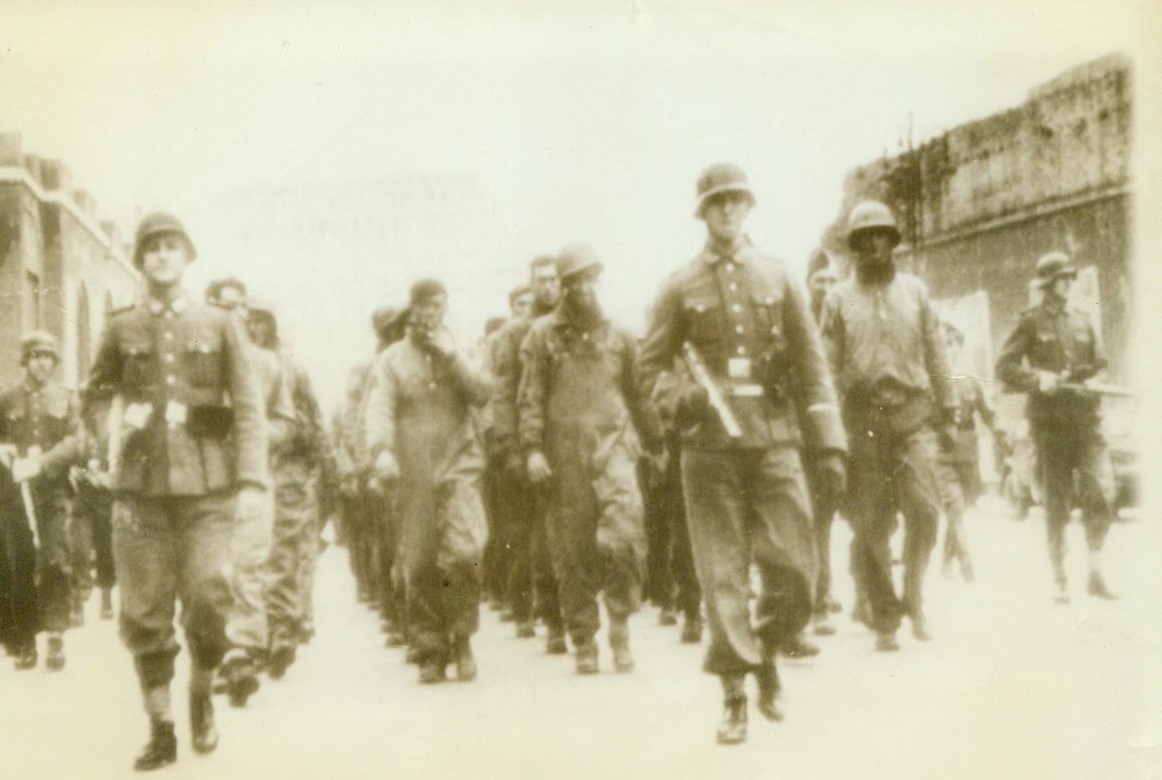
Allied Prisoners, 2/25/1944. Rome -- Two pompous Nazis lead five columns of British and American soldiers, captured in the fighting at Nettuno, through the streets of Rome, according to the German caption accompanying this photo. Note the Coliseum in background. Obtained through a neutral source. 2/25/44 (ACME);
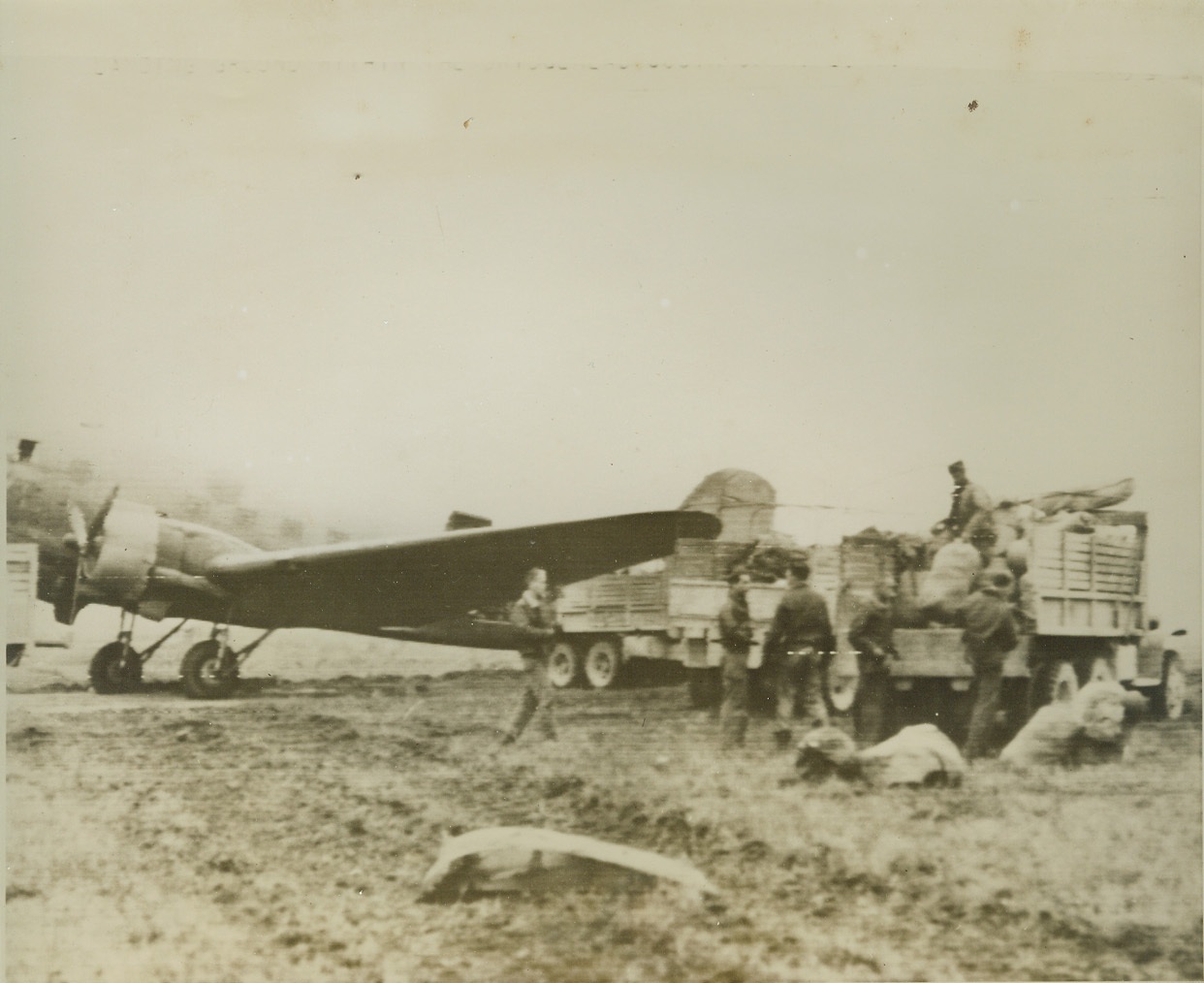
Air Mail, Special Delivery, 2/14/1944. Italy—Crew members empty the capacious hold of their 12 Army Air Force troop carrier plane and load the supplies on a truck to be rushed to Fifth Army fighters at the Anz I-O front. The ship is on a newly constructed landing strip within the south of Rome bridgehead area. Credit: Signal Corps radiotelephoto from ACME;

Led Forces at Eniwetok, 2/28/1944. Eniwetok—Here are the men that led the forces capturing Eniwetok Atoll, latest conquest of U.S. attackers in the Marshall Islands. Shown with the Jap flag captured in the fighting, are: (left to right), Col. Russell G. Ayers, Brig. Gen. Thomas E. Watson, and Rear Admiral H.W. Hill. They commanded Army, Navy, and Marine Corps elements in the fighting. Credit: U.S. Coast Guard photo from ACME.;





 Trash & Recycling
Trash & Recycling
 Online Payments
Online Payments
 City Documents
City Documents
 Parks
Parks
 Traffic Court
Traffic Court
 City Parks
City Parks
 Outdoor Recreation
Outdoor Recreation
 Volunteer
Volunteer
 Home
Home TRANSLATE
TRANSLATE
